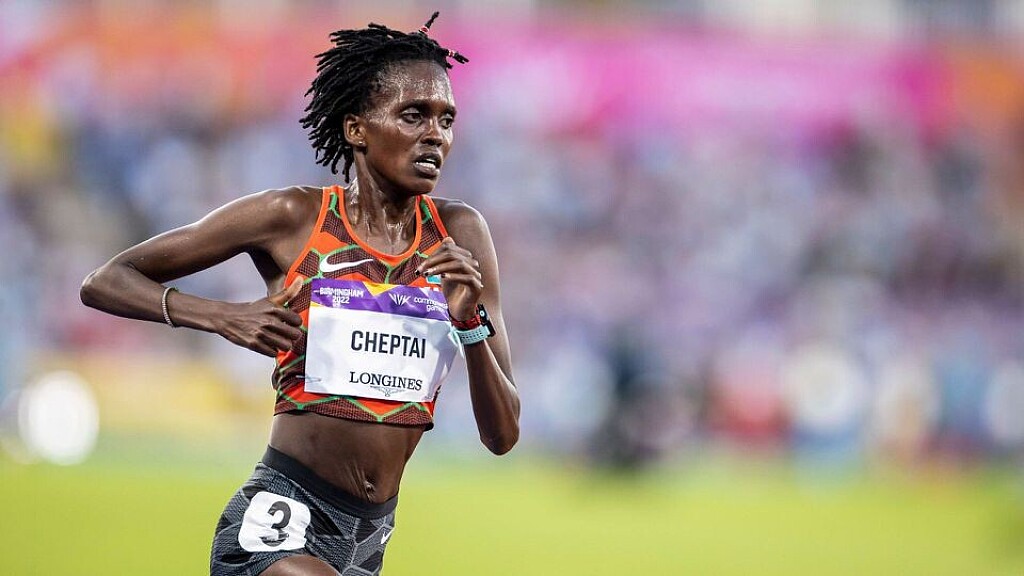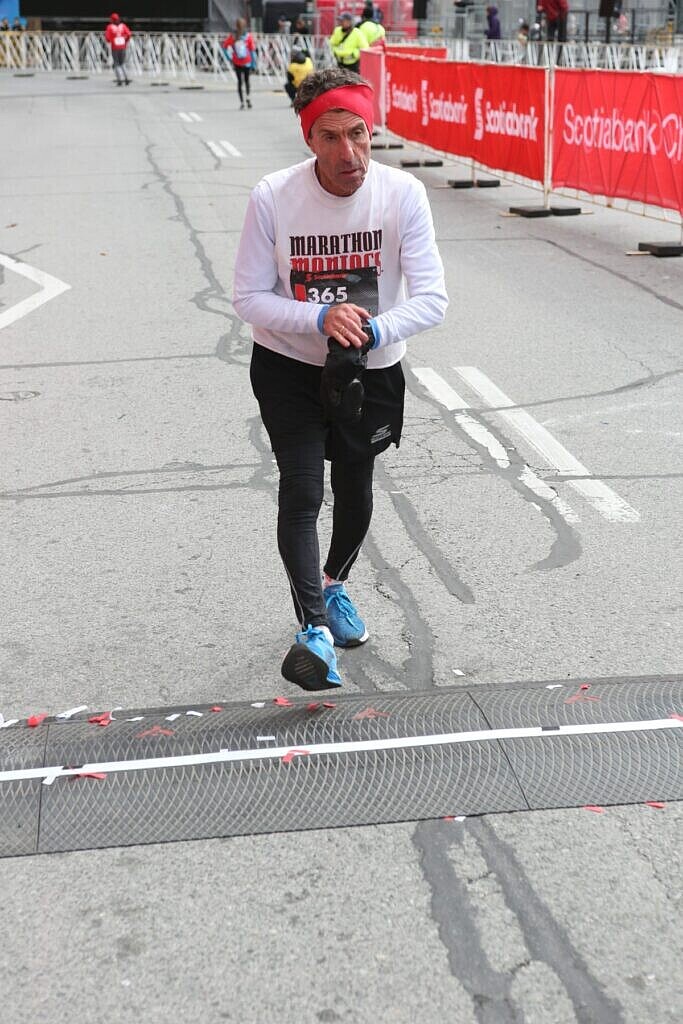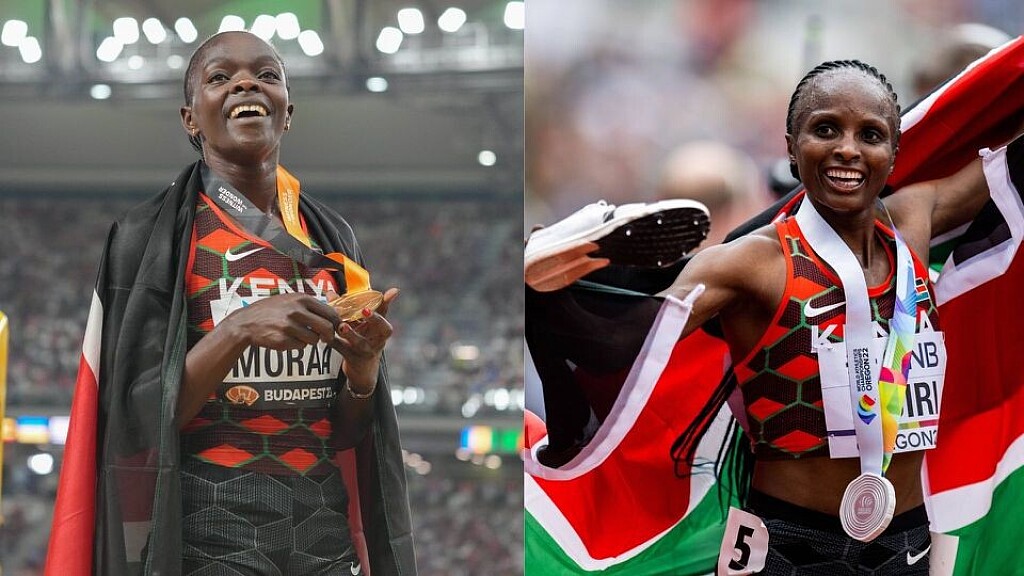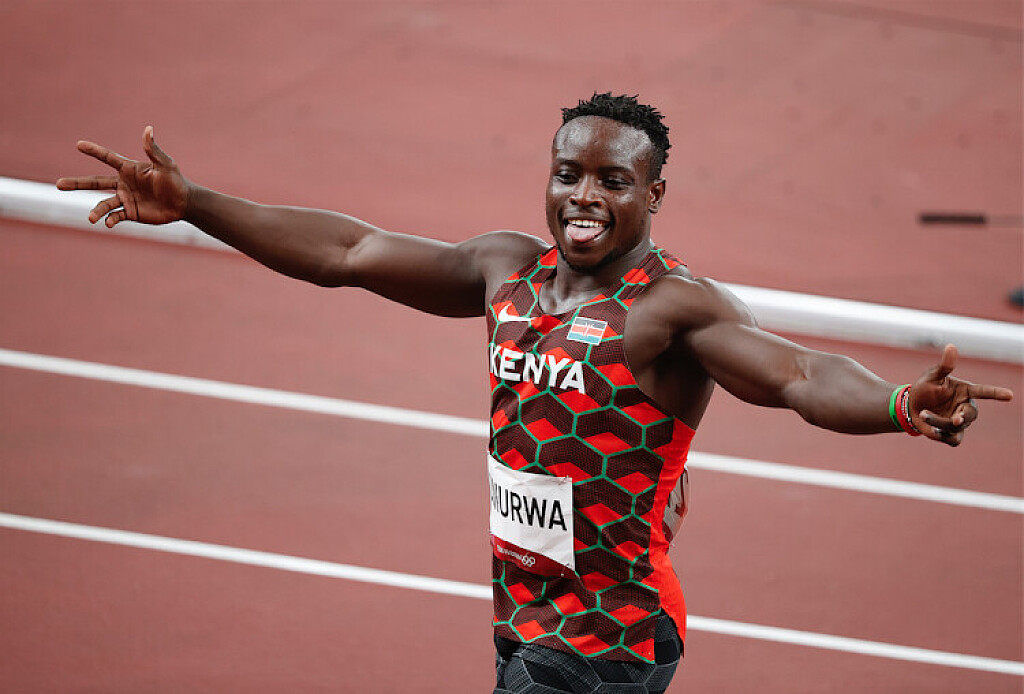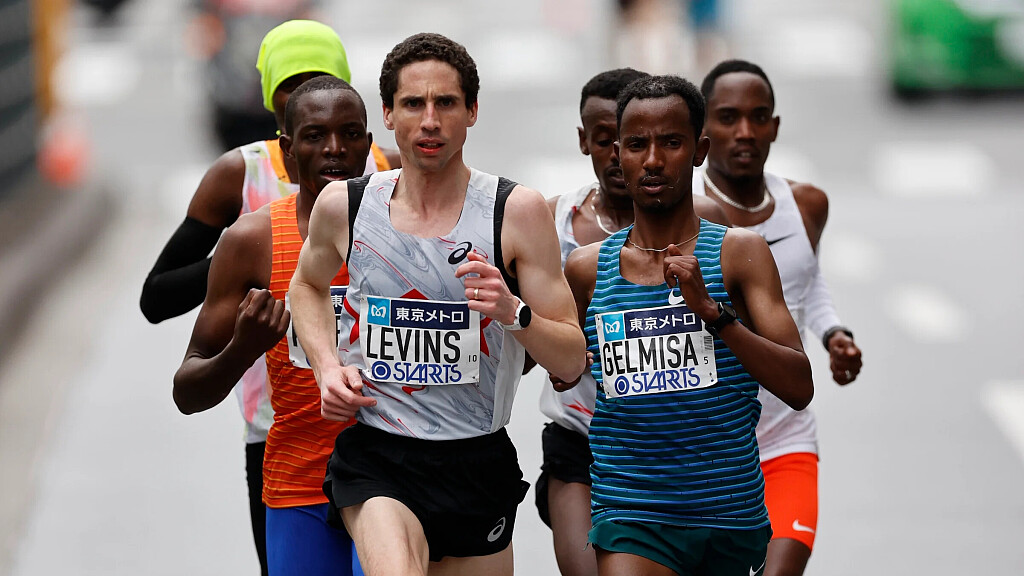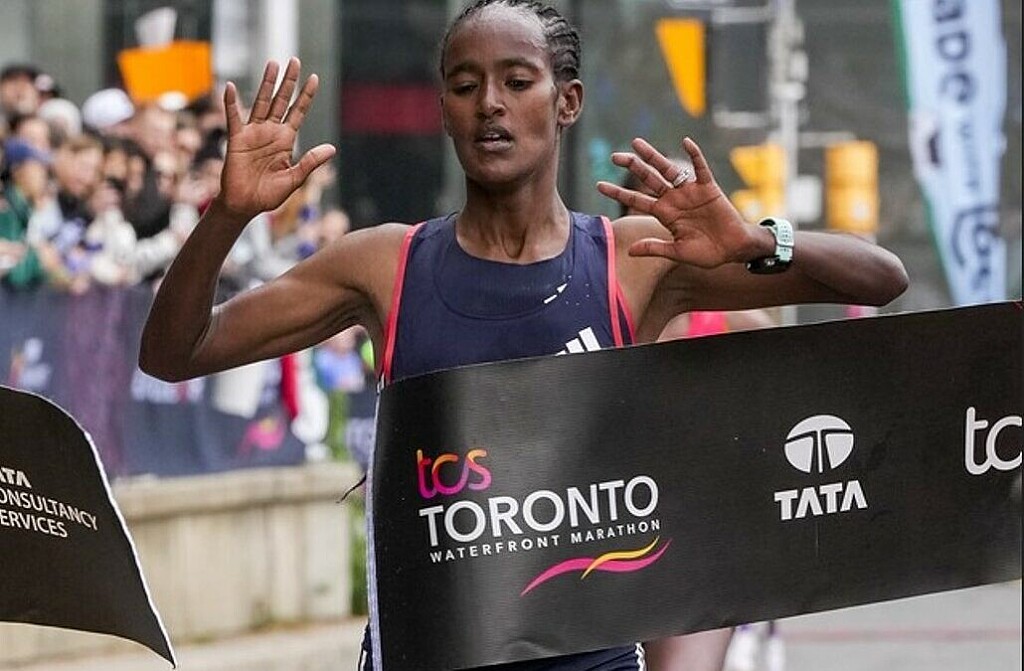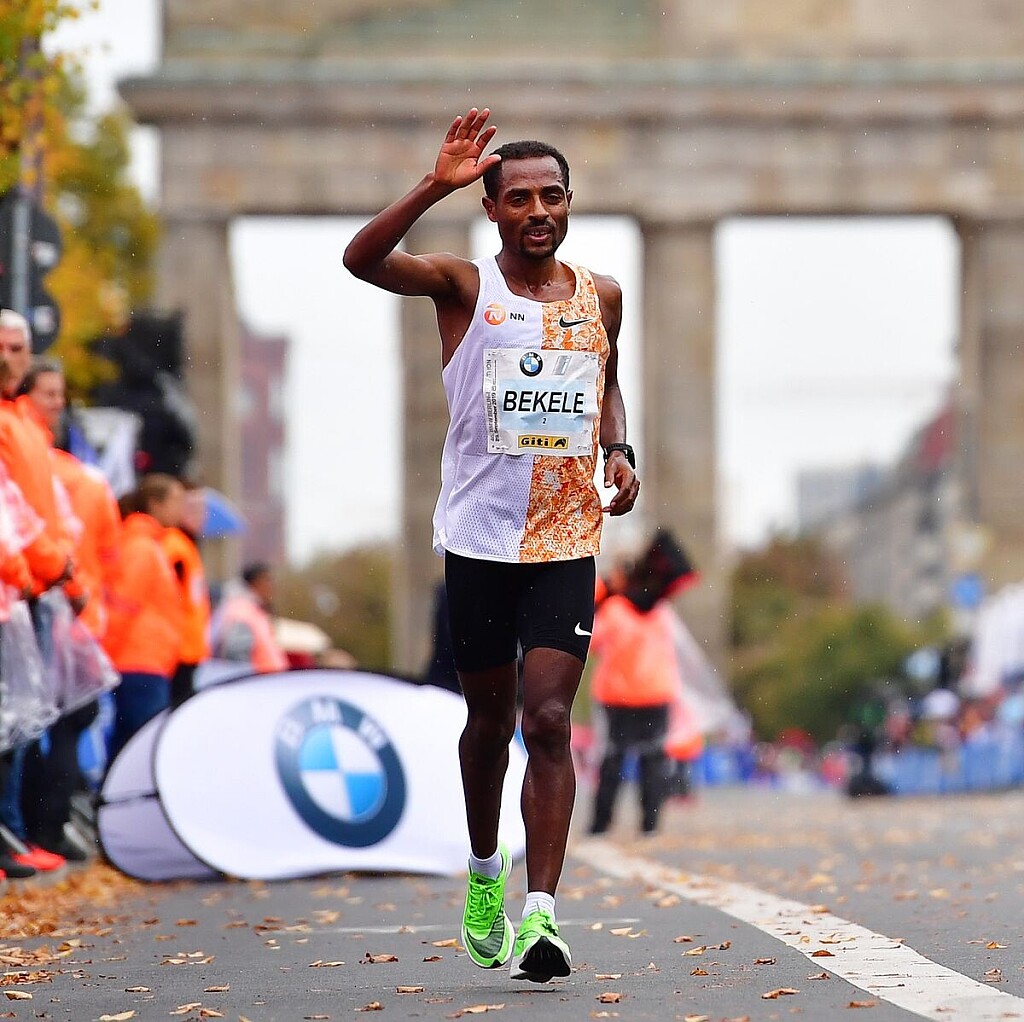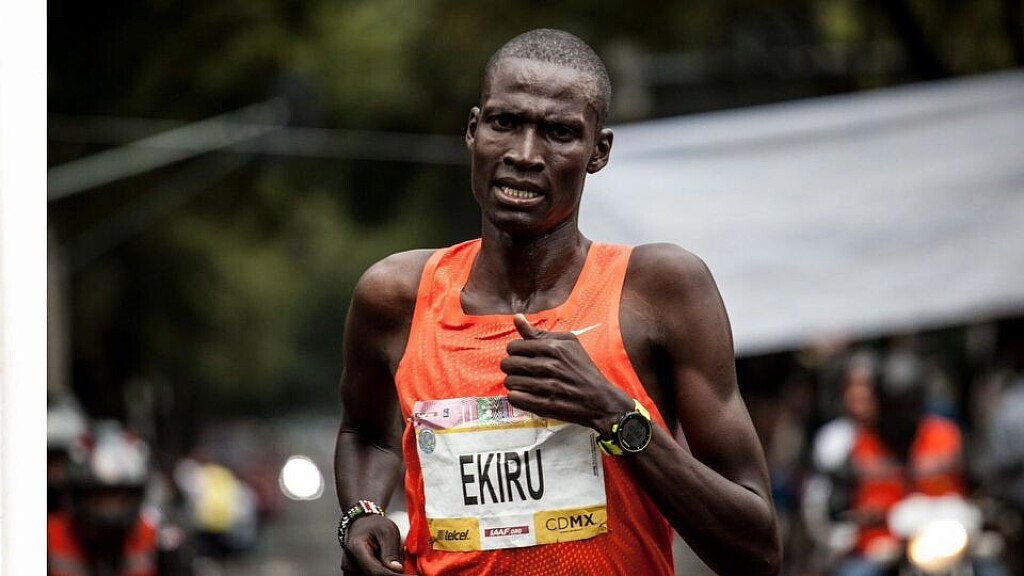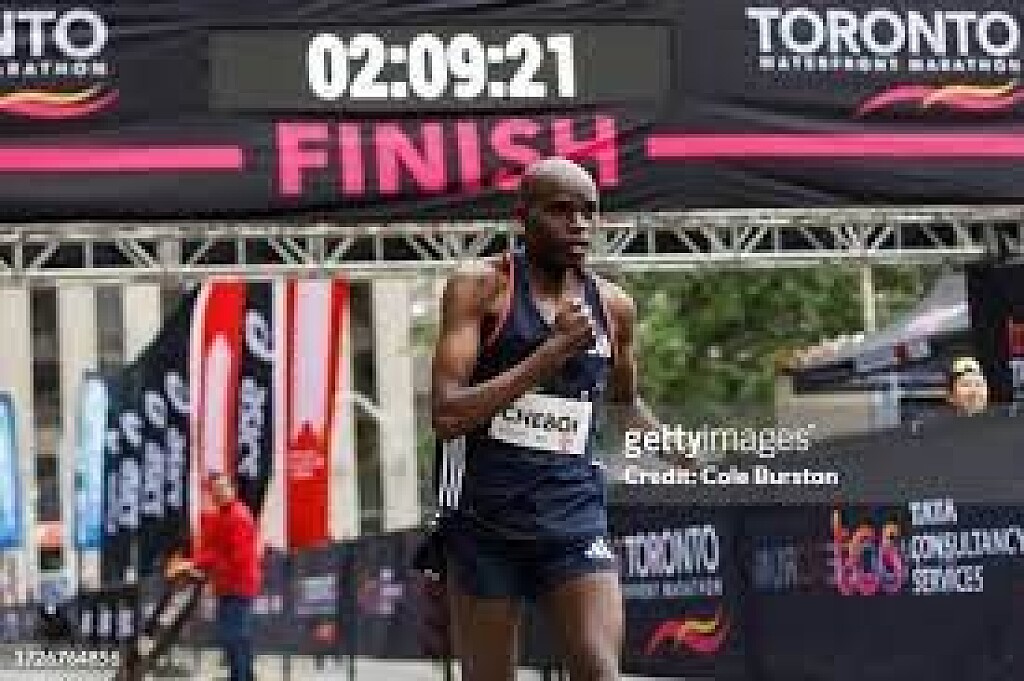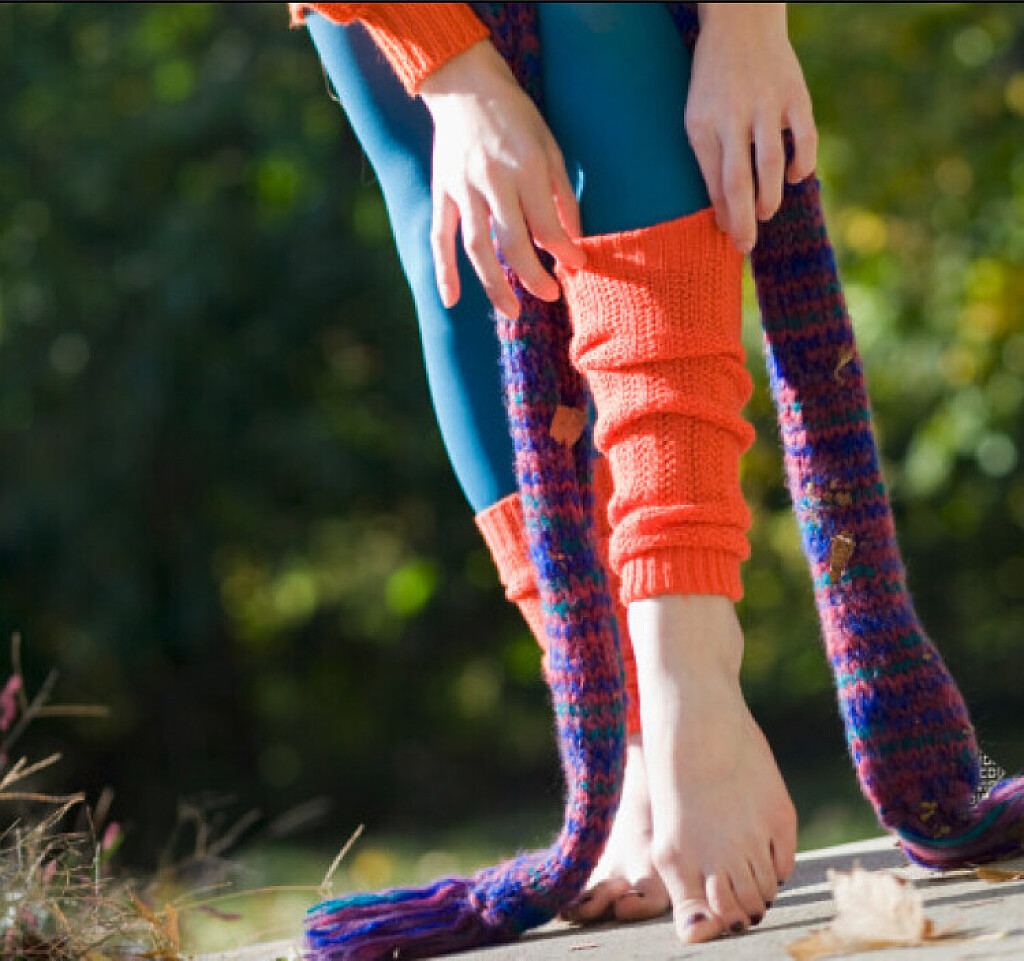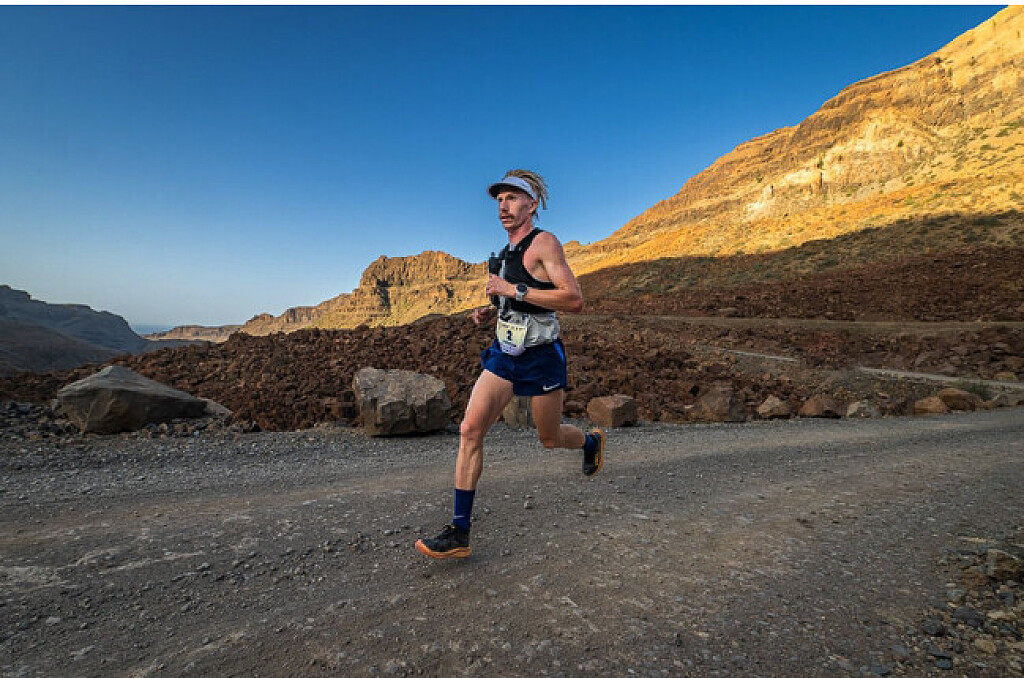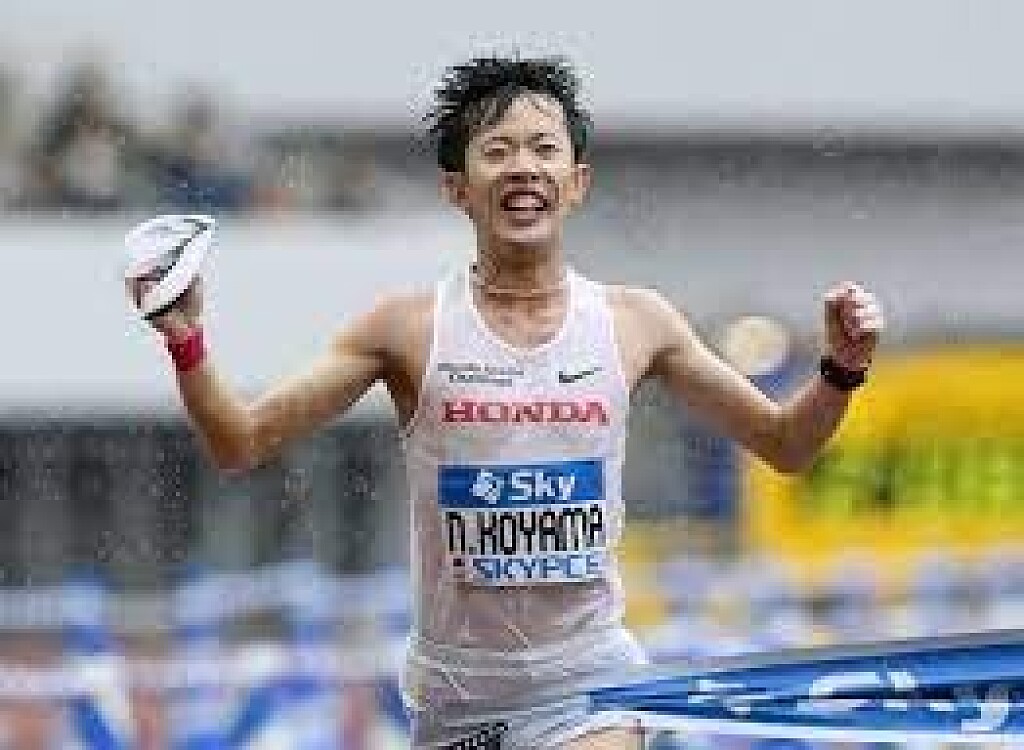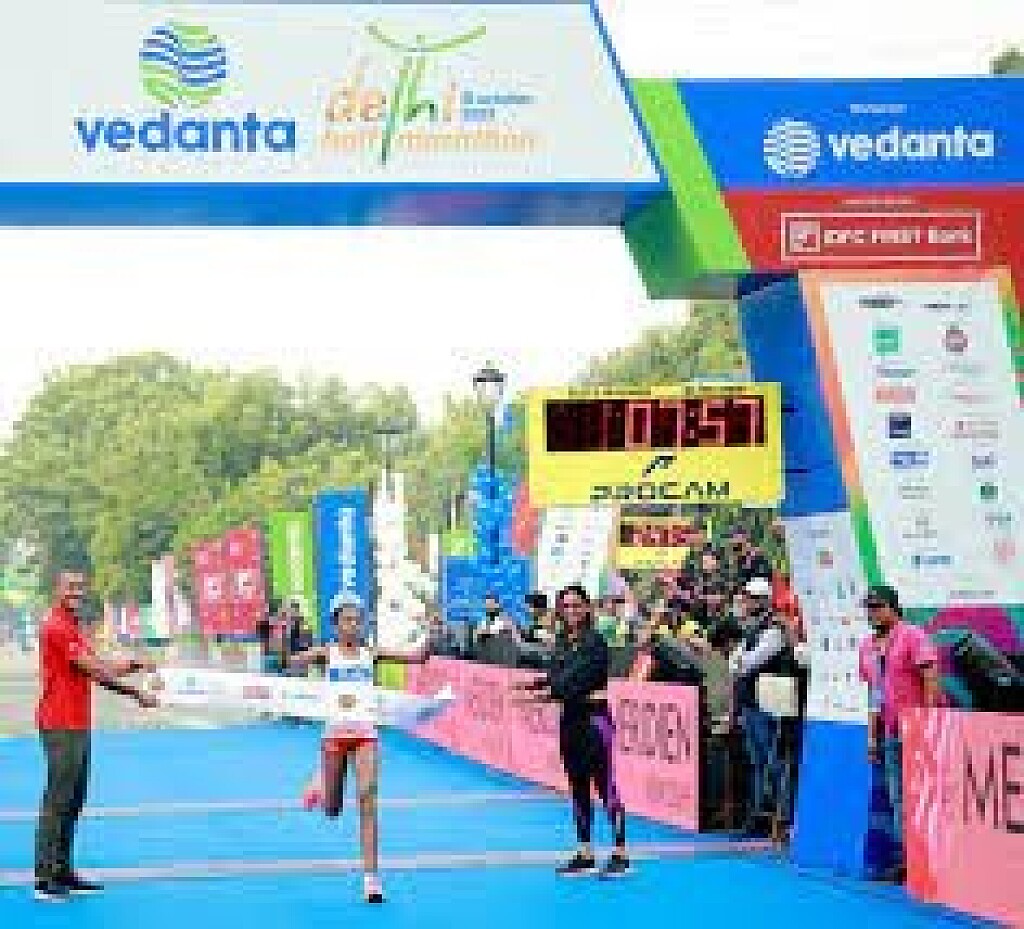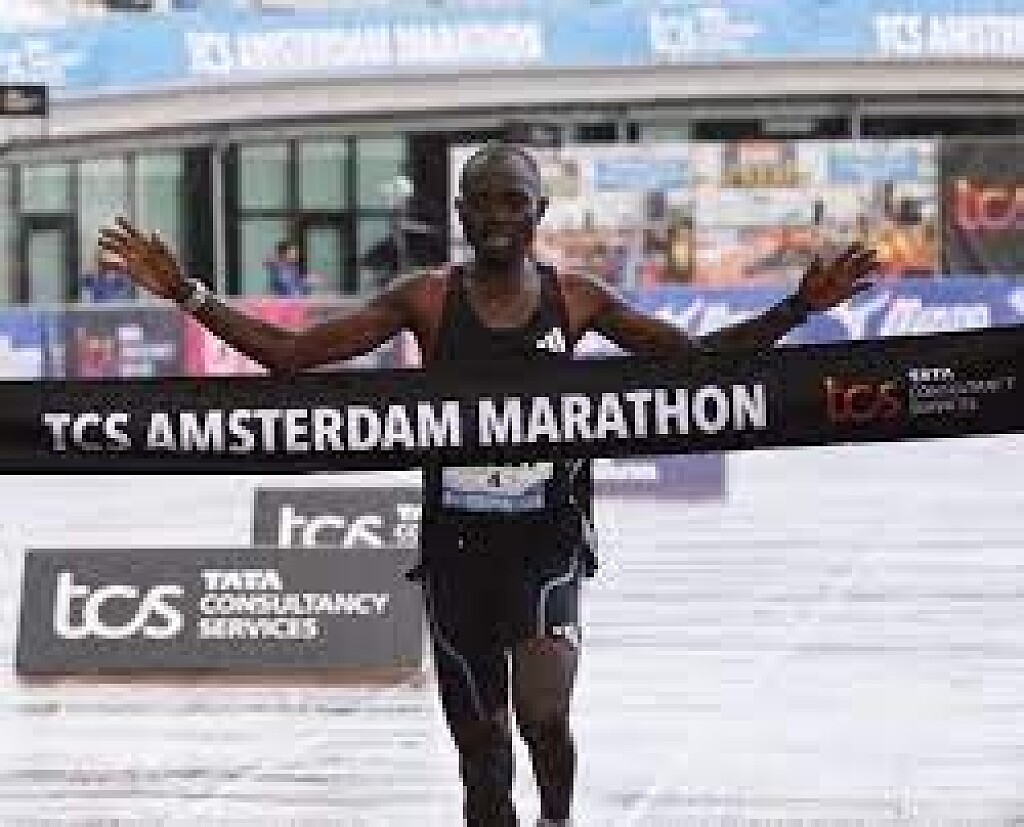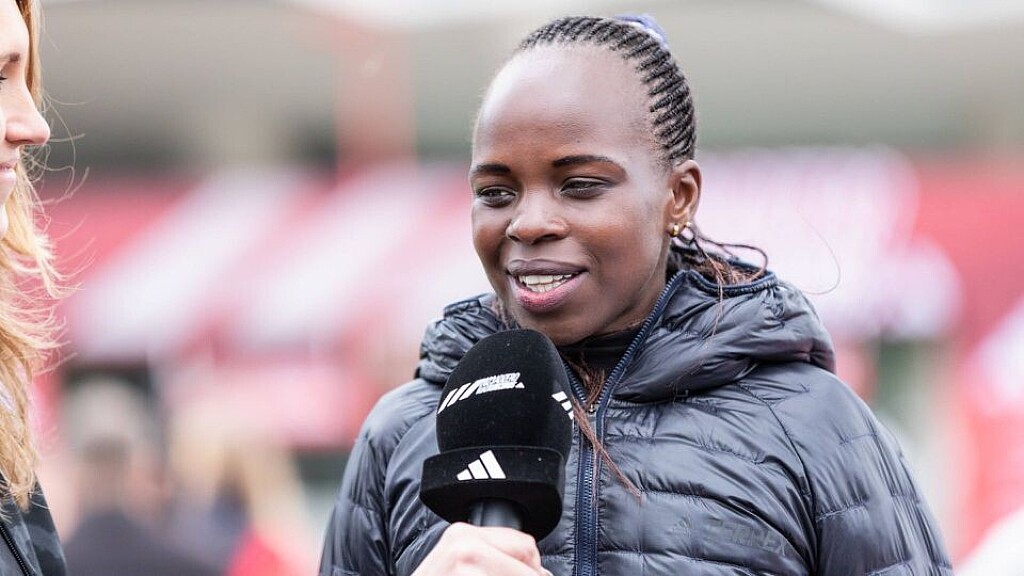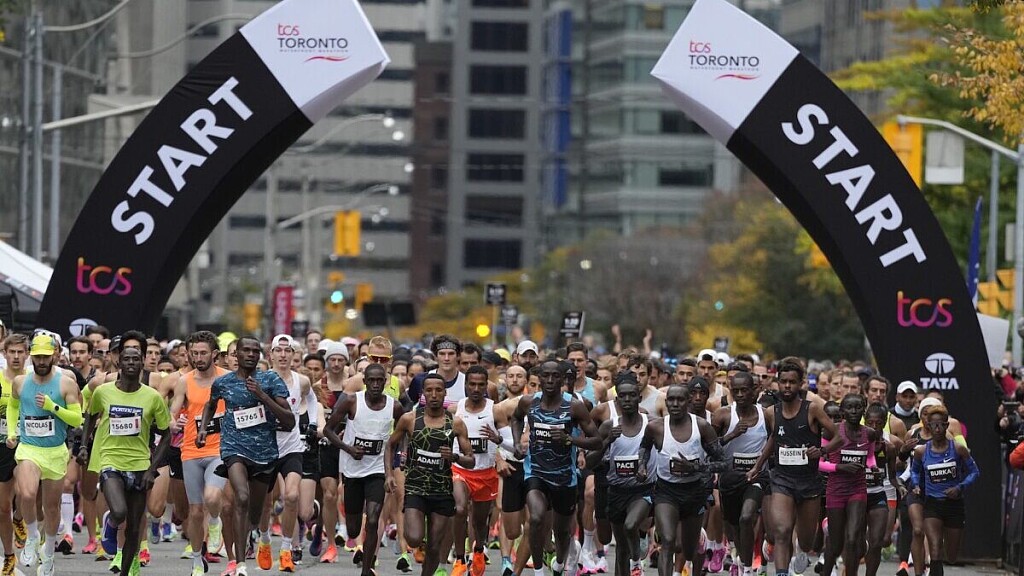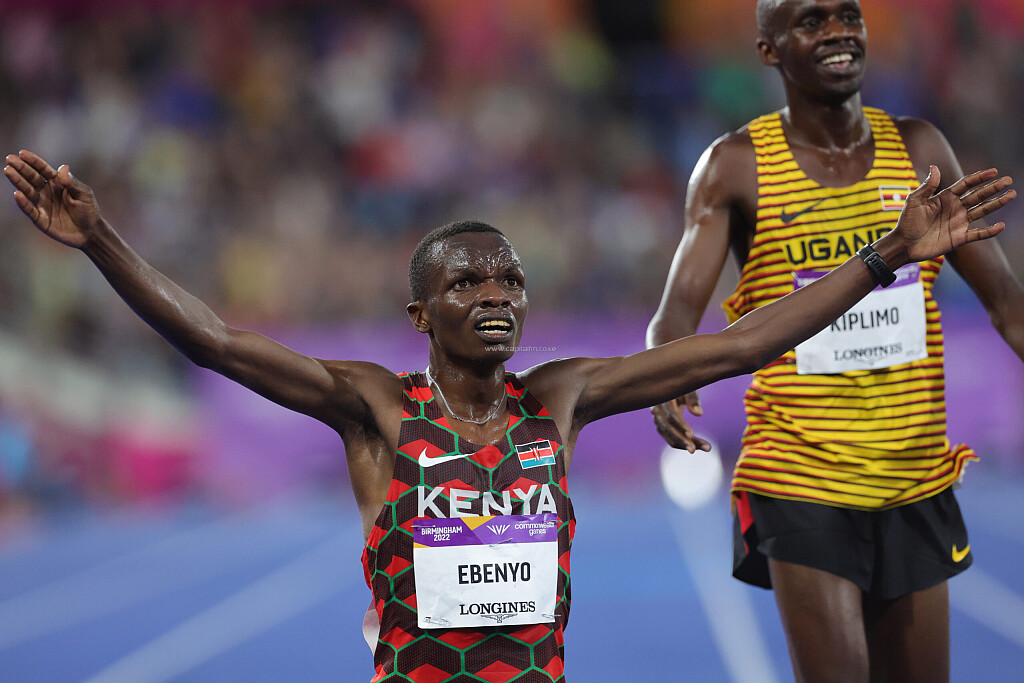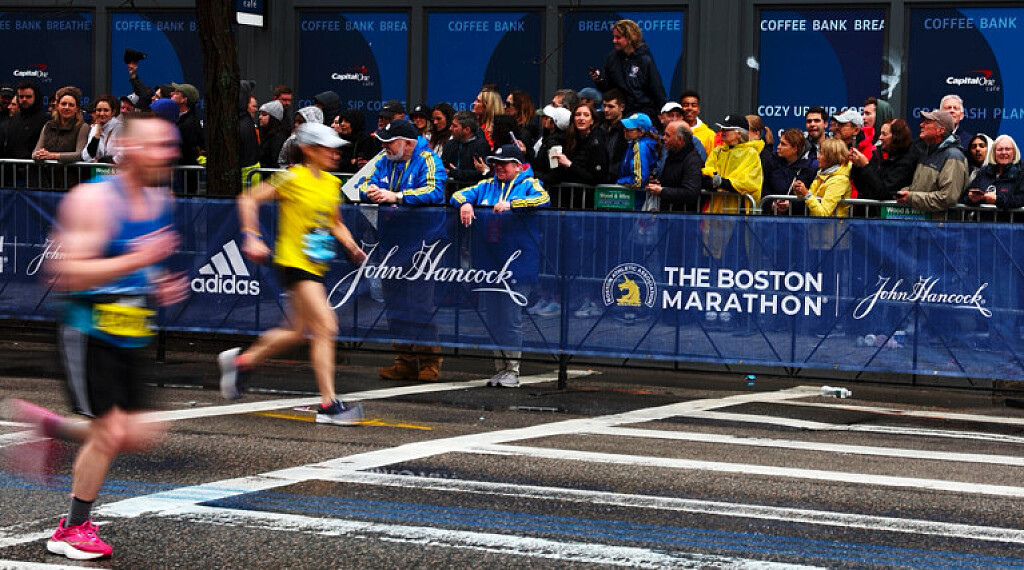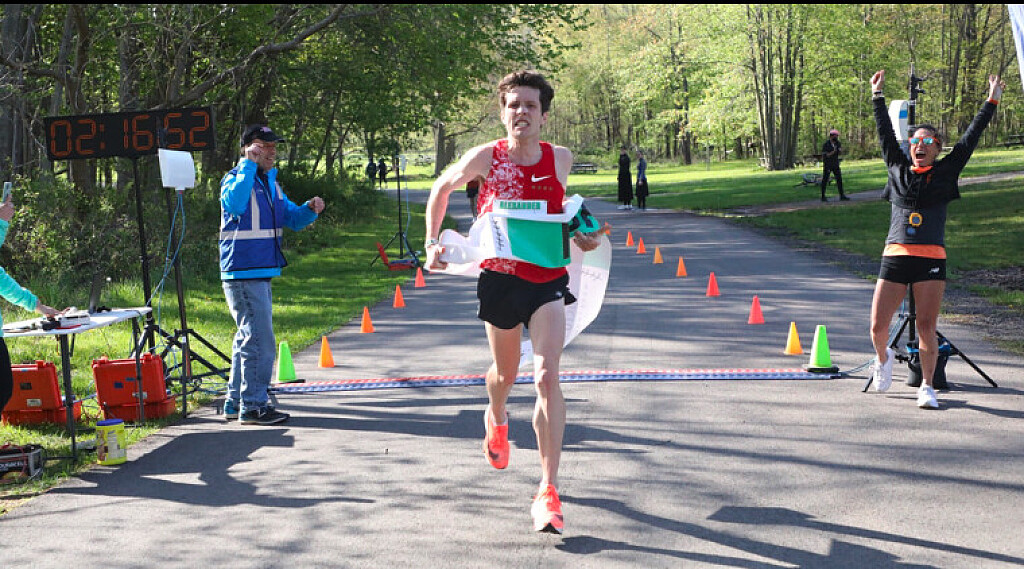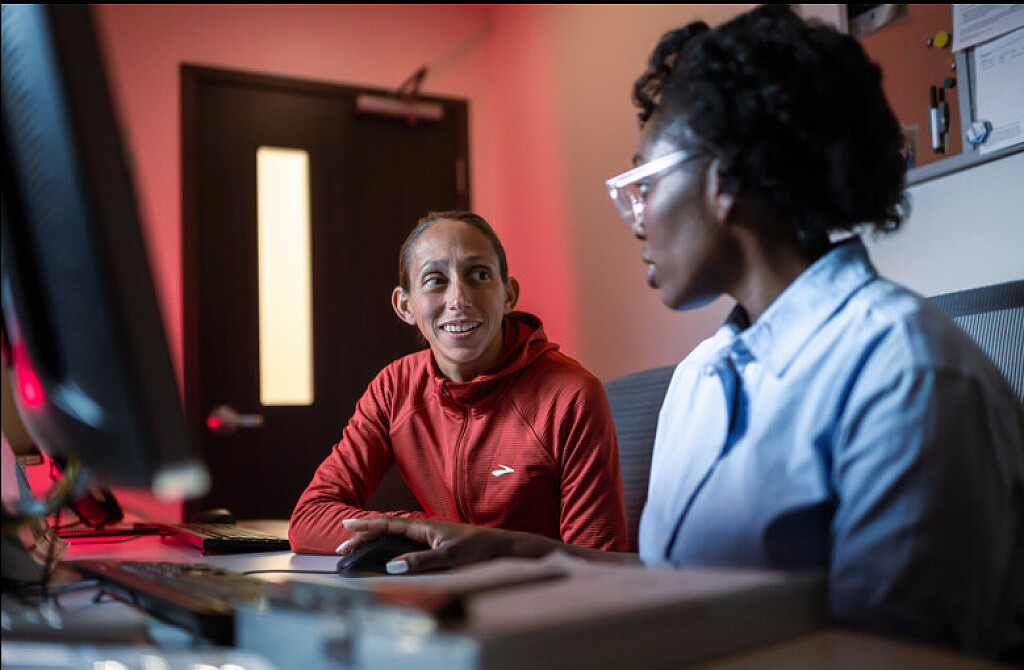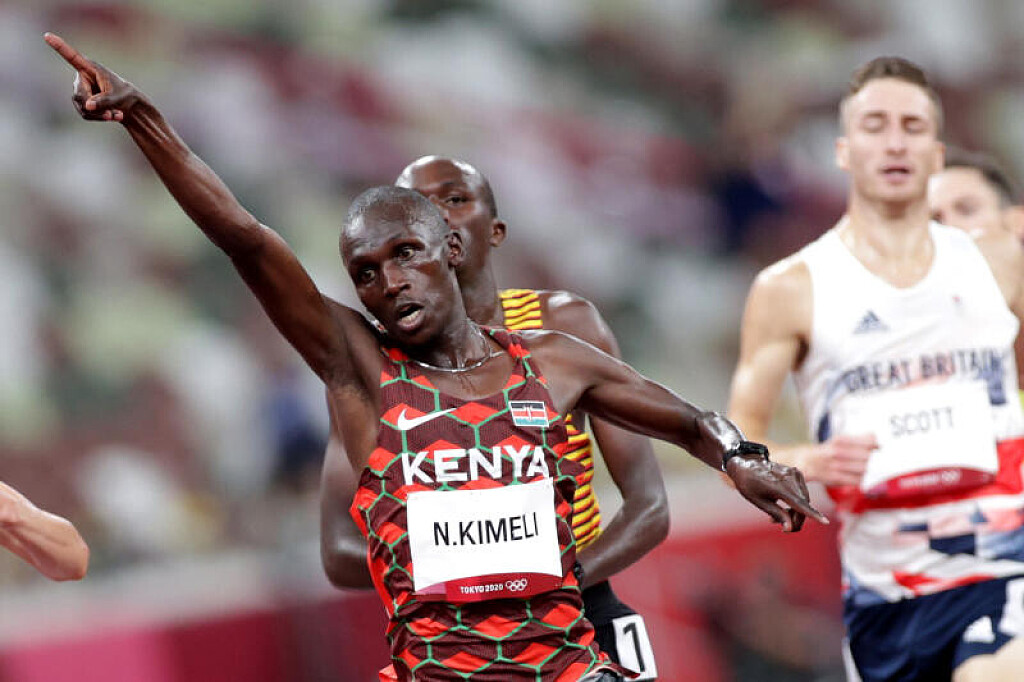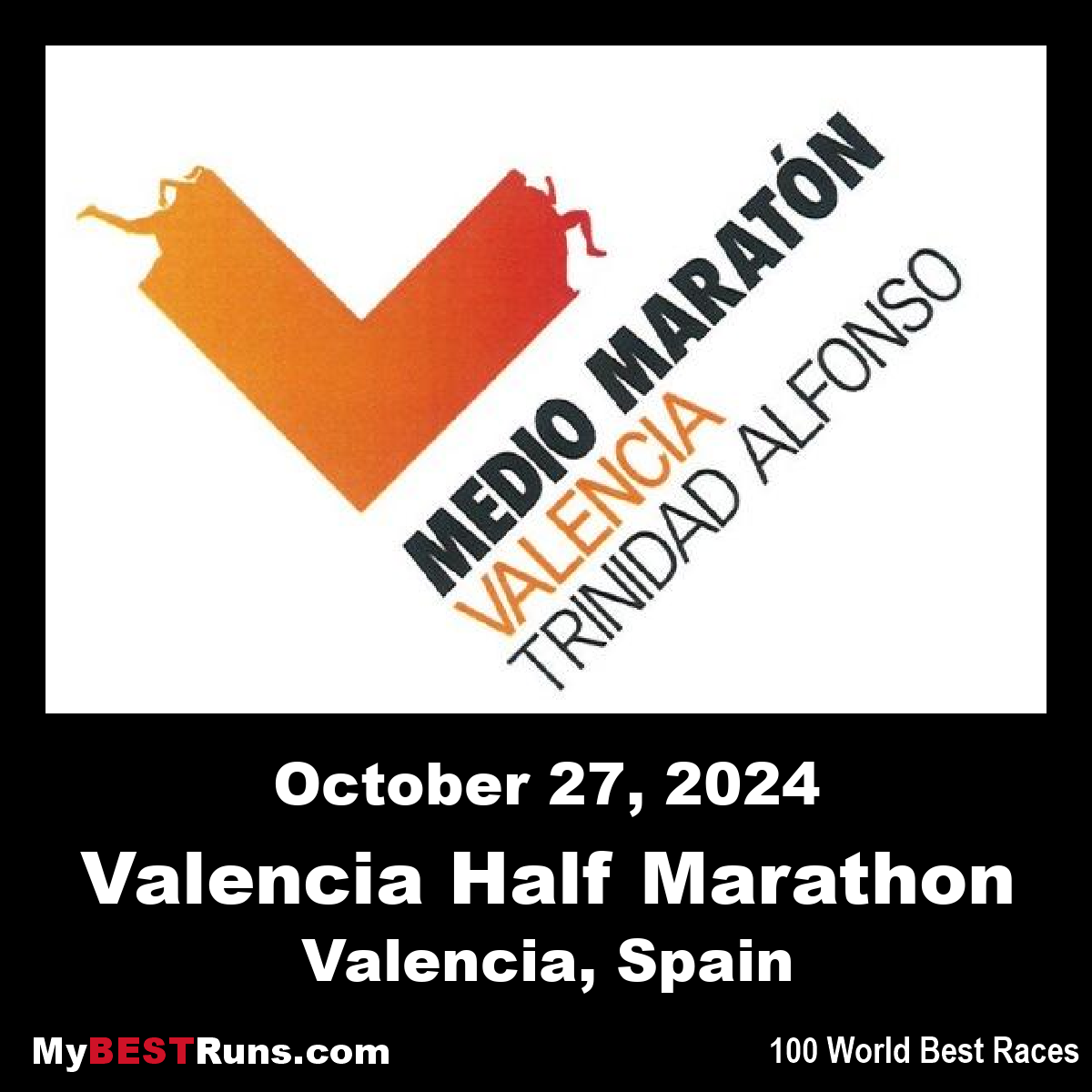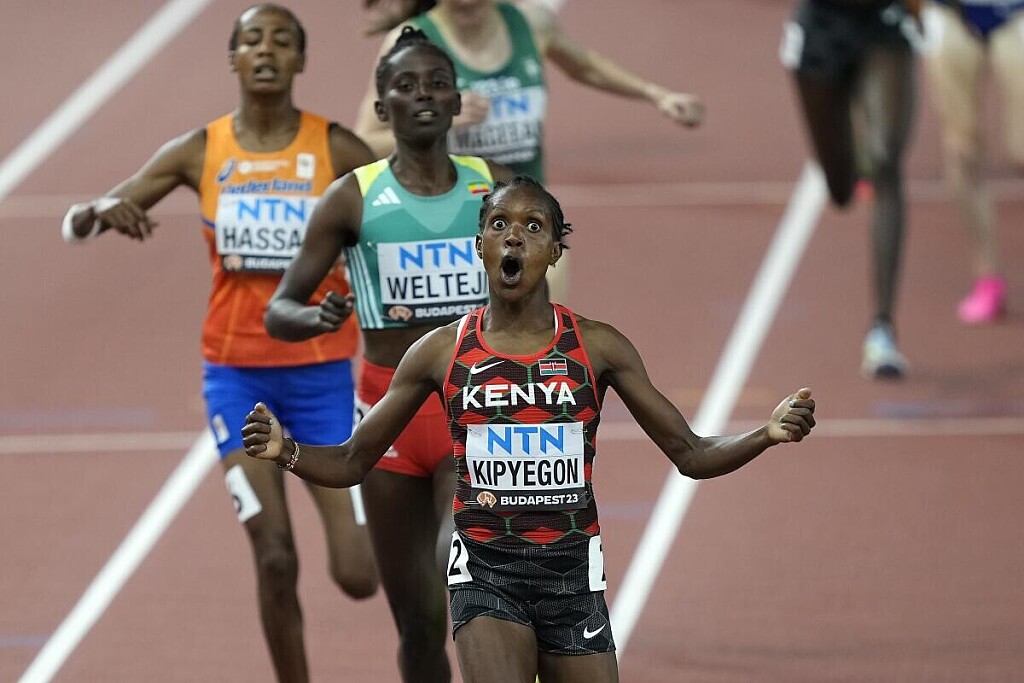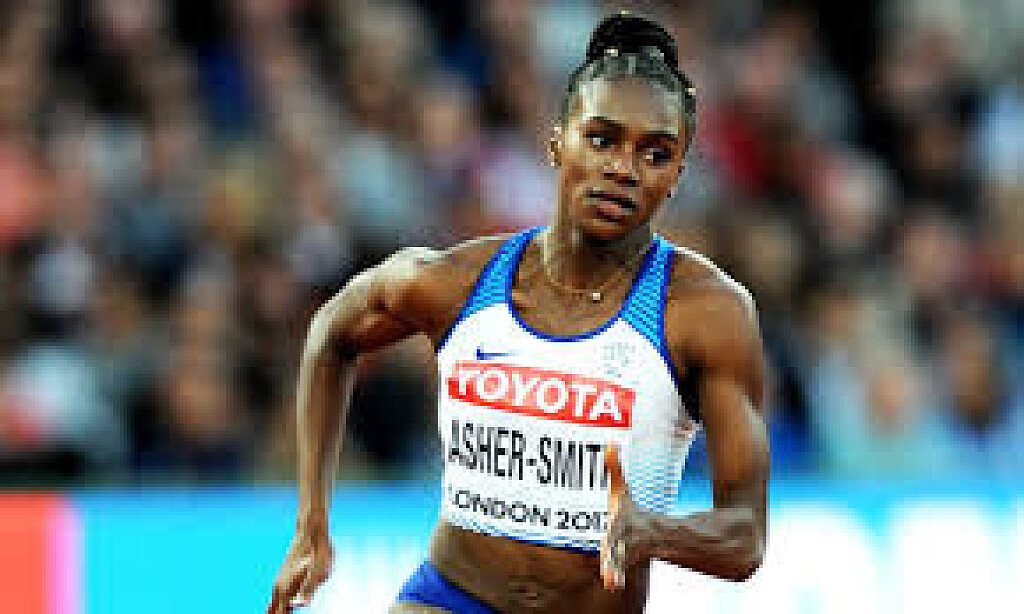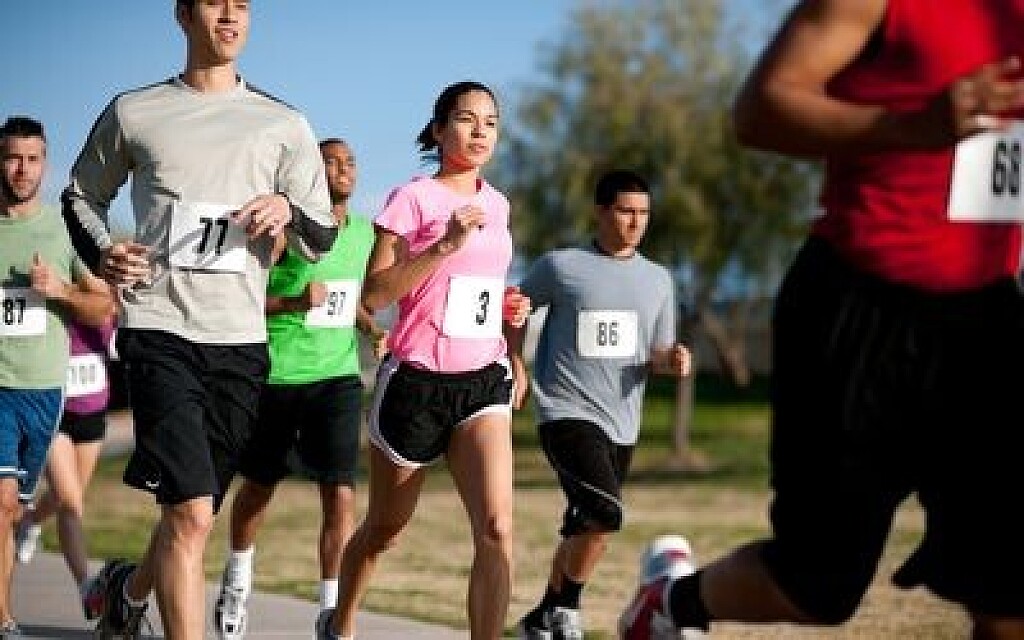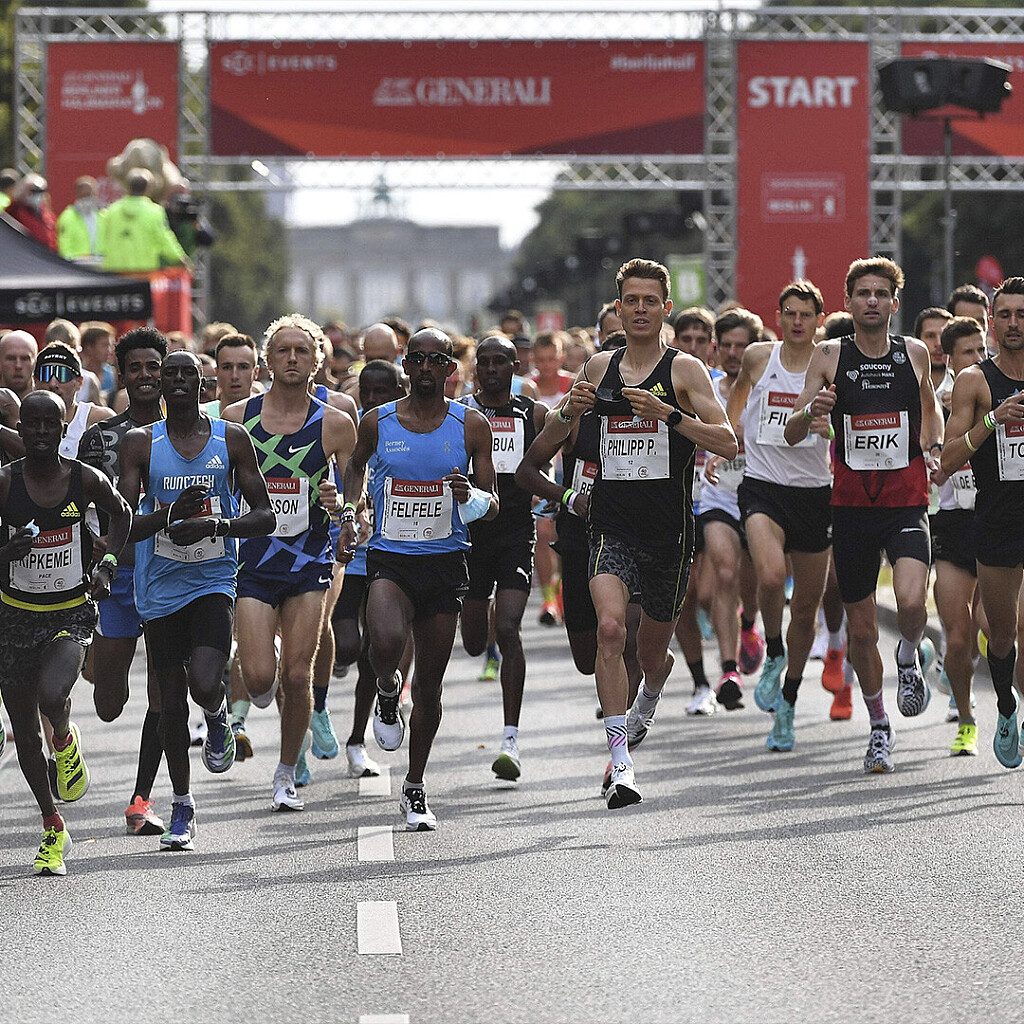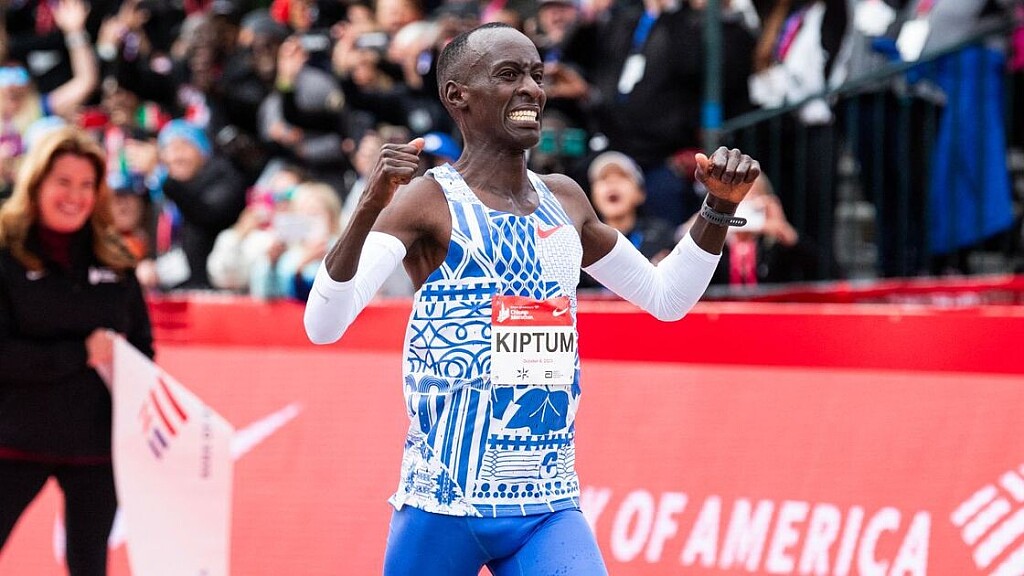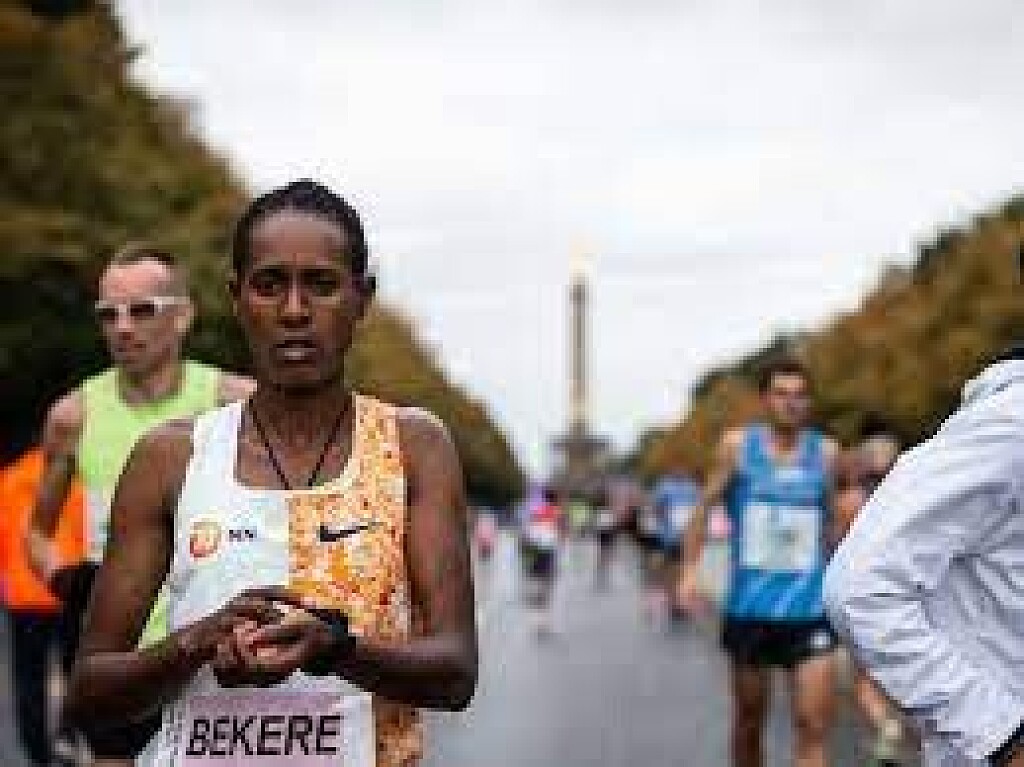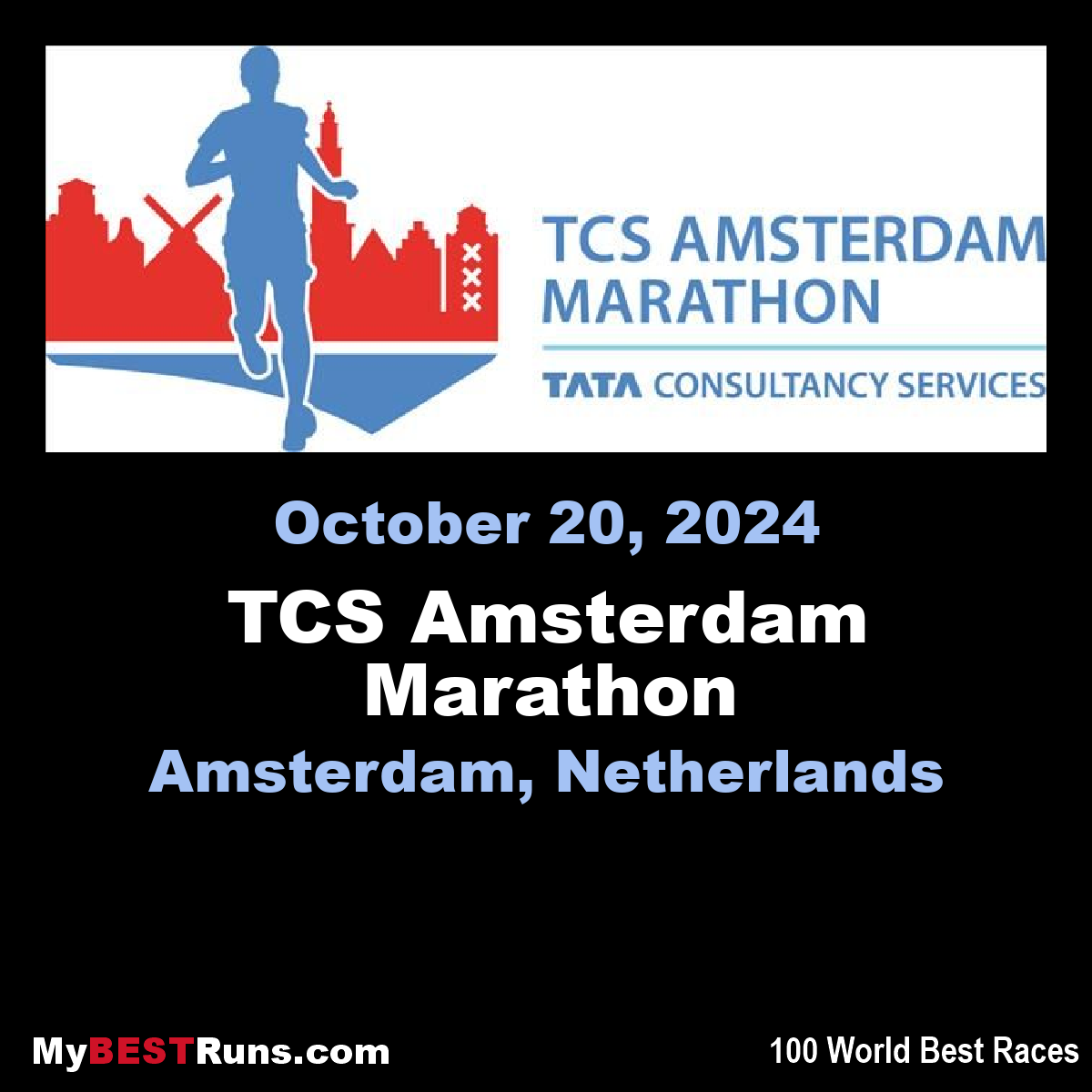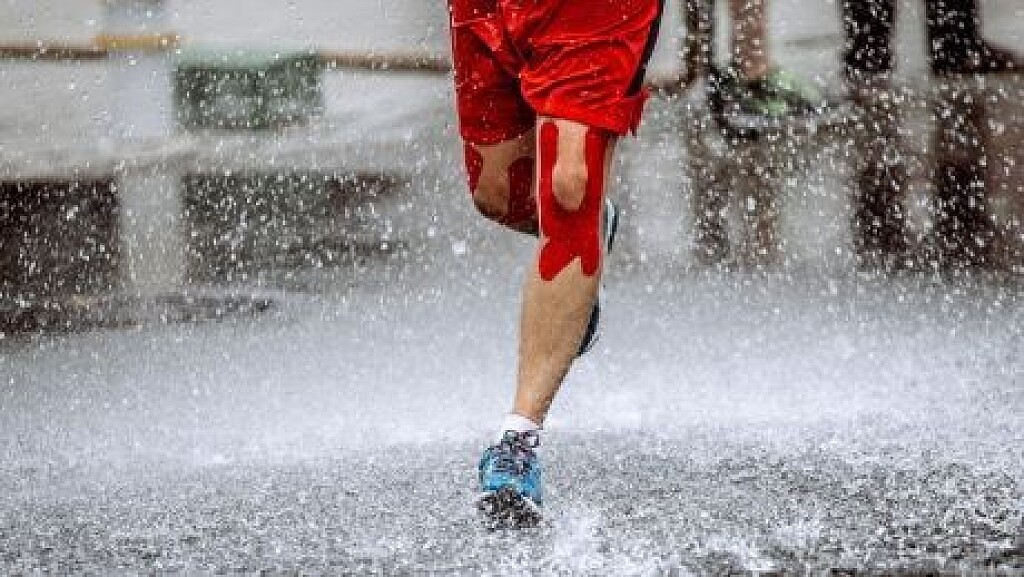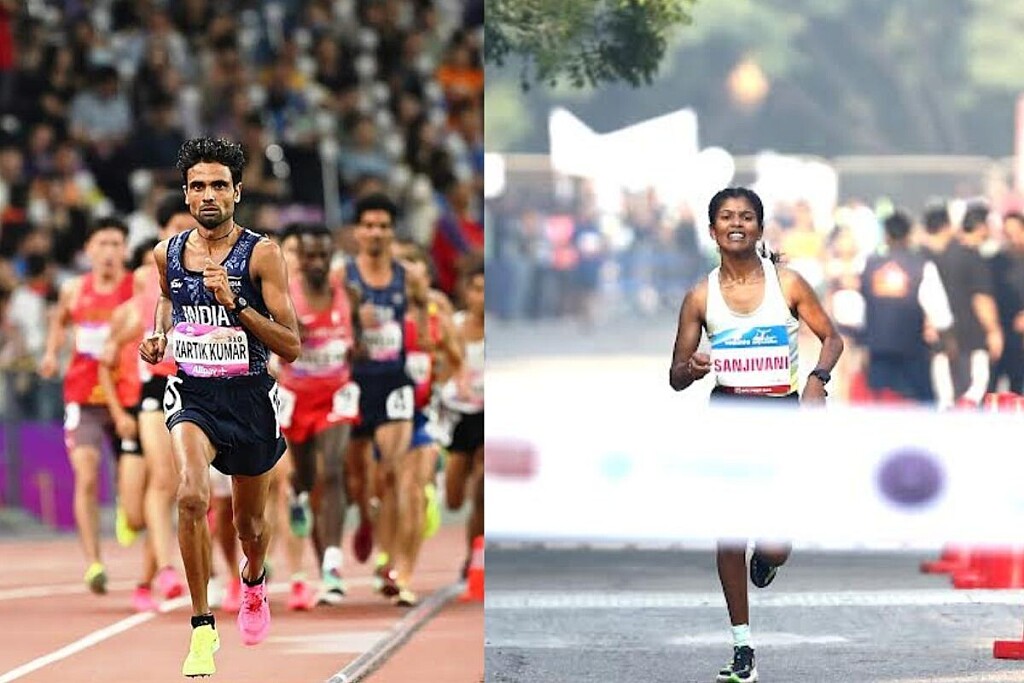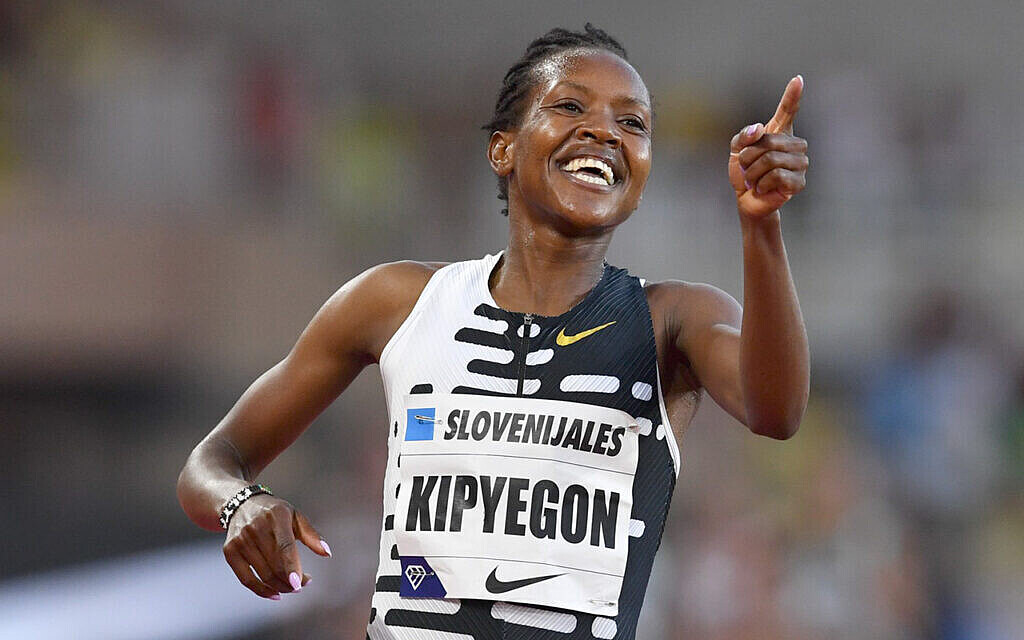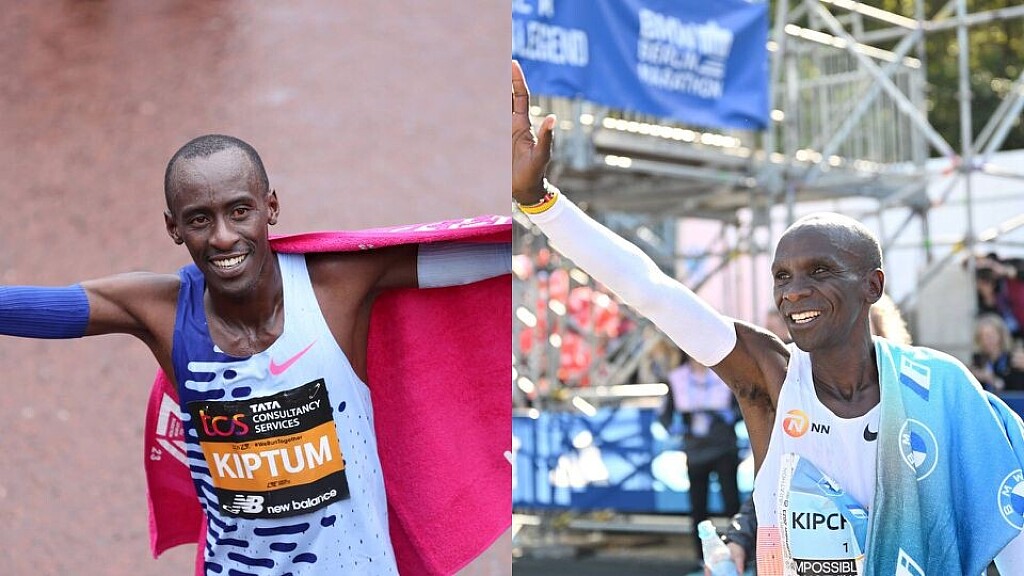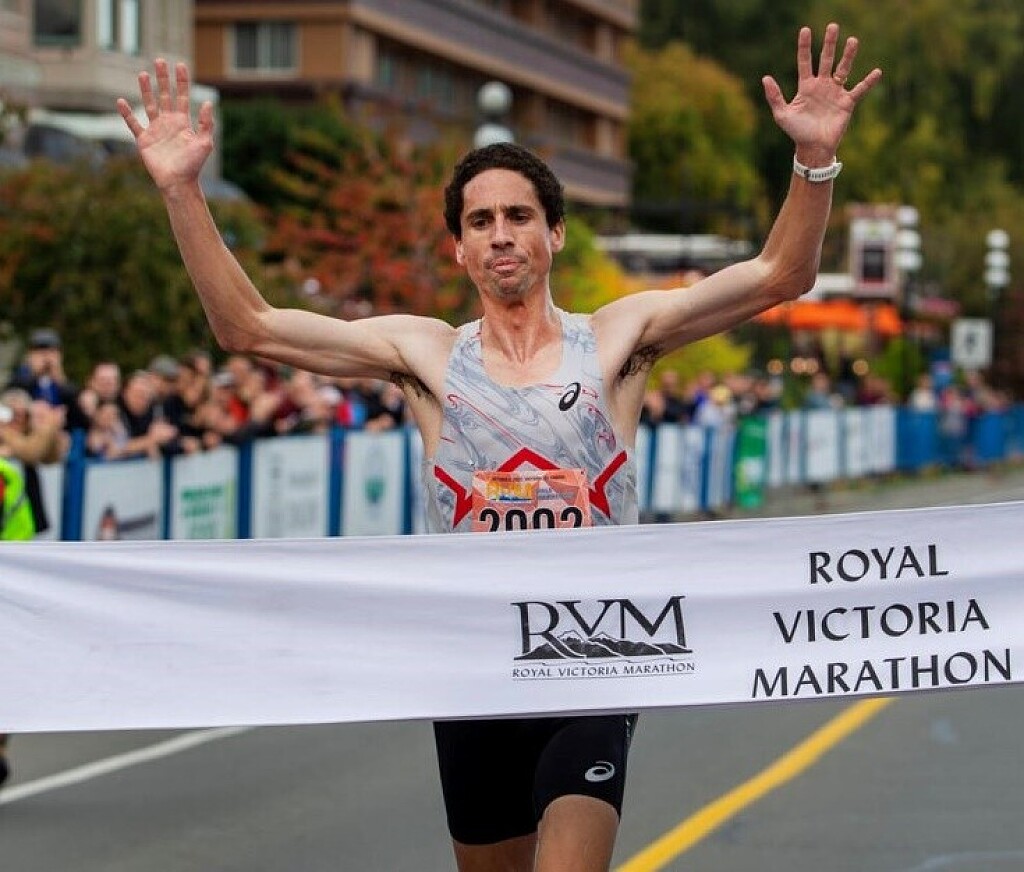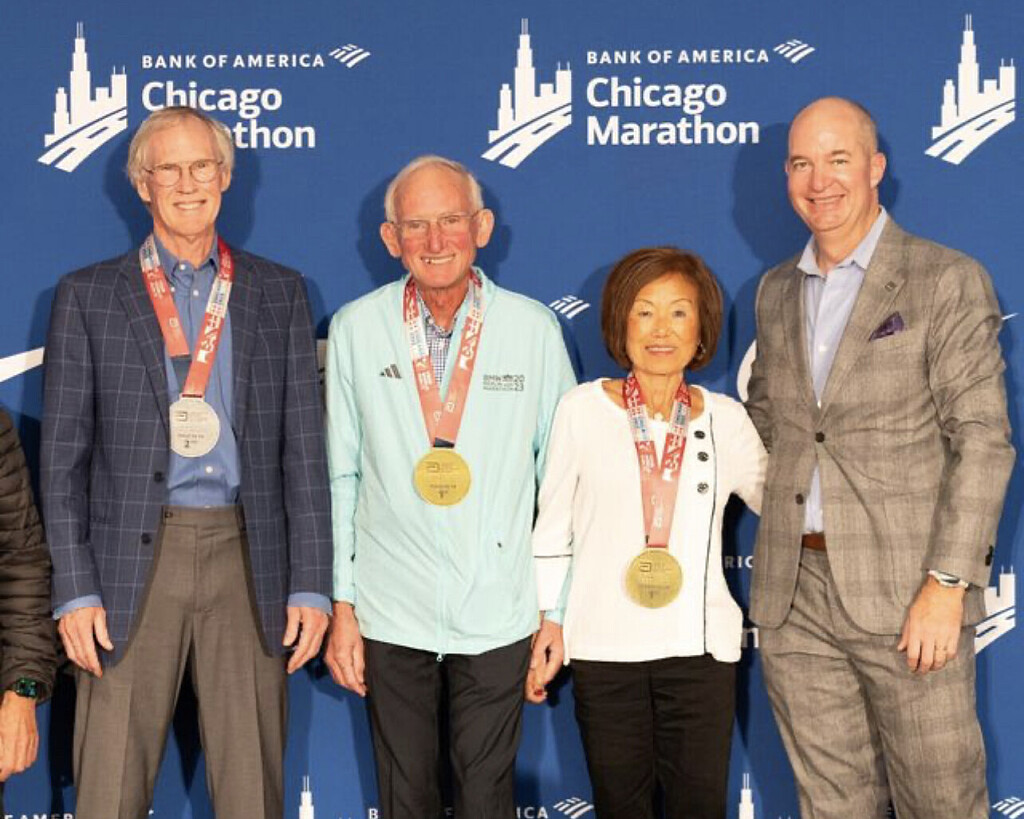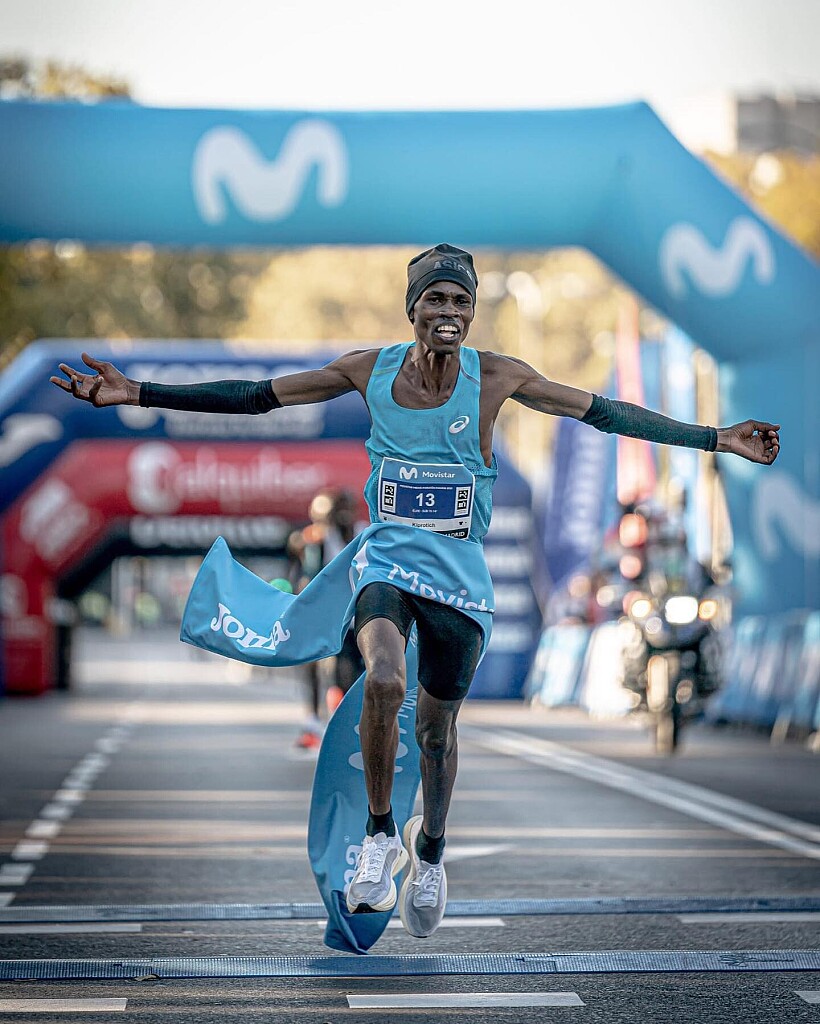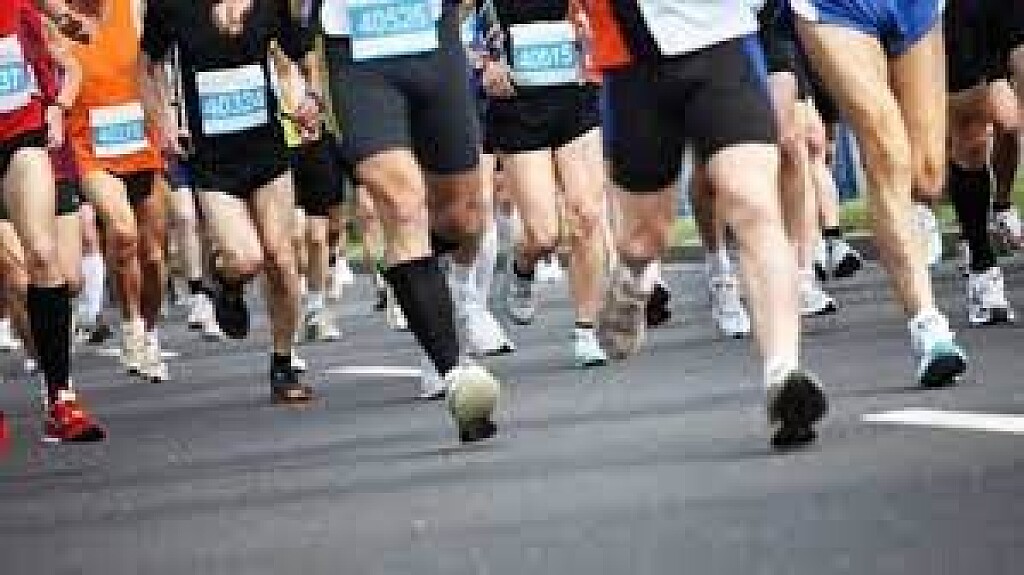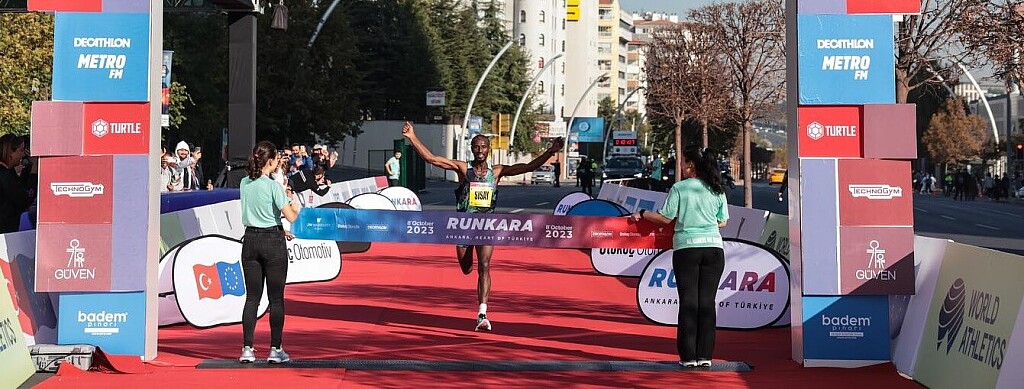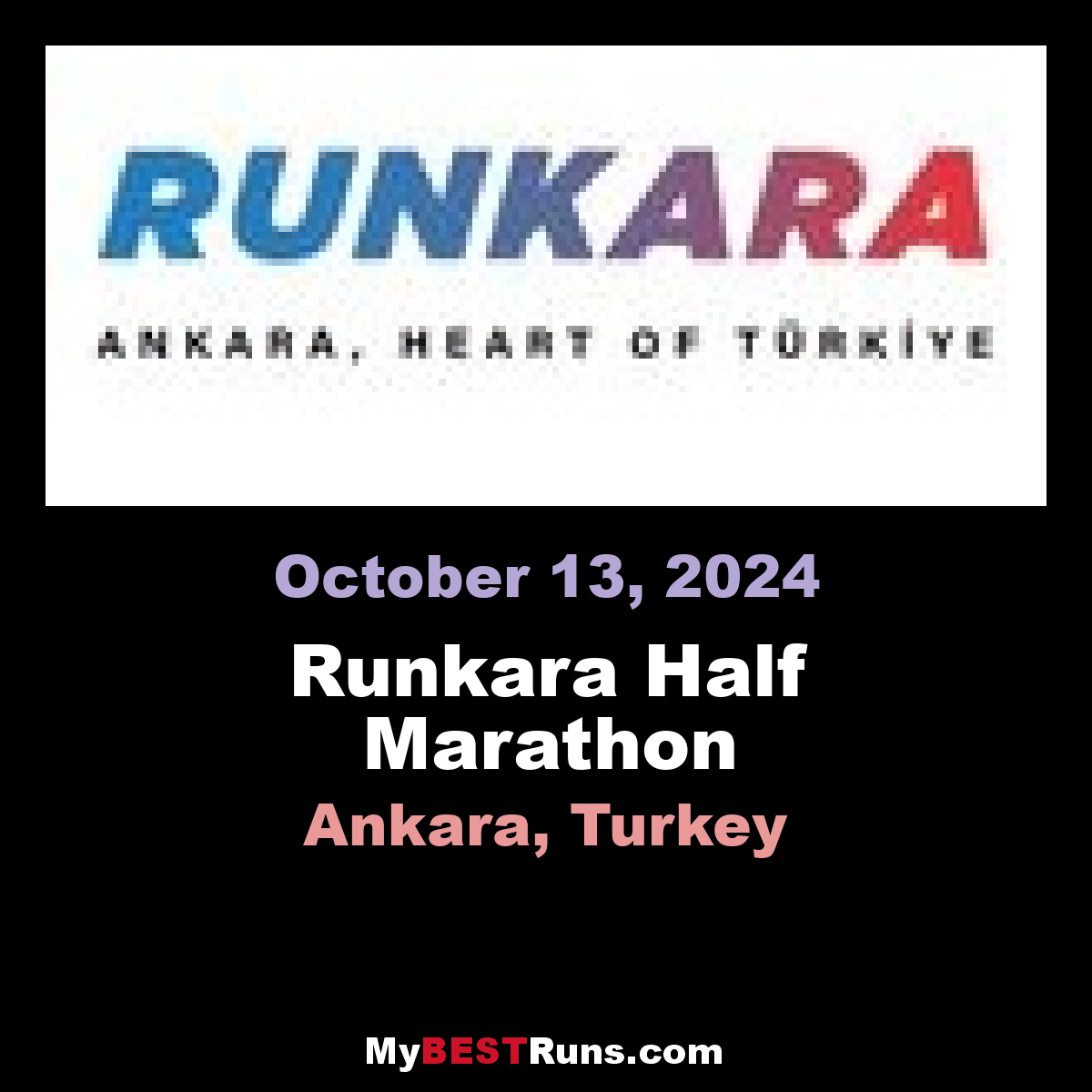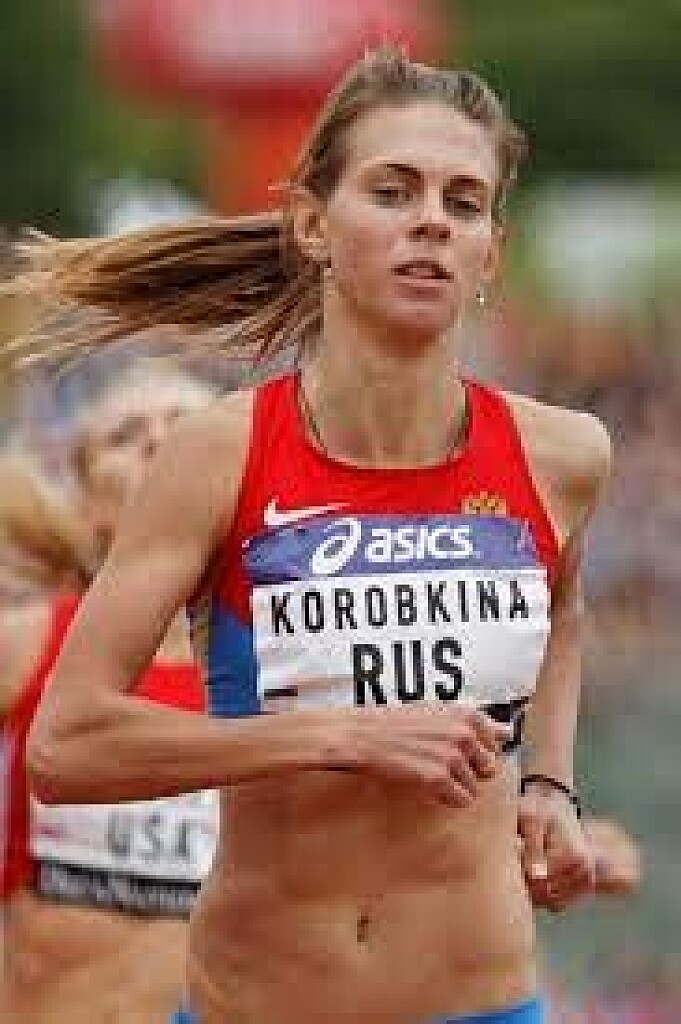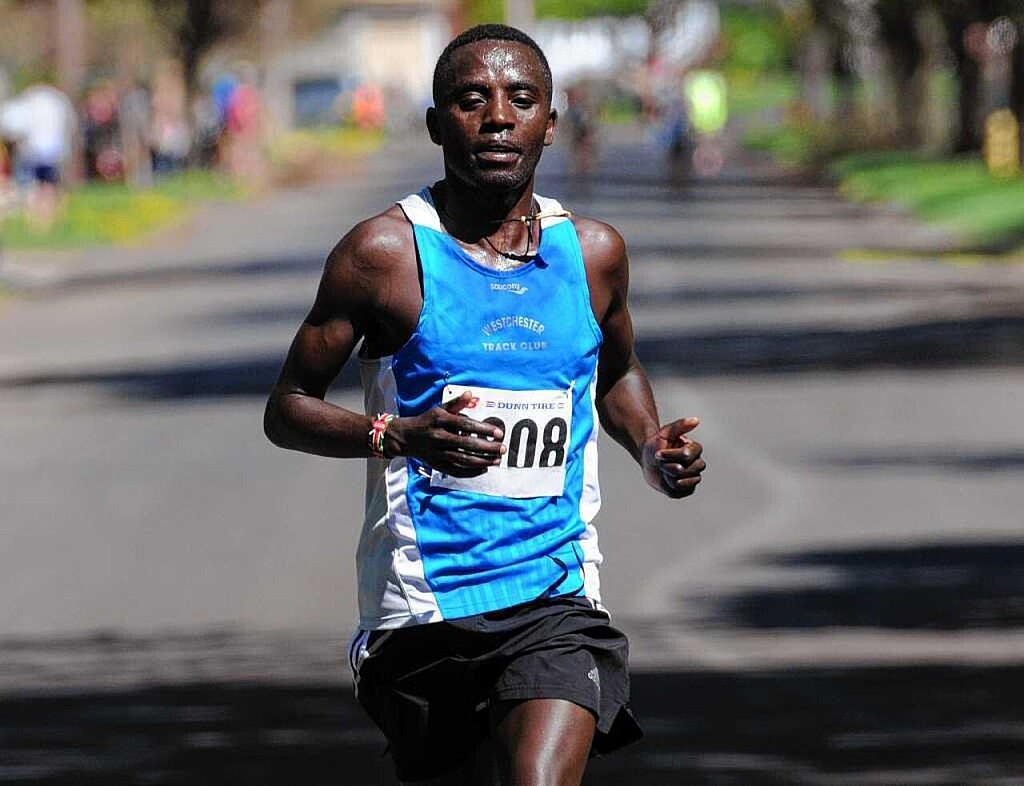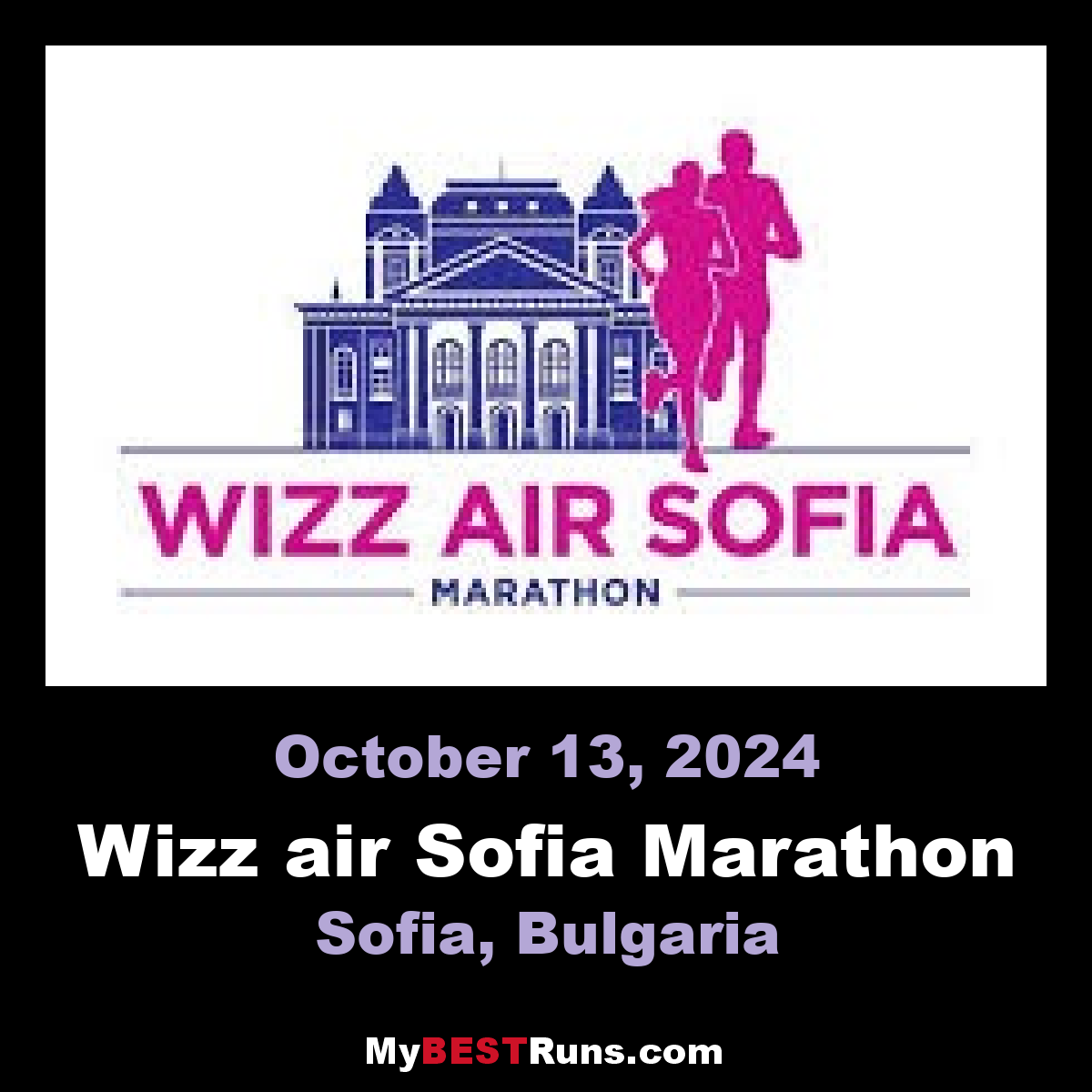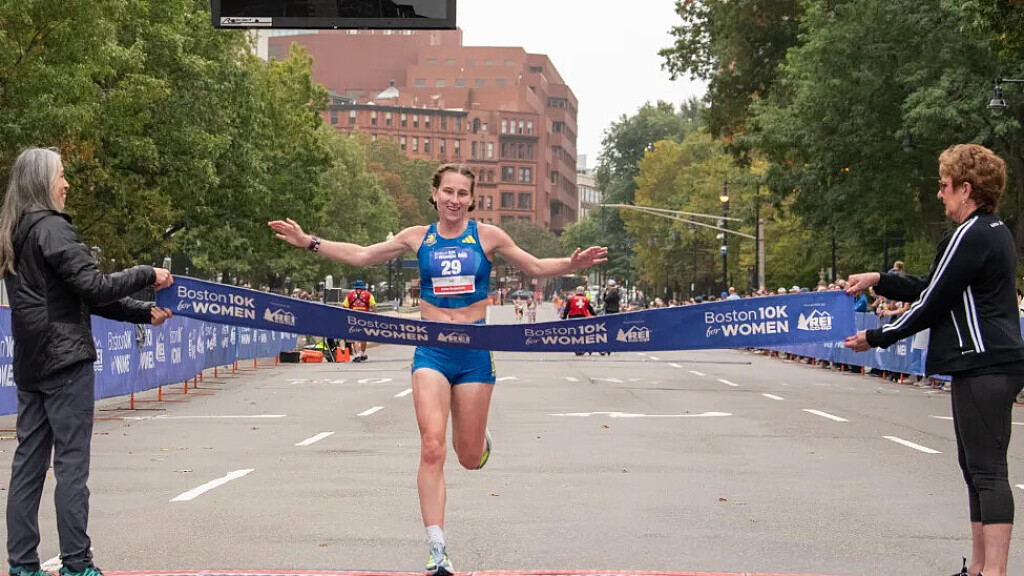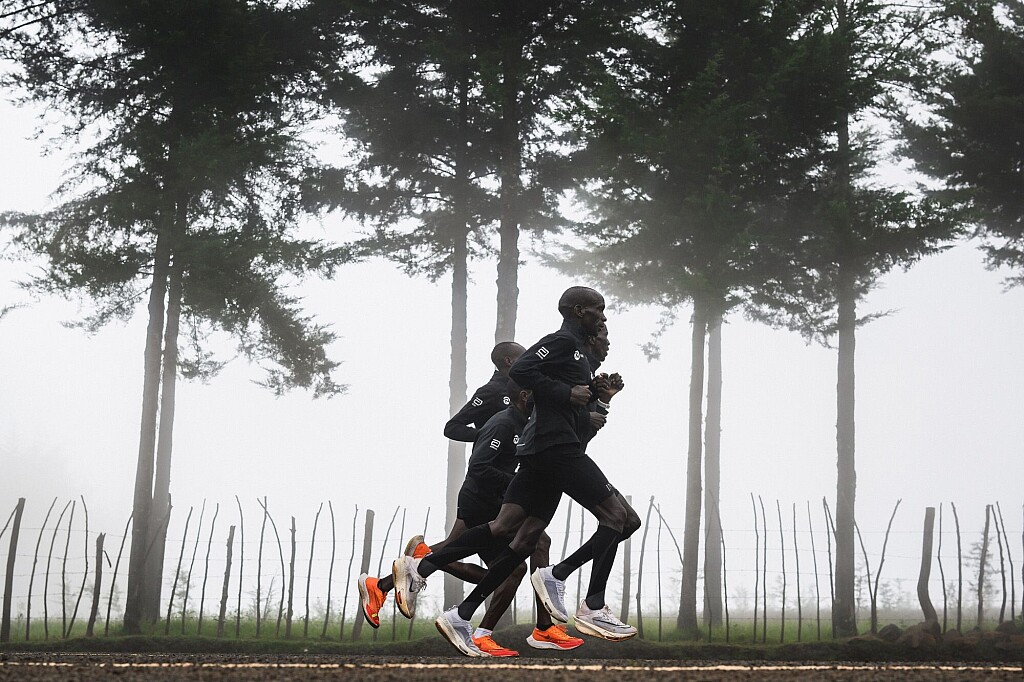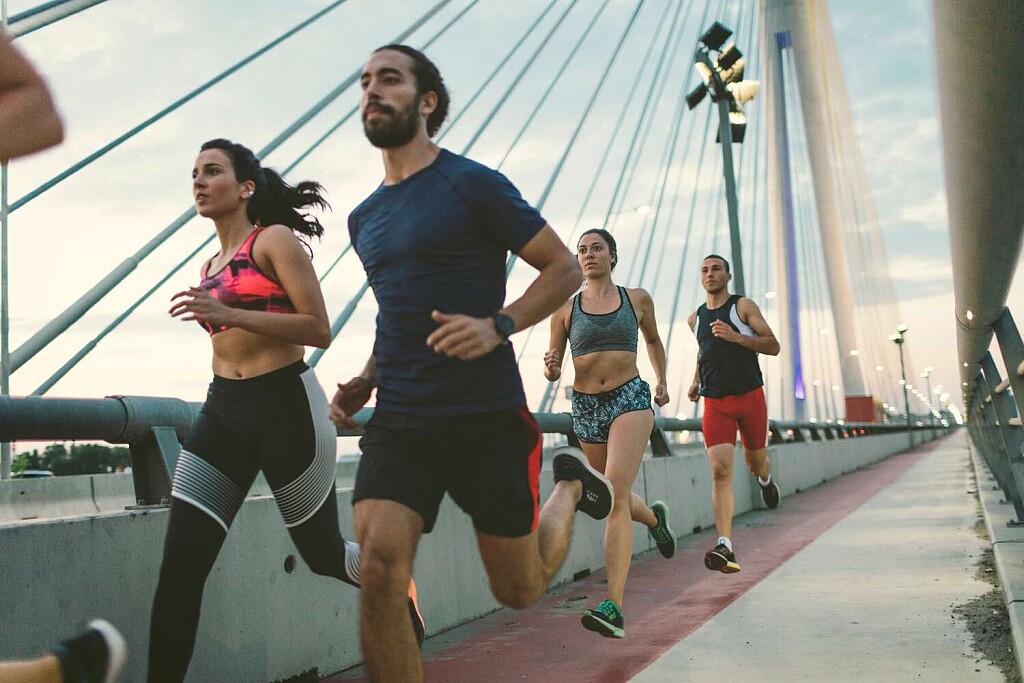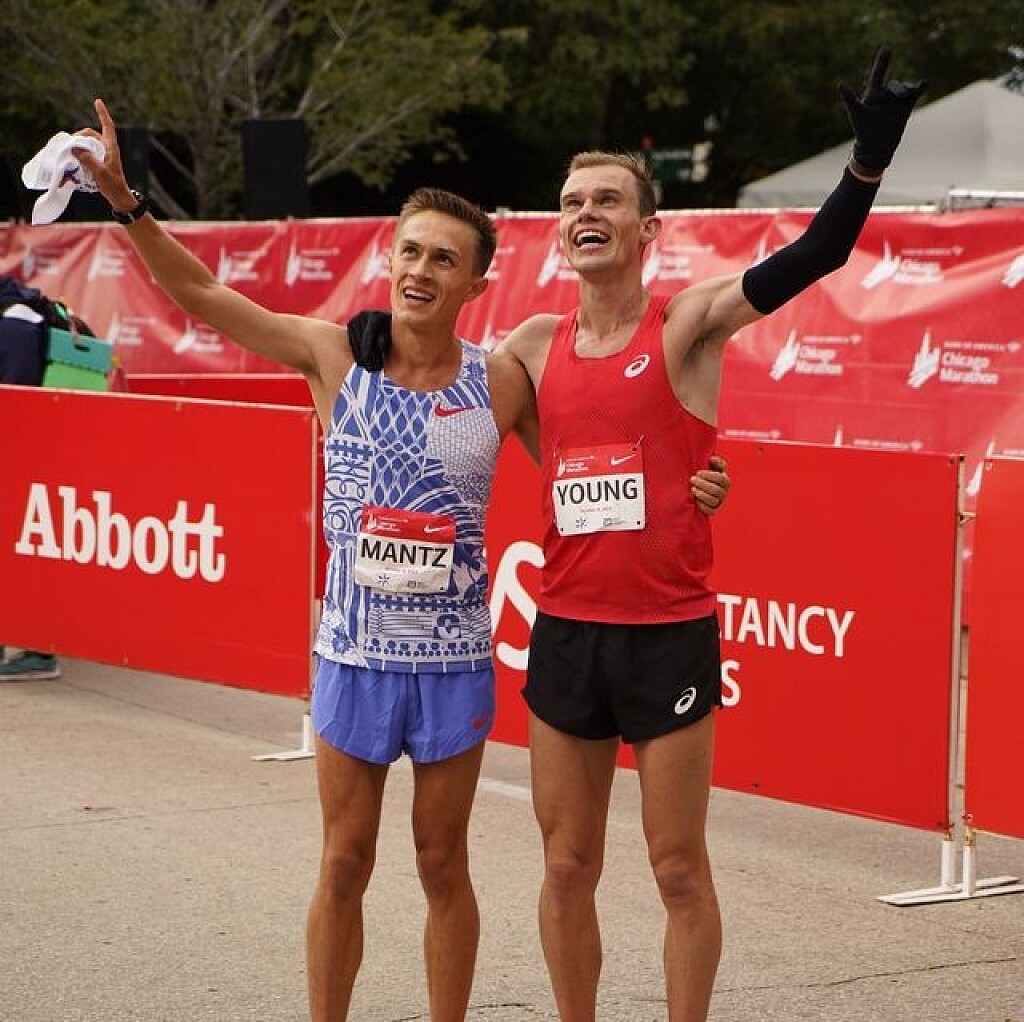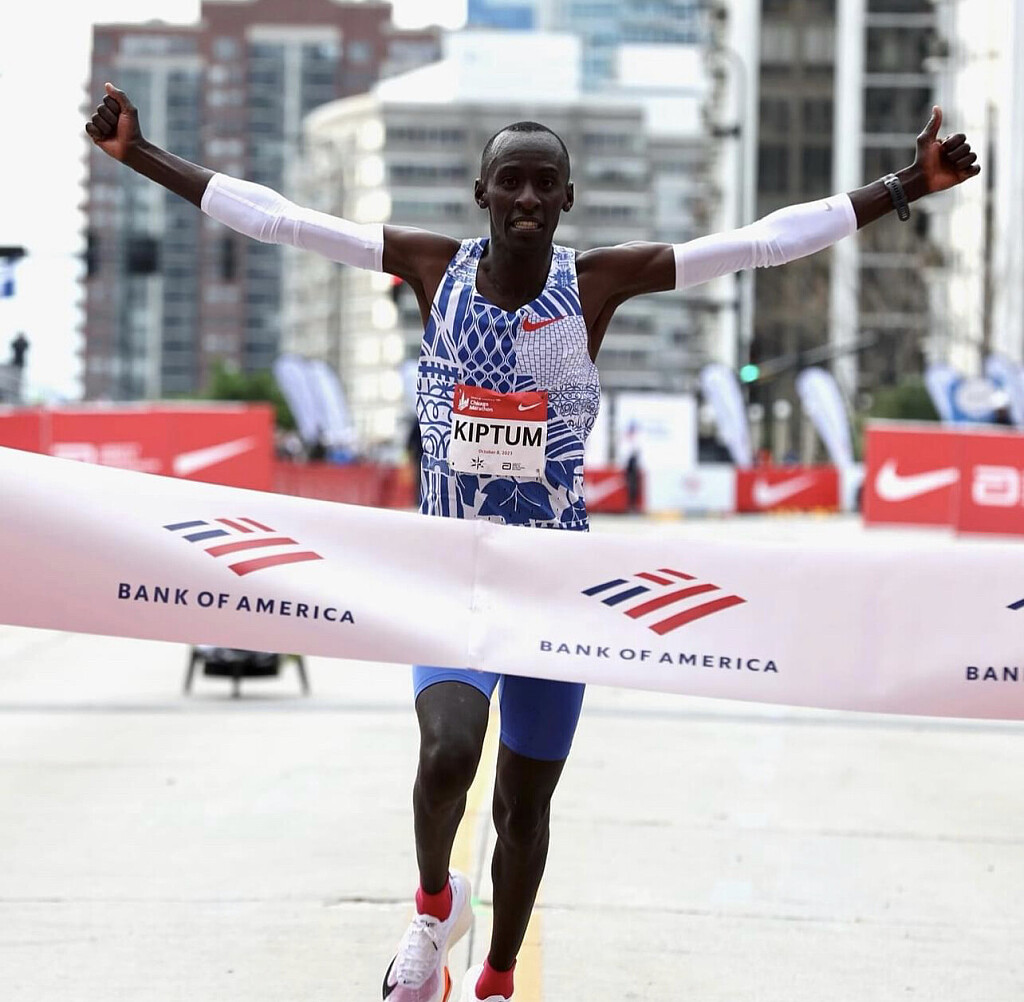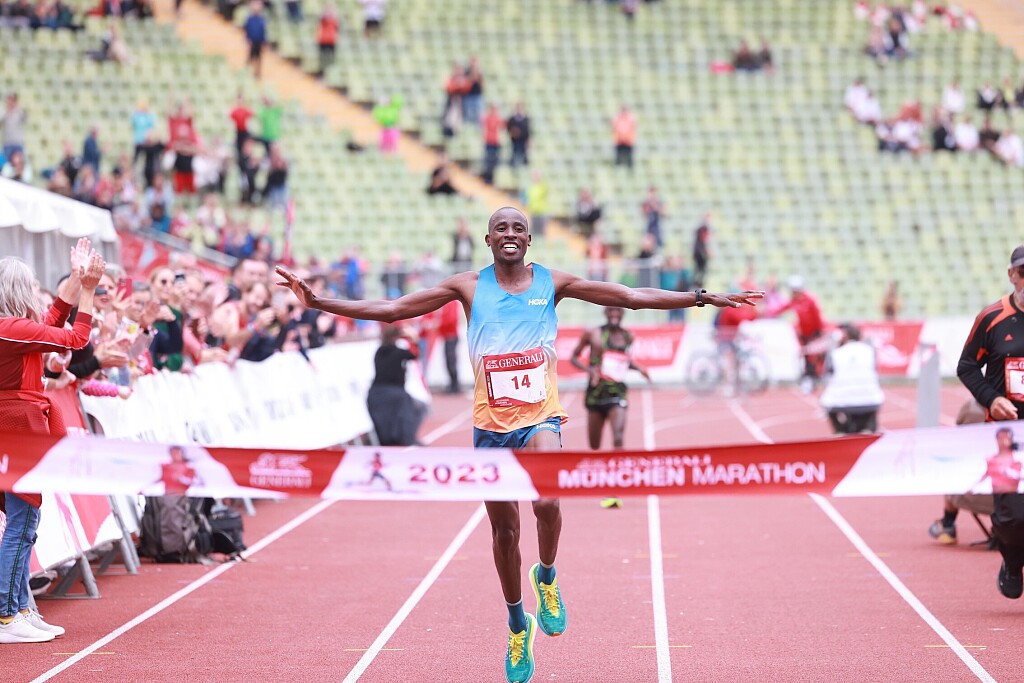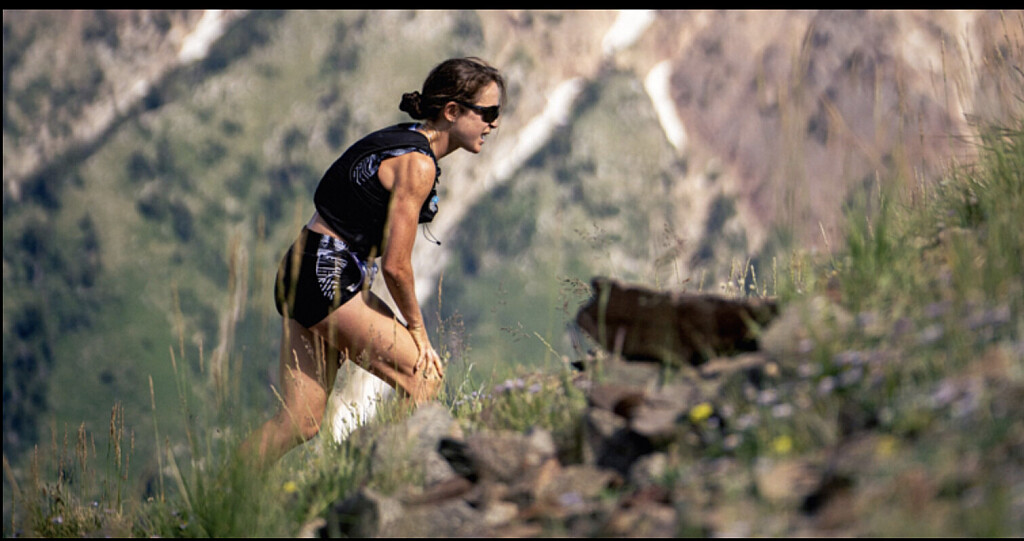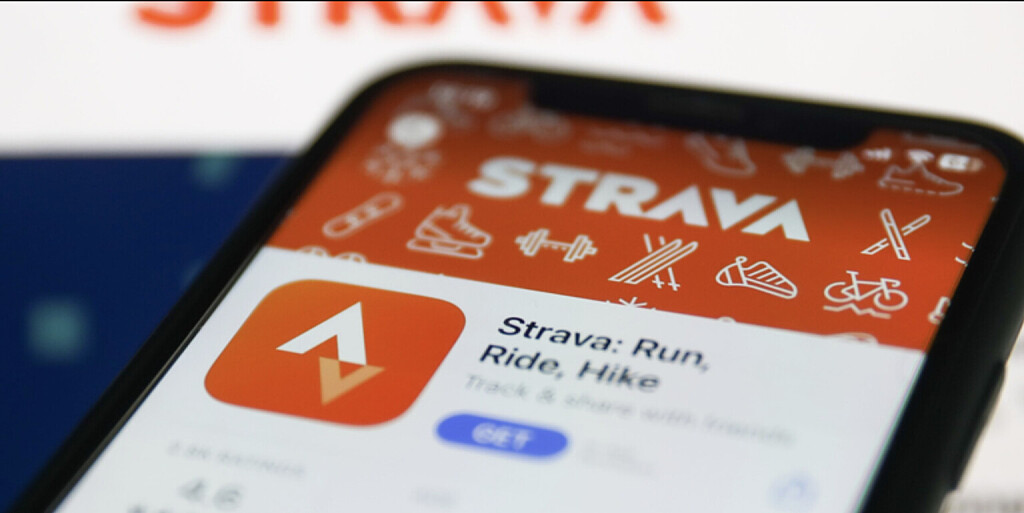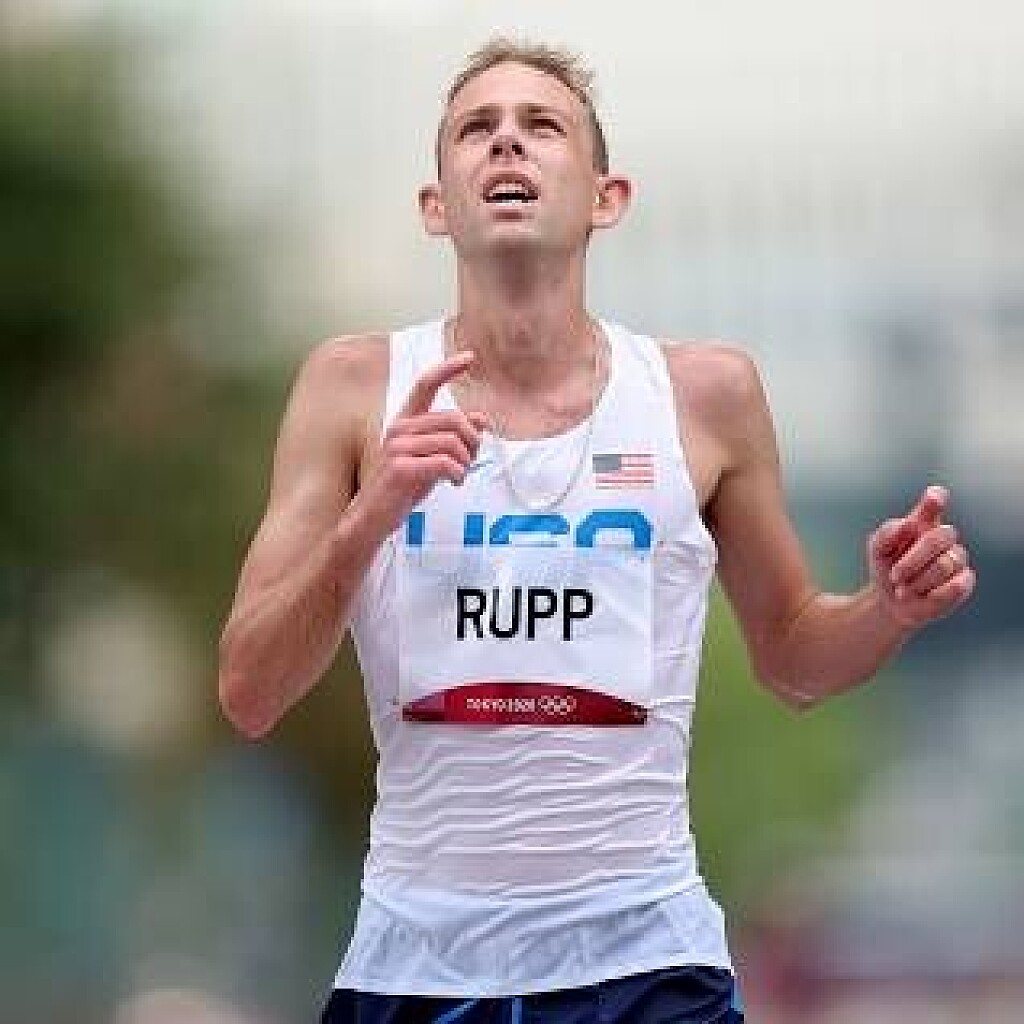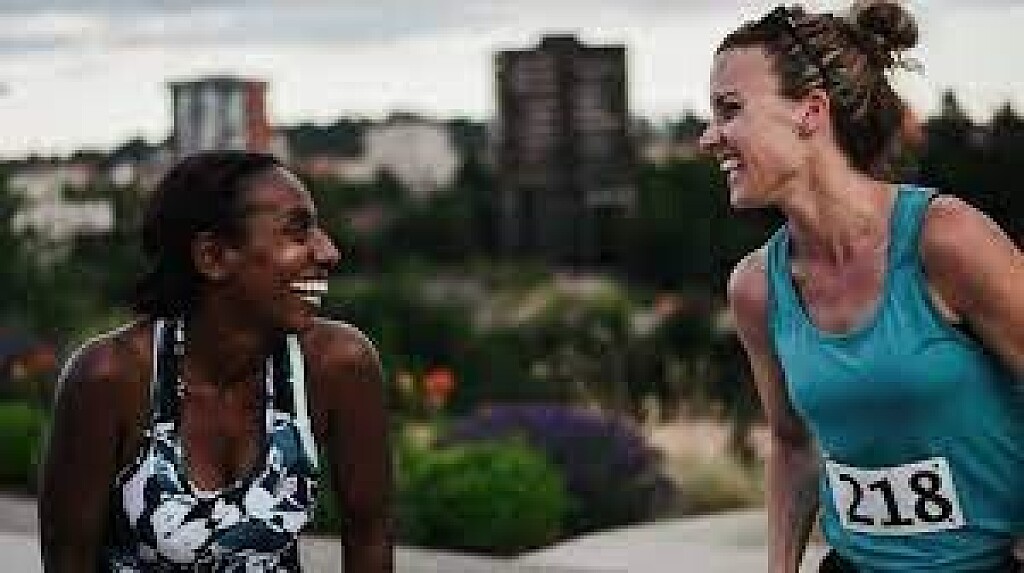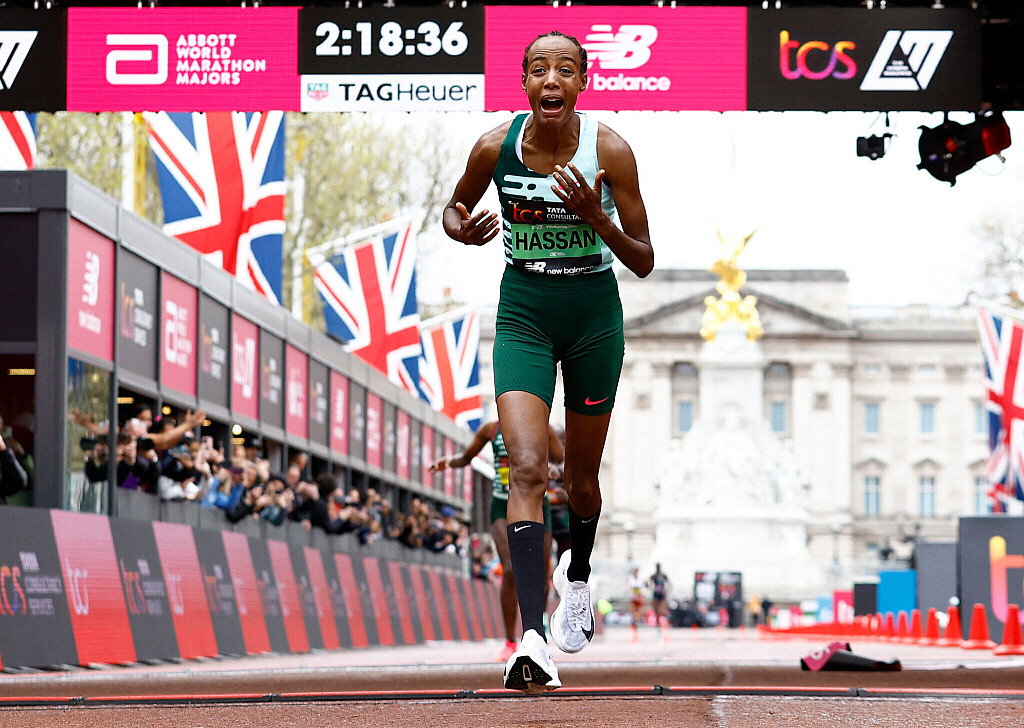Running News Daily
Running News Daily is edited by Bob Anderson in Mountain View, California USA and team in Thika Kenya, La Piedad Mexico, Bend Oregon, Chandler Arizona and Monforte da Beira Portugal. Send your news items to bob@mybestruns.com Advertising opportunities available. Over one million readers and growing. Train the Kenyan Way at KATA Running Retreat Kenya. (Kenyan Athletics Training Academy) in Thika Kenya. Opening in june 2024 KATA Running retreat Portugal. Learn more about Bob Anderson, MBR publisher and KATA director/owner, take a look at A Long Run the movie covering Bob's 50 race challenge.
Index to Daily Posts · Sign Up For Updates · Run The World Feed
Kenyan Irine Cheptai the latest addition to deep Valencia Half Marathon women's field
The Valencia Half Marathon will be Cheptai's second race of the season.
Irine Cheptai will be looking to extend her winning streak after being a late addition to the 2023 Valencia Half Marathon scheduled for Sunday, October 22.
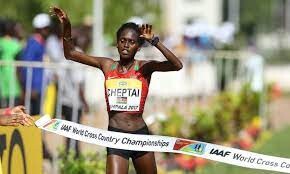
Cheptai has only competed once this season, at the Copenhagen Half Marathon where she dominated, clocking 1:05:53 to win the race.
The 31-year-old will be competing in the streets of Valencia for the first time and will be banking on her half marathon experience on other courses to also impress in Spain’s capital.
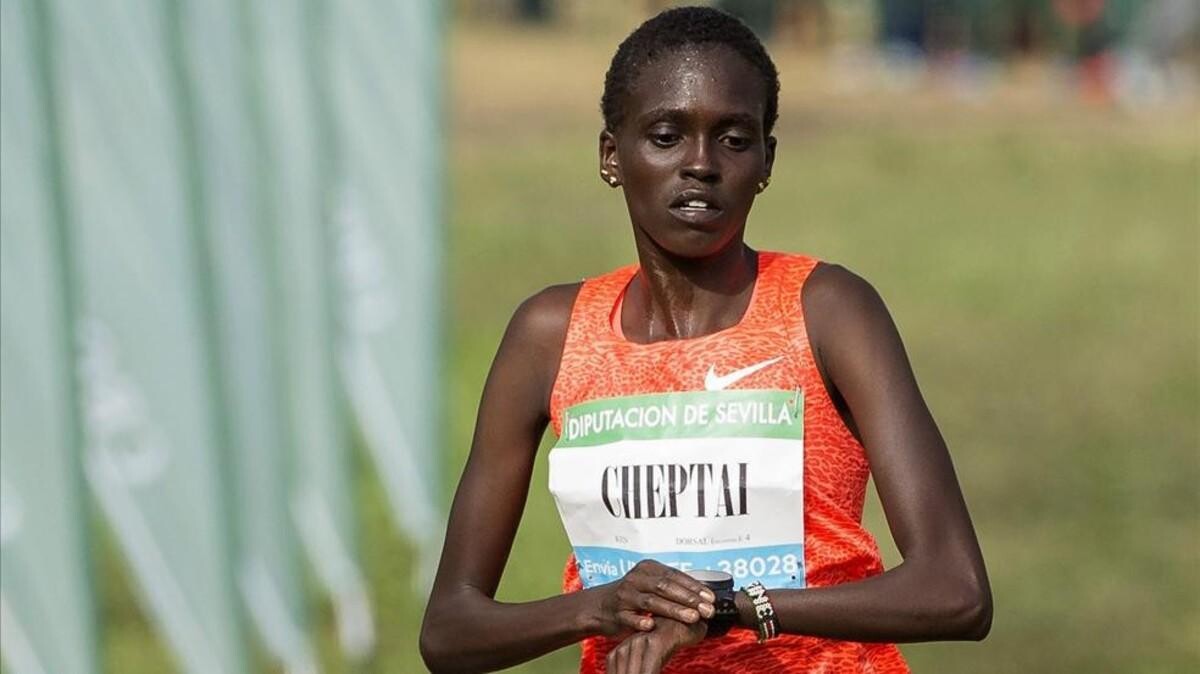
Last year, she had a busy season as compared to this year where she will only be racing twice. In 2022, Cheptai opened her season with second-place finishes at both the New York City Half Marathon and Prague Half Marathon.
The Commonwealth Games 10,000m silver medalist then went ahead to win the TCS World 10K Bengaluru before heading to the 2022 National Trials for the World Championships and Commonwealth Games.
Before competing at the Commonwealth Games held in Birmingham, Cheptai went to the AJC Peachtree Road Race and finished second, and then she finished second in Birmingham too.
She later won the Birell Prague Grand Prix and ended her season with a win at the Vedanta Delhi Half Marathon, one of her favorite courses.
She still seems to be in good shape after opening her season late and being able to secure a resounding victory. However, the field in Valencia is nothing to play around with.
She will face off against former World marathon champion Gotytom Gebreslase. The Ethiopian will be competing in her second Half Marathon race after opening her season with a second-place finish at the Ras Al Khaimah Half Marathon.
Cheptai will also enjoy good company from her compatriots including the World Half Marathon silver medalist Margaret Chelimo, and Janet Chepng’etich.
(10/18/2023) ⚡AMPby Abigael Wuafula
Rick Rayman, 77, completes his 400th marathon at TCS Toronto Waterfront Marathon
On Sunday at the TCS Toronto Waterfront Marathon, Rick Rayman, a professor of dentistry at the University of Toronto, marked his 400th marathon finish. Rayman is 77, and not only has he now completed 400 marathons, but he has participated in every single Toronto Waterfront Marathon in the race’s 34-year history.
As if that weren’t enough, Rayman has also run every single day for the past 44 years and 10 months–a daily run streak that’s topped by only one individual in Canada, according to runeveryday.com. (That’s Simon Laporte of Notre-Dame des Prairies, Que., whose streak is three years longer. Rayman is #20 on the international run streak list.) “I don’t know if the 19 runners ahead of me have run as many marathons as I have, but who cares?” he says, adding, “The older and slower I get, the more notoriety I get.”
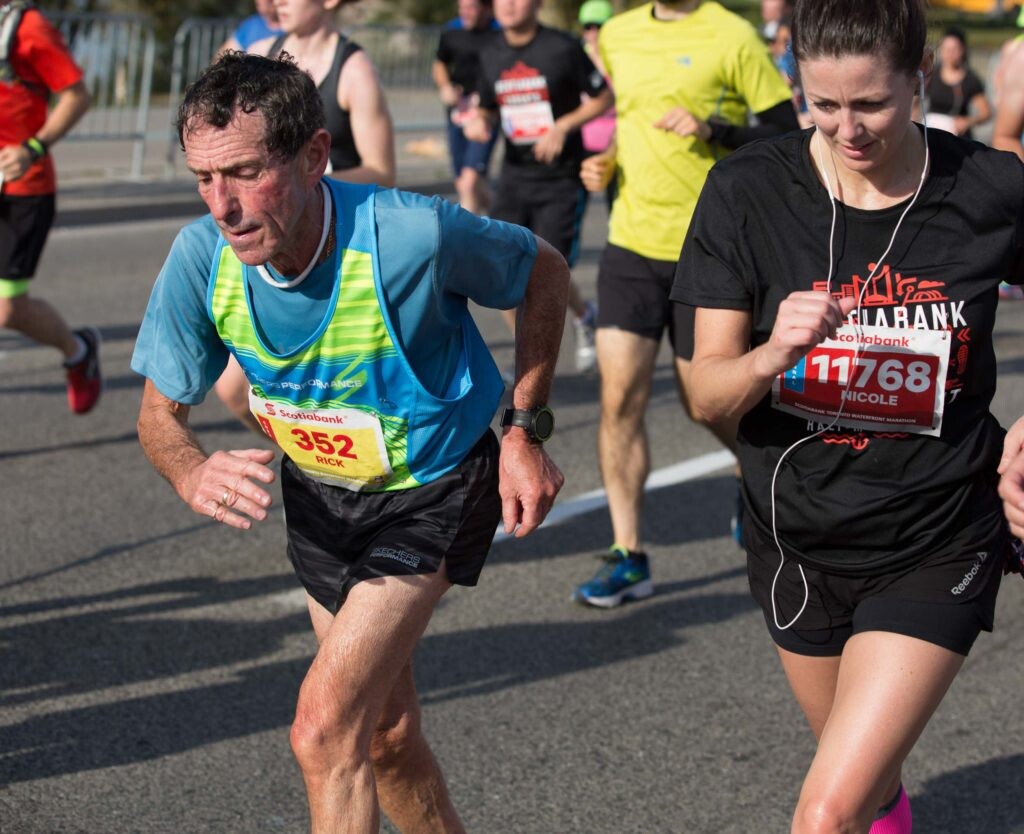
On Dec. 10, he’ll celebrate 45 years of running without missing a single day. He runs for at least half an hour, though some days he runs for an hour or two. And he takes care to add that he never runs on a treadmill–though he has participated in 10 indoor marathons in the past, including six at York University, three at the University of Toronto’s Hart House and one the SkyDome (now the Rogers Center).
“It’s such a great marathon!” Rayman says of the Toronto race, even though he struggled with back pain in the second half, most of which he walked. “I can run 12 miles (or 20 km) without any pain,” he says. When asked if he’s ever considered switching to the half-marathon, he replies, “Never.”
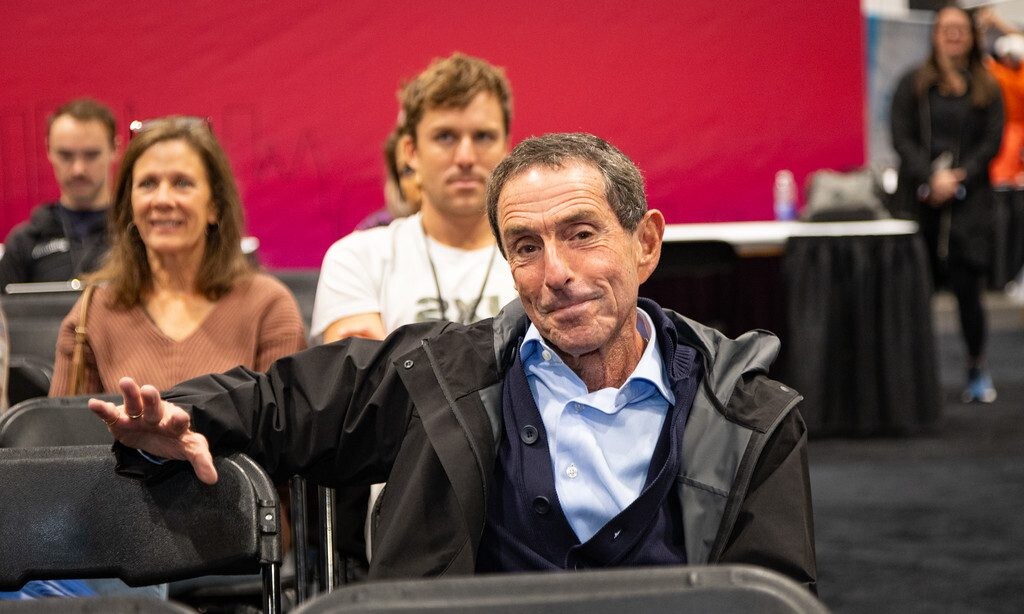
“It’s a good question,” he concedes, “because my half marathon time is considerably better than my full. But I enjoy the challenge of the marathon.” Rayman was the only individual in the M75-79 age category.
Over the years, Rayman has seen a few changes at the Toronto Waterfront Marathon. The technology for tracking runners on the course, in particular, has evolved considerably since the early days, and he enjoys the recent changes to the course, which allow midpackers and back-of-the-packers like himself to see the elites running past in the other direction on Wellington Street and Eastern Ave. He credits race director Alan Brookes and his staff at Canada Running Series with putting on a world-class event.
Rayman admits he’s slowing down. “I’m not going to do another marathon this year,” he says, adding that next year, he has plans to run the Fort Lauderdale Marathon in February, Ontario’s Georgina Marathon in the spring, the Buffalo Marathon in May and the marathon at the Niagara Ultra in June. “I did 11 [marathons] this year; I might cut that in half next year. Maybe six or seven.”
Regardless, you can catch him running every day, rain or shine, from his home in North York. “I’ll keep doing it until I can’t,” he says.
(10/17/2023) ⚡AMP
by Anne Francis
TCS Toronto Waterfront Marathon
The Scotiabank Toronto Waterfront Marathon, Half-Marathon & 5k Run / Walk is organized by Canada Running Series Inc., organizers of the Canada Running Series, "A selection of Canada's best runs!" Canada Running Series annually organizes eight events in Montreal, Toronto and Vancouver that vary in distance from the 5k to the marathon. The Scotiabank Toronto Waterfront Marathon and Half-Marathon are...
more...Why Mary Moraa dedicated her world title to Hellen Obiri
Mary Moraa has explained why she dedicated her World 800m title to the reigning Boston Marathon champion Hellen Obiri.
World 800m champion Mary Moraa has disclosed the reason why she dedicated her title to her mentor Hellen Obiri.
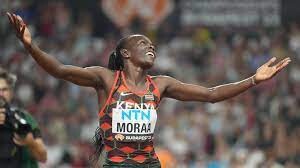
The Commonwealth Games champion singled out Obiri, a two-time World 5000m champion, as a great pillar in her career.
Speaking to Nation Sport, Moraa noted that she sees Obiri as her elder sister and she always checks up on her.
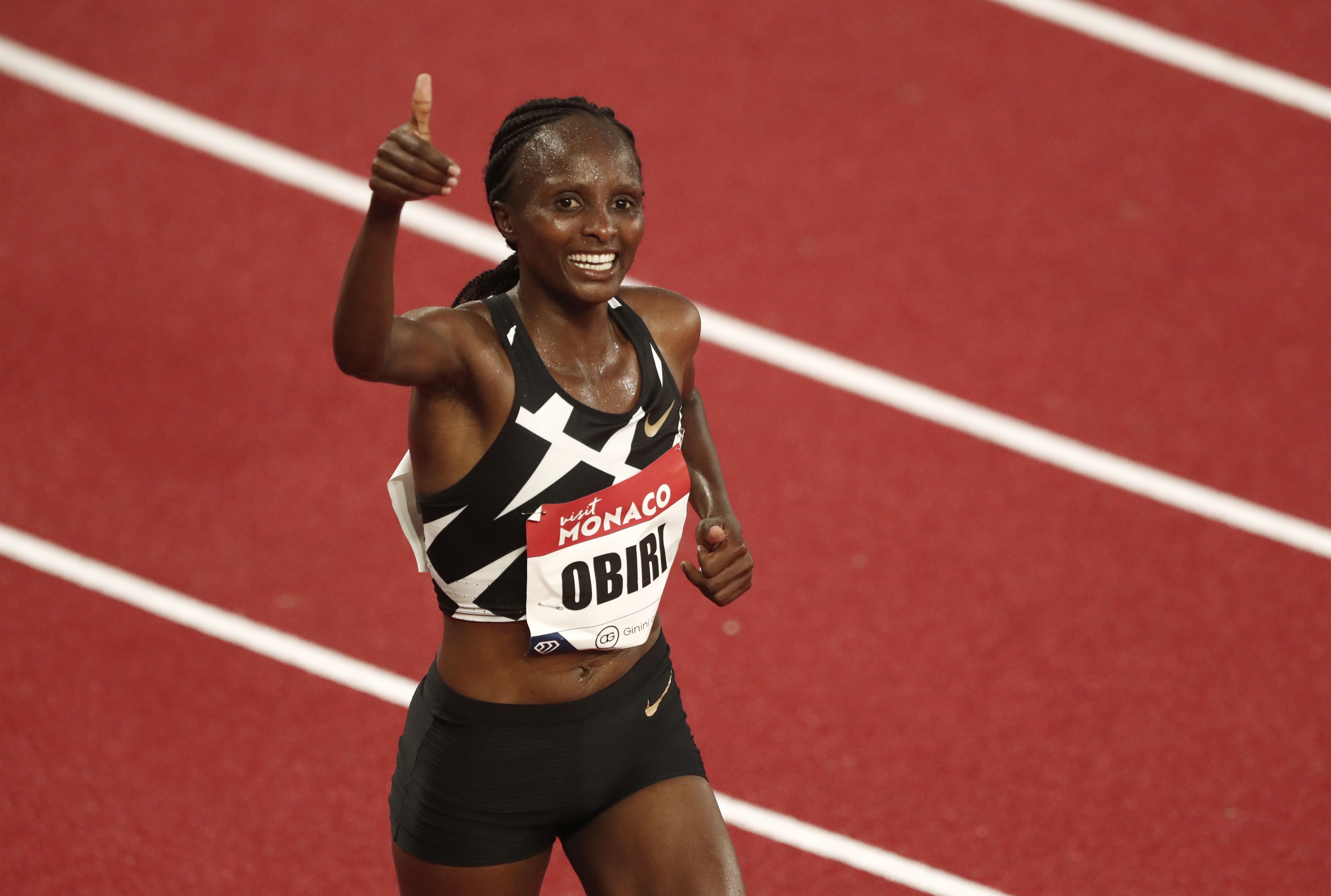
Obiri has played a vital role in Moraa’s career since she gifted Kisii Express her first spikes when she began her professional career. The Boston Marathon champion also encouraged Moraa to switch from the 400m to the 800m where she is currently dominating.
“I want to single out Hellen Obiri who has been encouraging me to be consistent on the track as the person who ensured I clinched the gold.
"Obiri is my elder sister and mentor who always checks on me hence I am proud of her,” Moraa said during her heroic homecoming party at the Ichuni grounds in Nyaribari Masaba constituency.
Meanwhile, at the World Championships in Budapest, Hungary, Moraa was in a class of her own as she destroyed a strong field to clinch top honours in the 800m race.
She clocked a Personal Best time of 1:56.03. Great Britain’s Keely Hodgkinson and USA’s Athing Mu finished second and third respectively in the hotly contested race.
Owing to her win, she became just but the third Kenyan to win the 800m on the global stage after Janeth Jepkosgei and Eunice Sum who won the titles during the 2007 and 2013 editions of the World Championships.
Moraa was also on fire this season, only losing one 800m where she finished fourth at the Prefontaine Classic, the final Diamond League Meeting.
(10/17/2023) ⚡AMPby Abigael Wuafula
Omanyala sets new target for Paris 2024 Olympic Games
Africa’s fastest man Ferdinand Omanyala has set a new target for the forthcoming 2024 Paris Olympic Games.
The African 100m record holder said he is targeting gold at the Paris Olympic Games as he heads into the season with great motivation.
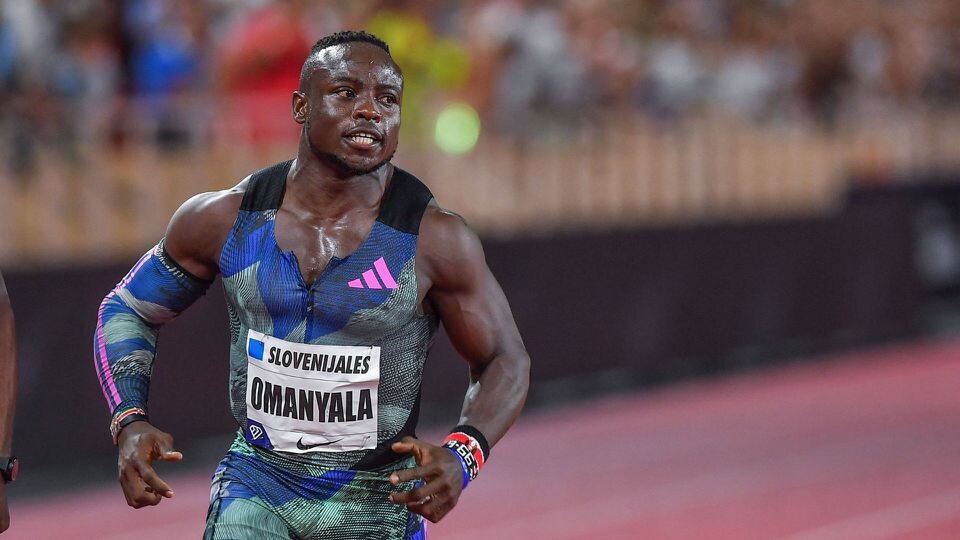
The Paris 2024 Olympics are scheduled for July 26 to August 11 and it is expected to host 10,500 athletes.
The world number nine said this during the launch of an Athletics Centre of Excellence at St. Joseph’s Boys national school on Monday.
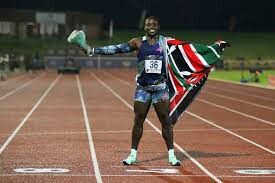
The sprinter also added that his next target was to run a time of 9.66 seconds but was quick to add that he will have to work hard to attain that threshold.
“I am going to the Olympic season with great motivation. If you see me win that gold, be happy because it’s coming home. My next aim is to run 9.66 then after that 9.55,” he said.
Omanyala also said he would be opening a sprints school to help train young upcoming athletes so they may be able to grace the international stage.
“We are starting a school for sprints next year and I am pleased to announce that St. Joseph's will be the first benefactor of this program as we aim to help the youth horn their talents in athletics,” he noted.
The sprinter also urged young upcoming athletes to be careful of the managers they sign for, as there have been several cases of managers mistreating athletes and leading them to poverty.
“There are those fine lines in a contract you must go through. Most athletes have suffered this fate so you have to be keen. Those little details are very important,” he said.
Omanyala came into the limelight in 2015 when he won 100m in a time of 10.37 secs during the national Olympics trials but failed to attain the qualifying standard, which was 10.16 secs at the time.
He would later on go to win the national title in 2019 and later on in March 30 2021, he set a national record of 10.01 seconds in the 100m after winning a meeting at Yabatech Sport Complex in Lagos, Nigeria.
In 2022, he won his first international championships, with victories in the 100m at the Commonwealth Games, and African Athletics Championships.
Omanyala is the African record holder and the ninth-fastest man of all time in the event after clocking a time of 9.77 seconds on September 18, 2021 in Nairobi. He is also the first Kenyan to reach the semi-finals of the 100m at the Olympics stage.
The sprinter took part at the World Athletics Championships in Budapest, Hungary, last August finishing seventh in the final in a time of 10.07 seconds.
Omanyala further urged young athletes to be careful of the doctors, who they put their trust in as he has unknowingly been a victim of a doping.
Following his doping offence in 2017, Omanyala received a 14-month suspension.
He had tested positive for the prohibited substance betamethasone, after undergoing treatment for his back injury which he incurred during training.
Athletics Kenya (AK) Trans Nzoia county official, Evans Rono urged the youth to take up athletics as it was a highly lucrative career.
“Athletics is highly paying. Omanyala runs for just nine seconds and walks away with millions. I want to challenge you to embrace athletics because it is a high paying sport."
(10/17/2023) ⚡AMPby Teddy Mulei
Paris 2024 Olympic Games
For this historic event, the City of Light is thinking big! Visitors will be able to watch events at top sporting venues in Paris and the Paris region, as well as at emblematic monuments in the capital visited by several millions of tourists each year. The promise of exceptional moments to experience in an exceptional setting! A great way to...
more...Cam Levins’s bonkers workout ahead of New York City Marathon
We are less than three weeks away from Cam Levins, Canada’s marathon record holder, toeing the start line at the 2023 TCS New York City Marathon on Nov. 5. If you have not been following his Strava workouts or recent races, you might be surprised to find out that he might be in the best shape of his life.
The 34-year-old athlete is in the final few weeks of peak training before tapering for the NYC Marathon. On Oct. 12, he threw down an impressive one-kilometer workout, maintaining an average pace of two minutes and 45 seconds per kilometer for 12 reps, with only one minute’s rest between reps.
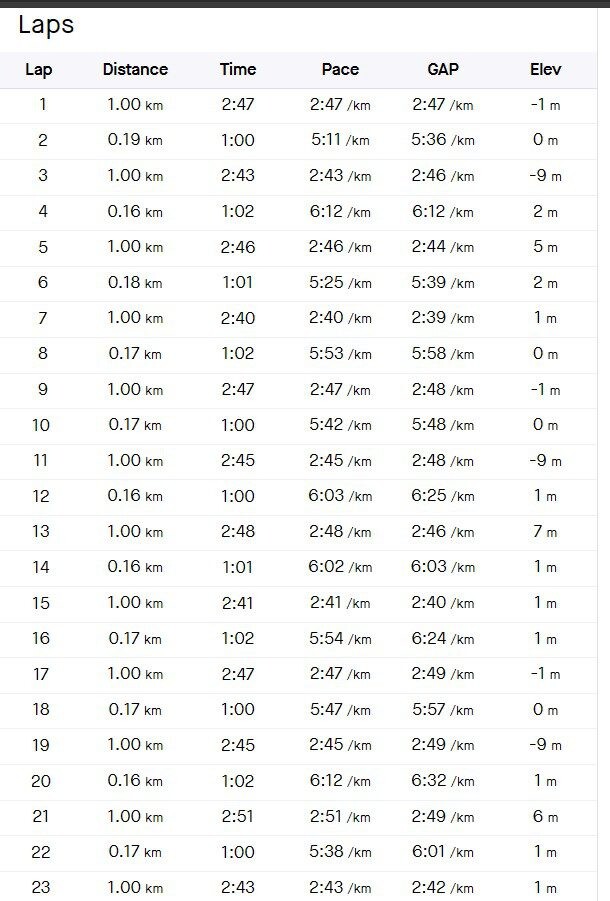
The workout
12 sets of 1K, with one minute of jog rest @ 2:40-2:50/km
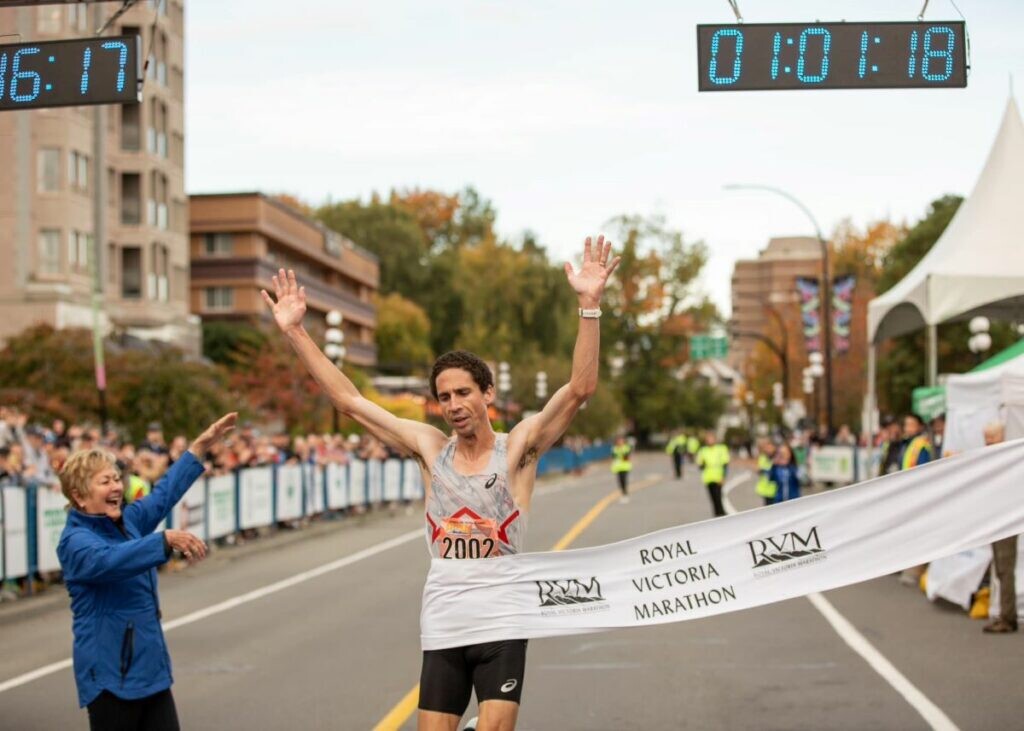
This workout is specifically designed for those training for a half-marathon or marathon, with short rest periods to acclimatize them to a faster pace. Levins pushed his limits during this session, clocking his fastest rep at 2:40 per kilometer and his slowest at 2:51 per kilometer, resulting in an astonishing 2:45 per kilometer average pace. This pace equates to an incredible 58 minutes for a half-marathon. (His Canadian record is 60:18.)
In his last two marathon outings, Levins achieved something historic for Canada, breaking the national record on both occasions. He also secured a top-five finish at both the 2022 World Championships and the 2023 Tokyo Marathon.
Levins chose to race the New York Marathon in his build-up to the 2024 Paris Olympic Games. The marathon course in Paris has a challenging elevation gain of more than 400 meters across 42.2 kilometers.
Of the six Abbott World Marathon Majors, New York and Boston are considered the most challenging. New York’s difficulty is attributed primarily to the four bridges participants must cross as they wind through the city’s five boroughs, with the Verrazzano-Narrows and Queensboro Bridges both extending to a distance of more than one kilometer each.
With the recent announcement that the 2022 NYC champion, Evans Chebet, and the two-time NYC champion, Geoffrey Kamworor, have both withdrawn due to injury, the 2023 race will see a new champion crowned in Central Park on Nov. 5. Could it be Levins? His fitness seems to indicate that he could–and if he does, he will be the first Canadian ever to win the New York City Marathon.
(10/17/2023) ⚡AMPby Marley Dickinson
TCS New York City Marathon
The first New York City Marathon, organized in 1970 by Fred Lebow and Vince Chiappetta, was held entirely in Central Park. Of 127 entrants, only 55 men finished; the sole female entrant dropped out due to illness. Winners were given inexpensive wristwatches and recycled baseball and bowling trophies. The entry fee was $1 and the total event budget...
more...Ethiopia’s Buze Diriba wins the TCS Toronto Waterfront Marathon in a wild finish
On a windy marathon morning in Toronto, the women’s race came down to the wire, as four athletes, all of them from Ethiopia, finished within seven seconds of each other. Ethiopia’s Buze Diriba Kejela was quickest to the line, taking the win in 2:23:11–a five-minute personal best.
Diriba was closely followed by 2023 Ottawa Marathon champion Waganesh Mekasha in second place (2:23:12) and Afera Godfay in third (2:23:15). This was the closest finish between a top three in the race’s history. The women were paced by Kingston, Ont.’s Kevin Coffey through 30K.
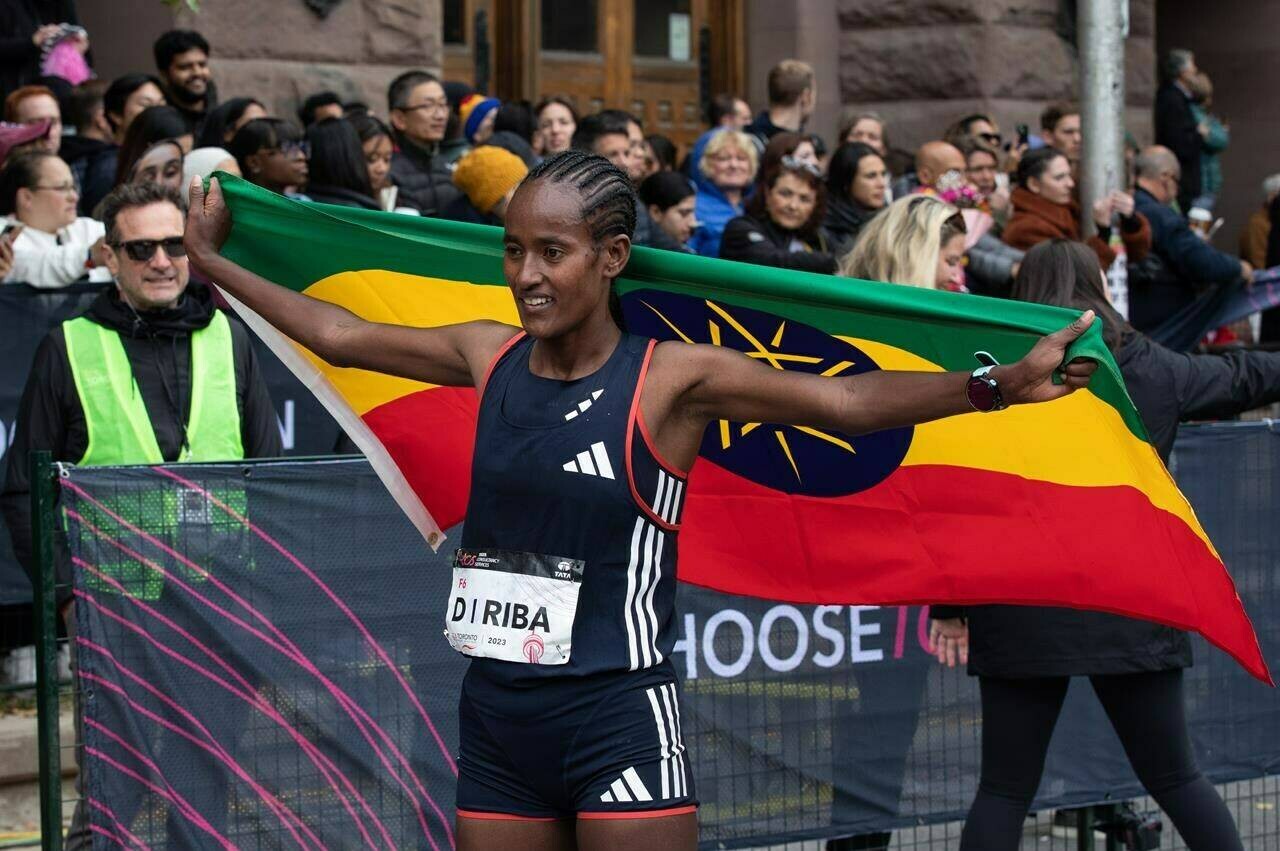
Fozya Jemal Amid was right on their heels, finishing fourth in 2:23:18 (a personal best); the U.S.’s Emily Durgin finished fifth in 2:26:46 in her debut marathon, nabbing herself a 2024 Olympic marathon qualifying time in the closest of margins. Durgin was the fastest North American finisher on the course, finishing three minutes ahead of her compatriot Molly Grabill.
The women were within course record pace for most of the race, but the chilly wind on Toronto’s lakeshore took its toll, and the women’s course record of 2:22:16, set in 2019 by Kenya’s Magdalyne Masai, remained intact.
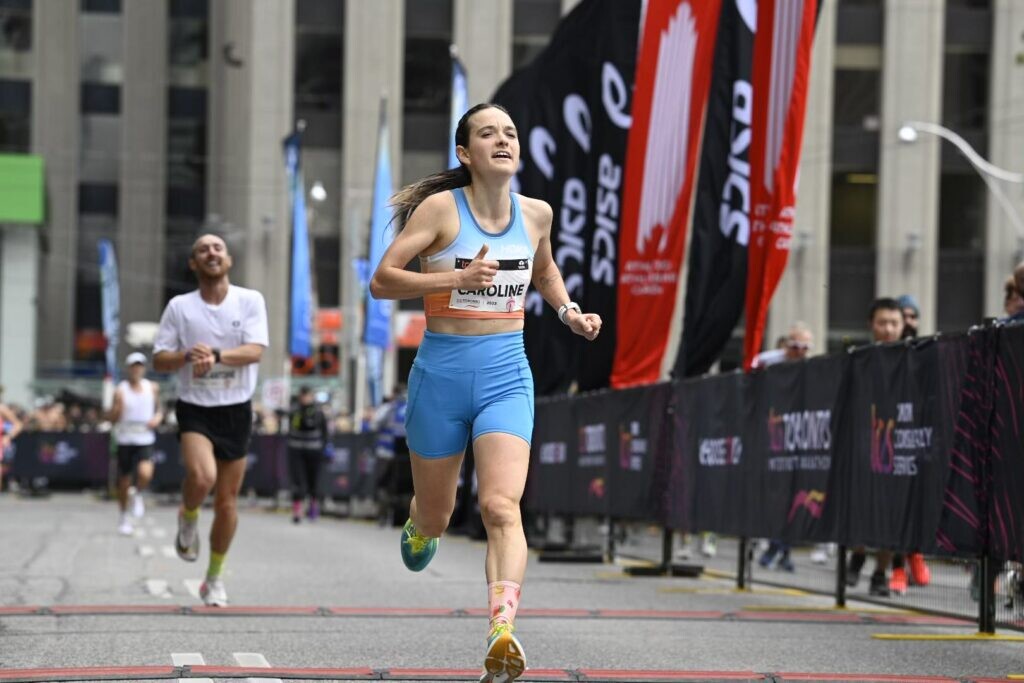
Godfay, who held the fastest seed heading into the race, did not push the pace, never taking a turn at the front to block the wind. “I came here to win, and was upset not to,” said Godfay on her third-place finish. “More speed won at the end.”
At the post-race press conference, Diriba credited her track speed for her ability to separate from the four women in the final kilometre. (She has a personal best of 14:50 for 5,000m.) She came into Sunday’s marathon with a PB of 2:28:06 from the 2019 Houston Marathon.
Pomerleau wins Canadian title
Caroline Pomerleau of Quebec was the surprise winner of the Canadian Marathon Championships, placing 10th overall in her marathon debut, in 2:34:44.
Pomerleau’s goal heading into her first marathon was to run under 2:40. On the final corner, she overtook Anne-Marie Comeau, who had been leading the Canadian women for most of the second half of the race, beating her by seven seconds; Comeau finished as second Canadian, in 2:34:51. Tokyo Olympian Dayna Pidhoresky rounded out the Canadian women’s podium for third, finishing in 2:35:50.
(10/16/2023) ⚡AMPby Marley Dickinson
TCS Toronto Waterfront Marathon
The Scotiabank Toronto Waterfront Marathon, Half-Marathon & 5k Run / Walk is organized by Canada Running Series Inc., organizers of the Canada Running Series, "A selection of Canada's best runs!" Canada Running Series annually organizes eight events in Montreal, Toronto and Vancouver that vary in distance from the 5k to the marathon. The Scotiabank Toronto Waterfront Marathon and Half-Marathon are...
more...Kenenisa Bekele parts way with NN Running Team
The first and only athlete to be crowned an Olympic, World Outdoor, World Indoor and World Cross Country champion, Kenenisa Bekele has parted ways with NN Running team after more than two decades of running under their stable and being a Nike representative.
The contract stated that after agreement between the two parties the Ethiopian track and road legend will participate in Valencia Marathon in December and also take part in the 2024 Paris Olympic which will be his fourth appearance.
NN Running Team through their founder Josephus Maria Melchior “Jos” Hermens, penned a down an emotional letter to the legend, wishing him the very best in the future and that they will still follow him up with great excitement.
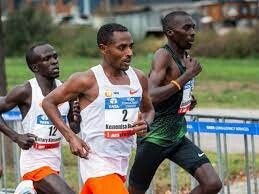
“…we wish you all the best in your next step in running and will follow your upcoming results with great excitement. Thanks for being such a great team mate over the years. We’re always behind you!” said Hermens.
The Ethiopian great has a rich cabinet of 21 global titles (including U20 titles) and who also shattered six world records during his glittering career, has joined the Chinese shoe brand who have promised take long distance running to a new level.
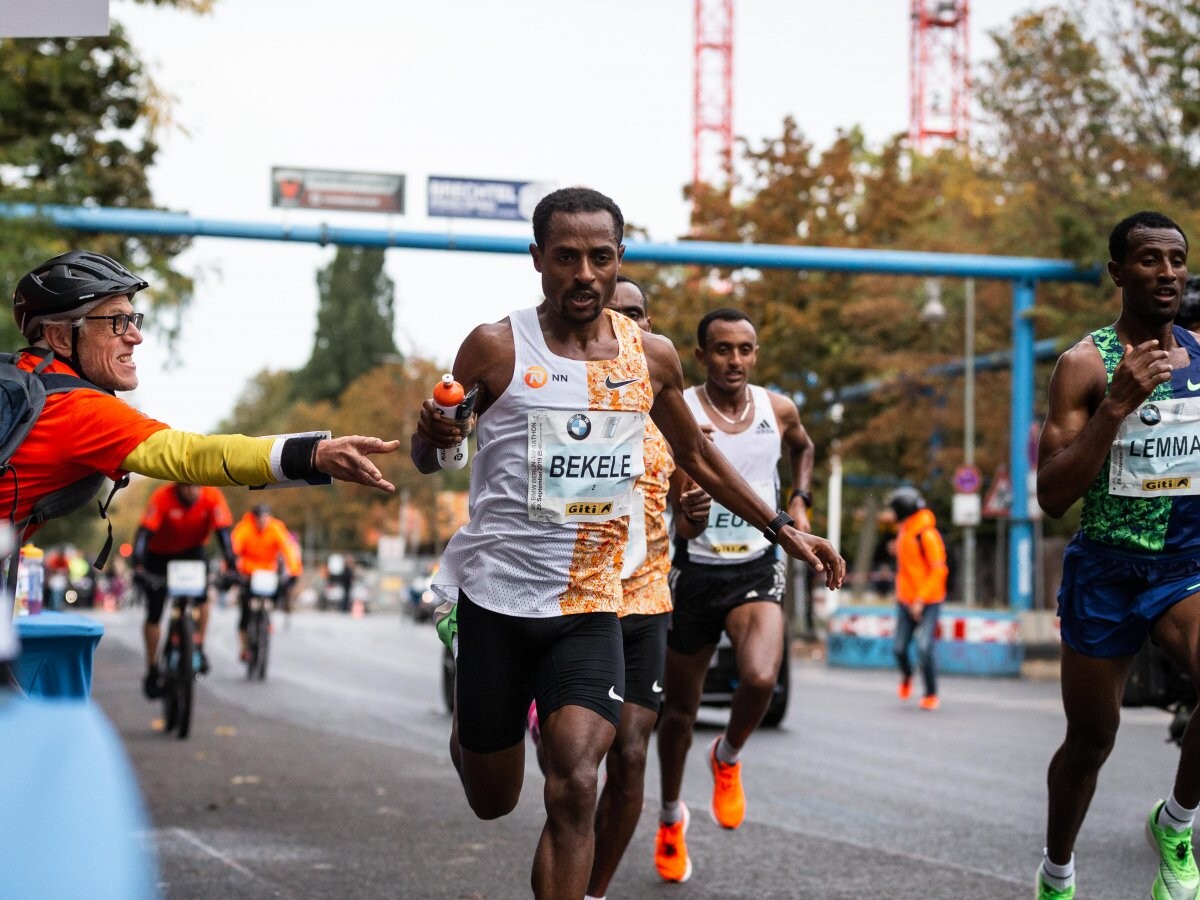
After penning down the contract with brand, ANTA Sportswear, took to their social media page and said,” We’re taking long-distance running to new heights with Kenenisa Bekele! In our partnership we’re looking forward to optimizing the Kenenisa Resort and Sport Center and provide elite athletes with better training services and guarantees.”
The 41-year-old Bekele is currently the third fastest man in the world witha a time of 2:01.41 that he set in 2019 at the Berlin Marathon.
(10/16/2023) ⚡AMPby John Vaselyne
Kenyan long-distance runner handed 10-year doping ban after forging hospital documents
Kenyan marathoner Titus Ekiru will serve a hefty 10-year ban after being found guilty of forging hospital documents to cover up positive tests of banned substances
Kenyan marathoner Titus Ekiru has been handed a 10-year doping ban by the Athletics Integrity Unit (AIU) after being found to have forged hospital documents, following two positive tests in two separate urine samples.
Ekiru had been provisionally suspended by the AIU as it waited for his response on the charges leveled against him, and it is during this period that he made matters worse.
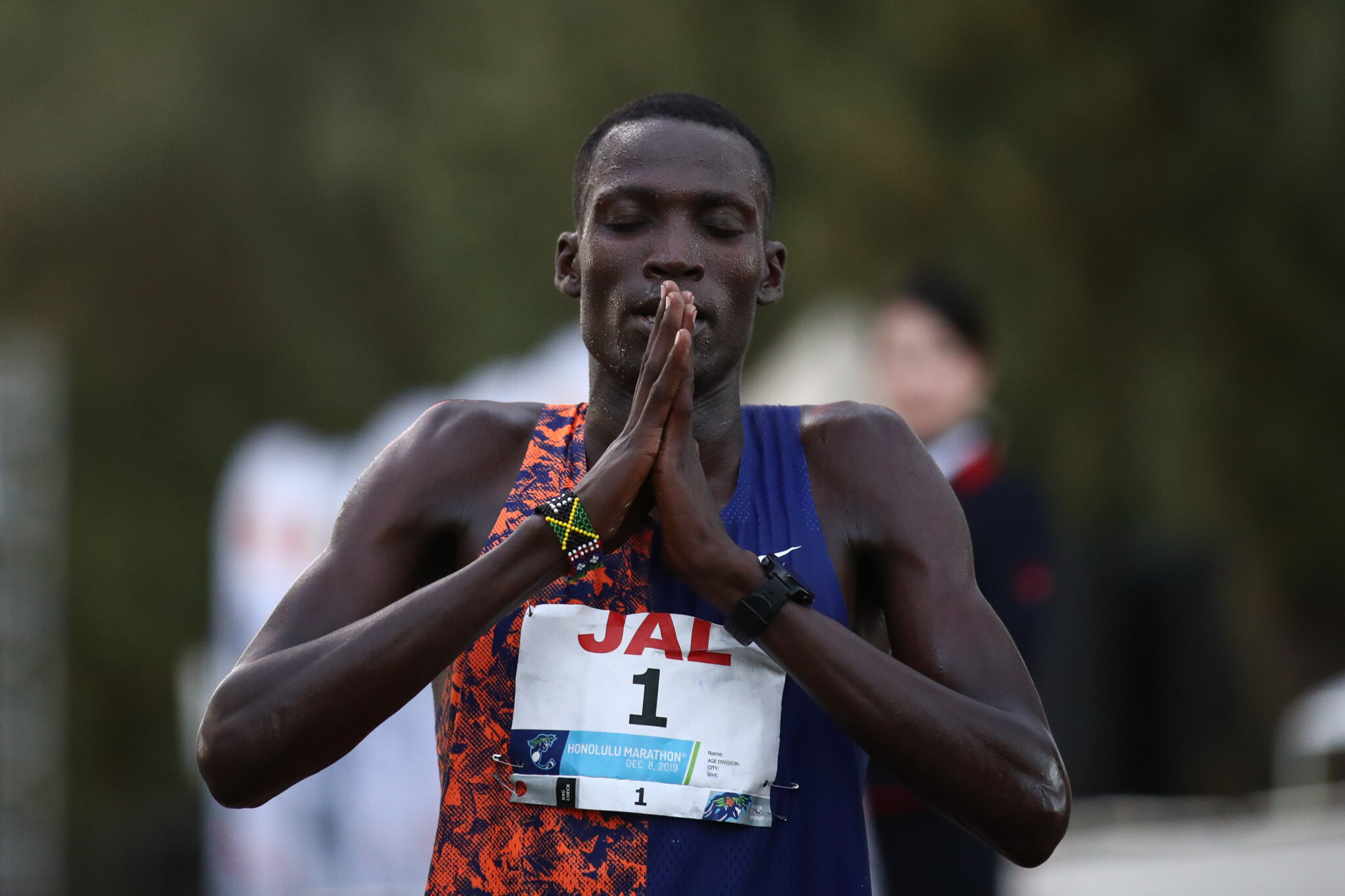
The runner colluded with a doctor at the Nandi County Hospital and forged documents and the patient registry as he tried to justify injections he received, according to the AIU.
After duel diligence, the forgery was unearthed, and Ekiru was further charged with tampering.
AIU says documents from the hospital showed discrepancies in Ekiru’s defence which claimed the injections he received stemmed from prescribed medications for injury treatment.
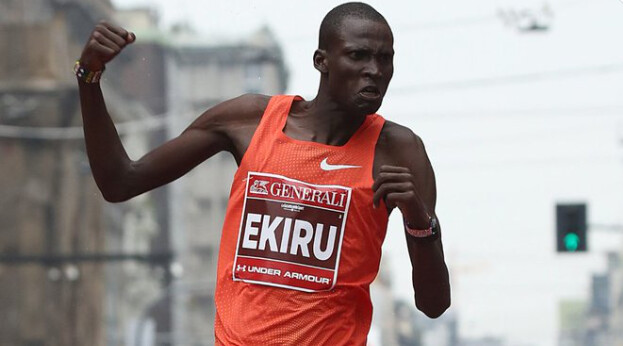
“Ekiru tested positive twice for the Presence of Prohibited Substances, or their metabolites or markers, in his in-competition urine samples at marathons which he won in 2021: the Generali Milano Marathon on May 16, 2021 (triamcinolone acetonide) and the Abu Dhabi Marathon on November 26, 2021 (pethidine and its marker norpethidine),” said AIU in part of its ruling.
“In addition to the ban, which runs from June 28, 2022 (the date of Ekiru’s provisional suspension) until June June 27, 2032, Ekiru’s results on and since May 16, 2021 have been disqualified, resulting in the forfeiture of all prizes and money. Ekiru’s victory in the Generali Milano Marathon would have made him the sixth-fastest marathoner of all-time.
“In July 2023, he was charged with two counts of the Presence of a Prohibited Substance, as per Rule 2.1 of the of the World Athletics Anti-Doping Rules (ADR), and two counts of Tampering or Attempted Tampering with any part of Doping Control (ADR Rule 2.5). Initally, Ekiru signalled his intention to contest the charges.
“However, faced with substantial evidence against him, the Kenyan athlete decided that he no longer wanted to pursue the case.”
The doctor claimed Ekiru’s visits were unrecorded by the hospital as “the athlete had attended early in the morning, before the registration offices had opened”.
However, hospital documents obtained by AIU revealed that the outpatient number was not issued to Ekiru until June 16, 2021; the one occasion on which the hospital confirmed his attendance as an outpatient.
(10/16/2023) ⚡AMPby Joel Omotto
Elvis Kipchoge Cheboi wins TCS Toronto Waterfront Marathon
It was an inauspicious arrival in Toronto for newly-crowned TCS Toronto Waterfront Marathon champion Elvis Kipchoge Cheboi, who lost a day of travel after a missed flight, then had to deal with a 4:30 a.m. fire alarm in the elite hotel, but none of that seemed to faze the 27-year-old Kenyan, winning in a decisive manner at Sunday’s marathon in a personal best time of 2:09:20.
Adugna Takele Bikila of Ethiopia, who was the top-seeded runner, finished second, in 2:10:26, with Alfred Kipchirchir Mukche of Kenya finishing third in 2:10:56.
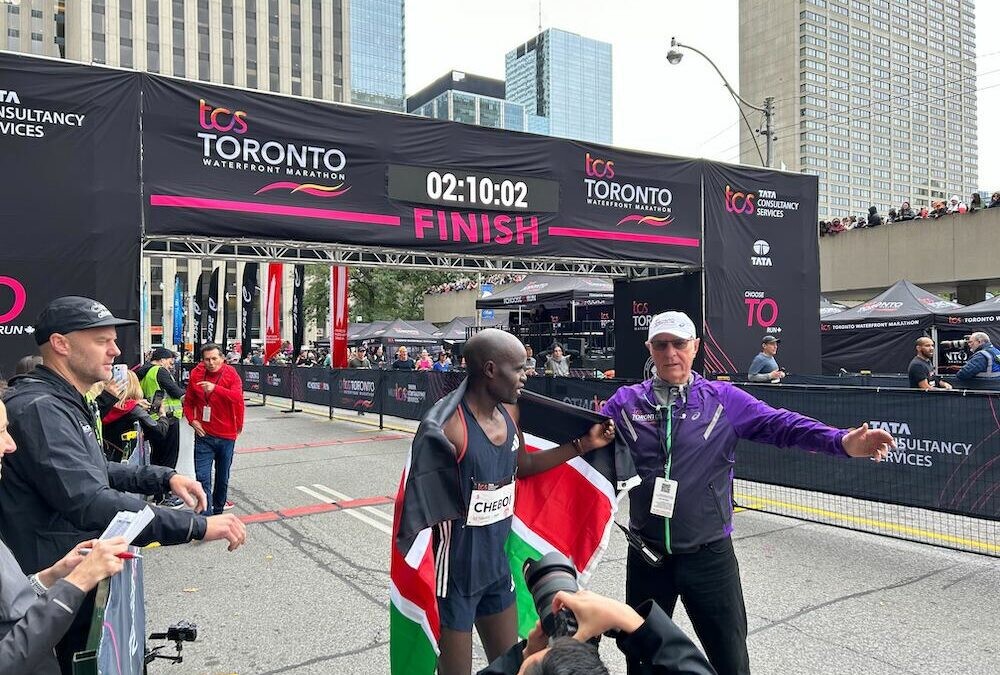
From early in the race, the TCS Toronto Waterfront Marathon was a duel between Cheboi and Kipchirchir, cruising along the course in their contrasting dark (Cheboi) and light (Kipchirchir) singlets, until the hairpin turnaround in the east-end Beach neighbourhood, when Cheboi surged ahead and never looked back.
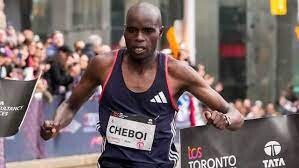
This was only Cheboi’s second marathon, having debuted at the Vienna Marathon earlier this year, where he finished seventh in 2:10:21.
“For me, winning Toronto is a huge achievement,” said Cheboi on his result. “I am very happy I improved on my time (from Vienna) today.
(10/16/2023) ⚡AMPby Anne Francis
TCS Toronto Waterfront Marathon
The Scotiabank Toronto Waterfront Marathon, Half-Marathon & 5k Run / Walk is organized by Canada Running Series Inc., organizers of the Canada Running Series, "A selection of Canada's best runs!" Canada Running Series annually organizes eight events in Montreal, Toronto and Vancouver that vary in distance from the 5k to the marathon. The Scotiabank Toronto Waterfront Marathon and Half-Marathon are...
more...6 ways to stay warm before your race starts
When the weather forecast for race day morning is chilly, it can be challenging to.stay warm in the start corral. This is particularly true at larger races, where you must spend some time waiting before the gun goes off. Avoid getting cold and stiff with these six simple strategies that will help you stay comfortable and ready to tackle the course ahead.
Do a 10-15 minute jog warmup
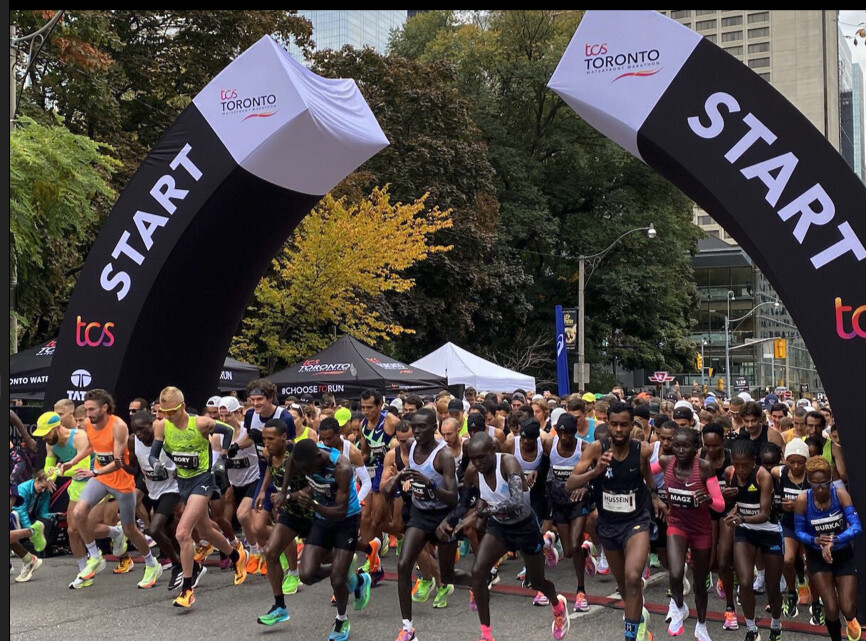
One effective way to stay warm before the race is to do a 10- to 15-minute jog. Not only will this help raise your body temperature, but it will also increase blood flow and loosen your muscles. Once you enter your corral, try doing some dynamic stretching, like high-knee marching or light skipping or jumping. (Just make sure it’s not so vigorous that you tire yourself out before the race starts–or that you inadvertently elbow someone).
Buy a thrift-store hoodie
Another great way to stay warm is to layer up with inexpensive clothing that you can peel off early in the race. Thrift stores have inexpensive long-sleeved shirts, sweatpants and jackets that you can wear as extra layers. You can toss them to the side of the course either once you’re running and comfortable, or just before the gun goes off. (Many races have volunteers who collect the discarded clothing so it can be donated. Just make sure to move to the side of the course, so you’re not throwing clothing at the people beside you.) Alternatively, if your race is smaller, you can arrange with a friend or family member to stand on the sidelines near the start, who could catch your layers as you run by.
Wear a garbage bag
If you don’t want to spend money on “disposable” clothing, a simple and cost-effective solution is to wear a garbage bag. Cut holes for your head and arms, and slip it on like a makeshift poncho. This will help trap your body heat and protect you from the wind. Once the race is about to start, you can easily tear off the garbage bag and continue racing.
Fuel well
You should always eat a meal or substantial snack a couple of hours before the race, and one of the benefits is it will help you stay warm while you wait. When your body digests food, it produces heat as a byproduct. Aim to consume a balanced breakfast that includes carbohydrate, protein and healthy fats (such as cereal or cooked oatmeal with milk and half a banana, toast with peanut butter or a sandwich with lean protein). Just make sure to only eat foods you’ve already experimented with in training.
Take a gel on the start line
In addition to fuelling well before the race, consuming an energy gel or a few bites of an energy bar on the start line will also help you stay warm. Be sure to test different gels during your training to find one that suits your needs and does not upset your stomach.
Keep your head and hands warm
You lose a lot of body heat through your head, so wearing a hat or headband can help you retain warmth; cold hands can also be uncomfortable and affect your performance. Invest in a good hat and a pair of gloves suitable for running in cold weather. If you only plan on wearing them at the beginning of the race, pick up some cheaper options at a thrift store that you can throw away as the race starts.
(10/15/2023) ⚡AMPby Running Magazine
Adkin and Allen among winners at Mountain Running World Cup final
Great Britain’s Scout Adkin and Joe Steward opened the Valsir Mountain Running World Cup Finalissima at Sky Gran Canaria with victories in the uphill race on Friday (13), while the long distance race on Saturday (14) was won by USA’s Christian Allen and Spain's Ikram Rharsalla Laktab.
Pace adjustment is key to successful mountain running as conditions, terrain and – as it turned out – even distances can change in the blink of an eye.
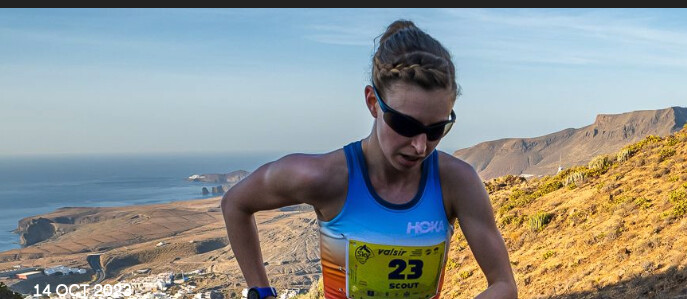
A weather alert was issued for the heat and possibility of forest fires and this meant the 6km uphill race – traditionally the opening event on this action-packed weekend – was reduced to 4km on a significantly altered route. Not only was the race shorter, it also didn’t climb above 400m due to the restrictions.
In the brutally hot conditions, with the temperature at 36°C at the start, it was Steward who quickly made the best of a tough situation as he raced to victory in the Sky A4Uphill event in 17:42. Steward placed eighth at the World Mountain and Trail Running Championships in Innsbruck earlier this year, but his recent results included wins at Canfranc and the Challenge Stellina mountain race in Italy, so he lined up as the man to beat.
Kenya’s Patrick Kipngeno, who is in the running for the overall men’s World Cup title, finished 11 seconds behind Steward’s winning time and secured second place. Allen was third in 18:00, Italian Henri Aymonod finished fourth in 18:18 and Philemon Kiriago – who led the men’s World Cup standings going into the event – was fifth in 18:33.
The women’s race was equally exciting as Adkin once again demonstrated her superb form. An early starter in a race that spanned 40 minutes from the first gun, she had to watch as the field tried – and failed – to match her 21:17 finish time. Looking incredibly strong on the technical section going into the final climb, it would clearly take something special to beat the Scot, the bronze medallist in last year’s European Off-Road Running Championships on the neighbouring island of La Palma.
As for the race in Gran Canaria, it featured a fast opening kilometre as the runners eased out of the coastal village of Agaete and then climbed steadily before the tough final ascent to Lomo del Manco on the volcanic rock paths the Canary Islands are so well known for.
With athletes starting every 30 seconds, the race was a superb spectacle and the results were in doubt all the way to the finish line. With no specific order, it was a case of hitting the climbs flat out. Tactics were for another day and for the two longer races (35km and 22km) taking place on Saturday and Sunday.
Adkin, who finished 15th overall, won the women’s race ahead of Finland’s Susanna Saapunki, who clocked 21:30.
Kenya’s Joyce Muthoni Njeru, who leads the overall women’s World Cup standings, placed third in 22:12, with her compatriot Philaries Kisang – currently second in the standings – finishing fourth in 22:58. Britain’s Sara Willhoit was fifth in 23:13.
Allen and Rharsalla Laktab prevail
Day two featured the longest race of the weekend, the Sky TPT38 Long. It was a demanding 38km, which had to be changed from the original 2736m of ascent and the sections of steep, technical ground due to the weather alert. However, it remained a great course, one that saw runners start down on the coast of Maspalomas before traversing a series of volcanic canyons.
If day one and the uphill-only race over 4km was all about flat-out power, this was very much a story of tactics, endurance, fuelling strategies and grit, not to mention the superb descending skills required for the final 12km.
Fortunately for the competitors, conditions had cooled slightly and the canyon walls provided much needed shade, so it was possible to really push hard from the gun.
It was the USA’s Christian Allen who did just that to seize the early initiative to open up a commanding lead of more than three minutes by 22km.
Allen has been in great form this year as his 2023 race programme demonstrates. The 28-minute 10km track runner has posted a string of impressive results all over the world, highlighted by a seven-minute victory in the Speedgoat 50km in the Wasatch Mountains, USA, an impressive second place at Vertical Nasego, and a third place at the Trofeo Nasego this Valsir Mountain Running World Cup season.
Allen, who is also a member of a newly formed Trail Team created to help athletes progress in the world of off-road running, crossed the line in 2:29:29, comfortably ahead of his compatriot Andrew Wacker, who clocked 2:35:52. Czechia's Ondrej Fejfar was third in 2:36:50.
"I’m tired, but I’m glad to be done," said Allen after his second race in two days, which began with a third place in the uphill race on Friday. "I was a little tired after yesterday and didn’t get much sleep because of the caffeine I’d taken, but competing is all about adapting and going out there and having fun."
A strong race on Sunday over the classic distance could see him move to as high as third in the overall World Cup rankings, but speaking after the long race, he was not sure if he will be on the start line for the third race of a packed weekend. “But you never know,” he laughed. “We’ll see how I sleep tonight.”
In the women’s race, a superb final 12km from Spain’s Ikram Rharsalla Laktab saw her haul back a four-minute deficit to win by more than a minute. At first glance it appeared to be down solely to her sensational running over the closing stages, given Italy’s Camilla Magliano had passed 22km more than four minutes ahead of Rharsalla Laktab, the Spanish representative in the World Mountain and Trail Running Championships in Innsbruck earlier this season.
Unfortunately for Magliano, however, the Italian had taken a wrong – and costly – turn in the final canyon and it was Rharsalla Laktab who crossed the line first in 2:27:26 with Magliano close behind in 2:59:01. After her fifth place in the uphill race, Britain’s Sara Willhoit was third in 3:17:14.
“I’m happy with the win,” said Rharsalla Laktab. “It was a very runnable course, although I do like a bit more of a technical course with a touch more climbing."
Now it is all about Sunday and the Sky A21 Classic, which starts and finishes at the Muelle Viejo de Agaete. Initially, this race was going to be over 50km, but the extreme weather conditions in Gran Canaria means this will now be a shorter two-lap race over 22km.
(10/15/2023) ⚡AMP
by World Athletics
Koyama and Suzuki secure places on Japan’s Olympic marathon team
Naoki Koyama and Yuka Suzuki won Japan’s Marathon Grand Championship in Tokyo on Sunday (15), guaranteeing their selection for the Paris 2024 Olympic Games.
Koyama won in 2:08:57 with Akira Akasaki finishing a close second in 2:09:06, also securing his place on the team. As was the case in Japan’s Olympic selection race for the last Games, Suguru Osako finished third, meaning his selection is only provisional and not yet guaranteed.
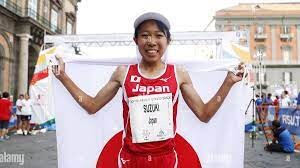
Suzuki’s triumph in the women’s race was more clear cut as she won by 34 seconds in 2:24:09. Mao Ichiyama placed second in 2:24:43 while Ai Hosoda took third place (2:24:50).
Former Boston Marathon winner Yuki Kawauchi was the early leader of the men’s race, building up a 41-second lead at 25km (1:15:36). His lead was still 34 seconds at 30km, but several athletes in the chase pack started to make a move.
Kawauchi was caught with about seven kilometres remaining, but he didn’t drop back. Just four men remained in contention in the final five kilometres – Kawauchi, Koyama, Osako and Akasaki. Koyama made a decisive move just before 40km, and despite a strong finish from Akasaki and Osako, there was no catching Koyama who won in 2:08:57.
The first big move in the women’s race came at about 23km when Mao Ichiyama opened up a bit of a gap ahead of the rest of the leaders. Hosoda then took a turn in the lead at 30km, but Ichiyama regained it a few kilometres later.
Suzuki caught Hosoda at 36km, and then reeled in Ichiyama about 10 minutes later. In the final four kilometres, Suzuki extended her leading margin and eventually crossed the finish in 2:24:09. Ichiyama held off a strong challenge from Hosoda in the closing stages to hold on to second place.
(10/15/2023) ⚡AMPAyana and Ebenyo win in Delhi
Ethiopia’s 2016 Olympic champion Almaz Ayana and Kenya’s world 10,000m and half marathon silver medallist Daniel Ebenyo took top honours at the Vedanta Delhi Half Marathon on Sunday (15), winning the World Athletics Gold Label road race in 1:07:58 and 59:27 respectively.
Through the early stages, Ayana ran alongside fellow Ethiopians Aberash MInsewo and Dessie Anchinalu as well as Kenya’s Viola Chepngeno and Uganda’s Chesang, covering the first 5km in 15:45. Vivian Cheruiyot – who also claimed an Olympic gold medal in Rio, hers over 5000m – was slightly behind the lead pack.
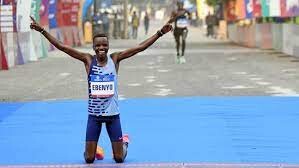
Ayana maintained her 16-minute pace for each of the following five-kilometre intervals. She slowed down in the closing stages, but was a comfortable distance ahead of Chesang. Ayana crossed the finish line in 1:07:58, recording her second win in New Delhi following her 1:07:12 triumph in 2017.
Chesang finished 28 seconds later for second place while Chepngeno completed the podium in 1:09:09.
In the men’s race, Ebenyo and compatriot Chales Matata ran with several of their fellow Kenyans, as well as Ethiopia’s Addisu Gobena. The pack stayed together until 13km when Ebenyo and Matata made a break.
They ran together for another five kilometres, but Ebenyo managed to open up a significant lead in the final few kilometres to win in 59:27. Matata clocked 1:00:05 for second place, while Gobena placed third in 1:00:51.
(10/15/2023) ⚡AMPVedanta Delhi Half Marathon
The Airtel Delhi Half Marathon is a haven for runners, creating an experience, that our citizens had never envisaged. The streets of Delhi converted to a world-class running track. Clean, sanitized road for 21.09 kms, exhaustive medical support system on the route, timing chip for runners, qualified personnel to ensure smooth conduct of the event across departments. The race...
more...Belete and Belet triumph at Amsterdam Marathon
Ethiopia’s Meseret Belete and Kenya’s Joshua Belet were victorious at the TCS Amsterdam Marathon on Sunday (15), winning the World Athletics Platinum Label road race in 2:18:21 and 2:04:18 respectively. Both champions produced the third-fastest winning times ever recorded in the Dutch capital.
Belete smashed her PB by more than two minutes and notched up her second victory of the year, having won in Doha back in January in 2:20:46, her previous lifetime best.
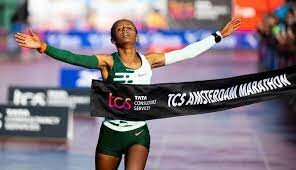
Belet, meanwhile, bounced back from his World Championships withdrawal to record a PB, improving on the 2:04:33 he clocked when finishing second in Hamburg in April.
Belete maintained a remarkably consistent pace throughout, and for most of the way she ran alongside compatriots Meseret Abebayehu and Ashete Bekere, as well as Kenya’s Dorcas Tuitoek.
A large lead pack passed through 5km in 16:27 and 10km in 32:45. About nine runners were still in contention as they passed through the half-way point in 1:09:05. It indicated they were set for a finishing time in the region of 2:18, though Almaz Ayana’s course record of 2:17:20 was perhaps by now slightly out of reach.
By 30km, reached in 1:38:08, there were just four women left in the lead pack – Belete, Abebayehu, Tuitoek and Bekere. They ran together for a further 10 minutes or so, then Belete started to forge a lead.
She didn’t have to increase her pace; she simply maintained it while her last few opponents drifted off it. Belete eventually entered the stadium with a comfortable lead and crossed the line in 2:18:21, winning by 89 seconds.
Abebayehu, winner in Riyadh and Xiamen earlier this year, held on for second place in 2:19:50, smashing her PB by more than four minutes. Tuitoek placed third in 2:20:02.
In the men’s race, a large lead pack covered the opening 5km in 14:54, then sped up to reach 10km in 29:28 and 15km in 44:03. The pack still contained about 12 men as they passed through 20km (58:48) and the half-way point (1:02:01), which was 10 seconds quicker than Tamirat Tola achieved when he set the course record of 2:03:39 in 2021.
The lead pack started to whittle down gradually in the second half. After going through 30km in 1:28:28, Belet made his move and opened up a gap on the rest of the field, one he wouldn’t relinquish.here were several changes of position among the athletes in the chase pack in the final kilometres, but Belet held on to his lead and went on to win in 2:04:18. Fellow Kenyan Cybrian Kotut came through to take second place in 2:04:34, finishing just three seconds ahead of Bethwel Chumba, who completed the all-Kenyan podium. Ethiopia’s Birhanu Legese was a close fourth in 2:04:44.
(10/15/2023) ⚡AMPPeres Jepchirchir shares why it will take time to break the women's world record again
Peres Jepchirchir has shared her insights on why it will take longer for the women's marathon world record to be broken.
The streets of Berlin witnessed a historic moment on September 27 when Ethiopia’s Tigst Assefa shattered the women-only world record.
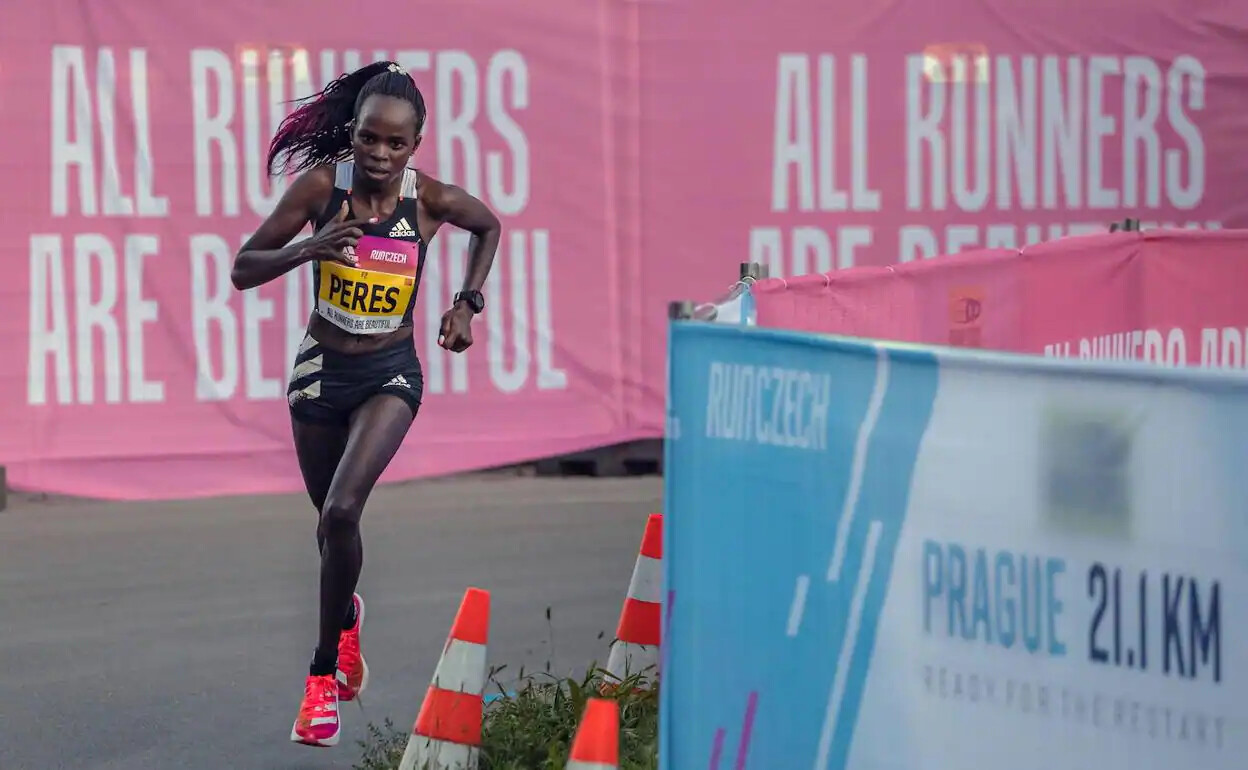
Assefa clocked 2:11:53 to completely obliterate Brigid Kosgei’s world record time of 2:14:04. Having clocked that time, the Ethiopian became the first woman in history to have run under 2:12:00.
Kosgei had set the world record in 2019 and in less than five years, it has already been shattered. However, Olympic champion Peres Jepchirchir has admitted that lowering Assefa’s world record time will definitely take more time.
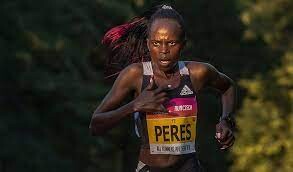
“For now, it’s difficult, 2:11:00 is a very difficult barrier to break. Maybe it will take some years to break that barrier.
It took time to break Kosgei’s record and it was 2:14…but for this world record, it will take more time. I know we are strong ladies and we will break it one day.
If it will not be me, then my colleagues will definitely break it and make history,” Jepchirchir explained.
The 2022 Boston Marathon champion will be heading to the streets of New York for the New York City Marathon on November 2.
She noted that she does not intend to go for a world record on the course since it is not suitable for a world record. However, she is bullish about reclaiming her title that she won during the 2021 New York City Marathon.
She missed out on last year’s edition of the event due to an injury setback but she has since announced her comeback. She opened her season at the London Marathon where she finished third.
She then bagged a win at the Great North Run before defending her World Half Marathon title at the World Road Running Championships.
(10/14/2023) ⚡AMPby Abigael Wuafula
TCS Toronto Waterfront Marathon: elite women’s and men’s preview
For the first time in the 34-year history of the TCS Toronto Waterfront Marathon, the race has reached over 25,000 runners. Toronto has established itself as Canada’s premier marathon and has set a precedent in the global running community, with participants coming from 78 countries around the world for the marathon on Sunday, Oct. 15.
The elite field at the 2023 edition of the marathon looks significantly different from last year, and two new champions will be crowned on the men’s and women’s sides, as Ethiopia’s Yihunilign Adane and Kenya’s Antonina Kwamboi will not be returning. The 2023 elite field features up-and-coming stars, along with several American women aiming to achieve the Olympic standard of 2:26:50 ahead of the upcoming U.S. Olympic Trials in February.
The race will also determine two new Canadian marathon champions, with compelling storylines on both the men’s and women’s sides.
Women’s race
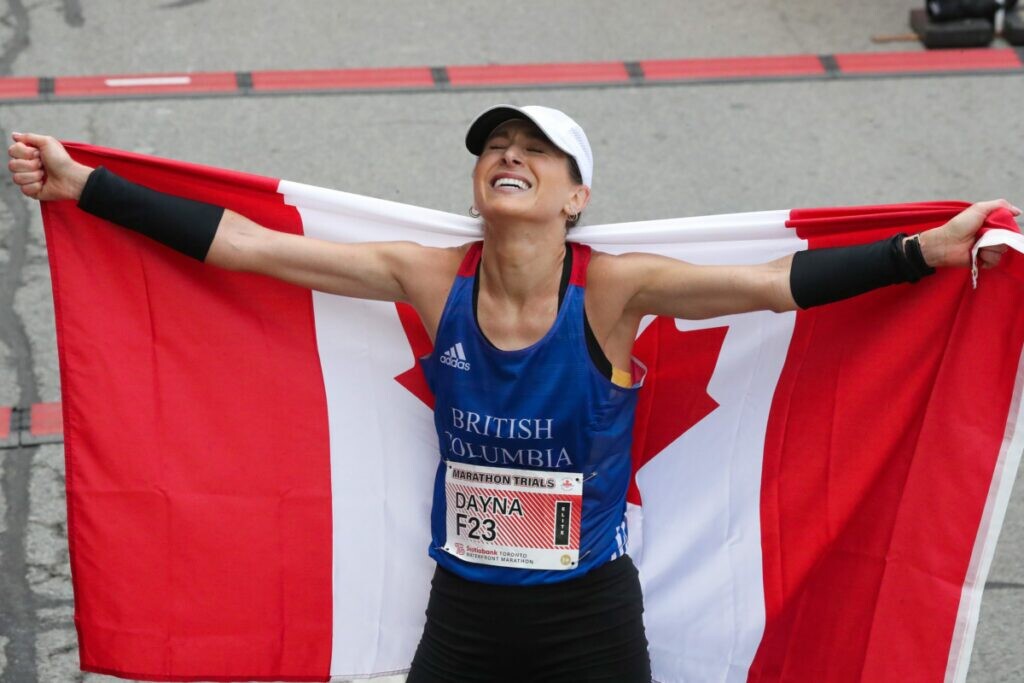
Will we see an American winner?
It has been 22 years since an American woman last won the TCS Toronto Waterfront Marathon (Leslie Gold in 2001) but in this year’s field, two American elites could possibly end the drought. One of them, Emily Durgin, a road racing specialist based out of Flagstaff, Ariz. came to Toronto looking for redemption after a less-than-ideal marathon debut in NYC last year.
Durgin said during Friday’s elite press conference that she felt the pressure to hit times and perform during her debut and ended up dropping out of the race before 30 km. “I learned a lot from New York and my build for Toronto has been different,” said Durgin. “As for a goal time, I want to run in the low 2:20s and be competitive.” The 29-year-old marathoner hopes to use Toronto as a stepping stone for the U.S. Olympic Marathon Trials in February 2024 in Orlando. Durgin was able to qualify for the trials from her time at the 2022 Houston Half Marathon where she finished 6th overall, clocking the seventh-fastest half-marathon in U.S. history with 67:54. “I came to Toronto to be competitive and contend for the the podium, as that’s what it will take to qualify at trials come February,” she said.
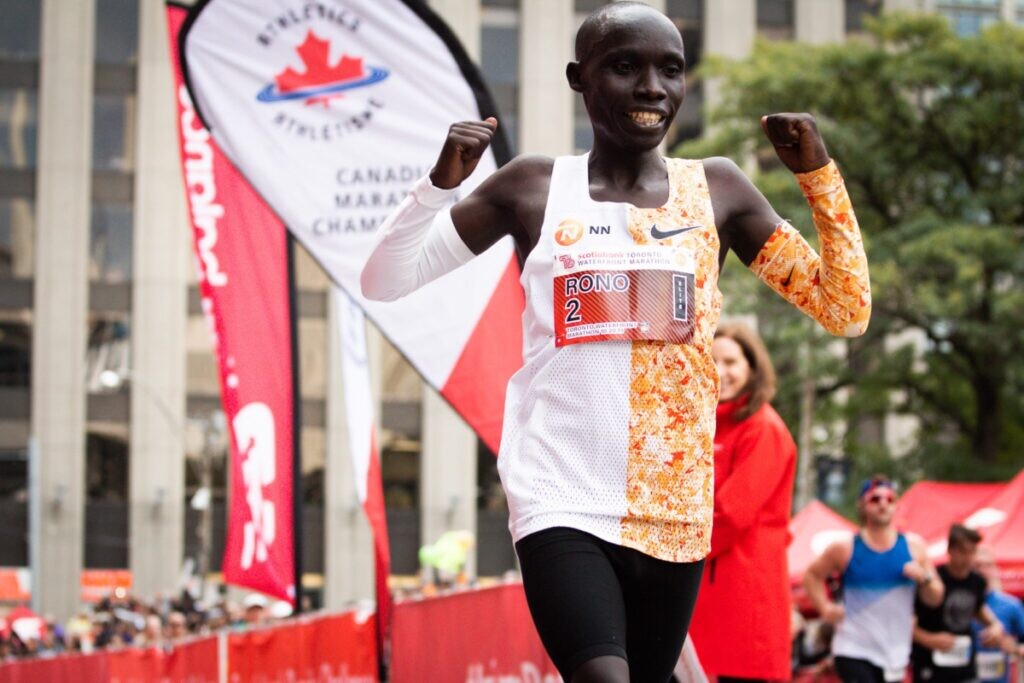
Another U.S. name in the women’s elite field to watch is Molly Grabill, who is running her sixth career marathon in Toronto on Sunday. Grabill told the media that she has similar plans to her compatriot Durgin and hopes to bounce back after, in her words, falling short of her goals in her last marathon in Hamburg earlier this year. Although Grabill ran the second-fastest marathon time of her career in Hamburg, she said she was disappointed as she took a swing and missed, struggling in the second half. “The goal in Toronto is to control the second half of the race better and gain strong momentum heading into the U.S. Olympic Marathon Trials,” said Grabill. The 31-year-old from Boulder, Colo., is coming off a top-15 finish in 69:53 at the inaugural World Athletics Road Running Championships in Riga, Latvia, earlier this month, which she says has given her a lot of confidence for Sunday.
Eyes on the course record?
Outside of the American duo, two other international athletes to watch are the Ethiopian duo of Afera Godfay and 2023 Ottawa Marathon champion Waganesh Mekasha. For Godfay, Toronto is her first marathon in three years after giving birth to her daughter. Her last marathon came in 2020 when she ran 2:26:43 to place third overall at the Xiamen Marathon in China. In her first two races back since becoming a mother, Godfay has run respectable half marathon times of 70 and 71 minutes but has not yet returned to her previous form. She said at Friday’s press conference that she hopes to come through the half mark in 1:11 and feels well-prepared for her marathon return. A glimpse of hope for Godfay is that she currently trains alongside the new women’s world record holder Tigist Assefa in Ethiopia. So, who knows what she is capable of?
The favourite in the women’s race is Mekasha, who is coming off a win in the scorching heat at the 2023 Ottawa Marathon in May. Mekasha is targeting the Canadian all-comers’ women’s marathon record on Sunday of 2:22:16, set four years ago by Kenya’s Magdalyne Masai at this race. Mekasha holds a personal best of 2:22:45 from the 2019 Dubai Marathon and said that she expects around a similar time on Sunday. “If the pacemaker runs a good pace, I hope to break the course record,” says Mekasha.
The Canadian contingent
Two of the top three Canadians from last year’s race have returned to the 2023 field, with Malindi Elmore, the reigning Canadian marathon champion, opting to run Berlin, where she clocked the second-fastest time in Canadian history (2:23:30). Returning are second and third place Canadian finishers Dayna Pidhoresky and Toronto’s own Sasha Gollish. Pidhoresky had an iconic moment here in 2019, when she raced just under the Olympic standard at the Canadian trials, winning in 2:29:03–qualifying her for the marathon at the 2020 Tokyo Olympics. Although the Olympic marathon didn’t go as planned for Pidhoresky, she was able to bounce back at this event last year to place seventh overall (second Canadian) in 2:30:58.
“Growing up in Windsor, Ont., I came to Toronto for so many races,” said Pidhoresky on tackling on her fourth Toronto Waterfront Marathon. “I feel I know the course very well, which is helpful in a marathon, and it’s great to have a high-quality field that’s close to home.” Pidhoresky told the media that this build has not been smooth but she is still confident she can run a personal best Sunday. “This course is advantageous, and I need to be smart and just run my race,” she said.
It is a similar story for Gollish, who is running in her second consecutive TCS Toronto Waterfront Marathon, less than eight weeks after her last marathon at the 2023 World Championships in August. Gollish told Canadian Running at the press conference that she wants to go into this race with a similar mindset that she had in Budapest. “It feels like a privilege to be here, and I am not putting any pressure of a personal best on myself,” says Gollish. “For the longest time, I avoided this race because I felt there would be pressure to perform, but why not run something in your backyard fuelled by a community that has done so much for me?” Last year, Gollish surprised herself with a personal best time of 2:31:40 after a short marathon build. Could she do the same on Sunday?
A few other Canadian marathoners to watch are Emily Setlack, Toronto’s Liza Howard and Kim Krezonoski of Thunder Bay, Ont. It has been four years since Setlack has last touched the marathon, but with a personal best of 2:29:48 from the 2019 edition of this race, her potential to finish as the top Canadian should not be ignored. Setlack has had a quiet 2023 season but has strung together solid performances, winning Toronto’s historic Sporting Life 10K and placing eighth overall at the Canadian 10K Championships in May.
Howard has a personal best of 2:35:29 (Chicago 2022) and was the top Canadian finisher at the 2023 Boston Marathon (37th overall) in cold, wet and windy conditions. Krezonoski moved to Toronto within the last year and has been studying the course thoroughly in the hope of crushing her marathon personal best come Sunday. She ran her personal best of 2:37 at the California International Marathon last year but has dropped her half-marathon PB by nearly four minutes since. The spots on the domestic podium are up for grabs, and each of these three women could break through.
Men’s race
The rise of Elvis
The absence of Adane opens the door for several East African men hoping to establish their marathon careers in Toronto. One of these men is Kenya’s Elvis Kipchoge, who may already lay claim to the title of the best running name. This Kipchoge is a little less well-known than the former world record holder but boasts a faster half marathon personal best of 59:15, which earned him third place at the 2022 Barcelona Half Marathon. However, this Kipchoge has not had much luck in the marathon. At the young age of 27, he ran 2:10:21 at the Vienna Marathon earlier this year. He hopes to turn things around on a fast and flat Toronto course. Kipchoge has ties to the race, training alongside women’s course record holder Magdalyne Masai in Iten, Kenya.
While there is no relation between Elvis and Eliud Kipchoge, besides sharing the same last name and initials, Ethiopian athlete Adugna Bikila hopes to follow in the footsteps of his uncle, Worku Bikila. Worku was a world-class 5,000m runner who finished sixth in the 1992 Olympic 5,000m final in Barcelona and took fourth place at the World Championships the following year. Bikila enters Toronto with the fastest time in the field, holding a personal best of 2:05:52 from the 2022 Seville Marathon, where he finished fourth.
All the East African men will be aiming to break the Canadian all-comers record and course record of 2:05:00, held by Kenya’s Philemon Rono, set in 2019. The weather forecast for Sunday indicates cool and favourable conditions for both the men’s and women’s fields, which should make both course records vulnerable.
Who’s next for Canada?
A new men’s Canadian champion will be crowned Sunday, and for the first time since 2016, their last name will not be Levins or Hofbauer. The 2023 men’s field is full of up-and-coming Canadian talent on the precipice of breaking into the elite scene. Mississauga’s Sergio Raez Villanueva returns to Toronto after a stunning 2:18:04 debut last year, which earned him top-five Canadian honours. Challenging Raez Villanueva is Ottawa’s Blair Morgan, who was the second Canadian at the hot and humid Ottawa Marathon in May, running 2:19:50. Morgan ran his personal best of 2:18:29 at the 2018 Toronto Waterfront Marathon but is looking for a sub-2:18 result this time around.
Challenging Raez Villanueva and Morgan are debutants Thomas Broatch of Vancouver and 4:01 miler Kyle Grieve. Broatch is coming off a win at the Vancouver Eastside 10K where he beat three-time Toronto champion Trevor Hofbauer. “Winning the Eastside 10K was a huge confidence booster for me,” says Broatch. “Whenever you take the start line the objective is to win and run fast.” The 24-year-old software engineer told Canadian Running that he has ambitious goals to run under 2:15 on Sunday and that his marathon build has gone near perfect.
For Grieve, who grew up and still resides in Toronto, this marathon has always been on his bucket list. “I’ve been wanting to try a marathon for a few years and have just kept putting it off,” says Grieve, who got married in the summer. “Canada Running Series is a big reason I am still competing today, so it was never a question of where I wanted to run my first marathon.” His goal is to be competitive against a strong Canadian field and let the time come along with it.
How to watch?
Marathon fans from around the world will have the opportunity to watch the 2023 TCS Toronto Waterfront Marathon live on Sunday, Oct. 15, 2023, beginning at 8:00 a.m. ET with a pre-race introduction followed by the introduction of the elite field. The gun for the men’s and women’s elite field fires at 8:45 a.m. ET. All race action can be followed on torontowaterfrontmarathon.com or CBCsports.ca /CBC Gem or AthleticsCanada.tv.
(10/14/2023) ⚡AMPby Marley Dickinson
TCS Toronto Waterfront Marathon
The Scotiabank Toronto Waterfront Marathon, Half-Marathon & 5k Run / Walk is organized by Canada Running Series Inc., organizers of the Canada Running Series, "A selection of Canada's best runs!" Canada Running Series annually organizes eight events in Montreal, Toronto and Vancouver that vary in distance from the 5k to the marathon. The Scotiabank Toronto Waterfront Marathon and Half-Marathon are...
more...After a fruitful track season, Daniel Simiu is not resting on his laurels as he focuses on the Vedanta Delhi Half Marathon
World 10,000m silver medalist Daniel Simiu is a man on a mission as he shifts his focus to the Vedanta Delhi Half Marathon on Sunday.
Simiu has had a decorated track season and his hope is to extend the winning streak to the roads. He explained that there is no rest for him since he has a couple of road races lined up for him after the assignment in India.
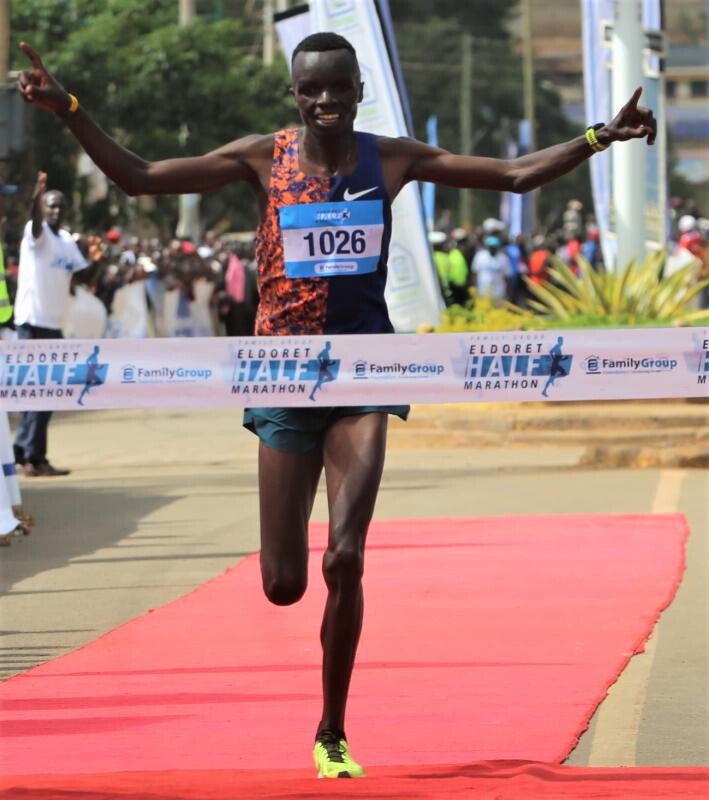
“It’s been God through and through and my season is not even over. Next week I’ll be in Delhi for the Half marathon.
I’m just getting started…we are just closing the track season and shifting the focus to the roads. And then after that we shall focus on the cross-country. We are not closing the season,” Simiu said.
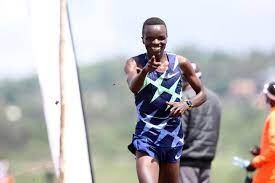
He started off his 2023 season at the World Cross-country championships, competing in the men’s senior race where he finished sixth.
He then competed in his first track race at the Kip Keino Classic where he won the 10,000m in flying colors. Before his first track race, he also competed at the Istanbul Half Marathon where he dominated.
After that, the World Half Marathon silver medalist competed at the National Police Championships, National Championships and later the World Championships National Trials.
His second major assignment was at the World Championships held in Budapest, Hungary where he finished an impressive second before extending the hot streak to the Diamond League Meeting in Brussels.
After the showpiece in Brussels, Simiu went ahead to compete at the World Road Running Championships where he finished second in the half marathon.
His focus is now on road races as he gears up for the major assignment next, the Olympic Games in Paris, France.
(10/14/2023) ⚡AMPby Abigael Wuafula
Vedanta Delhi Half Marathon
The Airtel Delhi Half Marathon is a haven for runners, creating an experience, that our citizens had never envisaged. The streets of Delhi converted to a world-class running track. Clean, sanitized road for 21.09 kms, exhaustive medical support system on the route, timing chip for runners, qualified personnel to ensure smooth conduct of the event across departments. The race...
more...Looking to Qualify for the Boston Marathon? Here’s What Strava Data Says About That Elusive BQ.
We looked at a ton of data from last year’s fall marathons to see what Boston Qualifier (BQ) runners did differently in training and racing
In our monthly column in partnership with Strava, we take a deep dive into compelling data points that reveal the more human side of sport.

In 2023, a record-breaking 33,058 athletes applied for the 128th Boston Marathon. Of those, just 22,019 were accepted (pending final verification). Qualifying times are established for different age and gender categories. Still, with so many applicants, the unofficial cutoff times for acceptance were five minutes and 29 seconds faster than the official qualifying time many athletes push for.
Looking at data from several 2022 marathons, interesting trends emerge. We analyzed Strava data from the Berlin, Chicago, Marine Corps, New York City, CIM, and Valencia marathons. Here’s what the data tells us about qualifying for the Boston Marathon.
Before we get too deep into the data, it’s worth discussing the fact that the above courses have different course dynamics and demographics, which influence median finishing times. Berlin, CIM, and Valencia are all fast courses that attract folks gunning for a BQ. (Hola Valencia! Peep that four feet of total gain, with a net descent of 106 feet.) CIM has a particularly high percentage of BQs since it combines a fast course with a smaller field—many run CIM specifically to qualify for Boston.
Last year was a record-breaking heat year at the NYC Marathon, which resulted in an anomalously low negative-split rate. More than 2,000 runners didn’t cross the finish line in 2022, with temperatures soaring to 75 degrees with 75 percent humidity, which radically affected finishing times. We’ll still look at data from NYC, but 2022 was exceptional. Only 30 percent of runners at NYC who were aiming for a sub-three finish met that goal, and only half of runners looking to go sub-four did so.
Across all the marathons we analyzed, athletes had similar training. Most started at a base of around 20 miles a week and a 10-mile long run. On average, they worked up to a 30-mile week and a 20-mile long run. While there’s a slight variation in average miles per week (mpw), the training time in the peak week is similar (and each race has a different mix of target paces for participants).
CIM had the highest average mileage baseline and peak week, suggesting that it attracts more experienced runners with a specific goal in mind. CIM runners started with a 30 mpw base and progressed to a 50-mile peak week and 21-mile long run. BQ runners at CIM started with a 43-mile peak week (the highest of any marathon analyzed). When we just look at athletes who hit the BQ standard to equalize the field, CIM runners have a higher baseline and peak week.
While many newer distance runners tend to focus on flashy long runs, the distance of the longest run was not strongly correlated with a BQ. Comparing BQ runners and all other athletes, the distance of the longest run was 20 to 22 miles across each marathon. But, the base mileage was higher for BQ runners, bearing in mind that base volume matters more than the distance of any long run. BQ runners at CIM averaged 65 miles during their peak week, while the rest of the field averaged 50 mpw. Similarly, Chicago BQers averaged 57 miles during peak week, compared to the rest of the field’s 41 mpw peak week.
Interestingly, there was not a strong correlation between success on hillier courses and runners averaging more elevation gain in their training. Across all races, BQ runners did have more elevation in their training. For example, CIM and Berlin BQers had 15 percent more elevation gain in their training than runners who didn’t BQ (even when you control for average mileage). CIM runners hit the most vertical gain, averaging 100 feet of elevation gain per mile over the training cycle.
There’s no teacher like experience, and marathons are no different. Runners who finished one of the above races between 2:30 and 2:59 on average have completed six previous marathons. Runners who finished between 4:00 and 4:30 had completed, on average, four previous marathons. Experience helps with pacing, fueling, and other elements of the marathon that are sometimes only learned through trial and error.
Keep easy days easy. There’s a strong positive correlation between keeping training runs intentionally slower than race pace and runners hitting their goal pace (defined as the pace runners averaged over the first eight miles of the marathon). Running slower than marathon effort helps build dense capillary beds, strengthen the heart, increase stroke volume (the amount of blood your heart can pump per beat), and increase the endurance capabilities of your muscle fibers by increasing the number of mitochondria in muscle cells. Running too fast causes the breakdown of bone and muscle tissue at a rate that can’t be outpaced in recovery; plus it makes the body less efficient at processing oxygen.
Runners that kept easy runs about 30 percent slower than goal pace had a 27 percent success rate, finishing at or close to their goal time. For runners who did easy runs only 10 percent slower than their goal pace (the approach of about a third of the runners analyzed), only 19 percent met their goal time, equating to a 31 percent reduction in success rate. Of runners who did “easy” days around marathon pace, only 14 percent hit their goal time.
Faster runners, who are more experienced, keep easy runs easier. Runners who finish in 2:30, on average, run their easy days 29 percent slower than goal pace. Compare this with runners who finish an hour later in 3:30, whereas the average runner ran their easy days just 11 percent slower than race pace, and only 20 percent hit their goal finish time.
Runners aiming for a 3:00 marathon (6:52 mile-pace) should shoot for easy days between 7:48 and 8:36. Runners looking to hit a 3:30 time (8:01 mile-pace) should strive for easy days between 9:02 and 9:56, and 4-hour marathoners (9:09 mile-pace) should shoot to keep easy days between 10:11- and 11:11-minute miles. As demonstrated by the data, to go fast, you have to learn to run slow.
Of all the courses, CIM and Valencia had the highest percentage qualifying for Boston, with 32 percent of the field BQing. Only six percent of NYC runners hit the Boston standard (heat!), and the Marine Corps Marathon, popular amongst beginner runners, had a similar qualifying rate. At Chicago and Berline, 18 percent of the runners qualified.
NYC and Marine Corps had the slowest median finish time, just over 4:30, averaged across all runners (NYC usually runs faster in cooler years). NYC is also the largest race, with over 47,000 competitors (compared to CIM’s 10,000). Valencia had the quickest average finish time (3:28), with a relatively small field of 30,000 runners.
Even more than gain and loss, the strongest predictor of BQ success was a negative split, running the second half of the race faster than the first. Take, for instance, Kelvin Kiptum’s recent world record win in Chicago, in which Kiptum ran a 59:47 negative split to run just 35 seconds over the two-hour barrier.
Just three percent of NYC runners (the heat! The humidity!) negative split in the rising temps, again pointing to an outlier year in NYC. Eleven percent of runners negative split both Chicago and Marine Corps, but experience won out in the Chicago crowd, with its 18 percent BQ rate, eclipsing Marine Corps’ six percent (a race that traditionally has more beginner runners).
Berlin and CIM both boosted a 16 percent negative split rate, though a higher percentage (32 percent) of CIM runners hit the BQ compared to Berlin’s 18 percent. Valencia had the highest percentage of negative splits. Still, a significant portion of that can be attributed to the extremely flat course, with just enough downhill to boost speed but not enough to bash the quads too badly.
So, if you’re searching for an elusive BQ, here’s what the data show: slow your runs down, choose your course wisely, shoot for a negative split, and remember that practice makes perfect. It may take a couple of marathons to get it absolutely right, but that experience will be invaluable.
(10/14/2023) ⚡AMPby Outside Online
Want to Qualify for the U.S. Olympic Trials? This Race Is Specifically Built for You.
For elite amateur marathoners, qualifying for the Olympic Trials is the ultimate life goal. Bakline’s McKirdy Micro Marathon removes the challenges of running a fast 26.2.
When it comes to trying to run a fast marathon, Zacch Widner knows that bottle service isn’t a luxury but a necessity. No, not tableside bottle service at a nightclub, but the ability for marathon runners to easily identify and grab their own hydration bottles off of a table every 5K or so on course while running at an extremely fast pace.
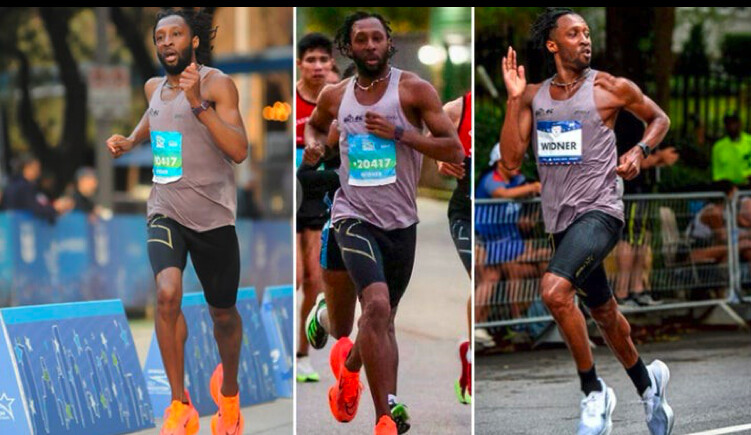
At the Berlin Marathon on September 23, the 32-year-old aspiring elite runner from Lansing, Michigan, was on the verge of running the race of his life. But because his bottles weren’t readily available at each aid station, he wound up grabbing only one of his eight bottles and suffered the consequences.
Although running the race without optimal calorie and hydration intake led to frequent cramping, he still finished in 2:20:02. That’s the second-best time of his career, but still two minutes short of his goal of breaking the U.S. Olympic Trials men’s qualifying standard of 2:18:00.
Widner is one of dozens of American runners—most of whom work nine-to-five jobs—still hoping to earn the standard (or 2:37:00 for women) by the December 5 deadline, in order to qualify for the U.S. Olympic Trials Marathon on February 3 in Orlando.
For Widner, it’s much more than a personal goal. It’s a commitment to a friend and former teammate. “It was a bummer,” says Widner, who works full-time as an IT analyst for the state of Michigan. “I know I’m capable of running faster. I didn’t capitalize on taking fluids, so when it came to running all out, I just couldn’t do it. I think the stress of it is actually what caused the cramps, because every time I missed a bottle, I just stressed out more…just mentally started destroying me.”
Three weeks later, Widner is ready to take another shot at the OTQ standard, this time at Bakline’s McKirdy Micro Marathon on October 14—a unique elite-only race that will be held about 30 miles north of New York City. Set on a nine-loop course at Rockland Lake State Park, the no-frills race will provide bottle service to each of the 180 entrants who met a stout qualifying standard (2:25 for men, 2:45 for women) to register.
“It’s got everything you need,” he says. “You have a lot of tough, fast runners. You have pacers and a flat course with a well-organized system for everyone’s fluids. I’m ready to go.”
In 2020, when running races were shut down because of COVID-19, athlete agent Josh Cox and Ben Rosario, founder and head coach of the Hoka NAZ Elite team, developed an elite-only marathon in Arizona that gave about 100 athletes from around the world the chance to run a highly competitive race on a USATF-certified course amid the still-pervasive coronavirus.
Known as The Marathon Project, the race was held in Chandler, Arizona, on December 20, 2020. Seven U.S. men ran faster than 2:10, while 12 American women finished under 2:30—the first time that’s ever happened. Martin Hehir, a fourth-year medical student who was coming off weeks treating COVID-19 patients, won the race in a personal best 2:08:59, while Sara Hall was the women’s winner in a personal best of 2:20:32, at the time the second-fastest marathon ever run by an American woman.
Several runners who trained under Flagstaff, Arizona coach James McKirdy and his online platform McKirdy Trained were in the race, and they performed well. He was so impressed by the concept that he quickly went about replicating it by hosting small regional marathons around the U.S. for a wider range of runners in early 2021.
At one of the McKirdy Micro Marathon races held at Rockland State Park, Denver-based runner Alex Burks won the race and lowered his personal best from 2:23:47 to 2:16:52. Dozens more earned personal bests and Boston qualifying (BQ) times.
“We really liked that idea and thought we could develop that concept for the masses, and they went off without a hitch,” McKirdy says. “The athletes had a great time and many runners—I think close to 150—earned a BQ from our races. So when the U.S. Olympic Trials qualifying standards were released two years ago, we felt we had the chops and experience to provide a marathon that would provide full on-course support for runners trying to qualify.”
Bakline’s McKirdy Micro Marathon will be held on a nine-lap, 26.2-mile course that will start with one 2.63-mile partial lap, followed by eight successive laps on a 2.945-mile circuit. Runners can have up to eight hydration bottles that will be set up on a series of well-marked, eight-foot tables 20 feet apart.
While the majority of runners will be aiming for the U.S. Olympic Trials qualifying standards, others are shooting for faster times. McKirdy and co-organizer Heather Knight Pech have enlisted pacers to guide runners to three different goal times for men (2:10:00, 2:11:30, and 2:18:00) and two for women (2:29:30 and 2:37:00).
The men’s field is headlined by Tsegay Tumay, an Eritrean runner with a 2:09:07 personal best who trains in Flagstaff under McKirdy. Tiidrek Nurme is an Estonian runner who is coming off a 31st-place, 2:15:42 at the World Athletics Championships on August 27, in Budapest. American runner Ben Blankenship, who finished eighth in the 2016 Olympic 1,500-meter finals in Rio de Janeiro, is making his marathon debut. Another OTQ hopeful is Hosava Kretzmann, a 29-year-old member of the Hopi Tribe from Flagstaff, Arizona, who finished sixth in his debut at the Los Angeles Marathon earlier this year in 2:19:58.
Among the runners who should be at the front of the women’s race is newly signed Nike athlete Calli Thackery, a British runner who just placed seventh in the half marathon at World Athletics Road Running Championships with a 1:08:56 personal best. American Makenna Myler has a 2:40:45 personal best, but is shooting for the U.S. Olympic Trials Marathon qualifying standard just seven months after giving birth to her son in mid-March. (In 2021, she placed 14th in 10,000 meters on the track in the U.S. Olympic Trials seven months after giving birth to her daughter.) She had originally registered and was onsite for the October 1 Twin Cities Marathon in Minneapolis, but that race was canceled because of extreme heat.
Other runners include Monica and Isabel Hebner, identical twins who most recently competed for the University of Texas, who will be making their marathon debuts with hopes of running in the 2:34-2:35 range, and Maura Lemon, a mother of three from Dayton, Ohio, who owns a 2:42:57 personal best but is aiming for the 2:37 OTQ standard.
Many U.S. runners on the cusp of the OTQ times ran the Chicago Marathon on October 8, while others are waiting until the California International (CIM) Marathon on December 5.
What the McKirdy Micro Marathon aims to do is eliminate the challenges that runners face at other races—difficult travel, congested race expos, crowded race courses, and, perhaps most importantly, a lack of bottle support on the course. Plus, it offers a spectator friendly circuit where family, friends, or coaches can cheer for runners on every loop.
“This gives them that chance to run fast,” Knight Pech says. “There’s still a lot of runners out there—a lot of women and a lot of men—who are sitting on the cusp of the qualifying standards. And they should have the opportunity to be able to swing large and take a moonshot. We believe this race gives them a real chance to get it done here in a way that I don’t think other races offer them.”
While the top three men’s and women’s finishers in the U.S. Olympic Trials Marathon will represent the U.S. at the Paris Olympics, just getting to the Olympic Trials is a lifetime goal for many runners. It’s the deepest and most competitive domestic marathon in the U.S., but it only happens every four years. While a tiny portion of the qualifiers are sponsored professional athletes, most of the runners have already moved on to full-time jobs.
For Widner, there is more at stake than just running a fast time. He’s forever running to honor Jeremiah Hargett, a former teammate at Oakland Community College in suburban Detroit who dealt with ongoing mental challenges. One day back in 2011, Hargett called Widner and told him how much he believed in him as a runner and as a friend, and how they’d both eventually make it to the U.S. Olympic Trials. Sadly, Hargett took his own life the very next day. Widner has more or less dedicated every race to Hargett since then.
Although his best time in the 1,500-meter run (3:53.90) fell well short of the Olympic Trials qualifying standard on the track, Widner hasn’t given up his pursuit for Hargett. Amid the rigors of working full-time for the past eight years, he’s continued to improve as a long-distance runner.
Despite what he calls a disastrous marathon debut at the CIM in 2018—where he went out way too fast and wound up struggling to finish in 2:45:39—he’s still chasing that goal. In 2022, he had a breakthrough race at Grandma’s Marathon in Duluth, Minnesota, lowering his personal best to 2:19:54. In January, he lowered his best time in the half marathon to 1:05:52 in January, but that was still nearly three minutes off the half-marathon OTQ of 1:03:00.
He’s continued to add mileage—he’s averaged about 94 miles per week this year—executed better workouts, and improved his fueling strategy, especially since McKirdy started coaching him in March. Now he’s on the cusp of reaching that magical qualifying mark once again.
But it’s as much for Hargett as it is for him.
“That’s the reason I keep running,” Widner says. “It’s the closest thing to my heart. Every time I run, I think about him and his family. When that happened, mentally, it changed me. After that, I bounced up and started running much better.”
“Running taught me how to be patient, and it is teaching me that life is the exact same way,” Widner adds. “It’s all about being patient, and when things go wrong or things seem to not go the way you were expecting, to just stay relaxed and understand that it could change for the better. I’ve been able to use that for everything in life—all my connections, and then have that thought in my mind to make the Olympic Trials, just like he agreed that we would do together.”
(10/14/2023) ⚡AMPby Outside Online
Scientists Are Trying to Clone Des Linden’s Heart
“Digital twin” technology might unlock new insights into performance and health—for everyone
In the age of lab-tested super shoes, blood lactate testing, and endless GPS watch data, companies are constantly searching for new ways to improve athletic performance. The next step for precious marginal gains might be in the virtual world.
This week, the IT and consulting firm Tata Consultancy Services (TCS) announced they’re creating a “digital twin” of marathon runner Des Linden’s heart. According to TCS, which is the title sponsor for road races like the New York City Marathon and London Marathon, “A Digital Twin Heart is a real-time, virtual replica of a person’s heart, offering precise data on its function, efficiency, and response to varying conditions.” If that sounds like something out of a Stanley Kubrick film, we’re right there with you. In plain English, TCS hopes that a digital heart can provide precise, real-time training feedback to help inform athletes in the future. For example, imagine if you could analyze your cardiac activity at a certain point in a race. Say, mile 15 of the New York City Marathon, on hilly Queensboro Bridge.
TCS believes that using that kind of data could unlock new insights: “Imagine the difference it might make to see, measure, and monitor a heart going through such significant stress—and predict with high accuracy how it will perform. Imagine you could hold a realistic digital copy of this heart in your hand or explore inside its ventricles at every beat.”
Linden, 40, is a two-time Olympian and is perhaps most known for winning the 2018 Boston Marathon. On Sunday, she set a new American masters record for the marathon, running 2:27:35 to break Deena Kastor’s previous time from 2015 by 12 seconds. Before the race, Linden told Runner’s World that she’s excited about the digital twin, although she hasn’t integrated it into her training yet. She admitted the concept is sci fi-esque. Linden’s virtual heart is still in the early stages, but TCS (which sponsors Linden and Kara Goucher’s podcast Nobody Asked Us with Des & Kara) hopes to have her twin ready in November. Linden has already sat for an MRI, which the TCS team is using to model the replica. Debashis Ghosh, President of the Life Sciences and Healthcare Business Group at TCS, believes that digital twin technology has the potential to not only improve running but inform broader healthcare decisions.
“Des’s Digital Heart can optimize her training, performance, and recovery but this technology is important for reasons far beyond sports—it can ignite a personal healthcare revolution,” he said in a press release. “With heart disease the leading cause of death in the U.S., it is more important than ever to innovate techniques to keep hearts healthy.”
The impact of the emerging tech is to-be-determined, but TCS believes that digital twins will be commonplace for civilians by 2035, thanks to recent advancements in fields like AI, machine learning, and virtual reality.
Who knows—maybe we’ll all be checking the stats of our digital hearts just as much as our cadence or average pace after a run.
(10/14/2023) ⚡AMP
by Runner’s World
Kenya´s Nicholas Kimeli set to make Half Marathon debut in Valencia after poor track season
Nicholas Kimeli will be hoping to end his season on a positive note as he gears up for his half-marathon debut in Valencia after his poor run on the track.
Nicholas Kimeli will be hoping to end his season on a high as he makes his Half Marathon debut at the Valencia Marathon.
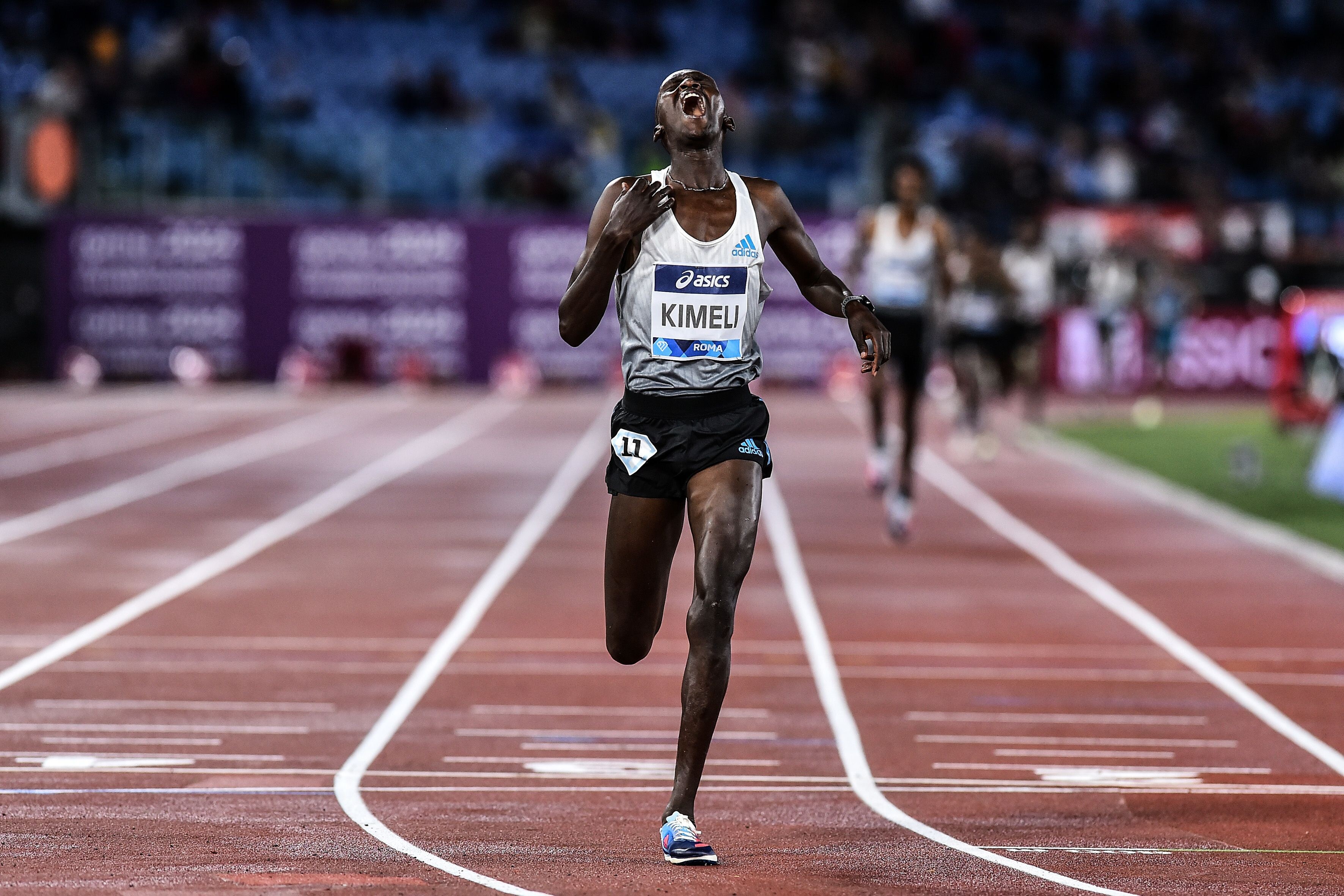
Kimeli has had a mixed season thus far and getting another shot with the Half Marathon will have him dig deep for a podium finish.
Speaking to Nation Sport, Kimeli said: “My season has not been very bad but I still have hope because I will be debuting at the Valencia Half Marathon where I intend to run a good time.
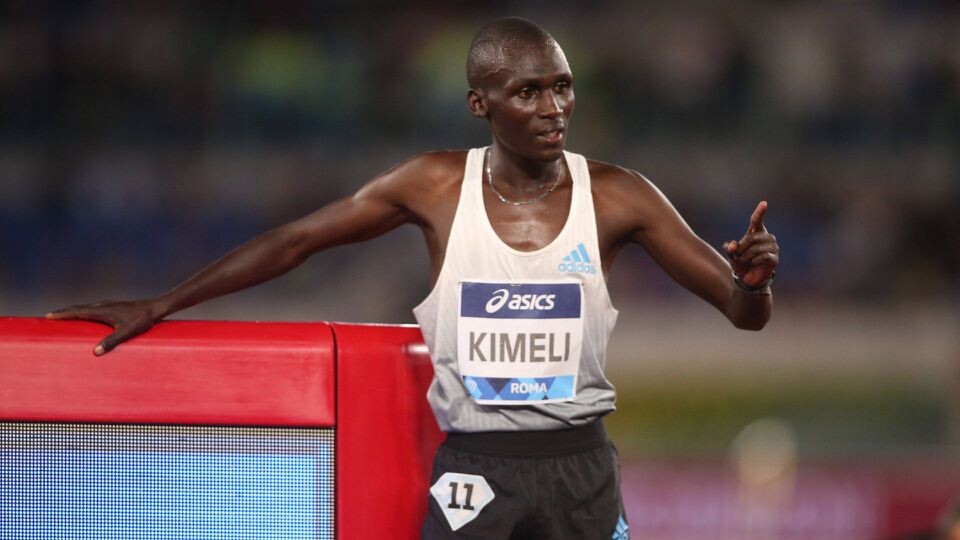
My body is doing well at the moment and I am hopeful of posting great results when I go there.”
He started off his season at the World Cross-country Championships where he finished a disappointing 13th in the men’s senior race.
The 25-year-old then proceeded to the Adizero Road to Records where he was competing in the 10km road race and finished third. He did not rest on his laurels as he went ahead to compete at the TCS World 10K Bengaluru where he finished fourth.
Kimeli then switched his focus to the track and he wowed fans at the World Championships National Trials.
Heading to the World Championships in Budapest, Hungary, he failed to impress after finishing eighth in the 10,000m and finishing 14th in the 5000m semifinal to miss a slot in the final.
He went back to the drawing board ahead of the World Road Running Championships where he managed to finish third in the men’s 5km.
He blamed an injury setback for his poor form his season but has promised a better outcome at next year’s Olympic Games in Paris, France.
(10/13/2023) ⚡AMPby Abigael Wuafula
Valencia Half Marathon
The Trinidad Alfonso Valencia Half Marathon has become one of the top running events in the world. Valencia is one of the fastest half marathon in the world. The race, organized by SD Correcaminos Athletics Club, celebrated its silver anniversary in style with record participation, record crowd numbers, Silver label IAAF accreditation and an atmosphere that you will not find...
more...Faith Kipyegon looks to add marathon record to her collection in future
Double World and Olympic champion, Faith Kipyegon has expressed her desire to smash the World Marathon record in the coming years.
The 29-year-old mother of one reaffirmed her ambition to enter the fierce road racing competition when she is finished with the track.
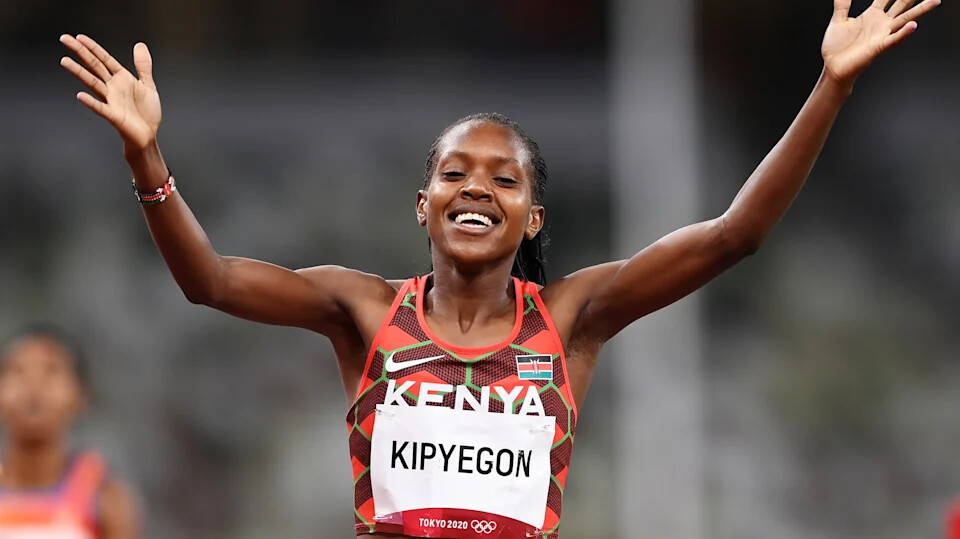
Speaking on Citizen TV, Kipyegon revealed that her masterclass act in Monaco on July 22, where she smashed the world record in the one-mile race was her initial step towards venturing into the roads.
"The mile was my first road race as I look to take up a career in the marathon. Expect to see me in the next Berlin Marathon race. I will run the marathon one day," Kipyegon said.
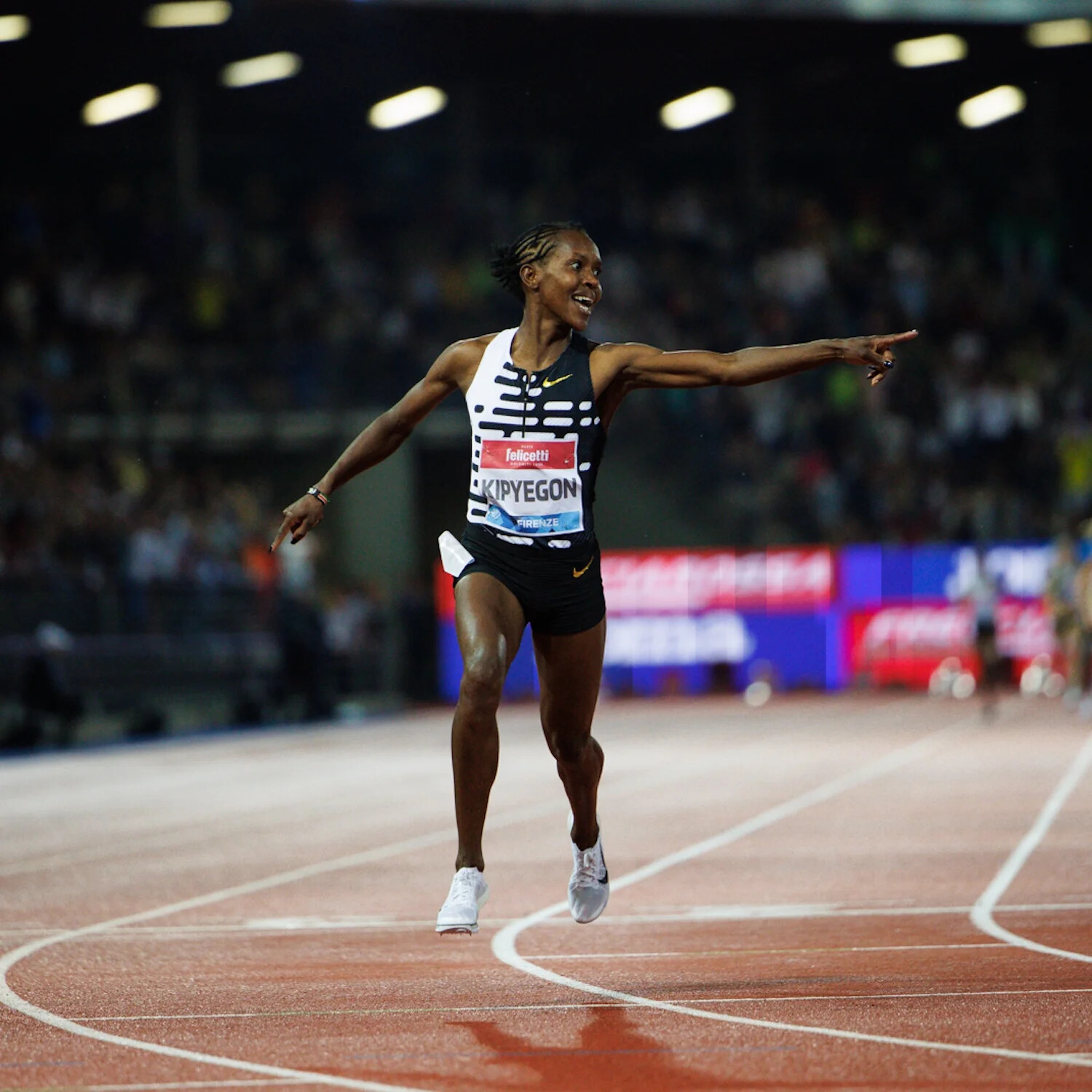
"I intend to run every major marathon in the Abbott series including the BerIin, London, and Amsterdam," she added.
Kipyegon lavished praise on marathon icon Eliud Kipchoge for inspiring her to take a stab at the blistering 42km race.
"I train in Kaptagat with Eliud Kipchoge and Geoffrey Kamwaror in a global training camp and they have done quite a lot to inspire me to take an interest in the 42km race," Kipyegon stated.
"On Mondays, we do easy runs, and on Tuesdays, we are on track. We allow the men to start ahead of us and we try as much as we can to catch up. We cannot compete with them because their training is more intense. So we only work alongside them in easy runs.
"If you love something and have a passion for it, then going for training doesn't become a burden," she quipped.
Kipyegon added that she hopes to reclaim the women's 5000m world record at the 2024 Paris Olympics after surrendering it to Ethiopia's Gudaf Tsegay in Eugene, Oregon on September 17.
"Winning three gold medals back-to-back in the Olympics will be incredible. It will motivate the coming generations and motivate me as well. I will have left a legacy.
"I have already won four Diamond Leagues and I intend to go all out for my fifth title next year.
Kipyegon spoke even as news streamed in that she had been nominated for the World Athletics Female Athlete of the Year award.
She will vie for the accolade alongside 11 other nominees unveiled by the world governing body on Wednesday. The winner will be announced on December 13.
The Kenyan track sensation made the list of nominees following a splendid season, where she smashed three world records at the Diamond League before running away with the 1500m and 5000m world titles at the World Athletics championships in Budapest, Hungary.
(10/13/2023) ⚡AMPby Tony Mballa
BMW Berlin Marathon
The story of the BERLIN-MARATHON is a story of the development of road running. When the first BERLIN-MARATHON was started on 13th October 1974 on a minor road next to the stadium of the organisers‘ club SC Charlottenburg Berlin 286 athletes had entered. The first winners were runners from Berlin: Günter Hallas (2:44:53), who still runs the BERLIN-MARATHON today, and...
more...Dina Asher-Smith is changing coach ahead of Olympic Games
Dina Asher-smith shared that she had parted ways with her coach John Blackie and will now be guided by Edrick Floreal ahead of the Olympic Games.
Great Britain’s sprint sensation Dina Asher-Smith has joined Fred Kerley and Marcel Jacobs in changing coaches.
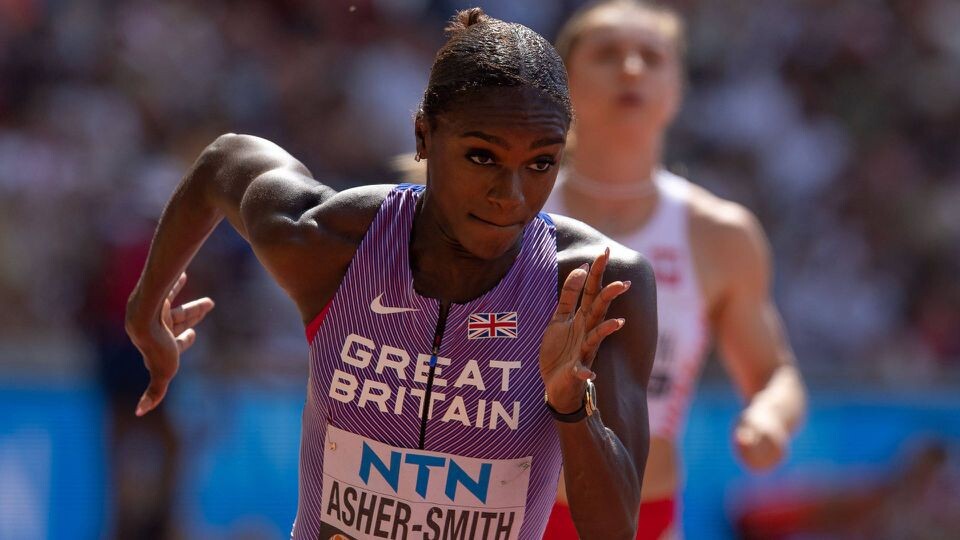
She made the announcement in a post on her Instagram page, noting that she has parted ways with her coach, John Blackie who has worked with her since she was eight.
As reported by BBC, the 27-year-old will now be coached by Edrick Floreal and based in Austin, Texas.
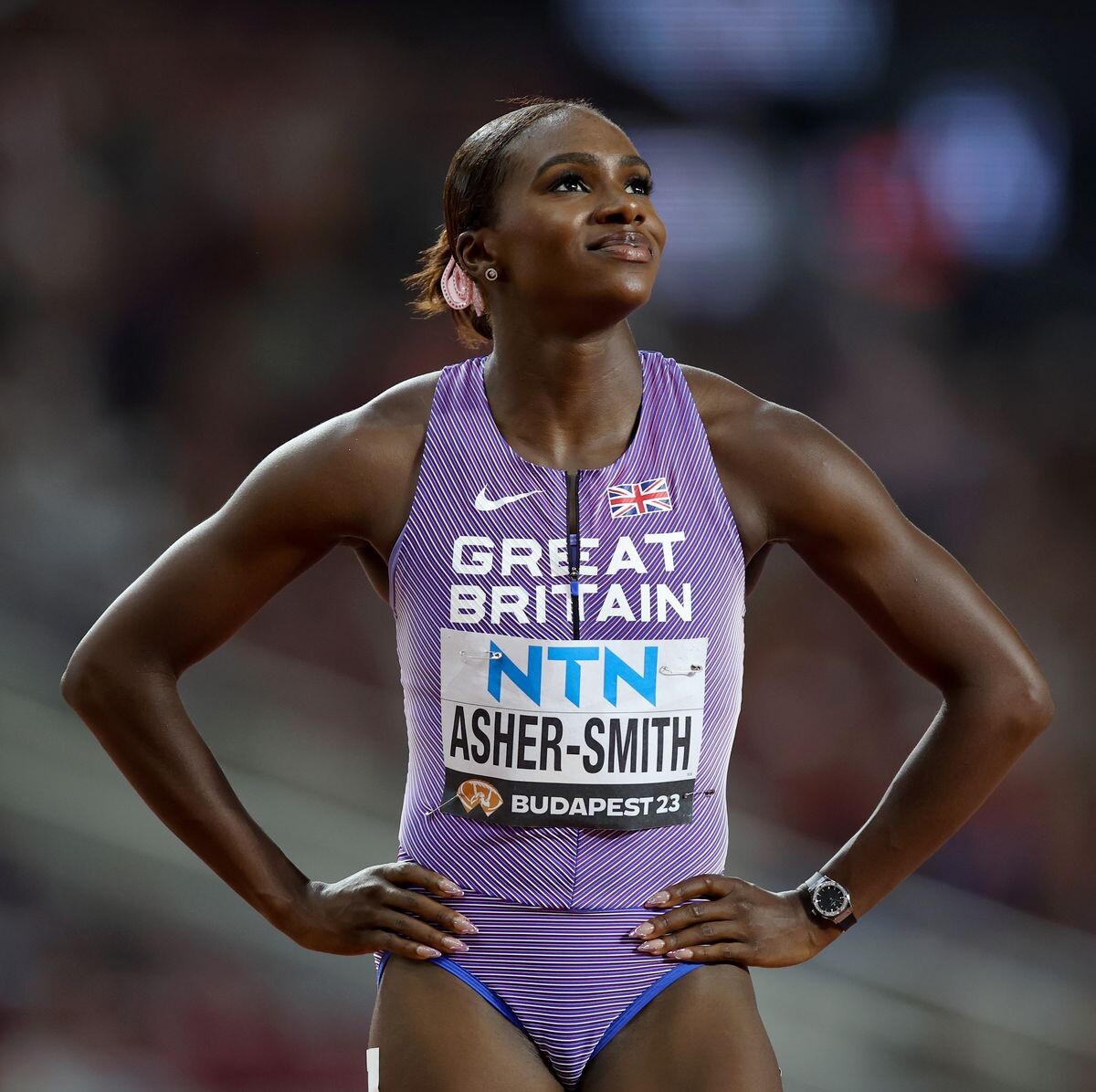
Her decision comes after her poor run at the World Championships in Budapest, Hungary where she left with no medal. She finished eighth in the 100m final and seventh in the 200m.
She said: "After 19 years, John Blackie and I have ended our coach-athlete partnership. My life changed by meeting him and I will forever be grateful to him.
His intellect, patience, and dedication have taken me from an energetic eight-year-old to a world champion with over 20 international medals and many Olympics, World, Commonwealth, and European finals.
John and I will, of course, remain close friends. Thank you to John and thank you to all my team in London whose talents and hard work have helped me realise so many dreams to date.
My next chapter will be led by Edrick Floreal based out of Austin, Texas. I'm very excited to join his talented training group as we head to Paris 2024."
Under Blackie, the Briton cemented her place as one of the greatest sprinters of all time. She bagged the 100m bronze medals at the most recent two Olympics - in Rio 2016 and in Tokyo five years later - and won 200m gold at the 2019 World Championships in Doha.
(10/13/2023) ⚡AMPby Abigael Wuafula
Paris 2024 Olympic Games
For this historic event, the City of Light is thinking big! Visitors will be able to watch events at top sporting venues in Paris and the Paris region, as well as at emblematic monuments in the capital visited by several millions of tourists each year. The promise of exceptional moments to experience in an exceptional setting! A great way to...
more...Three workouts to elevate your 10K race
The 10K can be a challenging event to get ready for. While it’s a great event to focus on early in the season, it takes a different skill set than other distance races to master. Rather than focusing on time on your feet, like you might for a half marathon or longer, preparing for a 10K needs a mix of easy runs and high-quality sessions that push your limits out of your comfort zone.
These three workouts will help you nail your goals: aim to do the first two throughout your training build, and insert the last one in the few weeks before your race. If you are a newer runner, shorten the distance of the intervals or extend the recovery time.
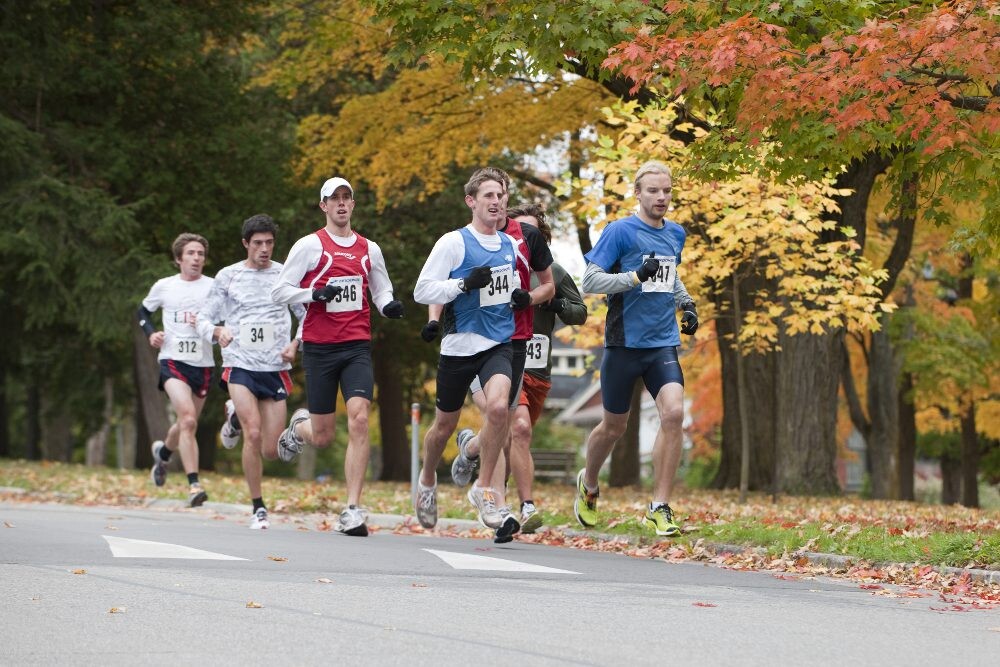
1.- 400m repeats
Find a track for this one to keep it simple. The first five of these repeats should feel easy, and through the second five you will feel yourself start to be challenged. The last five repeats will have you struggling to maintain your running form.
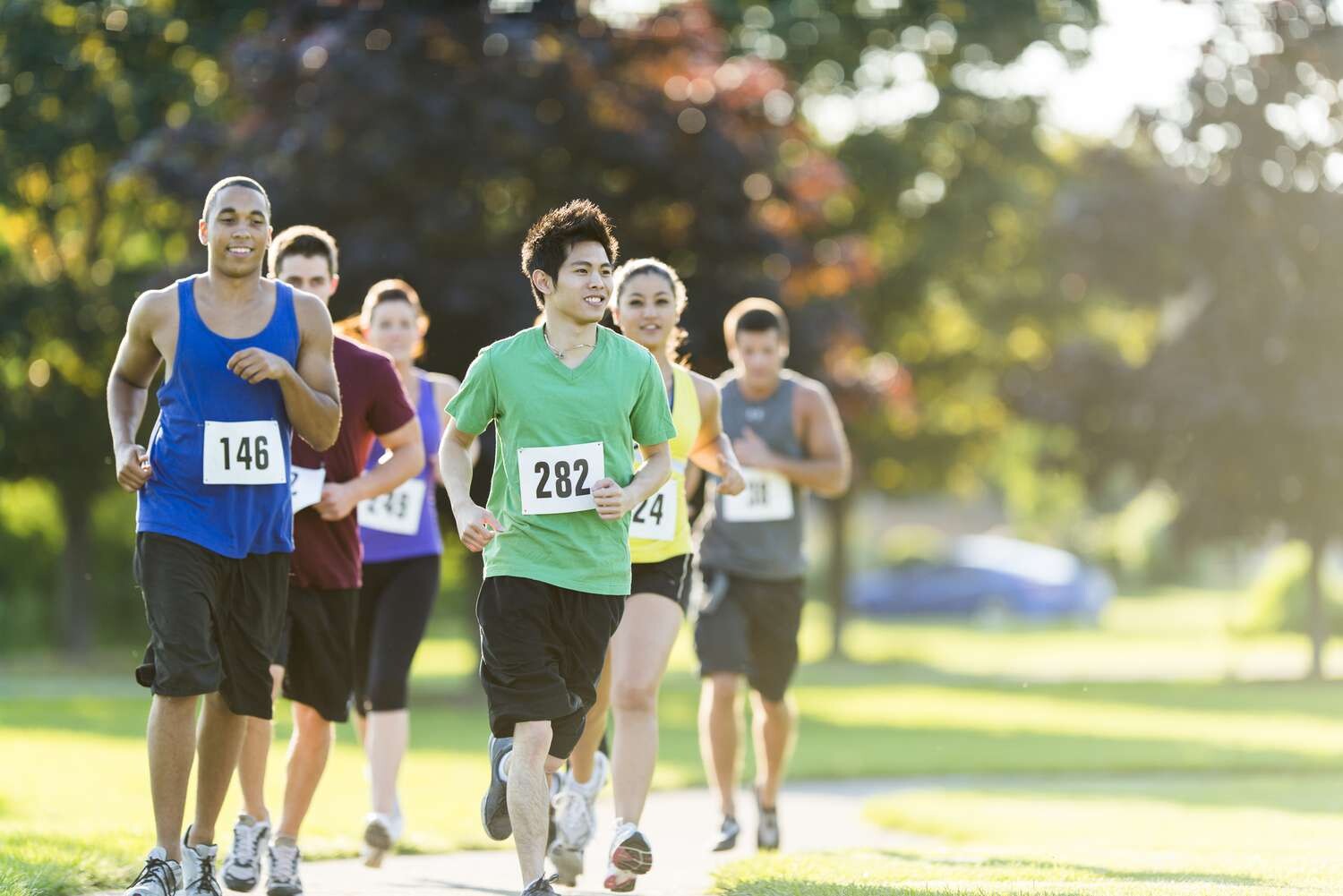
Warm up with 10 minutes of easy running.
Run 15 x 400m, aiming to complete each 400m interval at or around 5K race pace.
Use a 1:1 ratio for recovery; if your 400m interval takes 90 seconds, run slowly to recovery for 90 seconds before beginning the next one.
Cool down with ten minutes of easy running.
2.- 1K repeats
One-kilometer repeats can be an incredibly useful tool for distance runners. For this workout, a track or a stretch of flat road that you know to be one kilometer will work. Aim for 10K pace, but don’t stress over your splits–the first half of the workout should feel comfortable.
Warm up with 10 minutes easy running.
Run 8 x 1 kilometer repeats at roughly 10K pace. Use a 3:1 rest ratio for these ones. If your interval takes you 6 minutes, take 2 minutes of rest.
Cool down with 10 minutes of easy running.
This workout should be challenging, so if you find it hard, you’re doing it right. One km repeats are one of the most strenuous sessions runners complete as they build toward a 10K race. If you’re newer to running, run less repeats and take more recovery time, and work up to completing the full workout.
3.- Best 10K workout ever
This is the peak workout for your 10K race, from renowned running coach Greg McMillan. McMillan says that if you’re able to complete this workout in the few weeks before your goal race, you’re guaranteed to crush your hoped-for time. It’s a challenging workout, but by doing it you’ll become familiar with the effort required to reach your goals. Build up to this workout with the 1K and 400m repeat sessions.
Warm up with 10 minutes easy running.
3 x 2 miles (can use 3 km, if you’re fussy, 3.22 km). Take a five-minute recovery jog between each interval.
Cool down with 10 minutes of easy running.
Enjoy the admiring looks of your friends and competitors as you stride to the finish line with ease!
(10/13/2023) ⚡AMPby Keeley Milne
Berlin Half Marathon joins SuperHalfs series in 2024
The Generali Berlin Half Marathon, one of Europe’s most popular half marathons, is joining the SuperHalfs series from next year. This means there will now be six races in the SuperHalfs series.
Previously, the SuperHalfs series consisted of five races in Lisbon, Prague, Copenhagen, Cardiff, and Valencia, where participants had 36 months to complete the series. However, with Generali Berlin Half Marathon, put on by SCC Events, now joining the race line-up, starting in 2024, runners will now have the option to complete all six races, within 60 months from the day of their first race to tick them all off.
All runners will be enlisted on a new six-race SuperJourney, but those who have already begun to race SuperHalfs will have the option to earn a medal after completing the existing five races. Runners who have already completed the series also have the option to extend their racing by running in Berlin should they wish.
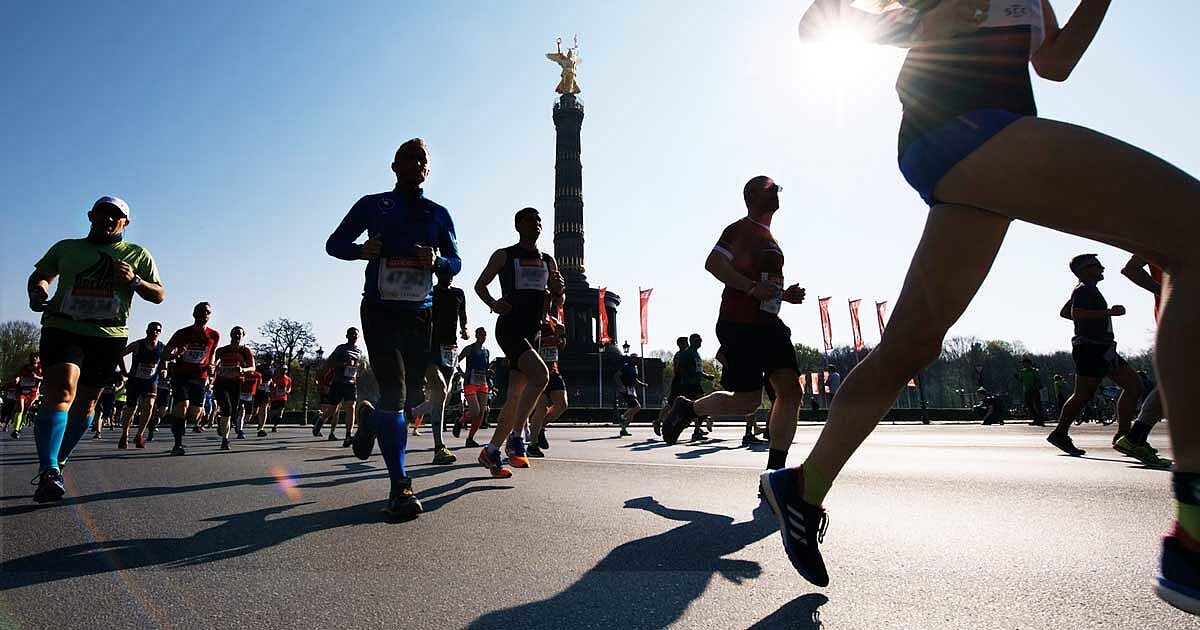
2024 SuperHalfs seriesLisbon: Sunday, March 10Prague: Saturday, April 6Berlin: Sunday, April 7 Copenhagen: Sunday, September 15 Cardiff: Sunday, October 6 Valencia: Sunday, October 27
The Managing Directors of SCC Events, Christian Jost and Jürgen Lock, said “We are delighted to join the SuperHalfs series with the Generali Berlin Half Marathon and welcome runners from around Europe to experience the unique charm of the German capital.
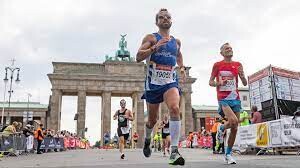
“This collaboration will create an even more unforgettable race experience and bring our beloved event to a global audience.”
Managing Director of SuperHalfs, Sasho Belovski, added:”Our goal with SuperHalfs has always been to challenge and inspire runners to achieve their personal best while exploring some of Europe’s most captivating cities.
“We are thrilled to welcome the Berlin Half Marathon into the SuperHalfs family, offering runners an even more diverse and rewarding experience. With six exceptional races, we believe this expansion will ignite even more passion for the sport.”
The SuperHalfs series reports participation of over 20,000 runners, and with the inclusion of the Generali Berlin Half Marathon, this number is expected to grow further.
The last race of the 2023 SuperHalfs series season, the Valencia Half Marathon, will see over 300 dedicated runners complete their fifth and final race, earning them the ‘SuperRunner’ title. However, these runners can opt to continue their journey in 2024 and add the stamp of Berlin into their race collection.
(10/12/2023) ⚡AMPBerlin Half Marathon
The story of the Berlin Half Marathon reflects a major part of the history of the German capital. It all began during cold war times and continued during reunification. The events leading up to today's event could really only have happened in this city. Its predecessors came from East- and West Berlin. On 29th November 1981 the Lichtenberg Marathon was...
more...Kelvin Kiptum, Noah Lyles among 11 men shortlisted for World Athlete of the Year Award
World marathon record holder Kelvin Kiptum will battle it out for the Men’s World Athlete of the Year Award with 10 other athletes, including world 100m and 200m champion Noah Lyles
World marathon record holder Kelvin Kiptum has been shortlisted for the World Athletics’ Men’s World Athlete of the Year Award.
Kiptum, who ran an astonishing 2:00:35 at the Chicago Marathon on Sunday, is among 11 male athletes who had an outstanding 2023 season who have made the shortlist.
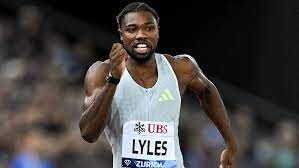
The 23-year-old has made the list after winning in Chicago and breaking Eliud Kipchoge’s world record by 34 seconds as well as claiming victory at the London Marathon in April, when he clocked 2:01:25, the second fastest time in history at the time.
Kiptum will battle it out for the prestigious award with American Noah Lyles, the world 100m and 200m champion who was undefeated in six finals at 200m.
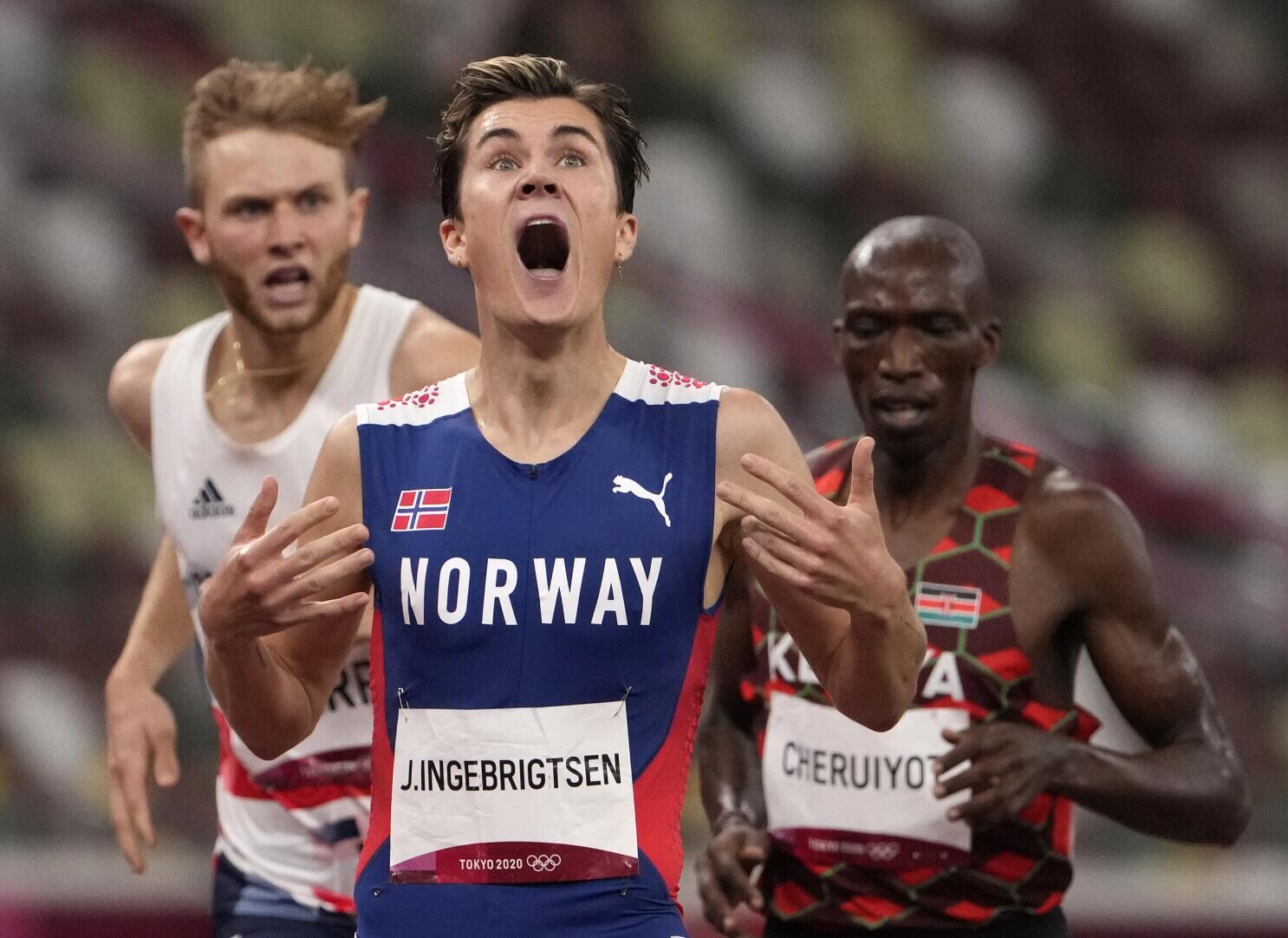
Norwegian Jakob Ingebrigtsen, the world 5,000m champion and 1,500m silver medalist, who is also the European record holder in 1,500m, mile and 3,000m, is also among those shortlisted as well as Morocco’s Soufiane El Bakkali, the world 3,000m steeplechase champion, who was undefeated in six finals in 2023.
World javelin and Asian champion Neeraj Chopra from India, American Ryan Crouser, the world shot put champion and record holder, American-born Swede Mondo Duplantis, who is the world pole vault champion, and Decathlete Pierce LePage from Canada are also on the list.
World walking race champion Alvaro Martin from Spain, Miltiadis Tentoglou, the world long jump champion, and 400m hurdles world champion Karsten Warholm complete the 11-man shortlist.
A three-way voting process will determine the finalist wit the World Athletics Council and the World Athletics Family casting their votes by email, while fans can vote online via the World Athletics social media platforms.
Individual graphics for each nominee will be posted on Facebook, X, Instagram and YouTube this week; a 'like' on Facebook, Instagram and YouTube or a retweet on X will count as one vote.
The World Athletics Council’s vote will count for 50 per cent of the result, while the World Athletics Family’s votes and the public votes will each count for 25 per cent of the final result.
Voting for the World Athletes of the Year will close on October 28. At the conclusion of the voting process, five women and five men finalists will be announced by World Athletics on 13-14 November. The winners will be revealed on World Athletics’ social media platforms on 11 December.
Kiptum will be seeking to join Kipchoge and David Rudisha as the Kenyan men to have won the prestigious award while multiple world champion Faith Kipyegon seeks to become the first woman from the country to be feted.
(10/12/2023) ⚡AMPby Joel Omotto
Bekere and Legese lead NN Running Team challenge in Amsterdam
A strong contingent of NN Running Team athletes hit the road for a crack at the 2023 TCS Amsterdam Marathon on Sunday (October 15). We take a look at our main contenders in the Dutch capital.
Women
The vastly experienced Ashete Bekere will look to add another significant marathon title to her hugely impressive CV as the 2:17:58 performer bids for success in Amsterdam. The 35-year-old Ethiopian boasts an impressive 12-year marathon career and is a former winner in Valencia, Rotterdam, and Berlin over the 42.2km distance. Setting her lifetime best in Tokyo last year she returned to the Japanese capital earlier this year and clocked a slick 2:19:11 for third to show she will be a genuine podium threat in Amsterdam.
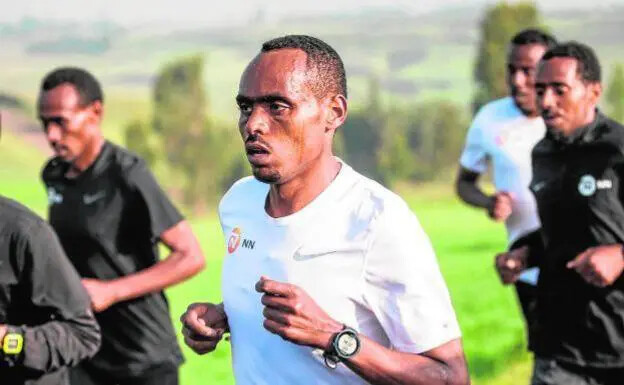
Further bolstering the NN Running Team challenge is Meseret Gola, who set her marathon PB of 2:20:50 when second at the 2022 Seville Marathon. In her most recent marathon outing, the 25-year-old Ethiopian placed a handy second in 2:22:12 in Osaka.
Men
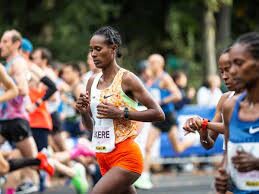
Birhanu Legese, the fourth fastest man in history over the marathon distance, will spearhead the NN Running Team contenders in a highly competitive men’s race. The 29-year-old Ethiopian is a supremely gifted performer as evidenced by his stunning PB time of 2:02:48 recorded when second to countryman and NN Running Team team-mate Kenenisa Bekele at the 2019 Berlin Marathon. A two-time former winner of the Tokyo Marathon, Legese will be pursuing success in Amsterdam boosted by a half marathon PB of 58:59 recorded in Barcelona earlier this year.
His fellow Ethiopian Bazezew Asmare has shown an aptitude for the streets of Amsterdam – finishing third here in 2022 recording a PB of 2:04:57 and the 27-year-old will once again be pursuing a podium spot.
Asrar Hiyrden completes a strong trio of Ethiopian challengers – his marathon best of 2:04:43 when winning the 2022 Seville Marathon marking him out as a significant threat in what will be a high-class race.
Also entered are the Dutch duo Richard Douma and Roy Hoornweg fresh off marathon PB performances earlier this year. Douma, a former European Championship 1500m fourth-place finisher, recorded 2:11:21 in Seville with Hoornweg registering 2:13:19 in Rotterdam.
Two NN Running Team athletes will be on pacing duty; Kenyan Noah Kipkemboi, a 2:07:32 marathoner at his best, and Ugandan Abel Sikowo.
(10/12/2023) ⚡AMPby NN Running Team
TCS Amsterdam Marathon
Do you want to enjoy Amsterdam in October and all that the city has to offer you? Want to feel a real athlete and start and finish in the historic Olympic stadium? Or run across the widely discussed passage under the beautiful National Museum? Then come to Amsterdam for the annual TCS Amsterdam Marathon in October! The TCS Amsterdam Marathon...
more...Four ways to make rainy runs way more fun
Rainy running weather has many of us dashing for shelter or simply hiding out indoors. Rain can be a great training tool, however: running in different weather conditions can prepare you for unpredictable weather on race day, and sticking it out when the weather gets wild will improve your adaptability as a runner, making you a more versatile and capable athlete.
Just like running in snow or in cold weather, rainy running builds mental resilience and grit. Here are a few ways to make it easier to get out there and enjoy the beauty of a rainy day.

1.- Stay visible
Rain can reduce visibility for vehicles, so if you plan to run on roads, opt for a route with less traffic and a wide shoulder. Wear reflective patches, a vest or a headlamp (or all three), and always run toward traffic if there are no sidewalks (usually this will be on the left side). If it’s raining, avoid running at night, if you can: the glare of rain on the road can be reflective for cars and makes it even more challenging for drivers to see you.
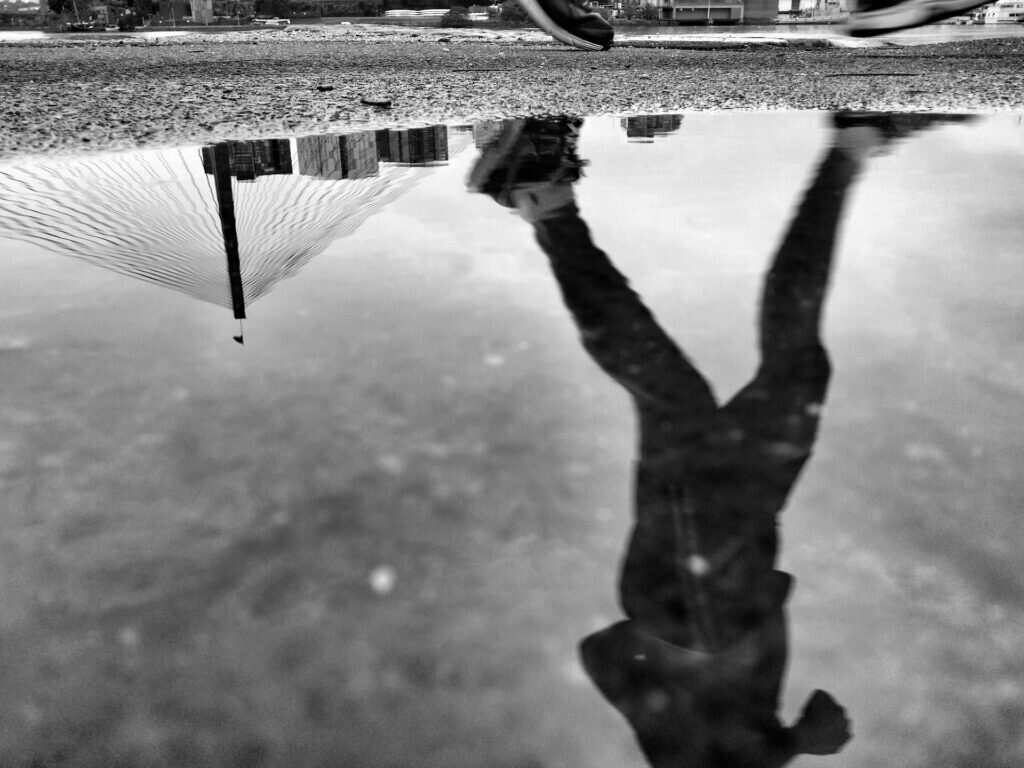
2.- Dress wisely (and appropriately)
Wear layers and a hat with a brim to keep the rain from pouring into your eyes. It can be hard to judge how warm it is when you’re headed out into the rain, but a lightweight, breathable rain shell is usually enough for your outer layer, with a single layer underneath. (We tend to think we’ll feel colder than we actually do before heading out into a damp day.) If possible, choose clothes with reflective patches.
3.- Lube up
Every runner’s enemy, the dreaded chafe, can be much worse after a rainy run, when wet clothing rubs against your skin with more friction than usual. Make sure to use a chafing stick pre-run on parts of your body where you would normally chafe or get blisters, such as your feet, inner thighs and underarms.
4.- Take steps to speed up recovery
Change out of wet clothes right after your run and warm up as soon as possible to avoid hypothermia. If you’re running a wet race or you drove to the start of your run, keep a dry change of clothes in a drop bag for afterward, to help get your body temperature back up quickly. A warm shower or bath will feel amazing when you’re ready to relax.
While running in the rain is usually a fairly safe activity, avoid heavy storms or lightning.
(10/12/2023) ⚡AMPby Keeley Milne
Kartik, Sanjivani to lead India’s charge at Vedanta half marathon
Asian Games silver medalist in the 10,000m race Kartik Kumar and Defending Champion Sanjivani Jadhav will headline the Indian elite athletes in the men’s and women’s categories at the 18th Vedanta Delhi Half Marathon, a World Athletics Gold Label Road Race. The event will be held here on Sunday, October 15.
Kartik Kumar, who is a very successful 10,000m runner, recorded his personal best (1:04:00) at the Vedanta Delhi Half Marathon last year. He was also the runner-up at the TCS World 10K 2022, Bengaluru with a timing of 30:06. Kartik became the first Indian to win a medal in the 10,000m event at the Asian Games since Gulab Chand in 1998. Kartik’s compatriot Gulveer Singh won a Bronze in the same event.
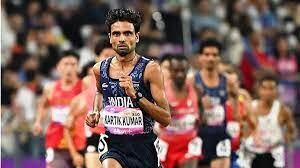
Kartik, however, will face stiff competition from the winner of the Dhaka Half Marathon 2023 Abhishek Pal, the champion of the Tata Mumbai Marathon 2023 Half Marathon Murali Kumar Gavit and National marathon winner Srinu Bugatha.
Experienced marathoners Kalidas Hirave and Durga Bahadur will also vie for a place on the podium in the Indian Elite Men’s category.
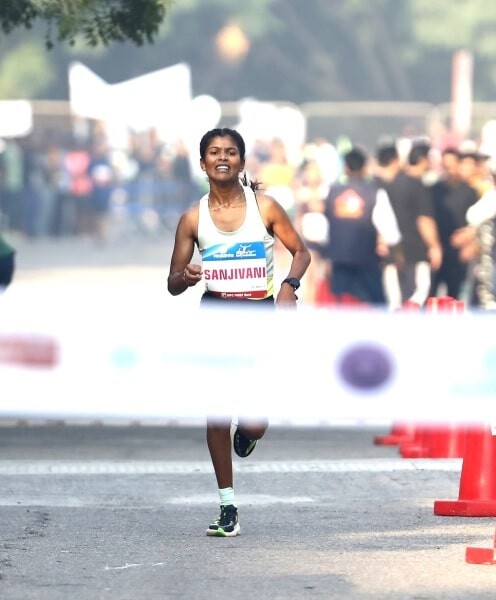
Meanwhile, Defending Champion Sanjivani Jadhav will lead the charge in the Indian Elite Women’s category. She recorded a timing of 77:53 in the last edition of the Vedanta Delhi Half Marathon and also won the TSK 25K 2022. Moreover, Jadhav clinched the bronze medal in the 5000m event at the 2017 Asian Athletics Championships and triumphed in the 10,000m event at the National Federation Cup in 2022.
She will receive strong opposition from the winner of the TCS World 10K Bengaluru 2023 Tamshi Singh and the champion of the New Delhi Marathon 2019 and 2020 – Jyoti Gawate in the Indian Elite Women’s Race.
The USD 268,000 prize money will see tens of thousands of amateurs join the world’s best elites on one of the fastest courses in the world.
(10/11/2023) ⚡AMPVedanta Delhi Half Marathon
The Airtel Delhi Half Marathon is a haven for runners, creating an experience, that our citizens had never envisaged. The streets of Delhi converted to a world-class running track. Clean, sanitized road for 21.09 kms, exhaustive medical support system on the route, timing chip for runners, qualified personnel to ensure smooth conduct of the event across departments. The race...
more...Faith Kipyegon nominated for 2023 athlete of the year award
World 1,500m and mile world record holder Faith Kipyegon has been nominated for the female World athlete of the year award by World athletics.
The award is a prize that is awarded to athletes participating in events within the sport of athletics organised by World Athletics (formerly IAAF), including track and field, cross-country running, road running, and race-walking.
World athletics announced on Wednesday that 11 nominees have been picked for the female athlete of the year after selection from an international panel of athletic experts.
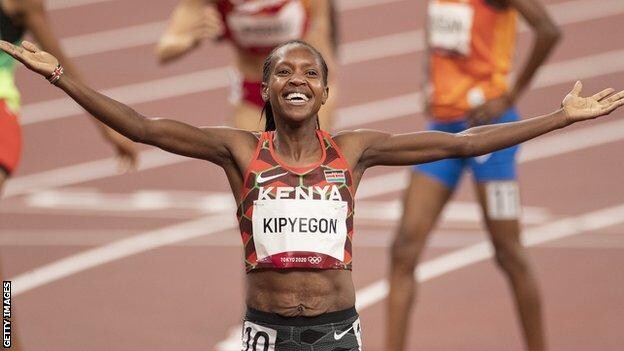
"World Athletics is pleased to confirm a list of 11 nominees for Women’s World Athlete of the Year. These athletes were selected by an international panel of athletics experts, comprising representatives from all six continental areas of World Athletics.”
The athletics body said the nominations reflect performances from Budapest championships and other championships held in the year.
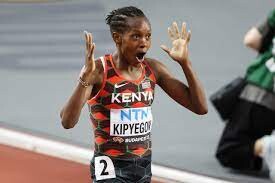
"In what has been another memorable year for the sport, the nominations reflect some of the standout performances achieved at the World Athletics Championships in Budapest 23, one-day meeting circuits, label road races and other events around the world."
Kipyegon was selected after a memorable performance at the World Athletics Championships in Budapest where she won both the 1,500m and 5,000m races to become the first female in history of the championships to clinch double accolades.
She will face competition from Ethiopia’s Tigist Assefa who is the female World Marathon record holder with a time of 2:11.53 set at the Berlin Marathon in September.
Also joining the pair will be world record holder in the 5,000m Tsegay Gudaf of Ethiopia who set the record during the 2023 final Diamond League.
USA’s Sha’carri Richardson is also nominated alongside Kenyan-born Bahraini female athlete Winfred Yavi.
The 2020 Tokyo Olympics bronze medalist in the high jump Yaroslava Mahuchikh, Venezuelan Yulimar Rojas who holds the world record for women's triple jump, Jamaica’s Shericka Jackson who boosts of 5 Olympic medals and 8 World championships medals are also part of the list.
Winner of the 35km walk in Budapest, Maria Perez from Spain and 2023 world champion in the 400m Femke Bol conclude the list.
Voting for the World Athletes of the year will close on October 28 at midnight after which five women and five men finalists will be announced by World Athletics on November 13 and 14.
World athletics also said their vote would account for 50 per cent of the total results whereas the public vote and athletics family vote would each account for 25 per cent of the results.
The winners will be revealed on World Athletics’ social media platforms on December 11.
(10/11/2023) ⚡AMPby Teddy Mulei
Bullish Kelvin Kiptum wants a duel with Eluid Kipchoge at Paris Olympic Games
After his exploits at the Chicago Marathon, Kelvin Kiptum is considering competing at the Olympic Games where he will face off against Eliud Kipchoge.
After his jaw-dropping performance that saw him break the world record at the Chicago Marathon, Kelvin Kiptum has now confirmed that the Olympic Games are on his mind.
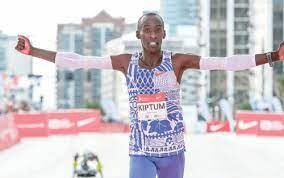
The 23-year-old clocked 2:00:35 to completely destroy Eliud Kipchoge’s world record time of 2:01:09 and he is not resting on his laurels.
His focus has now shifted to the Olympic Games in Paris, France where he will lock horns with five-time Berlin Marathon champion, Kipchoge.
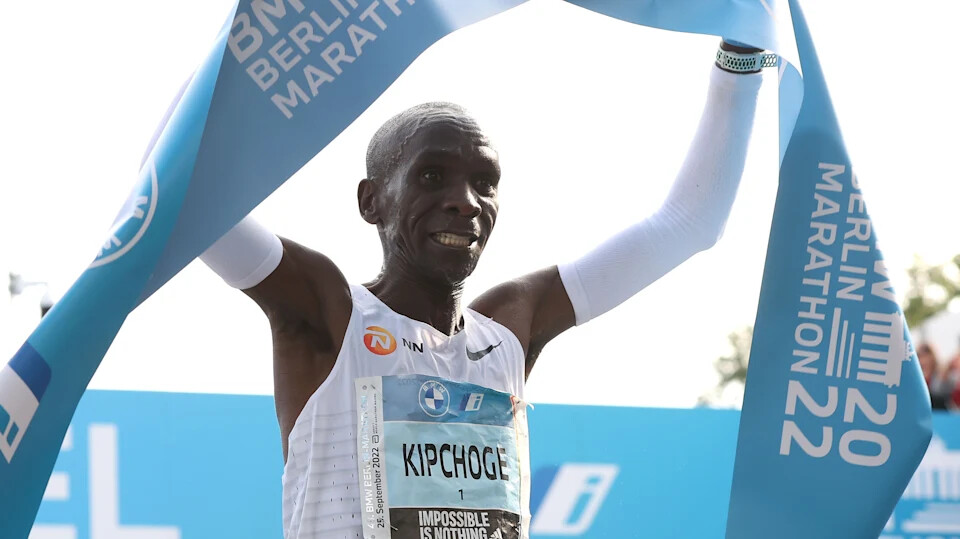
Speaking during a post-race interview, the reigning London Marathon champion said: “Yes, the Olympic Games are on my mind. I think this win has placed me in a better position ahead of the global showpiece.”
Kiptum added that he is not aware of the selection criteria and he will have to get back to the country and discuss it with his management first. However, he is planning on resting first before resuming training ahead of next season.
If it happens, the race will definitely be one to remembered since Kipchoge will be bidding to become the first man to win the Olympic title in the marathon three times.
He has not had a great 2023 season and will be plotting a comeback next year. The 38-year-old started off with the Boston Marathon where he finished sixth due to a problem with his left leg.
He then proceeded to the Berlin Marathon with the hope of breaking his own world record but he did not achieve the target.
Meanwhile, Kiptum has enjoyed a blissful season, winning the London Marathon earlier this year and winning the Chicago Marathon in a world record time to end his season with a bang.
He made his debut at the Valencia Marathon last year and ran the fastest debut time in history.
(10/11/2023) ⚡AMPby Abigael Wuafula
Paris 2024 Olympic Games
For this historic event, the City of Light is thinking big! Visitors will be able to watch events at top sporting venues in Paris and the Paris region, as well as at emblematic monuments in the capital visited by several millions of tourists each year. The promise of exceptional moments to experience in an exceptional setting! A great way to...
more...Cam Levins shatters longstanding course record at Royal Victoria Half Marathon
On Sunday, Cam Levins raced close to his home of Black Creek, B.C., winning the Royal Victoria Half Marathon in a new course record time of 61:18 in front of his friends and family in preparation for the TCS New York City Marathon on Nov. 5. Levins broke the previous record of 62:32 held by two-time British Olympian Jon Brown, which stood for 21 years.
Running close to home meant Levins was able to race in front of his 94-year-old grandmother, Fern, and his parents, Barb and Gus, who came down from Black Creek. “I am so proud of him,” said Fern Levins of Esquimalt to the Victoria newspaper Times Colonist. “It’s not very often I get to see Cameron race live.”
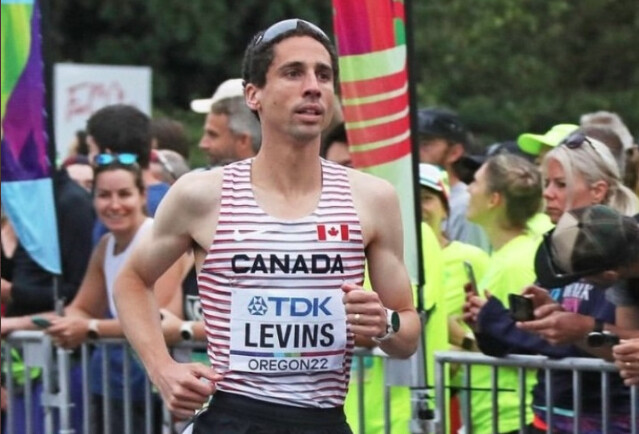
“Vancouver Island will always be my home, so racing here is extra special,” said Levins. His finishing time on Sunday was a minute shy of his Canadian half-marathon record of 60:18, set at Vancouver’s First Half last February.
The 34-year-old marathoner was slated to race in the half-marathon at the 2023 World Road Running Championships in Riga, Latvia, on Oct. 1, but changed his plans two weeks before the championships, opting to race the Victoria half instead, rather than travelling internationally.
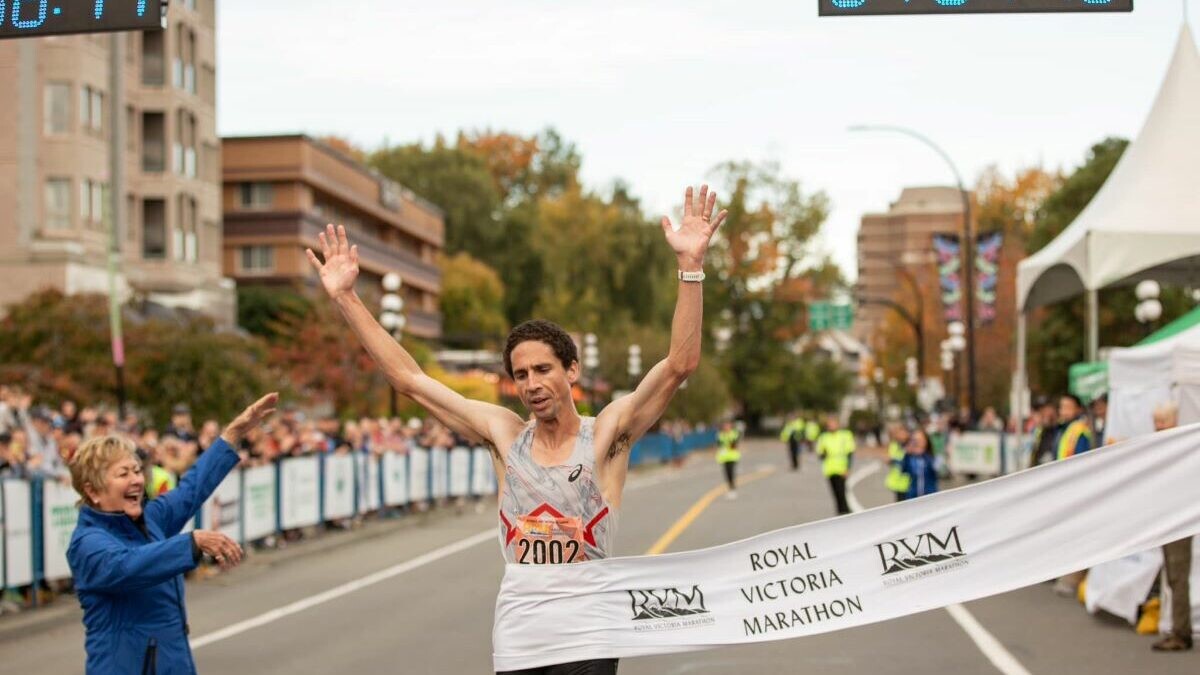
Levins finished nearly three minutes ahead of the second-place finisher, 2020 Olympic marathoner and reigning Canadian marathon champion Trevor Hofbauer, who ran to a personal best of 64:07. Kip Kangogo of Lethbridge, Alta., rounded out the podium for third in 67:46.
“I felt good about my effort today,” Levins told the Times Colonist. “It [Victoria] was definitely a hard course, much like New York, helping me to gauge, making me feel pretty good about my marathon.”
Makenna Fitzgerald of Calgary won the women’s half marathon in 1:17:30, beating second-place finisher Vancouver’s Eriko Soma by 58 seconds. Victoria’s own Carley Gering took the final spot on the podium for third in 1:18:57.
The 2023 TCS New York City Marathon will be Levins’s second marathon of the year. Last March, he broke his Canadian record in the marathon for the second time in less than a year by running 2:05:36 to place fifth in the Tokyo Marathon. This marked the fastest time ever recorded by a North American marathoner, beating Khalid Khannouchi’s mark of 2:05:38 from the 2002 London Marathon (which remains the American record). Levins’s Tokyo time was under the Olympic standard of 2:08:10 and qualified him for his third Olympic Games in Paris next July.
(10/11/2023) ⚡AMPby Marley Dickinson
Royal Victoria Marathon
We are one of Canada's premier running event, offering athletes an unmatchable running experience on the pristine West Coast. Our world-class, record-breaking course is designed by runners, for runners. As the only Certified Boston Qualifier on Vancouver Island, come join us to compete, to conquer and to move from warm-up to reward. ...
more...Men and women 75-79 age group records set at the Chicago Marathon
While Kelvin Kiptum’s world record time of 2:00:35 stole the show at the 2023 Chicago Marathon, the race saw a slew of masters records go down on Sunday.
Two runners in the 75-79 age group racked up numerous accolades. Jeannie Rice, 75, broke the women’s masters world record in the marathon with a time of 3:34:32, and also racked up American records over the course of the race, including the 10K (49:14) and half marathon (1:43:09). Gene Dykes, 75, also set an American marathon masters record of 3:17:01.
(10/10/2023) ⚡AMPKenya’s Alfred Kipchirchir is set to debut at TCS Toronto Waterfront Marathon
Kenya’s Alfred Kipchirchir makes his marathon debut on October 15 at the TCS Toronto Waterfront Marathon and he hopes it goes as well as that registered by one of his training partners.
Kipchirchir, 29, trains in a group which includes Vincent Ngetich who chased two-time Olympic champion Eliud Kipchoge along the streets of Berlin last weekend, eventually finishing second in the famed Berlin Marathon in 2:03:13. It was a stunning performance and one that has inspired Kipchirchir.
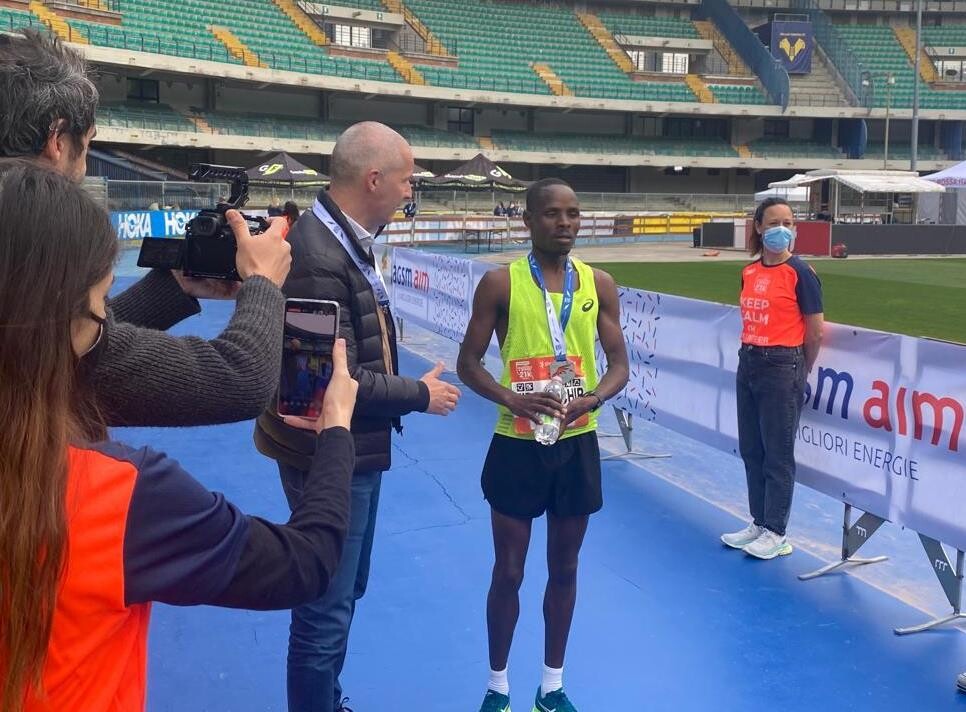
“I am looking forward to running 2:05 or 2:04 in Toronto,” he reveals. “My training is going well. We run between 180 and 210km in a week.”
According to Coach Peter Bii these two star athletes trained together right up until the last two weeks with Kipchirchir running step for step with Ngetich. Of course, the latter had to back off training to prepare for the Berlin Marathon.
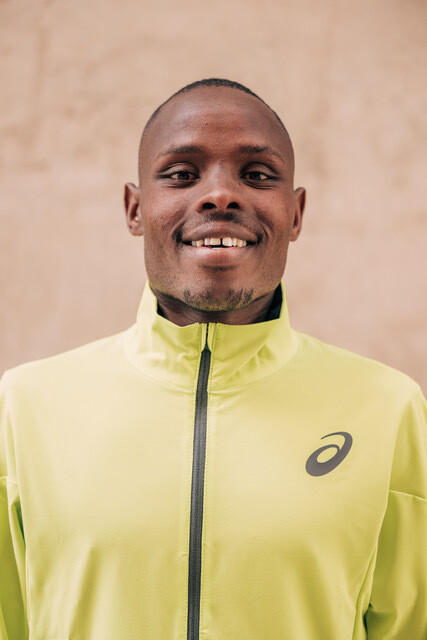
“I want to debut in Toronto because I like what I have heard about the city from Enock Onchari,” says Kipchirchir. A year ago Onchari, another member of the group, finished 4th in Toronto Waterfront.
“We know it’s very cold (in Toronto) from when Onchari was there. I have no information about the course,” he continues.
Kipchirchir has dipped under 60 minutes for the half marathon distance three times in the past three years with his best 59:43 set in the 2021 Madrid Half Marathon. With his current training going well, it is not unreasonable for him to have very high expectations.
All of his life the village of Kapkenu has been his home. It’s about 80 Kilometres from the famed ‘runners’ town’ of Iten. As a young boy he admired the achievements of his neighbour Geoffrey Kamworor who won both the world half marathon and world cross country championships three times and was twice winner of the New York City Marathon. But it was a family member who pushed him to become a runner in his youth.
“My brother introduced me to running. He works as the manager of the High Altitude Training Centre run by Lorna Kiplagat in Iten,” he reveals.
Like many Kenyan athletes, he leaves home every Monday morning and travels to the group’s training camp where he will remain until the following Saturday. He doesn’t own a car and relies upon a ‘matatu’, a publicly shared minibus. Sometimes his brother will drive him though. It’s a sacrifice he is prepared to make to ensure he achieves his running potential.
At the training camp there is much camaraderie. The shared sense of commitment and sacrifice he finds builds mental fortitude which he hopes to translate into a superb performance in Toronto. But there is also time to relax.
“I like to listen to music, Kalenjin (tribal) songs, when I am home and at camp,” he says. “And I watch football. I am a Manchester United supporter.”
Both he and Coach Peter laugh heartily when the interviewer shakes his head at the current disruption at the club. Among the group there are Tottenham Hotspur, Chelsea and Manchester City fans says Peter.
Earnings from Kipchirchir’s running career have helped him take care of his immediate family, his wife Rhoda Jepkemboi Mukche and his 14-month-old daughter Praise Jepkorir.
“I have already bought a small farm,” he says. “It’s two acres. I grow maize and I have goats. My family members are at my home and they look after the farm when I am away at camp.”
The TCS Toronto Waterfront Marathon course record is 2:05:00 held by Philemon Rono since 2019. On that occasion three runners came home within thirteen seconds of Rono, once again demonstrating fast times can be achieved here.
The transition to the marathon sometimes proves difficult for even some of the best distance runners in the world. But something in his preparation and attitude reveals Kipchirchir will have a memorable debut in Toronto.
(10/10/2023) ⚡AMP
by Christopher Kelsall
TCS Toronto Waterfront Marathon
The Scotiabank Toronto Waterfront Marathon, Half-Marathon & 5k Run / Walk is organized by Canada Running Series Inc., organizers of the Canada Running Series, "A selection of Canada's best runs!" Canada Running Series annually organizes eight events in Montreal, Toronto and Vancouver that vary in distance from the 5k to the marathon. The Scotiabank Toronto Waterfront Marathon and Half-Marathon are...
more...Five workouts to crush your fastest 5K
The 5K is often an underrated distance, but runners who have invested significant time perfecting it understand that when you push yourself to run at high intensity, it can be one of the most challenging distances. Achieving a fast 5K demands extensive time and training, but it’s crucial to make sure you’re doing the right speedwork to enhance your top-end speed. These five workouts are designed to assist you in precisely that, helping you crush your 5K personal best.
Workout 1: speedwork for beginners
If you’re new to running and haven’t done much speedwork, this workout is a great place to start. It may look easy on paper, but 10 intervals get tough over time. If you’re a little more experienced, you can try reducing the rest interval to one minute and increasing the length of your warmup and cooldown by five minutes so you’re still spending the same amount of time on your feet.
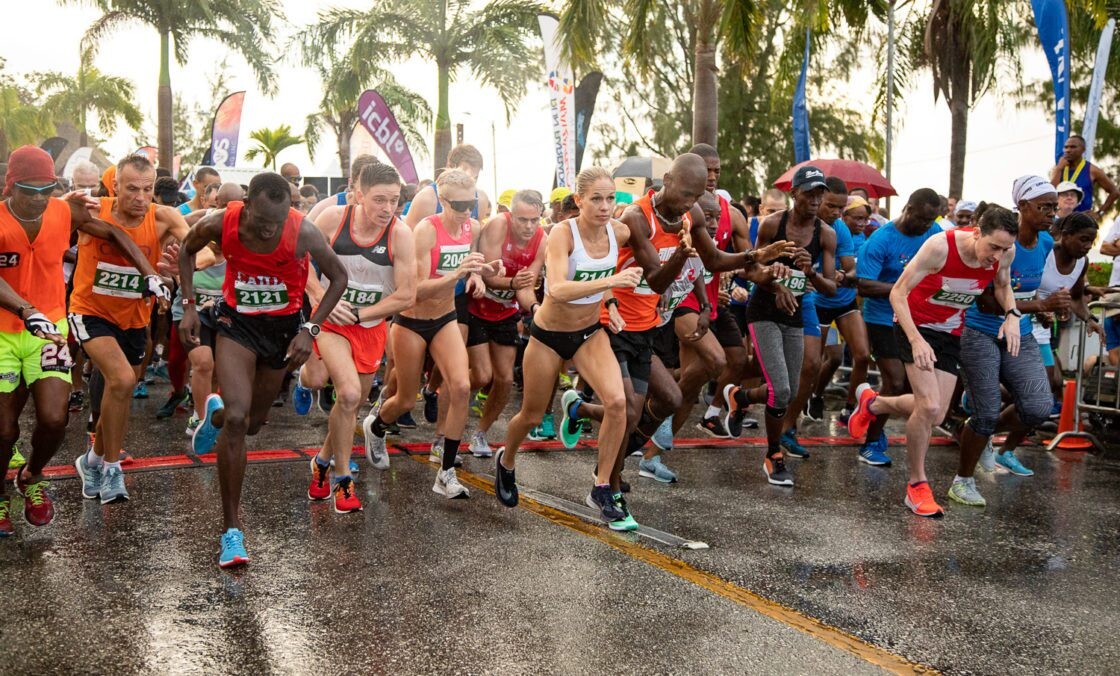
Warmup: 10 minutes of easy jogging
Workout: 10 x (one minute at 80 per cent of your max speed/two minutes easy jog recovery)
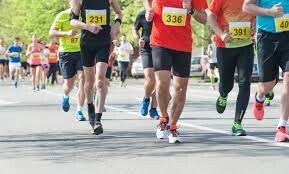
Cooldown: 10 minutes of easy jogging
Workout 2: alternating 400s
No 5K training program would be complete without 400m repeats. Every runner, from novice athletes to Olympians, does 400m intervals when preparing for the 5K. If you don’t have a track, you can do this by running for two minutes hard followed by three minutes easy.
Warmup: 10 minutes of easy jogging, followed by 2-3 30-second quick strides
Workout: 6 x (400m hard/400m jog recovery)
Cooldown: 10 minutes of easy jogging
Workout 3: speed endurance
The key to running a successful 5K is being able to run near your max for the entire distance. This workout takes the 400s and pushes you to maintain that speed for longer, with less recovery. This is a tough workout, but an important workout. Like with the 400s, if you don’t have a track, you can do this on the road and run for four minutes hard with a two-minute jog recovery.
Warmup: 10 minutes of easy jogging, followed by 2-3 30-second quick strides
Workout: 4 x (800m hard/400m jog recovery)
Cooldown: 10 minutes of easy jogging
Workout 4: the ladder
The ladder is a classic 5K workout. The goal here is to maintain a consistent speed for each interval as you climb the ladder (i.e. as the intervals get longer), then try to gradually speed up as you head back down.
Warmup: 10 minutes of easy jogging
Workout: (All reps should be done at your 5K goal pace or faster)
30s hard/30s easy
one minute hard/one minute easy
two minutes hard/two minutes easy
three minutes hard/three minutes easy
two minutes hard/two minutes easy
one minute hard/one minute easy
30s hard/30s easy
Cooldown: 10 minutes of easy jogging
Workout 5: 1K repeats
One kilometre repeats is the ultimate 5K test workout. If you’re wondering whether you can maintain your goal pace for the entire distance, this session will test it out. For more advanced runners, you can do this workout once near the beginning of your training program and once a couple weeks out from your goal race to gauge how much you’ve progressed.
Warmup: 10 minutes of easy jogging, followed by 2-3 30-second quick stride
Workout: 5 x (1 kilometre at goal 5K pace/two minutes rest)
Cooldown: 10 minutes of easy jogging.
(10/10/2023) ⚡AMPby Brittany Hambleton
Sisay Lemma and Zewditu Gelaw triumph in Ankara
Ethiopian duo are too good for the rest as they claim titles in Turkish capital’s first ever international half-marathon, writes Wendy Sly
Sisay Lemma and Zewditu Gelaw won the inaugural Runkara Half-Marathon, a landmark race for organisers in Turkey.
Until Sunday (Oct 8), Ankara had been the only capital city in the world without a road race event – despite a population of over six million.
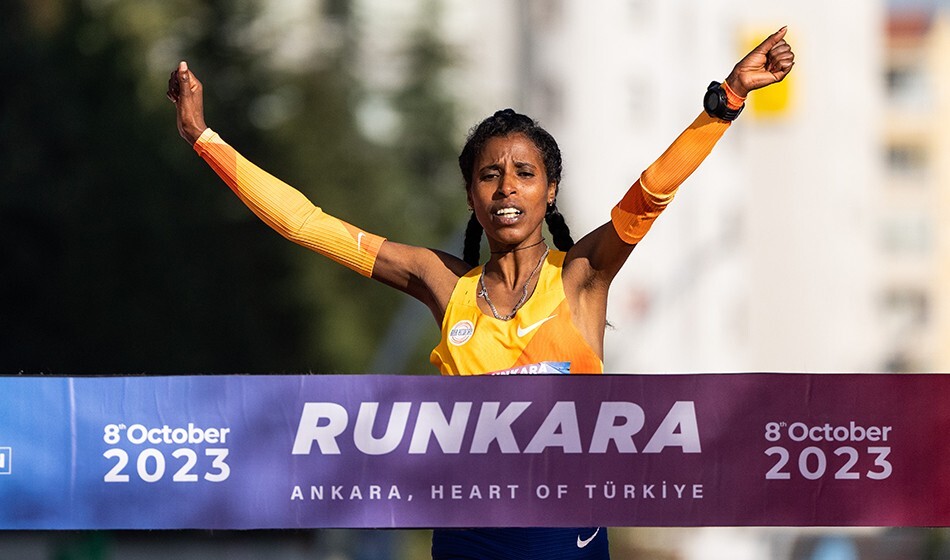
Appropriately starting within a stone’s throw of the Ataturk Mausoleum – Mustafa Kemal Ataturk founded modern Turkey 100 years ago this month – the course looped around the western side of the city centre in glorious conditions.
The first ever international half-marathon in the Turkish capital had 4000 entries, including an eye-catching elite line-up.

Lemma, the 2021 London Marathon champion, was one of the standout names in the men’s race while home favourite Sultan Haydar looked to challenge Zewditu Gelaw and Roselidah Jepketer in the women’s field.
The men’s event saw Victor Mutai and Julius Kipchumba set the early pace as the leaders went through the undulating first 10km in 29:27. By the 12km mark a small group of six had broken away. They went through in 38:05 and at a solid pace, bearing in mind the hills and 860m altitude.
Bethwell Yegon, who finished second behind Guye Adola at the 2021 Berlin Marathon, battled Lemma for a large proportion of the race. Lemma continued to push hard and, around the 50-minute mark, with roughly 3km to go, broke away. The Ethiopian won by 18 seconds in a time of 61:09 ahead of compatriot Chimdessa Debele (61:27), while Kenya’s Vincent Nyageo 61:44 was third.
In the women’s race, Haydar – a former Ethiopian now running for Turkey – went through 10km in 32:01 (67:30 pace) along with Gelaw and Jepketer. Gelaw was the pre-race favourite and made her mark on the race when it mattered the most.
Running a strong last 6km, the Ethiopian finished in 68:28 to take first place, with Haydar (69:09) in second and Kenyan Vivian Kosgei (70:10), making her half-marathon debut, taking third.
The Runkara event is sure to go from strength to strength when finding its place on the international road racing calendar. Race Director Victoria Blyth was instrumental in putting it together, alongside support from RunCzech.
(10/10/2023) ⚡AMPby Athletics Weekly
Runkara Half Marathon
Runkara Half Marathon is a marathon planned at international standards and includes both amateurs and professional participants. This race brings together elite athletes from abroad and the city for you. 21 km is for those who really want to challenge themselves and love long distance running. “All runners are beautiful.” We run to push our limits, stay healthy and have...
more...Former european indoor 3000m champion Yelena Korobkina suspended for doping
Former European indoor 3000m champion Yelena Korobkina has been banned from international competition for four years for violating anti-doping rules, the Russian Athletics Federation reported.
Yelena Korobkina was suspended by a decision of the Court of Arbitration for Sport (CAS) on September 27. The reason is the use of prohibited stimulants.
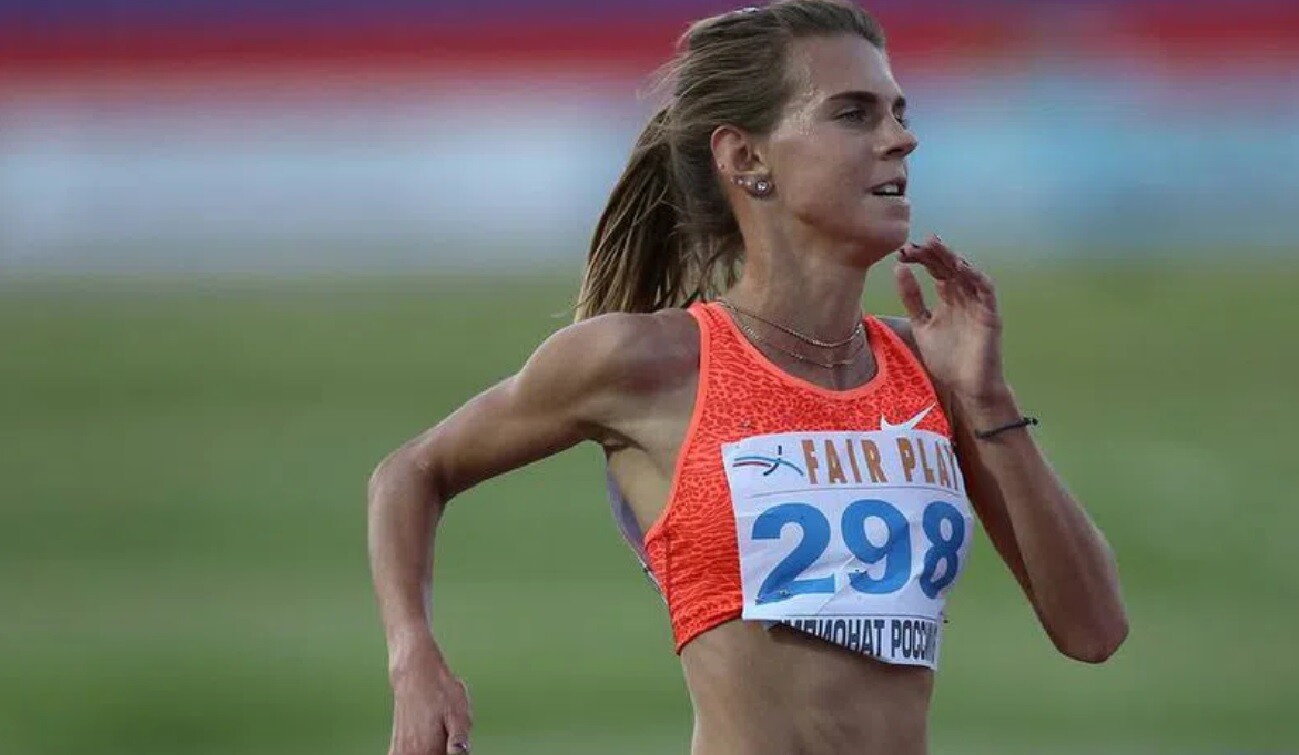
In addition to the penalty, which expires on September 26, 2027, Yelena Korobkina’s results between July 2, 2013 and July 24, 2016 have been voided. Thus, the new European 3,000m champion for 2015 becomes Sviatlana Kudzelich from Belarus, but this has not yet been announced by the international federation.
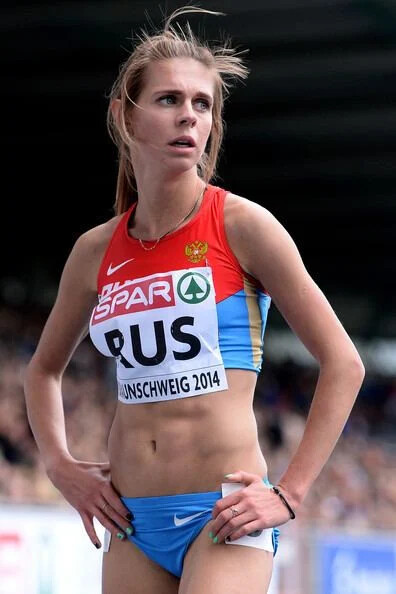
The CAS decision most likely officially ends the career of Yelena Korobkina, who is already 32 years old.
Yelena Korobkina is a Russian distance runner who competes in events from 1,500m to 10,000m. She won the silver medal in the 1,500m at the 2013 Summer Universiade in Kazan.
(10/10/2023) ⚡AMPby Eli Semkova
Kenyans Mathew Kiplagat and Beatrice Toroitich won the 40th edition of the Wizz Air Sofia Marathon
Kenya’s Mathew Kiplagat won the 40th edition of the Wizz Air Sofia Marathon held on Sunday (08) in Sofia, Bulgaria
The 35 year-old took the honors in a new personal best time of 2:12.12 and was followed a distant later in second by Ethiopia’s Alem Niguse in 2:14.31 with Chakib Latrache from Morocco wrapping up the podium three finishes 2:15.43.
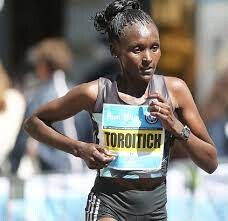
Kenya’s Hosea Kipkemboi, France’s Alaa Hrioued and Duncan Koech also from Kenya finished in fourth, fifth and sixth place in respective time of 2:21.36, 2:22.06 and 2:22.10.
Kenya’s Beatrice Toroitich won the women’s marathon title at the 40th edition of the Sofia Marathon held on Sunday (08) in Sofia, Bulgaria.
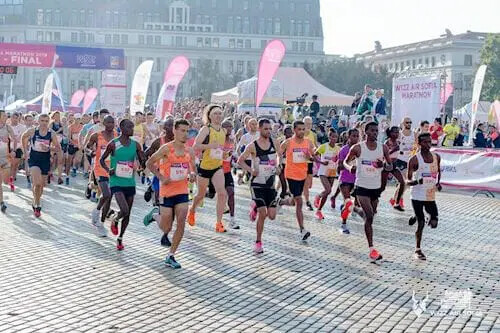
The 41 year-old took the honors in 2:38.26 and was followed by Bulgaria’s Marinela Ninova in second place in 2:41.02 with her compatriot Hellen Kimutai sealing the podium three finishes in a time of 2:49.07.
Gladys Biwott from Kenya and Ethiopia’s Sintayeho Kibebo finished in fourth and fifth in respective time of 2:51.43 and 2:55.58.
(10/09/2023) ⚡AMPby John Vaselyne
Wizz air Sofia Marathon
The home of Sofia Marathon was founded thousands of years ago and today it continues to develop as the country’s cultural and economic centre. Sofia is Bulgaria’s capital and one of the oldest capitals in Eastern Europe.Sofia has been settled for many millennia. In honour of its hot springs, which you should visit after running the marathon in Sofia, in...
more...Annie Rodenfels Wins Boston 10k For Women
The 47th running of the Boston 10K for Women, presented by REI, returned to the Boston Common and the streets of Boston and Cambridge on Saturday.
Over 4,000 women participated in the autumn classic, which began at 8:50 a.m. for handcycle and wheelchair participants and at 9 a.m. for all runners.
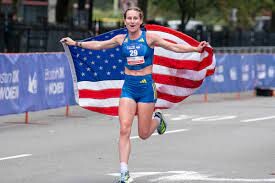
Formerly known as the Tufts Health Plan 10K for Women, the race is New England's largest all-women's sporting event.
The 6.2-mile course brings runs through Boston’s Back Bay and into Cambridge and finishes on Charles Street between the Public Garden and Boston Common.
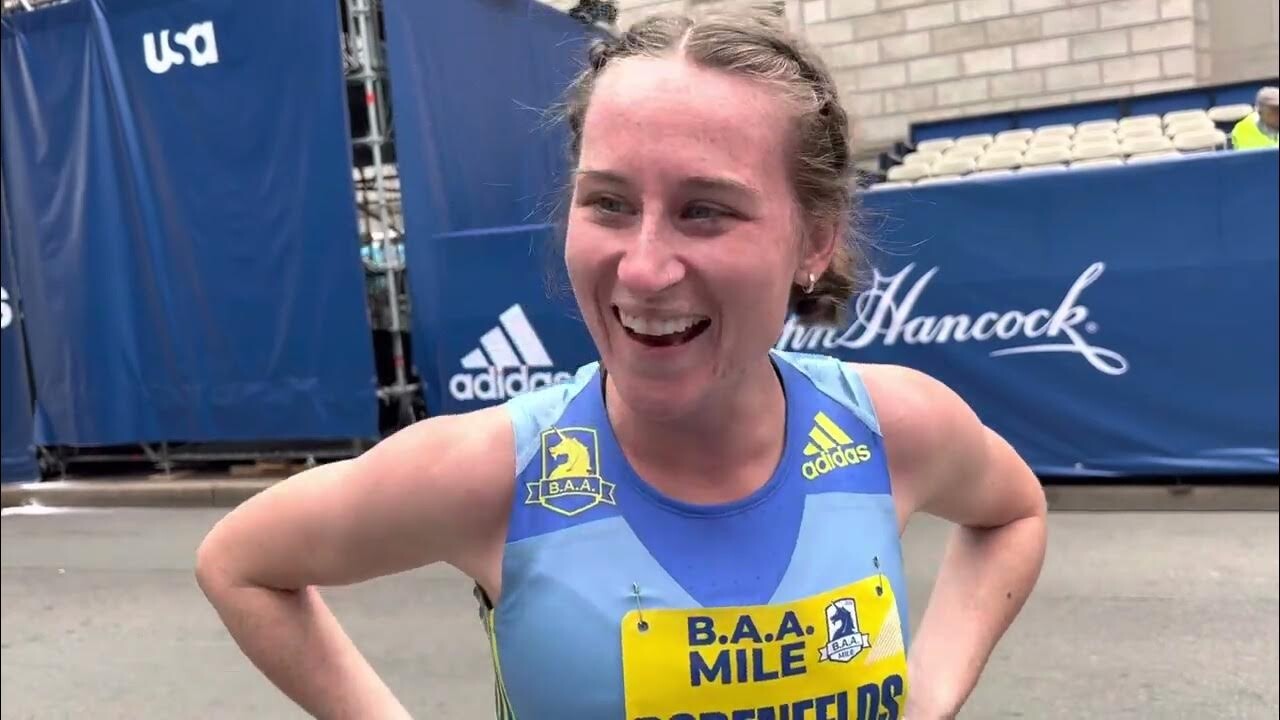
This year's race was won by Annie Rodenfels, who broke the tape in her 10K debut in a time of 32:08. She was followed by Emily Venters with a time of 32:31 and Jenny Simpson at 32:39.
A Boston resident, Rodenfels surged on the Massachusetts Avenue bridge and ran uncontested through the last mile until the Charles Street finish line.
“I thought I would sit back and wait and out-kick them at the end, like -- their mistake if they leave me until the end -- because besides maybe Jenny Simpson I think I’ve probably got the best kick in the field,” Rodenfels said afterward, with an American flag draped around her shoulders. “But I just felt too good, I figured I’d just go for it. What do I have to lose?”
For Rodenfels, who trains along the banks of the Charles River, the familiarity aided her approach in the new distance.
“I like the course a lot – I love running in Boston, I feel like I can have a mediocre year the rest of the year and then when I get a race in Boston, I knock it out of the park. I feel like I get more cheers because I am from around here,” said Rodenfels, who earned $9,000 with the victory.
Winning the Masters Division and finishing 11th overall was Sara Hall, who clocked a 33:19. Fourteen-year-old Madelyn Wilson won the wheelchair division in a time of 35:50, racing for the first time in a larger chair.
(10/09/2023) ⚡AMP
Boston 10K for Women
The Boston 10K for Women, formerly known as the Tufts Health Plan 10K for Women and the Bonne Bell Mini Marathon, is a major 10K held annually in Boston, on Columbus Day, popular as both an elite world-class competition and a women's running event promoting health and fitness. Feel the empowerment as you unite with over 7,000 fellow runners...
more...Lessons from the long run: with Kipyegon, Kipchoge and Sang
The long run, for elite and amateurs alike, forms an integral part of distance runners’ training.
In the west of Kenya, 20km to the south-east of Eldoret, that weekly ritual takes place early on a Thursday morning.
At 6am sharp the first runners make their way out of the gates of the Global Sports Communications Camp in Kaptagat to join some local runners who will try to keep them company.
In the pitch-black late June morning, the runners have already woken up half an hour or so before to get dressed, take some sips of water and go to the toilet.
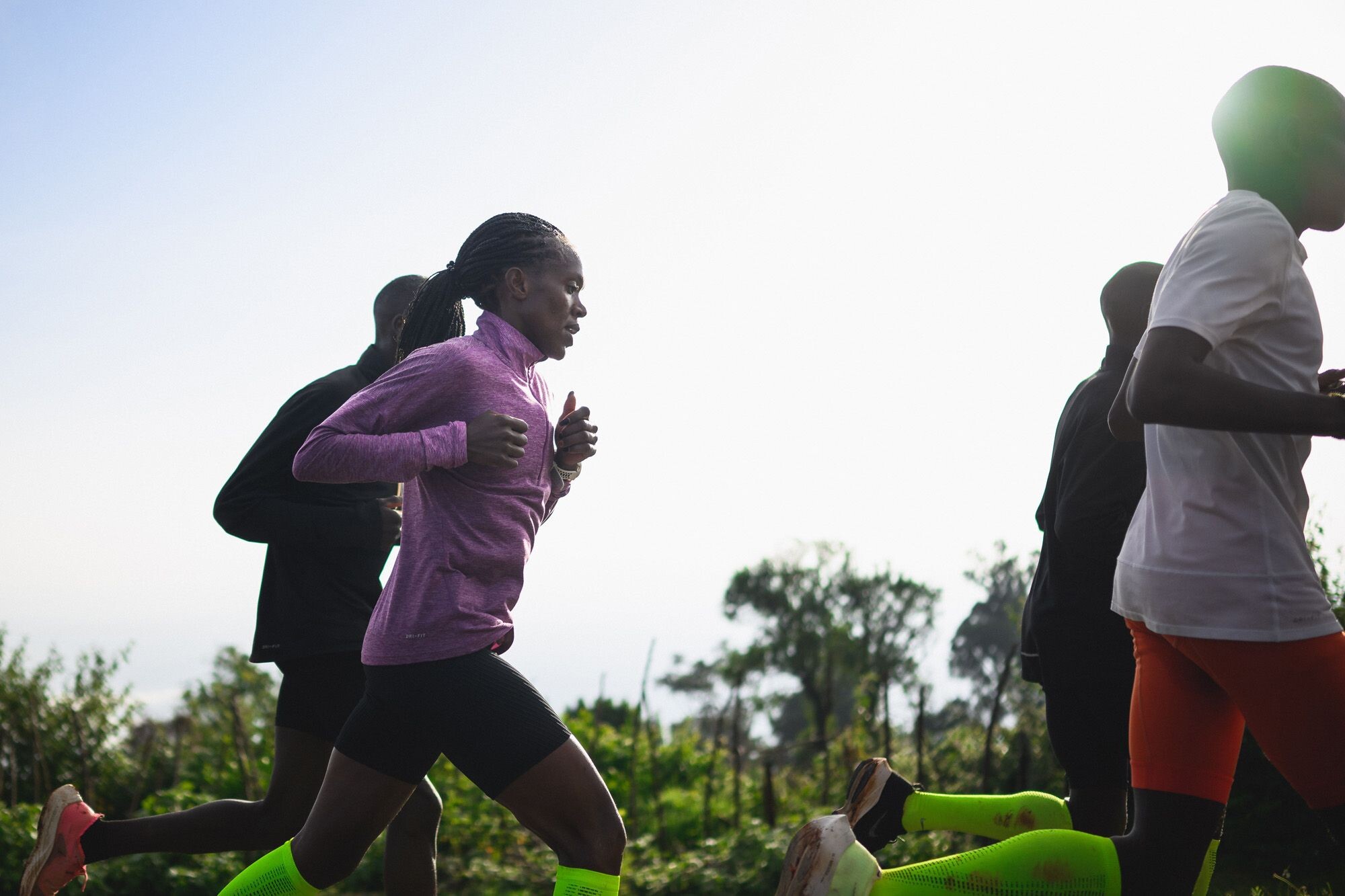
The 30 or so athletes do not eat beforehand. They have determined that there are benefits to running fasted, the most prominent being training your body to get better accustomed to taking energy from your body’s fat reserves, something that may be important when carbohydrates sources are depleted towards the end of a marathon.
Of course, these are experienced athletes. For the double Olympic champion making his way to the group, he has spent 20 years building up and adapting his body to such challenges.
What is possible for Eliud Kipchoge would be simply unsustainable, and even ill-advised, for athletes new to the sport.
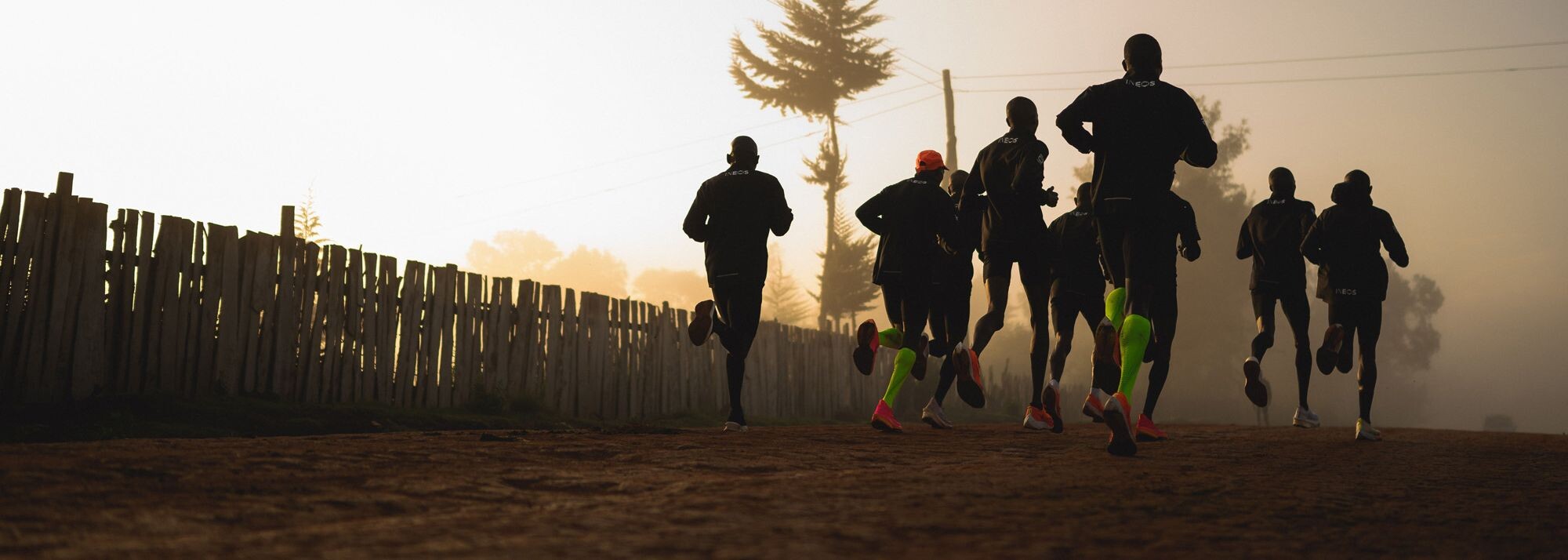
This particular morning, coach Patrick Sang has assigned the ‘Boston loop’ – an undulating route with far more elevation than its namesake marathon, eventually finishing high on the escarpment a few hundred meters higher than the 2200m starting elevation at Kaptagat.
For the Global Sports group, it is simply 40km straight out; the minibuses and pick-up trucks following them picking them up after to drive them home.
Most of Sang’s athletes training for an autumn marathon are expected to complete the full distance, among them three-time world cross-country champion Geoffrey Kamworor, fellow 2:04 marathon-man Kaan Kigen Özbilen, Kipchoge and a collection of five others all boasting either sub-60-minute half marathon or sub-2:07 marathon bests.
World and Olympic medalist Linet Masai and 2:20 marathon runner Selly Chepyego, setting off 15 minutes beforehand, have also been set that distance goal.
For world and Olympic champion and multiple world record-holder Faith Kipyegon, today’s task is 30km. Despite being on the longer end of what might be expected from a 1500m runner, Kipyegon is insistent that this run is her favorite type of training.
It may also be some indication of the strength shown in her 5000m world record in Paris.
Sang’s final instructions are minimal. He does not prescribe paces, simply asking that his athletes set an honest pace, go on how they feel and try if possible to pick up the pace towards the end of their run.
The early footsteps are on a dirt road, the group paying attention to where their marathon-specific shoes land and running in silence. Information about tree routes or dips in the road is often communicated via hand signals pointing to the hazard.
From the off, the going is uphill and within 10km the group is receiving the first of their carbohydrate drinks being passed from the pick-up truck following them.
After 15km the group hits the first of the tarmac roads of the C51 and the pace then starts to rise, slowly and subtly.
As they do, they gradually catch the groups ahead of them.
Geoffrey Kirui, the 2017 world marathon champion, has been told to run by himself as he is returning from an injury. Sang has intentionally encouraged Kirui not to fall into the usual pitfalls of over-exerting himself to go with a group.
Likewise Daniel Mateiko – the ninth fastest half-marathon runner in history, boasting a 58:26 best – was told to set off a few minutes before and will then join the group up to about the 35km marker. Still only 24 years of age and racing over a shorter distance, Mateiko’s training has its own minimal differences with the shorter-distance athletes generally doing shorter long runs.
Throughout the run, Sang will come alongside in the pick-up, judging his athletes’ efforts from the way they run. He later tells us he can notice minor indications from the way they land their feet on whether recent training has taken its toll.
Little advice is given; those he coaches have done this route many times before. More welcome instead are the drinks passed around every 5km or so. The group stays intact for almost 30km before it slowly fragments, Sang encouraging his athletes to sustainably push their effort over the final kilometers.
Kipyegon herself is nearing the end of her run, gradually progressing throughout the 30km but not pushing herself to the point of depletion.
Unfortunately for her, the moment her watch completes the distance, a few minutes over two hours after she began, is almost the highest point the group will reach that day.
She stops, jogs slowly for a few hundred meters before jumping in the van.
About a litre of carbohydrate drinks consumed after her run, she will not eat until an hour or so later when the whole group returns to the camp.
A long line of runners scattered along the road has yielded to a few isolated pockets completing the full distance and the leading group has whittled down to four.
Though interspersed with steady rises, the final five kilometers are slightly downhill. Kipchoge, Özbilen, Laban Korir and Hillary Kipchirchir run four abreast, completing these last kilometers in a few seconds inside 15 minutes.
Two hours 22 minutes after they started, they finish their undulating 40km with over 500m of elevation at a pace about 30 minutes slower than their best marathon times. It is an effort they might refer to as ‘steady’ and one in the midst of a typical 220km training week.
Like Kipyegon, they consume about a litre of drink as they get in the vans and make the 40-minute journey home, eating a nutritionally simple meal of beans, ugali, vegetables and some protein upon their return.
Their reward? A rare afternoon without another run, some sleep and a lighter Friday of two short easy runs.
A similar routine in a different setting to runners throughout the world, there are morsels of lessons for the everyday runner.
Progress sustainably, hydrate appropriately and perhaps trust your effort over your watch.
(10/09/2023) ⚡AMPby George Mallett for World Athletics
Three progression workouts to transform your training
If you have ever started off strong on race day but found yourself falling apart at the closing stages, a progression run may be the ticket to elevating your performance. In a traditional progression run, a runner starts at an easy pace and gradually increases their speed throughout the run, finishing faster than they began. The progression training session aims to train the body to run efficiently, and to build endurance while gradually increasing the effort level.
Progression workouts are versatile and fun to switch up: run them by pace or by Rate of Perceived Exertion (RPE), on trails or on roads, and adjust the distance and time to suit any goals.
Because your body is properly warmed up in a progression session before you begin any tough effort, you have a lower risk of injury than in many other hard-and-fast traditional speed workouts. You’ll also recover more quickly from a progression session than you would with faster-paced intervals. We have three progression workouts you can slide into your training schedule this week–you’ll reap the rewards with tireless legs next race.

For all of these workouts, make sure to use the beginning of the run as your warm up, taking it very slow and easy.
1.- Thirds progression run
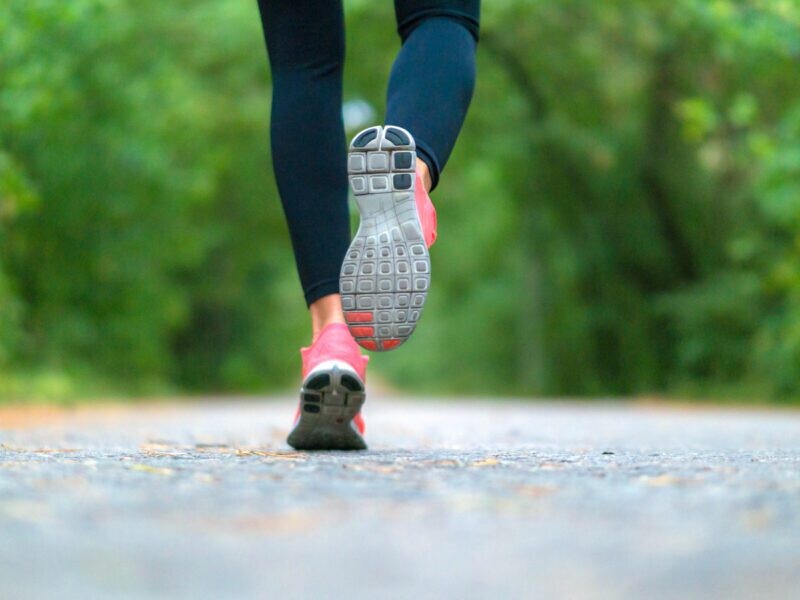
A thirds progression run gives your aerobic capacity a boost while you practice managing steady pacing, and simulates using discipline during the initial stages of a race.
For this workout, break up your run into three equal parts. It doesn’t matter whether you train using distance or time; split the total up accordingly.
Begin running at an easy pace and gradually speed up as you enter the next third of your run. Make sure your speed changes are slight and not abrupt: each pace should feel sustainable.
If your progression run is scheduled for 60 minutes, run the first 20 minutes at an easy pace, the next 20 minutes at a race pace, and the last 20 minutes at a pace that is 10 seconds faster than your race pace.
Cool down with five minutes of very easy running.
2.- Fast finish progression run
Finishing a progression run quickly will help you crush that fast race-day kick. This workout is the perfect way to push mind and body to simulate racing conditions, without overtaxing yourself, and needing extra recovery time.
Start out at an easy pace or effort and extend that throughout most of this session, leaving only four to six minutes at the end for your hard effort. The final few minutes of this workout should be a much harder effort than in your other progression runs because the fast running time is much more limited.
Think of your 5K race pace or effort for the last section.
Cool down with five to 10 minutes of very easy running.
3.- Fast finish progression run
Finishing a progression run quickly will help you crush that fast race-day kick. This workout is the perfect way to push mind and body to simulate racing conditions, without overtaxing yourself, and needing extra recovery time.
Start out at an easy pace or effort and extend that throughout most of this session, leaving only four to six minutes at the end for your hard effort. The final few minutes of this workout should be a much harder effort than in your other progression runs because the fast running time is much more limited.
Think of your 5K race pace or effort for the last section.
Cool down with five to 10 minutes of very easy running.
(10/09/2023) ⚡AMPby Keeley Milne
Two American men achieve the Olympic standard at Chicago Marathon
The American contingent was led by Conner Mantz, who finished sixth overall and ran a personal best of 2:07:47. His former BYU teammate Clayton Young placed seventh in 2:08:00. Both athletes dipped under the Olympic qualifying standard of 2:08:10.
Running his first marathon since the 2022 World Athletics Championships in Eugene, Oregon, Galen Rupp finished eighth in 2:08:48.
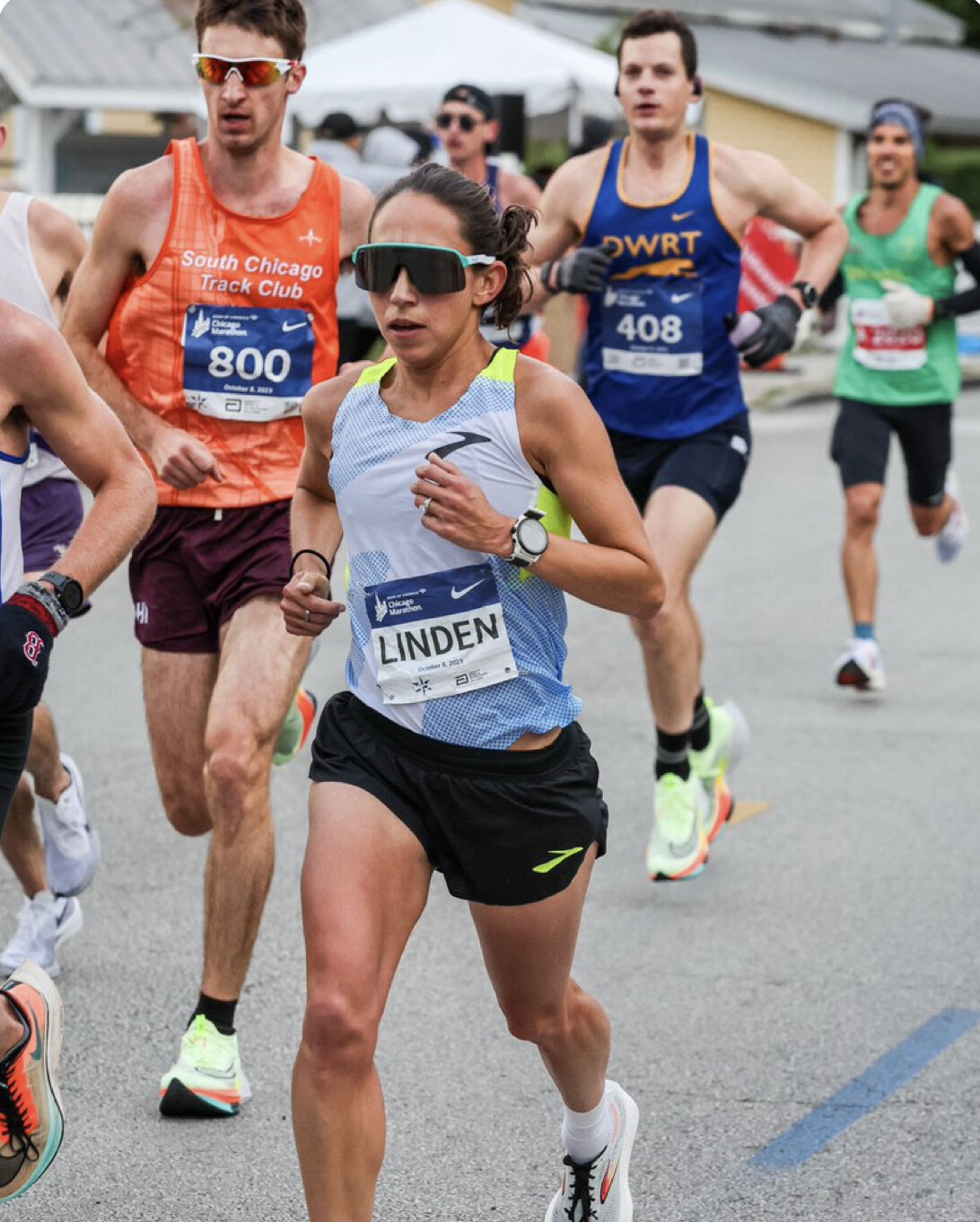
Three American women crack the top 10
A year after breaking the national record in Chicago, Emily Sisson returned as the top American with a seventh-place finish in 2:22:09. Olympic bronze medalist Molly Seidel finished eighth overall in 2:23:07, and Sara Vaughn placed 10th in 2:23:24.
After turning 40 in July, Des Linden broke the American masters record by running 2:27:35, beating the previous record (2:27:47) set by Deena Kastor.
(10/09/2023) ⚡AMPBank of America Chicago
Running the Bank of America Chicago Marathon is the pinnacle of achievement for elite athletes and everyday runners alike. On race day, runners from all 50 states and more than 100 countries will set out to accomplish a personal dream by reaching the finish line in Grant Park. The Bank of America Chicago Marathon is known for its flat and...
more...Kiptum smashes world marathon record with 2:00:35, Hassan runs 2:13:44 in Chicago
Kenya’s Kelvin Kiptum became the first athlete to break 2:01 in a record-eligible marathon, clocking a tremendous 2:00:35* to take 34 seconds off the world record at the Bank of America Chicago Marathon on Sunday (8).
On a remarkable day of racing, Dutch star Sifan Hassan moved to No.2 on the women’s all-time list, running 2:13:44 to triumph in the World Athletics Platinum Label road race. The only woman to have ever gone faster is Ethiopia’s Tigist Assefa, who set a world record of 2:11:53 to win the BMW Berlin Marathon last month.
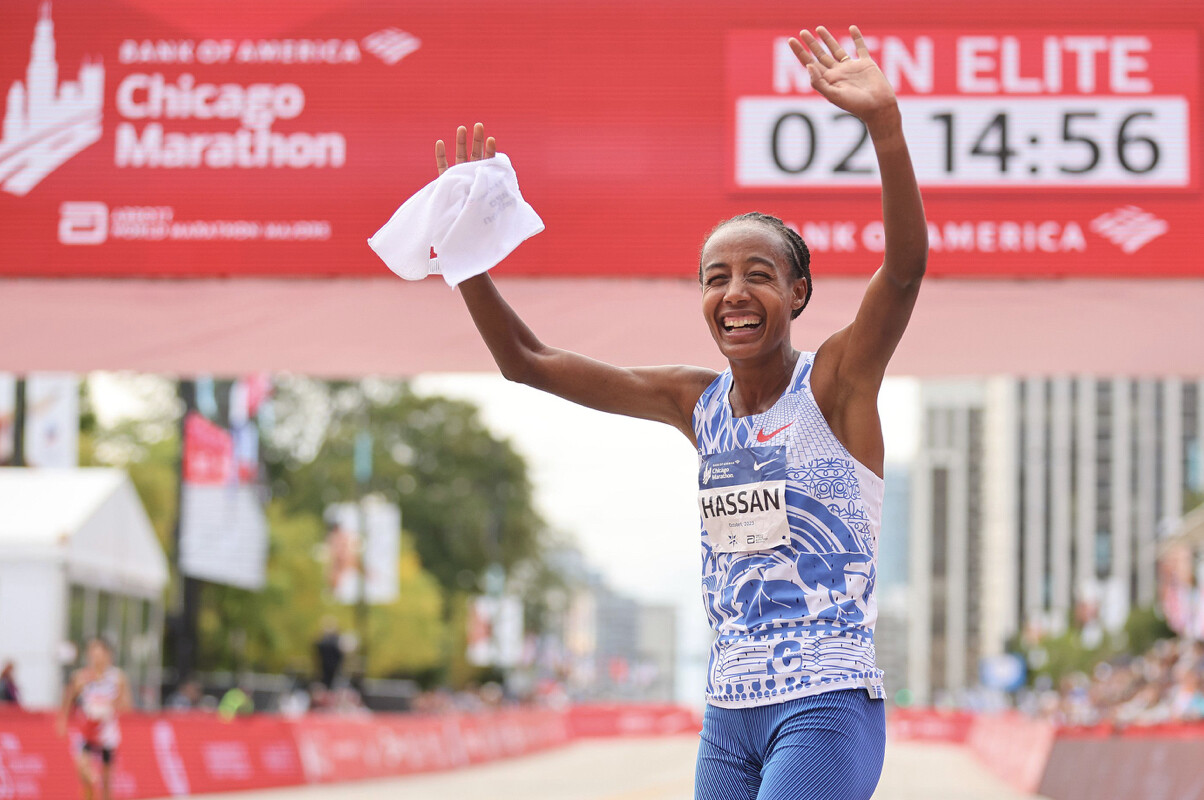
Less than six months on from his 2:01:25 London Marathon win, which saw him become the second-fastest marathon runner of all time, Kiptum improved by another 50 seconds to surpass the world record mark of 2:01:09 set by his compatriot Eliud Kipchoge in Berlin last year.
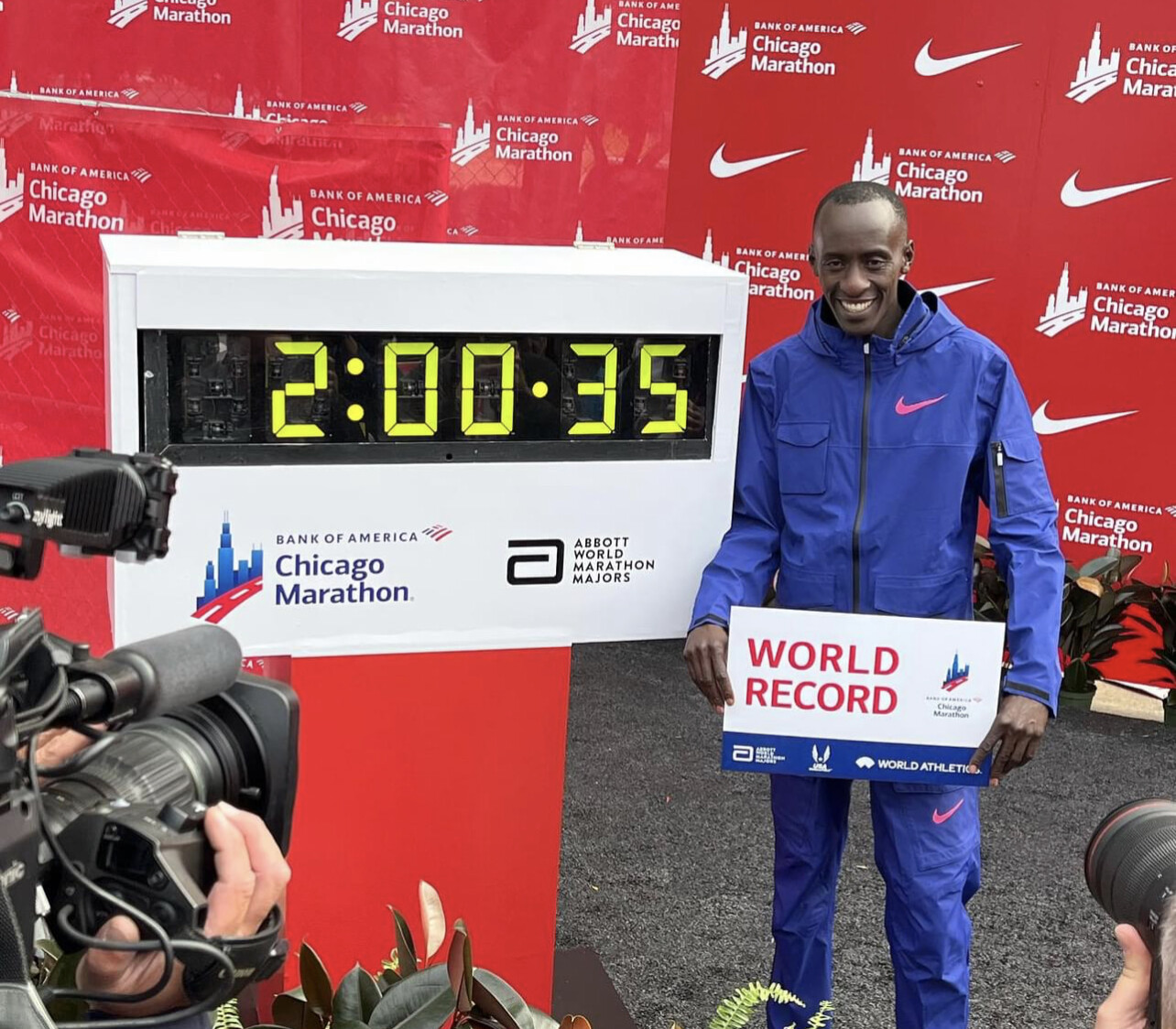
In the third marathon of his career, which began with a 2:01:53 debut in Valencia last December, Kiptum even had enough energy to celebrate his historic performance on the way to the finish line – pointing to the crowds and the tape on his approach.
The 23-year-old broke that tape in 2:00:35, winning the race by almost three and a half minutes. Defending champion Benson Kipruto was second in 2:04:02 and Bashir Abdi was third in 2:04:32.
Kiptum pushed the pace throughout the 26.2-mile race. He broke away from a seven-strong lead group after reaching 5km in 14:26, joined only by his compatriot Daniel Mateiko, who was making his marathon debut. They were on world record pace at 10km, passed in 28:42, but the tempo dropped a little from that point and they reached half way in 1:00:48.
Kiptum had been running in a hat but that came off as they entered the second half of the race. After 30km was passed in 1:26:31, Kiptum kicked and dropped Mateiko. He was glancing over his shoulder but running like he still had the world record – not only the win – in his sights.
A blistering 5km split of 13:51 took him to the 35km checkpoint in 1:40:22 and he was on sub-2:01 pace, 49 seconds ahead of Mateiko.
Continuing to run with urgency, he passed 40km in 1:54:23 – after a 27:52 10km split – and sped up further, storming over the finish line with the incredible figures of 2:00:35 on the clock.
"I knew I was coming for a course record, but a world record – I am so happy,” he said. “A world record was not on my mind today, but I knew one day I would be a world record-holder.”
Despite only having made his marathon debut 10 months ago, Kiptum now has three of the six fastest times in history to his name. Only Kipchoge (with 2:01:09 and 2:01:39) and Kenenisa Bekele (with 2:01:41) have ever gone faster than the slowest of Kiptum’s times.
Mateiko had helped to pace Kiptum to his 2:01:25 win in London, running to the 30km mark. The pair stayed together until that point in Chicago, too, but Mateiko couldn’t maintain the pace and dropped out after reaching 35km in 1:41:11.
Kenya’s Kipruto used his experience of the course to leave the chase group behind after 35km and was a comfortable runner-up in 2:04:02, finishing half a minute ahead of Belgium’s world and Olympic bronze medallist Abdi.
Kenya’s John Korir was fourth in 2:05:09, Ethiopia’s Seifu Tura fifth in 2:05:29 and USA’s Conner Mantz sixth in 2:07:47.
In the women’s race, Hassan returned to marathon action just six weeks on from a World Championships track medal double that saw her claim 1500m bronze and 5000m silver in Budapest.
She was up against a field including the defending champion Ruth Chepngetich of Kenya, who was on the hunt for a record third win in Chicago following her 2:14:18 victory last year.
It soon became apparent that it would be those two athletes challenging for the title. After going through 5km in 15:42 as part of a pack that also featured Kenya’s Joyciline Jepkosgei and Ethiopia’s Megertu Alemu and Ababel Yeshaneh, Chepngetich and Hassan broke away with a next 5km split of 15:23 and reached 10km in 31:05 – on pace to break the recently-set world record.
They ran a 10km split of 30:54 between 5km and 15km, that point passed in 46:36, and they maintained that world record pace to 20km, reached in 1:02:14.
Chepngetich had opened up a six-second gap by half way, clocking 1:05:42 to Hassan’s 1:05:48, but Hassan would have surely felt no concern. On her debut in London in April, after all, she closed a 25-second gap on the leaders despite stopping to stretch twice, and went on to win in 2:18:33.
In a race of superb depth, Alemu, Jepkosgei and Yeshaneh were still on 2:14:52 pace at that point as they hit half way together in 1:07:26.
Hassan soon rejoined Chepngetich at the front and they ran side by side through 25km in 1:18:06. Then it was Hassan’s turn to make a move. Unable to maintain the pace, Chepngetich had dropped 10 seconds behind by 30km, reached by Hassan in 1:34:00, and from there the win never looked in doubt. The Dutch athlete was half a minute ahead at 35km (1:50:17) and she had more than doubled that lead by 40km (2:06:36).
Hassan was on track to obliterate her PB and also the course record of 2:14:04 set by Brigid Kosgei in 2019, which had been the world record until Assefa’s 2:11:53 performance last month.
She held on to cross the finish line in 2:13:44, a European record by almost two minutes. With her latest performance, the versatile Hassan is now the second-fastest woman in history for the track mile, 10,000m and marathon.
"The first group took off at a crazy pace, but I wanted to join that group,” said Hassan. “The last five kilometres, I suffered. Wow – I won again in my second marathon in a fantastic time. I couldn't be happier.”
Behind her, Chepngetich held on for second place in 2:15:37 as the top four all finished under 2:18 – Alemu placing third in 2:17:09 and Jepkosgei finishing fourth in 2:17:23. Ethiopia’s Tadu Teshome was fifth in 2:20:04, her compatriot Genzebe Dibaba sixth in 2:21.47 and USA’s Emily Sisson seventh in 2:22:09.
Leading results
Women1 Sifan Hassan (NED) 2:13:44 2. Ruth Chepngetich (KEN) 2:15:37 3. Megertu Alemu (ETH) 2:17:09 4. Joyciline Jepkosgei (KEN) 2:17:235 Tadu Teshome (ETH) 2:20:046 Genzebe Dibaba (ETH) 2:21:477 Emily Sisson (USA) 2:22:098 Molly Seidel (USA) 2:23:079 Rose Harvey (GBR) 2:23:2110 Sara Vaughn (USA) 2:23:24
Men1 Kelvin Kiptum (KEN) 2:00:352 Benson Kipruto (KEN) 2:04:023 Bashir Abdi (BEL) 2:04:324 John Korir (KEN) 2:05:095 Seifu Tura (ETH) 2:05:296 Conner Mantz (USA) 2:07:477 Clayton Young (USA) 2:08:008 Galen Rupp (USA) 2:08:489 Samuel Chelanga (USA) 2:08:5010 Takashi Ichida (JPN) 2:08:57
(10/08/2023) ⚡AMPby World Athletics
Bank of America Chicago
Running the Bank of America Chicago Marathon is the pinnacle of achievement for elite athletes and everyday runners alike. On race day, runners from all 50 states and more than 100 countries will set out to accomplish a personal dream by reaching the finish line in Grant Park. The Bank of America Chicago Marathon is known for its flat and...
more...Kenyans Bernard Muia and Catherine Cherotich take eventful races in Munich
An eventful GENERALI MUNICH MARATHON produced a Kenyan double triumph on Sunday. In fine weather conditions Bernard Muia clocked 2:09:17. This is the second fastest winning time in the history of the race which saw its 37th edition. Catherine Cherotich took the women’s race crossing the finish line in the Munich Olympic Stadium in 2:31:34. Germany’s Sebastian Hendel was the fastest European runner in fifth place with a personal best of 2:10:14. However he missed the Olympic qualifying time of 2:08:10.
The men’s leading group passed the half way mark in 64:29, which was almost exactly the split time targeted. With less than ten kilometers to go Kenyans Bernard Muia and Benson Nzioki pushed the pace, breaking up the leading group. They covered the kilometre sections from 34 to 36k in 2:56, 2:58 and 2:53 and built a decisive lead. It was then Bernard Muia - a training partner of the World Half Marathon Championships’ bronze medallist Samwel Mailu - who left behind his compatriot in the final kilometre.
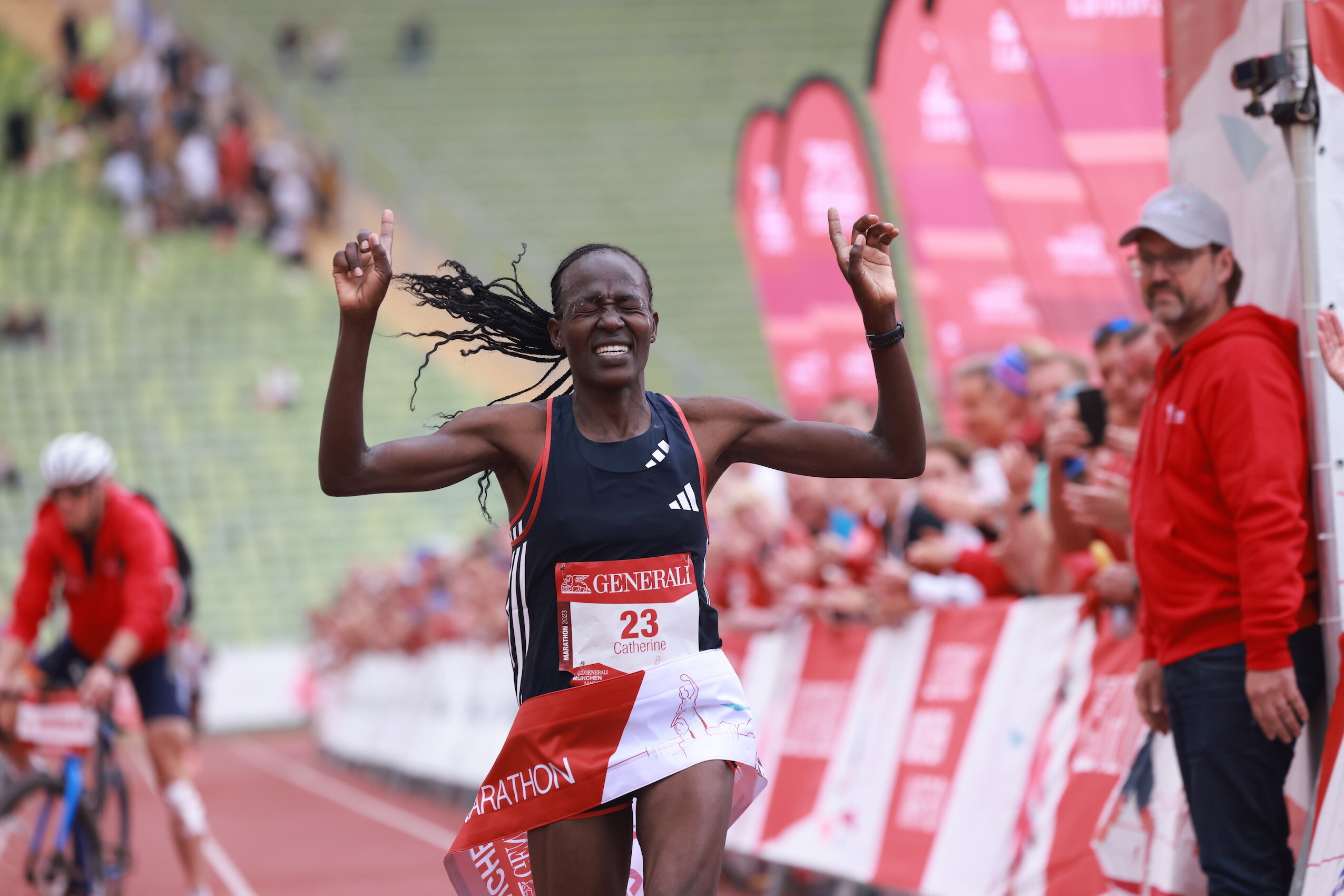
The 28 year-old was first over the line with 2:09:17 after he was added to the Munich elite field only on Tuesday. He had been training for a marathon and was accepted in Munich after an other athlete had to cancel his start. Marathon debutant Benson Nzioki took second in 2:09:12 while Mica Cheserek completed the Kenyan podium with 2:09:26.
The men’s leading group was unfortunate during the race when they missed a turn shortly before the 10k mark. The group had to turn around and lost about half a minute. „It is a pity that something like this has occurred, but unfortunately it can happen in a marathon. At least I know I am stronger than in 2022 and should be able to run sub 2:10 next time,“ said Sebastian Hendel, who ran 2:10:37 in Munich a year ago in his debut and now improved by 23 seconds.
The women had a major problem in this section of the course as well, when they were misguided and took the same turn too early. They were suddenly around 600 m short and their times would have been invalid. However organisers staged a unique rescue mission for these athletes by adding two laps for the affected runners in the Olympic Stadium before the finish.
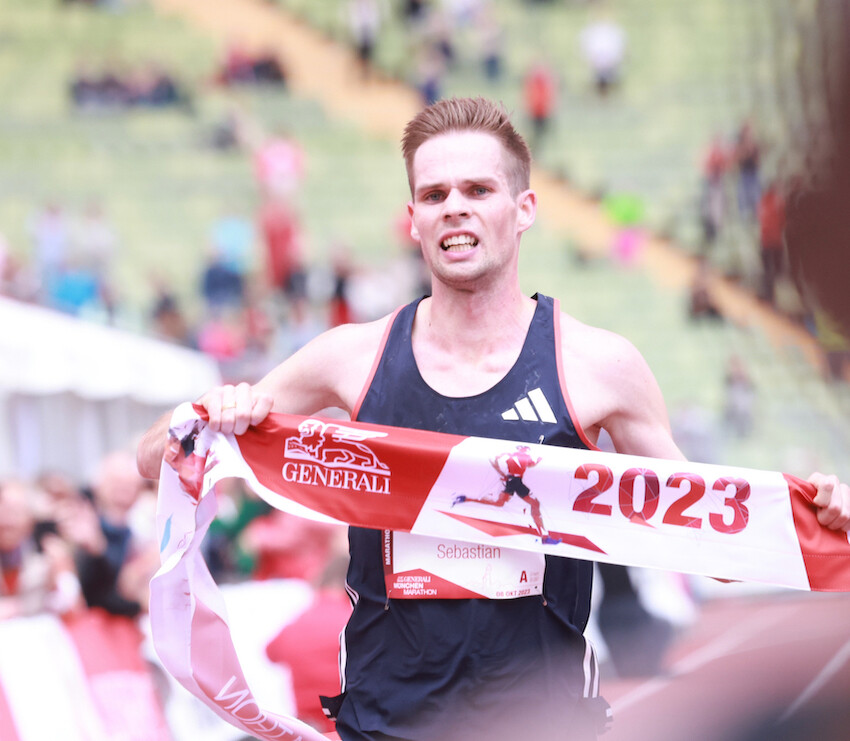
There was an all-Kenyan podium in the women’s race as well: Catherine Cherotich, who left behind Teclah Chebet just before the 30k mark, was the winner with 2:31:34. Chebet took second in 2:32:13 while Flomena Ngurasia followed in third with 2:33:17. "Of course I was very tired, but the spectators pushed me towards the finish line on these two laps in the stadium. The atmosphere was great,“ said 28 year-old Catherine Cherotich.
“I have never experienced anything like this in 23 years of organizing this race. I can not point the finger on anyone. The section of the course where they took the wrong turns contains major road works and it was all very confusing,“ said Race Director Gernot Weigl, who was still happy with the overall event: “We had thrilling races and there was a lot of excitement.“
A total of 21,647 runners from 87 nations entered the 37th edition of the GENERALI MUNICH MARATHON, including races at shorter distances. 5,210 of them were marathon runners, making the event the fourth biggest German marathon.
Results:
Men:
1 Bernard Muia KEN 2:09:17
2 Benson Nzioki KEN 2:09:21
3 Mica Cheserek KEN 2:09:26
4 Cosmas Kiplimo KEN 2:10:07
5 Sebastian Hendel GER 2:10:14
6 Amos Birgen KEN 2:11:15
7 Luke Kibet KEN 2:11:41
8 Merhawi Ghebreslasie FRA 2:17:33
Women:
1 Catherine Cherotich KEN 2:31:34
2 Teclah Chebet KEN 2:32:13
3 Flomena Ngurasia KEN 2:33:17
4 Caroline Chepkwony KEN 2:36:32
5 Beatrice Cheburet KEN 2:46:42
(10/08/2023) ⚡AMPGenerali Munich Marathon
The GENERALI MUNICH MARATHON has held the elite label of the WORLD ATHLETICS since 2020 and the marathon route is officially measured and recognized. The route runs from the Olympic Park and Schwabing to Leopoldstraße with the Siegestor, via Königsplatz and the Pinakotheken to the English Garden. From there past the Chinese Tower and Art Nouveau villas in Bogenhausen, through...
more...Daily Habits for Better Sleep
Reclaim your breath to strengthen your sleep routine
If you’re looking for the shortest path to better sleep, Patrick McKeown suggests starting at your nose. The sleep and breathing expert has authored four books, including bestseller The Oxygen Advantage, which shows the link between good breathing, good sleep, and good performance. His new Oxygen Advantage app functions as a virtual breathing instructor, with hundreds of tips and exercises designed to help you take control of your breathing and sleep better.
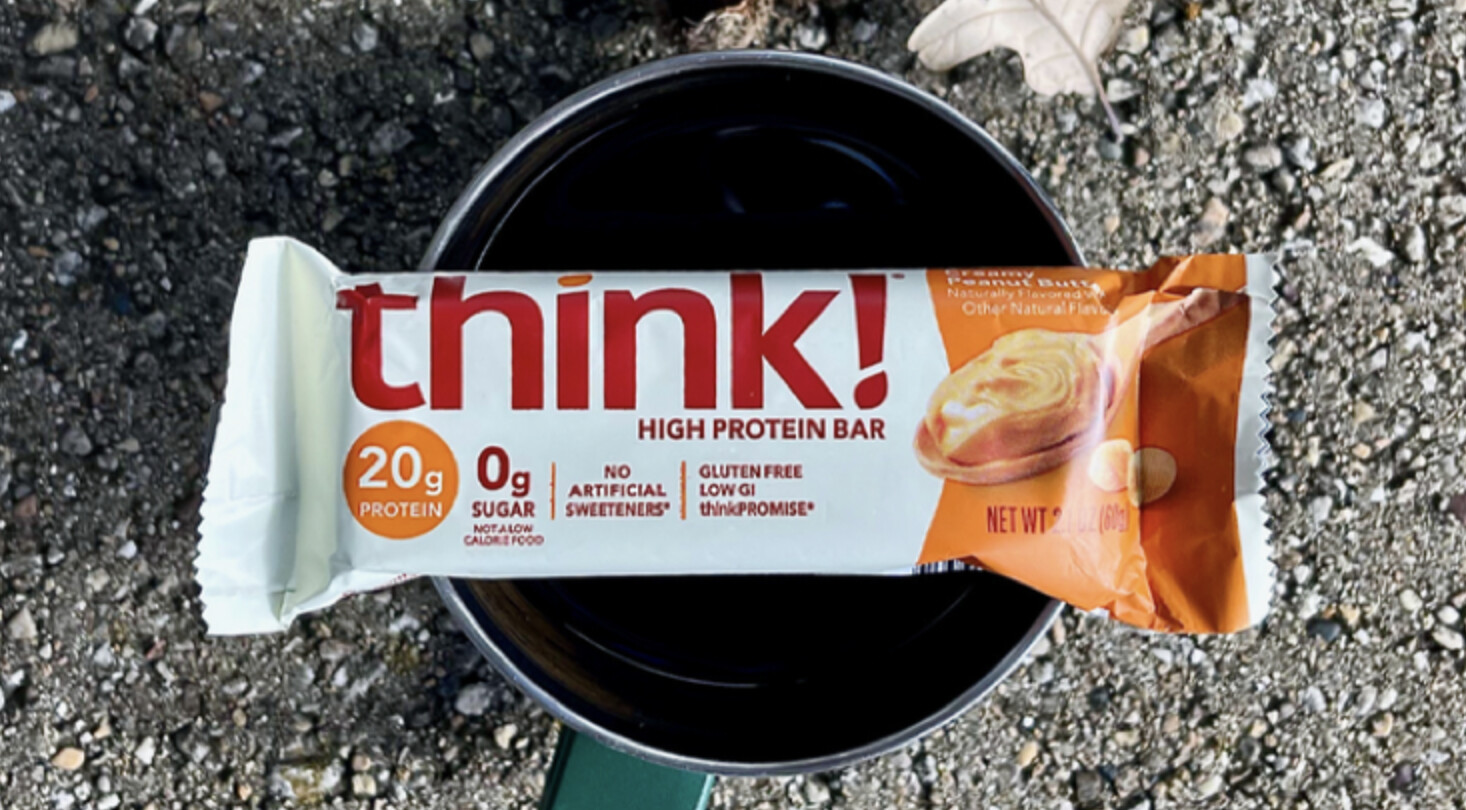
“Getting good sleep is important in every aspect of our lives,” McKeown says. “It affects cognition, mood, productivity, recovery from exercise, and more.”
Here are McKeown’s first sleep-strengthening steps to improve your waking performance. From there, check out a full 30 days of new tips for training well, eating well, living well, and feeling great. Lean into the daily guidance and grab a think! High Protein Bar to provide your body with delicious fuel to crush your goals. Each week adds up to a unique routine according to a different expert, with advice on improving everything from muscles and mobility to your mental state.
Multiple studies show a link between mouth breathing and poor sleep.
Nasal breathing enables you to spend more time in slow-wave deep sleep and less time in light sleep, but roughly half of the population breathes through their mouth while sleeping, according to McKeown. “How did you feel when you woke up this morning?” McKeown asks. “Did you feel totally refreshed? Did you have energy throughout the day? That’s what it’s all about.”
Create good nighttime habits by breathing through your nose during the day; how you breathe during wakefulness can affect how you breathe during sleep. Starting the path toward nasal breathing is as simple as paying attention to your breathing during the day and actively trying to breathe more often through your nose.
This sounds like tough love, but sleeping an extra four hours on Saturday disrupts your sleep patterns and establishes bad sleep hygiene. “It’s like jet lag,” McKeown says. “It throws off your schedule.” You’ll actually feel more refreshed if you skip your weekend slumberfest.
Establish a sleep/rise schedule and stick to it daily.
Do you have a treat-sneaking routine before bed? Or maybe you like a beer after dinner? If you’re having trouble sleeping, it’s time to refine the timing of your snacks. Grab a think! Chocolate Peanut Butter Pie protein bar earlier in the evening to stave off those late-night munchies. Eating late at night affects sleep quality, says McKeown, and alcohol has been proven to make people more restless at night.
“A lot of people, including myself, experience restless sleep if they eat too late, in theory because the body is metabolizing the food, which may affect sleep quality,” McKeown says. “We should wake up feeling hungry in the morning. After all, the word ‘breakfast’ literally means ‘break the fast.’”
As bedtimes and dinner times vary, there’s no hard-and-fast rule about when you should stop eating, so spend some time experimenting on your own. Try not snacking after dinner and see if that improves your sleep quality.
Calming down after a hectic day can be difficult, but slow, deep exhalations have been proven to activate the vagus nerve, which signals the brain to relax, enabling you to fall asleep easier. Try this simple breathing sequence to calm down before bedtime.
Slowly breathe in through your nose for several seconds, then exhale through your nose for several more seconds, slow and relaxed to the point where you begin to feel light air hunger—that stimulates the vagus nerve, slows the heart rate, and activates the rest response. Repeat the process for 10 minutes.
(10/08/2023) ⚡AMPby Outside Online
Molly Seidel Stunned the World (and Herself) with Olympic Bronze in Tokyo. Then Life Went Sideways.
She stunned the world (and herself) with Olympic bronze in Tokyo. Then life went sideways. How America’s unexpected marathon phenom is getting her body—and brain—back on track.
On a clear December night in 2019, Molly Seidel was at a rooftop holiday party in Boston, wearing a black velvet dress, doing what a lot of 25-year-olds do: passing a joint between friends, wondering what she was doing with her life.
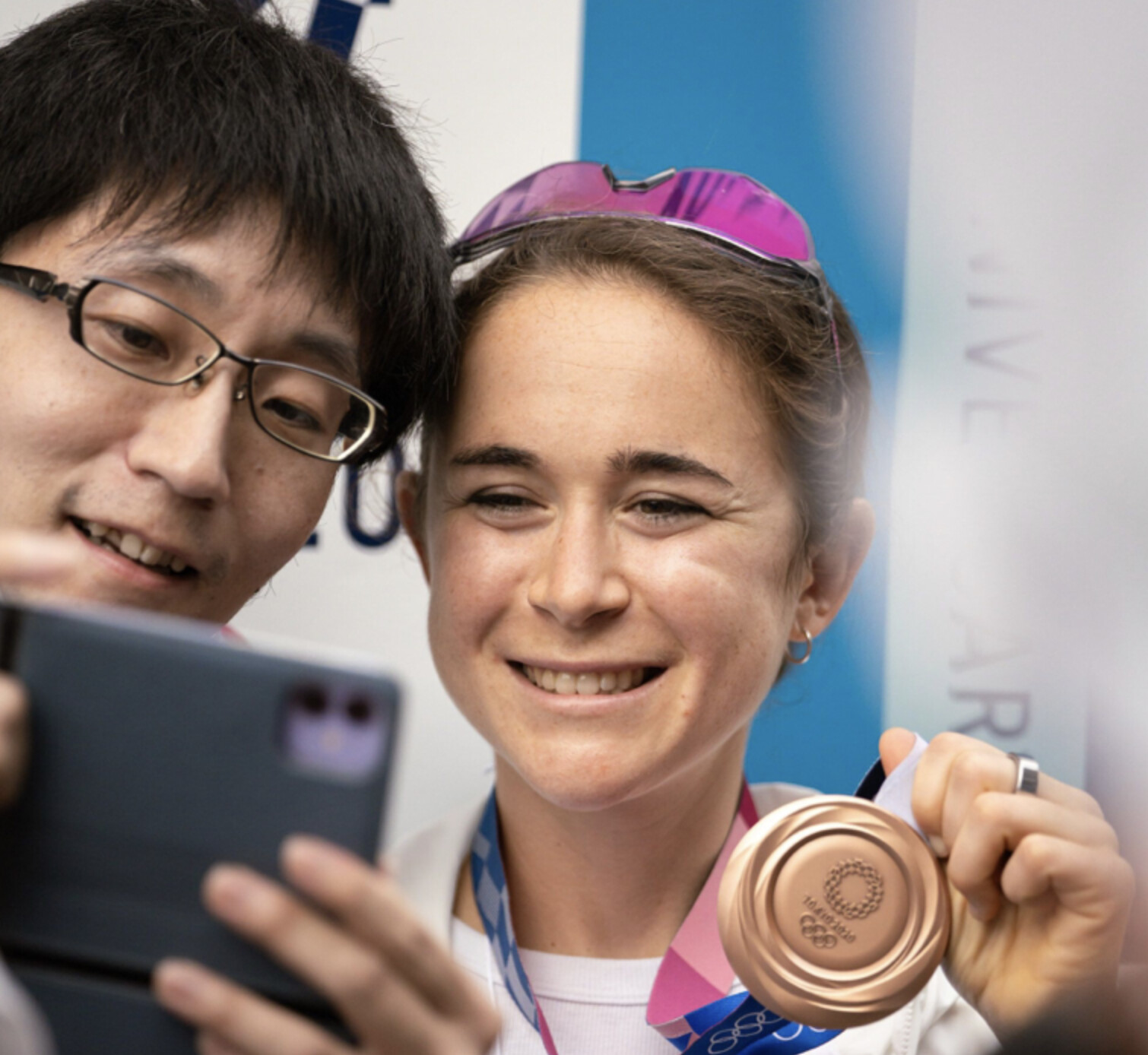
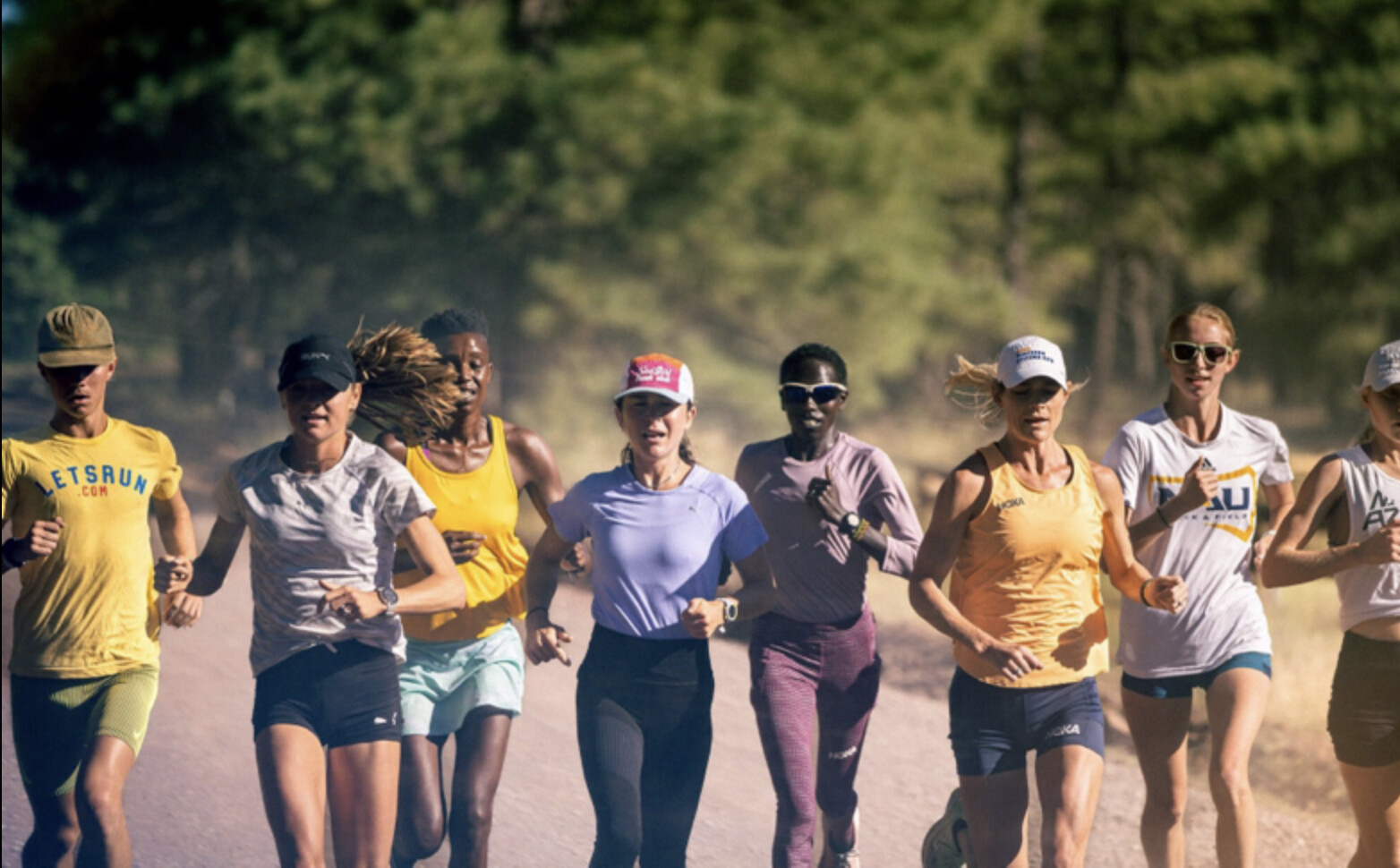
“You should run the Olympic Trials,” her sister, Izzy, said, as smoke swirled in the chilly air atop The Trackhouse, a retail shop and community hub on Newbury Street operated by the running brand Tracksmith. “That would be hilarious if you did that as your first marathon.”
Molly, an elite 10K racer who’d spent much of 2019 injured, looked out at the city lights, and laughed. Why the hell not? She’d just qualified for the trials, winning the San Antonio Half with a time of 1:10:27. (“The shock of the century,” as she’d put it.) True, 13.1 miles wasn’t 26.2—but running a marathon was something to do. If only because she never had before.
A four-time NCAA track and cross-country champion at The University of Notre Dame in Indiana, Molly had moved to Boston in 2017, where she’d worked three jobs to supplement her fourth: running for Saucony’s Freedom Track Club. The $34,000 a year that Saucony paid her (pre-tax, sans medical) didn’t go far in one of America’s most expensive cities. Chasing kids around as a babysitter, driving around as an Instacart shopper, and standing around eight hours a day as a barista—when you’re running 20 miles a day—wasn’t ideal. But whatever, she had compression socks. And she was downing free coffee and paying rent, flying to Flagstaff, Arizona, every so often for altitude camps, and having a good time. Doing what she loved. The only thing she’s ever wanted to do since she was a freckly fifth-grader in small-town Wisconsin clocking a six-minute mile in gym class.
“I was hustling, and I loved it. It was such a fun, cool time of my life,” she says, summarizing her 20s. Staring into Molly’s steely brown eyes, listening to her speak with such clarity and conviction about her struggles since, it’s easy to forget: She is still only 29.
After Molly had hip surgery on her birthday in July 2018, her doctors gave her a 50/50 chance of running professionally again. By summer 2019, she’d parted ways with FTC, which left her sobbing on the banks of the Charles River, getting eaten alive by mosquitoes and uncertainty. Her biggest achievement lately had been being named #2 Top Instacart Shopper (in Flagstaff; Boston was big-time).
The day after that rooftop party, Molly asked her friend and former FTC teammate Jon Green, who she’d newly anointed as her coach: “Think I should run the marathon trials?” Sure, he shrugged. Nothing to lose. Maybe it’d help her train for the 10K, her best shot—they both thought—at making a U.S. Olympic team.
“I’m going to get my ass kicked six ways to Sunday!” she told the host of the podcast Running On Om six weeks before the trials in Atlanta.
Instead, on February 29, 2020, she kicked some herself. Pushing past 448 of the fastest, most-experienced women marathoners in the country, coming in second with a 2:27:31, earning more in prize money ($60,000) than she had in two years of racing—and a spot on the U.S. trio for the 2020 Tokyo Olympics, along with Kenyan-born superstars Aliphine Tuliamuk and Sally Kipyego. “I don’t know what’s happening right now!” Molly kept saying into TV cameras, wrapped in an American flag, as stunned as a lottery winner.
Saucony who? Puma came calling. Along with something Molly hadn’t anticipated: the spotlight. An onslaught of social media followers. And two weeks later, a global pandemic and lockdown—and all the anxiety and isolation that came with it. She was drowning, and she hadn’t even landed in Tokyo yet.
The 2020 Olympics, as we all know, were postponed to 2021. An emotional burden but a physical boon for Molly, in that it allowed her to get in a second marathon. In London, she finished two minutes faster than her debut. When the Olympics finally rolled around, she was ready.
Before the race, Molly says, “I was thinking: ‘Once I cross the starting line, I get to call myself an Olympian and that’s a win for the day.’”
But then she crossed the finish line—with a finger-kiss to the sky and a guttural Yesss!—in third place with a 2:27:46, just 26 seconds behind first (Kenya’s Peres Jepchirchir). And realized: She gets to call herself an Olympic medalist forever. Only the third American woman to ever earn one in the marathon.
Lots of kids have fleeting hopes of making it to the Olympics. I remember thinking I could be Mary Lou Retton. Maybe FloJo, with shorter fingernails. Then I decided I’d rather be Madonna or president of the United States and promptly forgot about it. But Molly held tight to her Olympic aspirations. She still has a poster she made in 2004, with stickers and a snapshot of her smiley 10-year-old self, to prove it. “I wish I will make it into the Olympics and win a gold medal,” she wrote, and signed it: Molly Seidel, the “y” looping back to underline her name. In case there was any doubt as to who, specifically, would be winning the medal.
Molly grew up in Nashotah, Wisconsin, and is the eldest of three. Her sister and brother, younger by not quite two years, are twins. Izzy is a running influencer and corporate content creator for companies like Peloton; and Fritz favors Formula 1 racing and weightlifting and works for the family’s leather-tanning business. The family was active, sporty. Dad, Fritz Sr., was a ski racer in college; Mom, Anne, a cheerleader. You can tell. Watching clips of Molly’s mom and dad watching the Olympic race from their backyard patio, jumping up and down, tears streaming, is the kind of life-affirming moment you wish you could bottle. “I’m in shock. I’m in disbelief,” Molly says into the mic, beaming. “I just wanted to come out today and I don’t know…stick my nose where it didn’t belong and see what I could come away with. And I guess that’s a medal.” When the interviewer holds up her family on FaceTime, Molly breaks down. “We did it,” she says into the screen between sobs and smiles. “Please drink a beer for me.
Molly hasn’t always been unabashedly herself, even when everyone thought she was. A compartmentalizer to the core, she spent most of her life hiding a huge part of it: anorexia, bulimia, anxiety, obsessive-compulsive disorder, debilitating depression.
It started around age 11, when she learned to disguise OCD tendencies, like compulsively knocking on wood, silently reciting prayers “to avoid God getting mad at me,” she says. “It was a whole thing.” She says her parents were aware of the behaviors, but saw them more as odd little habits. “They had no reason to suspect anything. I was very high-functioning,” she says. “They didn’t realize that it was literally taking over my life.”
She wasn’t officially diagnosed with OCD until her freshman year of college, when she saw a therapist for the first time. At Notre Dame, disordered eating took hold, quietly yet visibly, as it does for up to 62 percent of female college athletes, according to the National Eating Disorders Association. As recently as the Tokyo Olympics, she was making herself throw up in the airport bathroom, mere days before taking the podium. Molly hesitates to share that detail; she fears a girl might read this and interpret it as behavior to model. “Having been in that place as a younger athlete, I know I would have,” she says. But she also understands: Most people just don’t get how unrelenting eating disorders can be.
In February 2022, she finally received a diagnosis of the root cause for all of it: ADHD. About being diagnosed, she says, “It made me feel really good, like [I don’t have] a million different disorders. I have a disorder that manifests itself in a lot of different symptoms.”
She waited to try Adderall until after the Boston Marathon in April, only to drop out at mile 16 due to a hip impingement. Initially, the meds made her feel fantastic. Focused. Free. Until she realized Adderall hurt more than it helped. She couldn’t sleep, couldn’t eat, lost too much weight. Within weeks, she devolved. “The eating disorder came roaring back,” she says, referring to it, as she often does, as its own entity, something that exists outside of herself. That ruthlessly takes control over her very need for control. “I almost think of it as an alter ego,” she explains. “Adderall was just bubblegum in the dam,” as she puts it. She ditched the drug, and her life—professionally, physically—unraveled.
In July 2022, heading into the World Championships, she bombed the mental health screening, answering the questions with brutal honesty. She’d been texting Keira D’Amato weeks prior. “Yo girl, things are pretty bad right now. Get ready…” Sobbing on the sidewalk in Eugene, Oregon, she texted D’Amato again. And the USATF made it official: D’Amato would take her spot on the team. Then Molly did what she’d been “putting off and putting off”— checked herself into eating disorder treatment for the second time since 2016, an outpatient program in Salt Lake City, where her new boyfriend was living at the time.
Somehow (see: expert compartmentalizer) mid-meltdown, in February 2022, she had met an amateur ultrarunner named Matt, on Hinge. A quiet, lanky photographer, he didn’t totally get what she did. “I didn’t understand the gravity of it,” he tells me. “I was like, Oh she’s a pro runner, that’s cool. I didn’t realize she was, like, the pro runner!”
Going back to treatment “was pretty terrible,” she says. At least she could stay with Matt. Hardly a honeymoon phase, but the new relationship held promise. “I laid it all out there,” says Molly. “And he was still here for it, for all the messiness. It was really meaningful.” And a mental shift. “He doesn’t see me as just Molly the Runner.”
Almost a year later, on a freezing April evening in Flagstaff, Molly is racing around Whole Foods, palming a head of cabbage, grabbing a thing of hummus, hunting for deals even though she doesn’t need to anymore.
“It’s all about speed, efficiency, and quality,” she says, explaining the secret to her earlier Instacart success. She checks the expiration date on a container of goat cheese and beelines for the butcher counter, scans it faster than an Epson DS3000, though not without calculation, and requests two tomato-and-mozzarella-stuffed chicken breasts. Then she darts over to the beverage aisle in her marshmallow-y Puma slip-ons that Matt custom-painted with orange poppies. She grabs a case of La Croix (tangerine), then zips to the checkout. We’re in and out in under 15 minutes and 50 bucks, nothing bruised or broken.
Other than her body. Let’s just say: If Molly were an avocado or a carton of eggs, she probably wouldn’t pass her own sniff test. The week we meet, she is just coming off a month of no running. Not a single mile. She’s used to running twice a day, 130 miles a week. No wonder she’s spraying her kitchen counter with Mrs. Meyer’s and scrubbing the stovetop within minutes of welcoming me into her new home.
The place, which she shares with Matt and his Australian border collie, Rye, has a post-college flophouse feel: a deep L-shaped couch draped in Pendleton blankets, a bar cluttered with bottles of discount wine, a floor lamp leaning like the Tower of Pisa next to a chew toy in the shape of a ranch dressing bottle. Scattered about, though, are reminders that an elite runner sleeps here. Or at least tries to. (“Pro runner by day, mild insomniac by night” reads the bio on her rarely used account on what used to be Twitter.) There’s a stick of Chafe Safe on the coffee table. Shalane Flanagan’s cookbooks on the counter. And framed in glass, propped on the office floor: Molly’s Olympic kit—blue racing briefs with the Nike Swoosh, a USA singlet, her once-sweat-drenched American flag, folded in a triangle. “I’m not sure where to hang it,” she says. “It seems a little ostentatious to have it in the living room.”
With long brown curls and a round, freckly face, Molly has an aw-shucks look so innocent that it’s hard, at first, to perceive her struggles. Flat-out ask her, though—How are you even functioning?—and she’ll tell you: “I’m an absolute wreck. There’s no worse feeling than being a pro runner who can’t run. You just feel fucking useless.” Tidying a stack of newspapers, she adds, “Don’t worry, I’ve had therapy today.”
She’s watched every show. (Save Ted Lasso, “too sickly sweet.”) Listened to every podcast. (Armchair Expert is a favorite.) She’s got nothing else to do but PT and go easy on the ElliptiGo in the garage, onto which she’s rigged a wooden bookstand, currently clipped with A History of God: The 4,000 Year Quest of Judaism, Christianity and Islam. “I don’t read running books,” she says. “I need something different.”
Like most runners—even the most amateur among us—running, moving, is what keeps her sane. “What about swimming? Can you at least swim?” I ask, projecting my own desperation if I were in her size 8.5 shoes. “I fucking hate swimming,” says Molly. Walking? “Oh, yeah, I can go on walks. Another. Long. Walk.”
The only thing she has on her schedule this week is pumping up a local middle school track team before their big meet. The invitation boosted her spirits. “Should I just memorize Miracle on Ice?” she says, laughing. “No, I know, I’ll do Independence Day.”
Injuries are nothing new for Molly. Par for the course for any professional athlete. But especially for women, like her, who lack bone density—and have since high school, when, according to a study in the Orthopedic Journal of Sports Medicine, nearly half of female runners experience period loss. Osteoporosis and its precursor, osteopenia, are rampant in female runners, leading to ongoing issues that threaten not just their college and professional running careers, but their lives.
Still, Molly admits, laughing: She’s especially accident-prone. I ask her to list every scratch she’s ever had, which takes her 10 minutes, and goes all the way back to babyhood, when she banged her head against the bathtub spout. There was a cracked spine from a sledding incident in 8th grade, a broken collarbone from a ski race in high school, shredded knee cartilage in college when a driver hit her while she was riding a bike. “Ribs are constantly breaking,” she says. In 2021, two snapped, and refused to heal in time for the New York City Marathon. No biggie. She ran through the pain with a 2:24:42, besting Deena Kastor’s 2008 time by more than a minute and setting the American course record.
Molly’s latest injury? Glute tear. “Literally a gigantic pain in the ass,” she posted on Instagram in March. Inside, Molly was devastated. Pulling out of the Nagoya Marathon—the night before her 6:45 a.m. flight to Japan, no less—was not in the plan. The plan, according to Coach Green, had been simple. It always is. If the two of them even have one. “Just to have fun and be consistent.” And get a marathon or two in before the Olympic Trials in February 2024.
She’d been finally—finally—fit on all fronts; ready to race, ready to return. She needed Nagoya. And then, nothing. “It feels like I’m back at the bottom of the well,” says Molly, driving home from Whole Foods in her Toyota 4Runner. “This last year-and-a-half has been so difficult. It’s just been a lot of doubt. How do I approach this, as someone who has now won a medal? Like, man, am I even relevant in this sport anymore?” She pops a piece of gum in her mouth. I wait for her to offer me some, because that’s what you do with gum, but she doesn’t. She’s so in her head. “It’s hard when you’re in the thick of it, you know, to figure out: Why the fuck do I keep doing this? When it just breaks my heart over and over and over again?”
We pull into her driveway. “I was prepared for the low period after Tokyo,” she says. “But this has been much longer and lower than I expected.”
The curse of making it to the Olympics, let alone coming back with a medal: expectations. Molly’s own were high. “I think I thought, after the Olympics, if I win a medal, then I will be fixed, it will fix everything.” Instead, in a way, it made everything worse.
That’s the problem that has plagued Molly for most of her running career: Her triumphs and troubles intermingle, like thunder and lightning. Which, by the way, she has been struck by. (A minor backyard-grill, summer-thunderstorm incident. She was fine.)
The next morning in Flagstaff, Molly’s feeling like she can run a mile, maybe two. It’s snowing, though, and she doesn’t want to risk the slippery track, so we meet at Campbell Mesa Trails. She loops a band around the back of her truck to stretch and sends me off into the trees to run alone while she does a couple of laps on the street.
Molly leaves for an acupuncture appointment, and we reunite later at Single Speed Coffee (“the best coffee in Flagstaff,” promises the ex-barista who drinks up to three cups a day). We curl up on a couch like it’s her living room, and she talks as freely—and as loudly—as if it was. Does she realize everyone can hear her? She doesn’t care. I guess that’s what happens when you’ve grown so comfortable sharing—in therapy, on podcasts, in a three-part video series on ADHD for WebMD—you just…share. Loud and proud.
Mental illness is so insidious, says Molly. “It’s not always this Sylvia Plath stick-my-head-in-a-fucking-oven thing, where you’re sad all the time,” she says. “High-functioning depressed people live normal successful lives. I can be having the happiest moment, and three days later I’m in a total downward spiral.” It’s something you never recover from, she says, but you learn to manage.
“I’m this incredibly flawed person who struggles so much. I think: How could I have won this thing when I’m so flawed? I look at all the people around me, all these accomplished people who have their shit together, and I’m like, ‘one of these things is not like the other,’” she says, taking a sip of her flat white. “I was literally in the Olympic Village thinking: Everybody is probably looking at me wondering: Why the hell is she here?”
They weren’t. They don’t. She knows that.
And yet her mind races as fast as she does. It takes up So. Much. Space. When she’s running, though, the noise disappears. She’s not Olympic Molly or Eating Disorder Molly, she’s not even, really, Runner Molly. “When I’m running,” she says, “I’m the most authentic version of myself.”
Talking helps, too. Molly first shared her mental health history a few years ago, “before she was famous,” as she puts it. After the Olympics, though, she kept talking and hasn’t stopped. The Tokyo Games were a turning point, she says. Suddenly the most revered athletes in the world were opening up about their mental health. Molly credits Simone Biles’s bravery for her own. If Biles, and Michael Phelps and Naomi Osaka, could come clean... then maybe a nerdy, niche-y, unlikely medaling marathoner could, too.
“Those guys got a lot more shit for it than I did,” says Molly. “I got off easy. I’m not a household name,” she laughs. She knows she can be candid and off the cuff—and chat freely in a not-empty café—in a way Biles never could. “I’m a nobody!” she laughs.
Still, a nobody with 232,000 Instagram followers whom she has touched in very IRL ways—becoming an unintentional poster woman for normalizing mental health challenges among athletes. “You are such an incredible inspiration,” @1percentpeterson posts, one comment of a zillion similar. “It’s ok to not be ok!” says another. Along with all the online love is, of course, online hate. Molly rattles off a few lowlights: “She’s an attention-seeking whore,” “Her bones are so brittle she’ll never race again,” “She’s running so badly and posting a lot she should really focus on her running more.” Molly finds it curious. “I’m like, ‘If you hate me, you don’t need to follow me, sir.’”
It’s Molly’s nobody-ness—what Outside writer Martin Fritz Huber called her “runner-next-door” persona, and I’ll just call “genuine personality”—that has made her somebody in running’s otherwise reserved circles.
Somebody who (gasp!) high-fives her sister in the middle of a major race, as she did at mile 18 of the 2021 New York City Marathon. “They shat on me in the broadcast for it,” she says. “They were like, ‘She’s not taking this seriously.’” (Except, uh, then she set the American course record, so…)
Somebody who, obviously, swears like a sailor and dances awkwardly on Instagram, who dresses up like a turkey, and viral-tweets about getting mansplained on an airplane. (“He starts telling me how I need to train high mileage & pulls up an analysis he’d made of a pro runner’s training on his phone. The pro runner was me. It was my training. Didn’t have the heart to tell him.”)
Somebody who makes every middle-aged mom-runner I know swoon like a Swiftie and say: “OMG! YOU HUNG OUT WITH MOLLY SEIDEL!!?” Middle-aged dad-runners, too. “I saw her once in Golden Gate Park!” my friend Dan fanboyed when he heard. “I waved!” Did she wave back? “She smiled,” he says, “while casually laying down 5:25s.”
And somebody who was as outraged as I was that I bought a $16 tube of French toothpaste from my hip Flagstaff motel. (It was 10 p.m.! It was all they had!) “For that price it better contain top-shelf cocaine,” she texted. Lest LetsRun commenters take that tidbit out of context: It’s a joke. It’s, in part, what makes Molly America’s most relatable pro runner: She’s not afraid to make jokes. (While we’re at it… Don’t knock her for smoking a little legal weed, either. That’s so 2009. Per the World Anti-Doping Agency: Cannabis is prohibited during competition, not at a Christmas party two months before it. Per Molly: “People would be shocked to know how many pro runners smoke weed.”)
I can’t believe I never asked to see it. Molly’s medal. A real, live Olympic medal. Maybe because it was tucked into a credenza along with Matt’s menorah and her maneki-neko cat figurines from Japan. But I think it was because hanging out with Molly felt so…normal, I almost forgot she’d won one.
People think elite distance runners have to be one-dimensional, she says. That they have to be sculpted, single-minded, running-only robots. “Because that’s what the sport has been,” she says.
Molly falls for it, too, she says. She scrolls the feeds, sees her fellow pros living seemingly perfect lives. She wants everyone to know: She’s not. So much so that she requested we not print the photos originally commissioned for this story, which were taken when she was at the lowest of lows. (“It’s been...refreshing...to be pretty open and real with Rachel [about] the challenges of the last year,” she wrote in an email to Runner’s World editors. “But the photos [were taken at] a time when I was really struggling and actively trying to hide how bad my eating disorder had become.”)
Molly finds the NYC Marathon high-five thing comical but indicative of a more serious issue in elite running: It takes itself too seriously. It’s too…elitist. Too stilted. “Running a marathon is a pretty freaking cool experience!” If you’re not having fun, she asks rhetorically, what’s the point? Still, she admits, she isn’t always having fun. Though you wouldn’t know it from her Instagram. “Oh, I’m very good at making it seem like I am,” she says.
She used to enjoy social media when it was just her friends. Before she gained 50,000 followers in a single day after the trials, and some 70,000 on Strava. Before the pandemic, before the Olympics. Keeping up with content became a toxic chore. “You feel like you’re just feeding this beast and it’s never going to stop,” she says. She’s taken to deleting the app off her phone, reloading it only to fulfill contractual agreements and post for her sponsors, then deleting it again.
As much as she hates having to post, she enjoys plugging products the only way that feels natural: through parody. As does Izzy, her influencer sister, who, like Molly, prefers to skewer rather than shill (à la their idea behind their joint Insta account: @sadgirltrackclub). “The classic influencer tropes make me want to throw up,” she says (perverse pun as a recovering bulimic not intended). “New Gear Drop!’ or ‘This is my Outfit of the Day!’ Cringe. “Hot Girl Instagram is not how I identify,” she says.
Nor is TikTok. “Sponsors tell me all the time: You should TikTok! I’m like, ‘I am not doing TikTok.’ I know how my brain works. They’ll say, ‘We’ll pay you less if you don’t’—and I’m, like, I don’t care.”
And to those sponsors who ghosted her after she returned to eating disorder treatment, good riddance. “Michelob dropped me like a bad habit,” she says. “Whatever. You have watery-ass beer anyway.”
To those who have stood by her, though, she’s utterly devoted. Pissed she couldn’t wear the Puma panther head to toe in Tokyo, Molly took off her Puma Deviate Elites and tied them over her shoulder, obscuring the Nike logo on her Olympic singlet for all the world to see. Or not see. “Nike isn’t paying my fucking bills.”
The love is mutual, says Erin Longin, a general manager at Puma. After decades backing legends like Usain Bolt, Puma was relaunching road running and wanted Molly as their guinea pig. “She’s a serious athlete and competitor, but she also has fun with it,” says Longin. “Running should be fun. Molly embodies that.” At their first meeting, in January 2020, Molly made them laugh and nerded out over their new shoes. “We all left there, fingers crossed she’d sign with us,” says Longin.
Come February, they all flipped out. Longin was watching the trials, not expecting much. And then: “We were all messaging, “OMG!!” Then Molly killed in London. Medaled in Tokyo. “What she did for us in that first year…” says Longin. “We couldn’t have planned it!”
Then came the second year, and the third, and throughout it all—injuries, eating disorder treatment, missed races, missed opportunities—Puma hasn’t flinched. “It’s easy for a company to do the right thing when everything is going great,” Molly posted in April, heartbroken from her couch instead of Heartbreak Hill. “But it’s when the sh*t hits the fan and they’re still right there with you….” She received 35,000 hearts—and a call from Longin: “You make me feel so proud.”
Does it matter to Puma if Molly never places—never races—again? “Nope,” Longin says.
My last afternoon in Flagstaff, it’s cloudy skies, still freezing. I find Molly on the high school track wearing neoprene gloves, black puffy coat, another pair of Pumas. Her breath is white, her cheeks red. Her legs churning in even, elegant strides. Upright, alone, at peace, backed by snow-dusted peaks. Running itself is what matters, not racing, she tells me. “I honestly don’t give a shit about winning,” she says. All she wants—really wants, she says—is to be healthy enough to run until she’s old and gray.
Molly’s favorite runner is one who didn’t get to grow old. Who made his mark decades before she was born: Steve Prefontaine. “Pre raced in such a genuine way. He made people feel something,” she says. “The sports performances you truly remember,” she adds, “are the ones where you see the struggle, the work, the realness.”
Sounds familiar. “I hate conversations like, ‘Who’s the GOAT?’” Molly continues. “Who fucking cares? Who’s got the story that’s going to get people excited? That’s going to make some kid want to go out and do it?”
I know one of those kids: My best friend’s daughter, Quinn, a rising track phenom in Oregon, who has dealt with anxiety and OCD tendencies. She has a picture of Molly Seidel, and her times, taped to her bedroom wall. This past May, Quinn joined Nike’s Bowerman Club. She was named Oregon Female Athlete of the Year Under 12 by USATF. She wants to run for Notre Dame.
“Quinn loves running more than anything,” her mom tells me, texting photos of her elated 11-year-old atop the podium. “But I don’t know…” She’s unsure about setting her daughter on this path. How could she not, though? It’s all Quinn wants to do. Maybe what Quinn, too, feels born to do.
It’ll be okay, I tell her, I hope. Quinn has something Molly never had: She has a Molly.
Molly and I catch up via phone in June. A team of doctors in Germany has overhauled her biomechanics. She’s been running 110 miles a week, feeling healthy, hopeful. Happy. A month later, severe anemia (and accompanying iron infusions) interrupts her summer racing schedule. She cancels the couple of 10Ks she had planned and entertains herself by popping into the UTMB Speedgoat Mountain Race: a 28K trail run through Utah’s Little Cottonwood Canyon—coming in second with a 3:49:58. Molly’s focus is on the Chicago Marathon, October 8th; her first major race in almost two years.
Does it matter how she does? Does it matter if she slays the Olympic Trials in February? If she makes it to Paris 2024? If she fulfills her childhood dream and brings home gold?
Nah. Not if—like Matt, like Puma, like, finally, even Molly herself—you see Molly the Runner for who she really is: Molly the Mere Mortal. She’s the imperfect one who puts it perfectly: What matters isn’t her time or place, how she performs on the pavement. Or social media posts. What matters—as a professional athlete, as a person—is how she makes people feel: human.
She’d been finally—finally—fit on all fronts; ready to race, ready to return. She needed Nagoya. And then, nothing. “It feels like I’m back at the bottom of the well,” says Molly, driving home from Whole Foods in her Toyota 4Runner. “This last year-and-a-half has been so difficult. It’s just been a lot of doubt. How do I approach this, as someone who has now won a medal? Like, man, am I even relevant in this sport anymore?” She pops a piece of gum in her mouth. I wait for her to offer me some, because that’s what you do with gum, but she doesn’t. She’s so in her head. “It’s hard when you’re in the thick of it, you know, to figure out: Why the fuck do I keep doing this? When it just breaks my heart over and over and over again?”
(10/08/2023) ⚡AMPby Runner’s World
Study Finds That Strava’s Heatmap Feature May Be Used to Reveal Home Addresses
Researchers found that they could predict user locations with roughly 37.5 percent accuracy.
Sharing your routes with friends and followers is a beloved practice by Strava users. But in recent years, the app’s location settings have been called into question as a potential security threat to runners everywhere. Recently, researchers at North Carolina State University took a closer look at privacy issues in the app.

In 2015, Strava introduced a feature called “heatmap” that aggregated data from the runners, cyclists, and hikers who relied on the app to trace their routes and track their stats. Heatmap allowed users to discover popular trails, meet friends, and complete their workouts in safer, more well-trafficked locations.
However, the researchers found that the heatmap feature may have unintentionally created a tool for tracking and de-anonymizing users if the map data is combined with specific user metadata.
To test their theory, NCSU researchers ran an impressively geeky test that involved collecting data from heatmaps in Arkansas, Ohio, and North Carolina over the course of a month. They then analyzed the heatmap images, overlaid images from OpenStreetMaps (a free geographic database), and pulled available user location data. In the end, their study indicated that finding users’ home addresses is possible on heatmap, especially given that so many users provide their full names and profile images on the app.
By correlating their findings with voter registration data, the researchers also discovered that their location predictions were roughly 37.5 percent accurate. “A more active user produces more heat on the Strava heatmap and therefore is more easily identified,” said the study authors. They also noted that users living in densely populated or unpopulated areas would be the most difficult to track.
As the researchers point out, there are many ways for Strava to make heatmap safer. For example, Strava could allow users to set privacy zones near their homes.
For now, if heatmaps concern you, ensure you’re not starting your Strava app until you’re a little way home or disable the feature entirely in your app settings. Making your account private and refraining from including your location in your profile can also bolster security.
As of now, Strava hasn’t commented on the study findings.
(10/08/2023) ⚡AMPby Runner’s World
Galen Rupp: Healthy Again After Two Rough Years
The past two years have been the most difficult of Galen Rupp’s career.
The four-time Olympian’s racing in 2022 and the first nine months of 2023 have included a mix of subpar results and DNFs. The last time he finished a marathon was July 2022, when he ran 2:09:36 at the 2022 World Championships in Eugene, Oregon, and finished 19th. Cameras caught him walking for short stretches during the final miles of the race. Last November, he started the New York City Marathon but dropped out before 18 miles. At the NYC Half in March this year, which was the last time he raced, Rupp was 17th in 1:04:57.
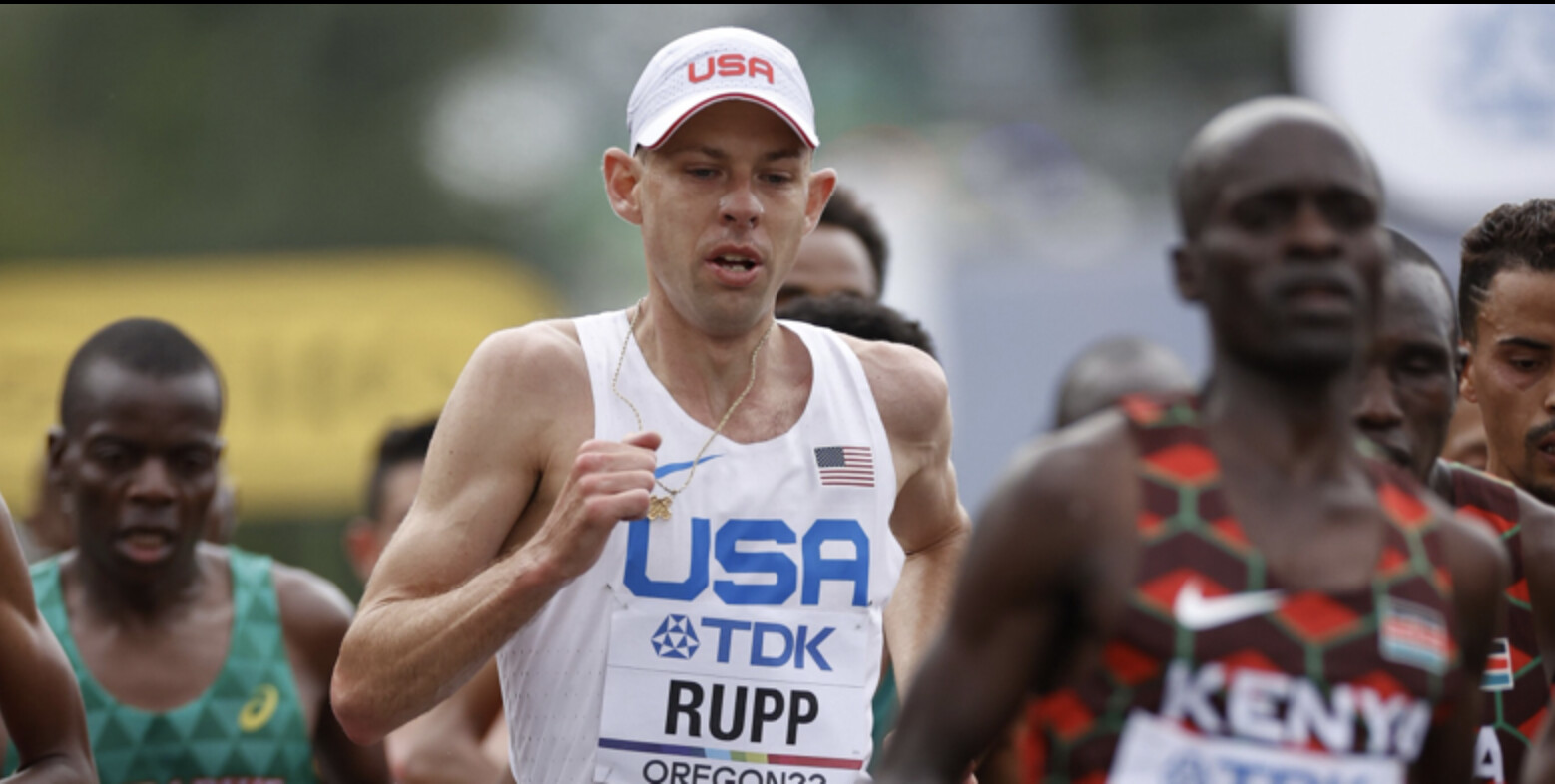
You’d have to go back to October 2021, when he finished second at the Chicago Marathon in 2:06:35, that he last had a result he was happy about.
Now, Rupp, 37, is back on the starting line at Chicago, having overhauled his mechanics and having spent the past two months away from Portland, Oregon, where he lives, and training in Flagstaff, Arizona, where his coach, Mike Smith, lives. For the first time in several years, Rupp is free of the back pain that had plagued him. He spoke to reporters at a press conference in Chicago. Here’s what we learned:
He was in pain just walking around last summer
After last year’s world championships, Rupp tried to push through the pain for his New York City Marathon buildup, but it didn’t work. Smith told Rupp that he needed to get fully healthy before he could start training again.
The NYC Marathon “was a really big wakeup call,” Rupp said, calling himself “hard-headed” in his attempt to run it, just getting through one workout at a time. “For a long time I was just surviving,” he said. “You can’t do that as an elite athlete.”
He’s been working on mechanics…
Rupp has been rebuilding his form, which he thinks was thrown off after his back injury. He’s been working with a team of therapists and running mechanics experts to fix what he called the “terrible” form he had in New York City last year. “That’s been the biggest thing I’ve been addressing,” he said. “I’ve got to clean that stuff up. It takes a lot of time. Running is such a repetitive motion. If you’re doing things a little funky or off, it starts to engrain in there. This past year, I’ve been trying to undo that.”
When pressed for specifics, Rupp cited the positioning of his hips, and how his left foot interacted with the ground. “My whole body was twisted up, in a nutshell,” he said.
…but now he’s training well
Rupp said his buildup has gone about as well as the one he did before Chicago two years ago and he’s returned to his previous volume, which at times has been 130 miles per week with 25-mile long runs. He was vague about his goals for Sunday, saying during the press conference portion of the day, “Above all else, I really just want to have a real solid race here.”
He’s unclear what role, if any, Alberto Salazar will have in his training going forward
Alberto Salazar, Rupp’s former coach with the Nike Oregon Project, was banned by the U.S. Anti-Doping Agency for 4 years in September 2019 for anti-doping violations. Subsequently, Salazar was banned permanently by the U.S. Center SafeSport for sexual misconduct.
Rupp was asked if he would use Salazar in a consulting role going forward.
“I’m not really going to get into that too much,” he said. “I am looking forward to having a personal relationship with [Salazar] going forward, but I’ve got to figure out what exactly the rules are. Things have been going good with Mike. It’s been a great buildup in Flagstaff. I’ve had enough to worry about getting ready for this race. I’ve been focusing on my training.”
He has no problem with the announced noon start at the Olympic Marathon Trials
Rupp said he is not a morning person, and whatever the weather conditions are like at the Trials, scheduled for noon on February 3, 2024, in Orlando, he’ll be ready. “That’s the one thing I absolutely hate about road running and the marathon. I’d rather run at 11 or 12 than 7 in the morning,” he said.
He also has no problem with the current Olympic marathon qualifications system, in which runners can “unlock” spots for their countries, based on running a qualifying time, finishing top 5 in a World Marathon Major, or being high enough in the world rankings.
But if an athlete unlocks a spot, he or she does not automatically get it. In the U.S., those spots go to the top three finishers of the Olympic Marathon Trials.
Rupp hasn’t paid much attention to it.
“The Trials to me has always come down to getting it done on that day,” he said. “You’ve got to get in the top three. That’s the way it’s always been. That pressure is a great thing. I learned at a young age, having to go through that process, about getting it right on that day, being ready and mentally dealing with all that pressure. I think it has served me well when I got to the Olympics.”
He has two Olympic medals to prove it.
He thinks he has several more years ahead of him.
Rupp isn’t giving thought to retiring any time soon. He hopes to get to the 2028 Olympics in Los Angeles, when his kids—he has 9-year-old twins and a 7- and 4-year-old—would be old enough to remember and appreciate it.
He doesn’t feel like age right now is a limiting factor. Staying healthy is.
“I truly believe, especially with the marathon, you can keep doing this well into your 40s,” he said. “A lot of it comes down to your health and how you’re moving. I really feel good about where I’m at.”
He also said he doesn’t lack for motivation, even after two Olympic medals and a Chicago Marathon title in 2017. He still enjoys getting the most out of himself as he can.
“I love movement, training, all that,” he said. “I love the journey of getting ready for races. That fire burns as hot as ever.”
(10/08/2023) ⚡AMPby Runner’s World
Three ways gratitude can support you as a runner
Anyone who’s hosted a big Thanksgiving meal knows, that as tasty as the results can be, slaving over a hot stove isn’t the easiest way to show gratitude. So why do so many of us, year after year, attempt the near-impossible feat of bringing the potatoes to a boil just as the turkey (or tofu roast) is at its crispiest without scalding the creamed corn? The pure fun of digging into a fall feast with family and friends is a big part of it, but perhaps it’s the deliberate effort to express thanks that really gives this holiday its full flavour.
Deliberate expressions of gratitude needn’t be reserved for special occasions, of course. Running offers easy but effective ways to make deliberate expressions of gratitude part of daily life. Here are three ways that incorporating gratitude into your daily rituals can make running an even richer experience.
1. Gratitude can get you out the door on tough days

Whether you can hold a pace for two hours or 20 seconds, being healthy and fit enough to run any distance is something to be thankful for. The ability to run is something that’s easily taken for granted, however, especially during long stretches when we’ve been lucky enough to avoid illness or injury. Being aware of how sickness or a sprain can sideline even the fittest runner can help cultivate gratitude for our good health, and make us less inclined to squander the days we’re physically able to run but feeling less motivated.
You can make a habit out of expressing gratitude for your ability to run by anchoring it to part of your existing pre-run ritual. For example, it can be as simple as thinking the word “thanks” as you tie off the bow while lacing up your shoes. One way I’ve made a habit of expressing gratitude for being able to run is to make use of the wait for my watch to get a GPS signal. I use that time to think back to when I was sidelined for almost a full year because of a stubborn stress fracture, and how desperately I wanted to be healthy enough to run again. Making a consistent practice of reflecting on those long, frustrating months fuels my appreciation for being able to exercise and helps get me out the door every day.

2. Gratitude can help strengthen your awareness
Like good health, the variety of sights and sounds along a running route can be easily overlooked if we’re not paying attention. While we might not want to approach every run as a sightseeing tour—there are other elements of a run we may choose to focus on instead, like posture, pace, heart rate or cadence—gratitude can make us more aware of the landscape, whether external or internal.
One way to promote awareness as a runner and to make your outing a richer experience is to commit to finding one thing you’re thankful for during each run. It could be external (the sight of geese in formation or the rustle of autumn leaves) or internal (the fact you didn’t head out too fast on your easy run or that you avoided taking a spill on an exceptionally tricky technical downhill). Committing to look for one such highlight that you can later record in a running journal or note in the log of your running app will not only make you a more observant runner, but also make each run a little more memorable.
3. Gratitude can support you as a runner during your downtime
Anchoring expressions of gratitude to daily routines that aren’t directly tied to running can also support us as runners. Eating and sleeping habits can have a tremendous influence on how we run, and making a point to recognize their impact can promote healthier habits.
Taking a brief moment to express gratitude—whether in a secular or spiritual way—at the start of a meal and at the end of each day can develop a greater respect for the role food and sleep play in supporting your running health.
(10/07/2023) ⚡AMPby Paul Baswick
Sifan Hassan reveals what she is counting on as she bids to stop Kenya’s Ruth Chepng’etich from Chicago Marathon hat-trick
Ethiopian-born Dutchwoman Sifan Hassan has explained what is giving her motivation as she seeks to stop Kenya’s Ruth Chepng’etich from winning three straight Chicago Marathon titles
Two-time Olympic champion Sifan Hassan is drawing inspiration from her London Marathon win as she looks to stop Kenya’s Ruth Chepng’etich from winning three straight Chicago Marathon titles on Sunday.
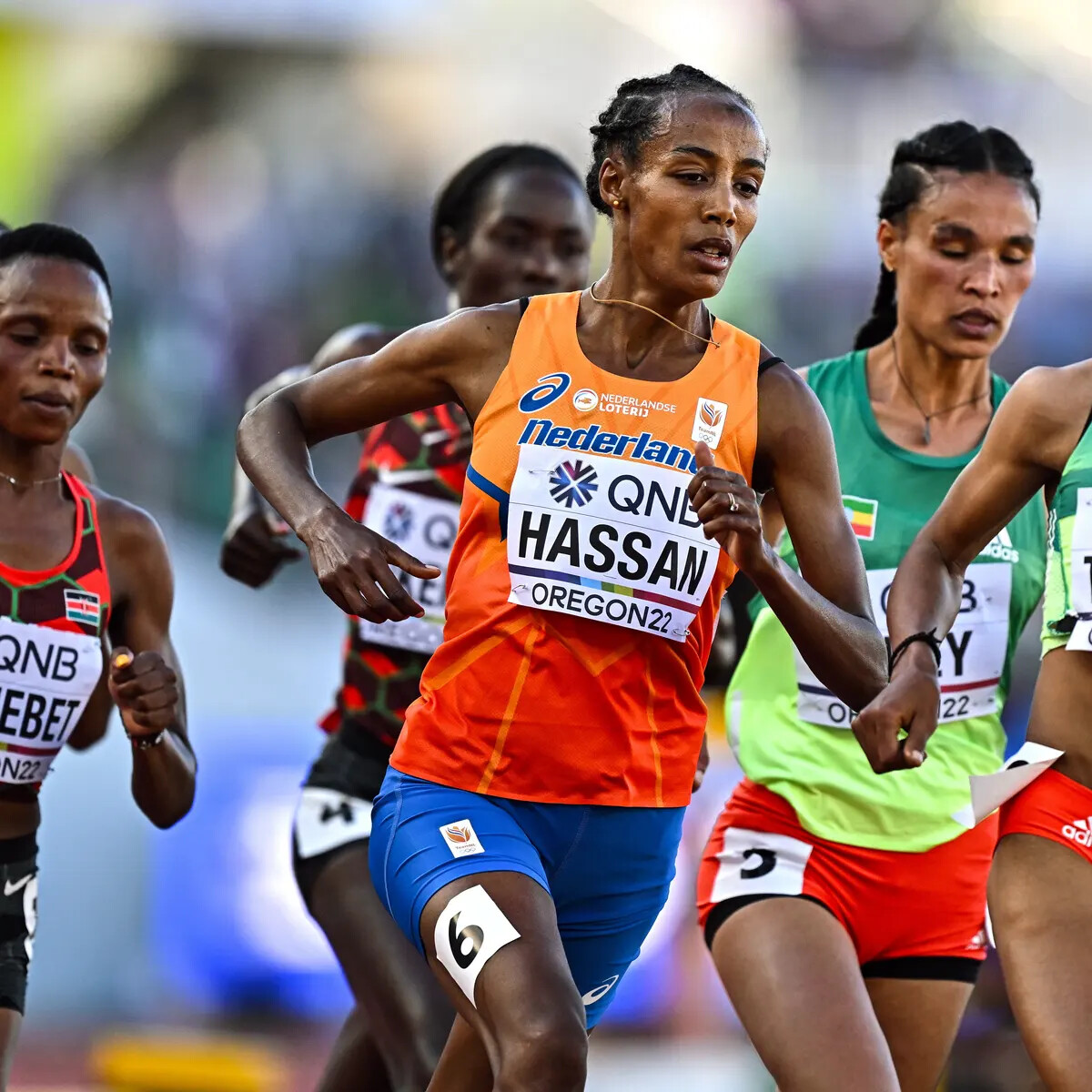
Hassan is among a strong field of elite women that Chepng’etich will have to contend with in her bid to retain her title with Joyciline Jepkosgei, the 2021 London Marathon and 2019 New York City Marathon champion, Tadu Teshome, the second-fastest woman in the field, who clocked 2:17:36 to win last year’s Valencia Marathon, and experienced Genzebe Dibaba of Ethiopia the other top rivals.
Hassan made her marathon debut in London in April this year when, despite stopping to stretch twice, she closed a 25-second gap on the leaders to win and set a national record of 2:18:33.
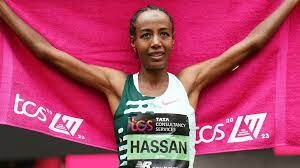
She took a break from her marathon training to race on the track at the World Championships in Budapest, where she contested three distances and came away with silver in the 5000m and bronze in the 1500m.
Now back on the road, the Ethiopian-born Dutchwoman feels her exploits in London puts her in good stead to claim her second marathon victory.
“As most people know, I like to be challenged,” Hassan told World Athletics. “I have the experience from London so I'm looking forward to see what the marathon can teach me this time.”
Chepng’etich won last year’s race in 2:14:18 – which, at the time, was the second-fastest performance in history and just 14 seconds shy of the then world record.
The 2019 world champion returns to Chicago on the hunt for her third consecutive victory in the Windy City.
She won the Nagoya Marathon earlier this year in 2:18:08, and more recently clocked 1:06:18 at the Buenos Aires Half Marathon.
Victory this weekend would make Chepng’etich the first woman to win the Chicago Marathon three times but she will have to overcome Hassan, Jepkosgei, Teshome and Dibaba are among those who will be hoping to spoil her party.
(10/07/2023) ⚡AMPby Joel Omotto
Bank of America Chicago
Running the Bank of America Chicago Marathon is the pinnacle of achievement for elite athletes and everyday runners alike. On race day, runners from all 50 states and more than 100 countries will set out to accomplish a personal dream by reaching the finish line in Grant Park. The Bank of America Chicago Marathon is known for its flat and...
more...

